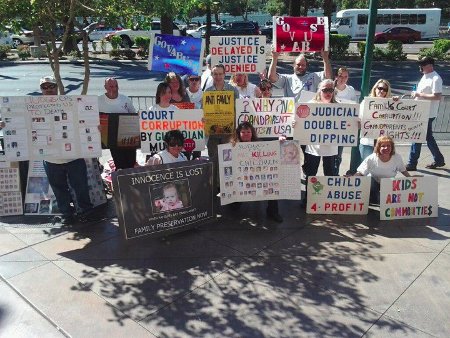help
collapse
Press one of the expand buttons to see the full text of an article. Later press collapse to revert to the original form. The buttons below expand or collapse all articles.
expand
collapse
Forever Services
April 29, 2012 permalink
A children's aid case is never closed, even when a judge orders it closed. John Dunn reports on a parent who had his case legally dismissed by a court, yet social worker Mohammed Said continued to harass the family.
expand
collapse
Court Orders Case Closed - CAS Keeps File Open - Parent Files Motion to Restrain Society and to Close File
The Children's Aid Society of Ottawa has been involved with a parent in Ottawa for approximately two years. The parent complied with Society's requirements and the Society recently moved to close his file with the court.
The court ordered the Society's supervision order to be terminated and full custody of the child returned to the parent, however, since then, we have been told by the parent that the Society, through one of it's workers, Mohammed Said, a child protection worker who is not registered with the College of Social Workers and Social Service Workers, called the parent to say that they want to come to the parent's home for a visit, to see how that child was doing, and if the parent does not comply, things won't go well for the parent and his child.
As a result, the parent has filed with the court, a motion seeking the following DECLARATIONS and ORDERS.
NOTE: Subsection 45 (8) of the CFSA prevents us from publishing the names of the parent or child while a case is open.
A DECLARATION stating that the Supervision Order granting the Society supervision over PARENT and his son CHILD has been terminated
A DECLARATION stating that the Society does not have the right to enter the home of PARENT unless authorized by a court order, or unless the Society intends to apprehend CHILD under section 40 of the Child and Family Services Act
An ORDER under Section 57.1 sub (3) restraining Mohamed Said, or any employees of the Society from entering the home of PARENT and CHILD unless authorized to do so by an order of the court, or unless authorized under section 40 of the CFSA for the purpose of apprehending CHILD
An ORDER that this order be enforceable by the police should Mohamed Said or any employees of the Society attempt to enter the home of PARENT unless in accordance with the above mentioned orders.
An ORDER that the Society close the file on CHILD forthwith and that the Society provide PARENT with a letter confirming that the file has been closed.
ANY OTHER ORDER the court deems just in the circumstances.
The following lists the redacted content of the accompanying affidavit of the PARENT
- I PARENT am the proud father of CHILD1 and CHILD2. I believe the Society, or Mohamed Said (my worker) may be acting in “bad faith” in their recent dealings with me after the court had already ordered my child protection file closed, because I expressed to the Society that I intend to take legal action against the Society for the harm which was done to my child while in care. Since telling them this, the following have taken place.
- On March 20, 2012 the Society filed a glowing report about me to the court, to which the court ordered the termination of my supervision order giving me full custody of my son CHILD1, the ORDER and ENDORSEMENT are attached to this affidavit as EXHIBIT “A” and EXHIBIT “B” respectively.
- Immediately after the hearing was over, I was understandably relieved and a slight bit emotional in the presence of my lawyer (Meg Green). Right away, Mohammed Said came over to me and asked if I was going to be ok and if I was going to be able to go back home to CHILD1. My lawyer at the time Meg Green quickly stepped in and protectively said I was going to be fine, it's just that it's been a long journey and it's finally over. Mohammed Said then acknowledged that the file was closed, we shook hands and parted ways.
- Two weeks later, on April 4th, 2012, while I was in the court room regarding my other son CHILD2's matter, Mohammed Said called me two times on my cell. I did not answer as I was in court. On the same day, April 4 th, 2012, after I was finished in the court room, later that afternoon, Mohammed Said called me again at 2:05pm. I answered the phone and Mohammed asked me how I was doing, how CHILD1 was doing, and that it was necessary that he come over to my apartment to see how CHILD1 was doing.
- I responded by telling him that I was told by my lawyer that the supervision order was terminated, that I was granted full custody and that I did not have to deal with CAS anymore regarding my son CHILD1.
- Mohammed Said responded to me by saying “JUST BECAUSE THE JUDGE SAID TERMINATION ON THE 20TH, IT ONLY MATTERS WHAT I SAY, AND THE FILE CLOSES WHEN I SAY IT CLOSES.” He continued to say that “IF YOU DO NOT COMPLY WITH MY REQUEST FOR A HOME VISIT, THINGS WILL NOT WORK OUT WELL FOR YOUR SON AND YOU.”
- Mohammed Said continued to threaten me by saying I was going back to being uncooperative and that it would only make things worse for me. I then responded by saying that enough is enough and that I am going to let him go and talk to my lawyer. I called my lawyers office, and spoke to her assistant immediately after the phone call and told her what happened with Mohammed Said. She told me she would get in touch with Meg Green right away and speak to her about it.
- [omitted]
- On April 05, 2012, my lawyer, Meg Green sent the Society a letter asking why Mohammed was saying all the things he said to me which is attached to this affidavit as EXHIBIT “D”. The Society responded by saying that they required a final visit to close the file.
- On April 13th, 2012, on advice from my lawyer, Meg Green, I called the Society and spoke with Mohammed Said to ask for more information about the home visit and to let him know that if they wanted to visit me in my home, that I preferred to have someone present.
- Mohammed Said then responded by saying that what I had said to him was threatening and asked why I need someone else to be present. I did not feel I had to respond to that and Mohammed Said told me he would get in touch with me next week.
- I was starting to feel scared and intimidated at the Society's forceful way of getting back involved with my son and I even after the court had already terminated the supervision order and granted me full custody. Feeling worried I went to visit the Centretown Community Health Centre, to speak with my support person NAME REMOVED who has worked with me since 2009 when my son CHILD1 was just three month old.
- While speaking with her, I called Mohammed Said on speaker phone so NAME REMOVED could listen. I asked him why the visit would be necessary and why the Society's file on my son CHILD1 and I was still open despite the fact that the court had ordered the supervision order to be closed.
- Mohammed Said responded by saying that it was necessary to come and see my son CHILD1 to close the file, and he went on to discuss how I had cooperated with them, how I am not cooperating now, and that I should be thankful for all the Society has done for me, and that the only reason I got full custody of my son CHILD1 was because they were in agreement, and it could have gone the other way if the Society was not in agreement. He also said that all they want to do is to close the file.
- On April 19th, 2012 I sent an e-mail to Mohammed Said asking him and the Society to only communicate with me in writing to ensure I have a legal record all all communication, which I have attached to this affidavit as EXHIBIT “C”.
- Mohammed Said continues to call me and has done so at least three times since then.
- On January 24, 2012 a letter from Dr. Poliquin which is attached to this affidavit as EXHIBIT “E” states that I always attend my son's scheduled medical appointments, my son is always dressed appropriately, I attended scheduled specialists appointments, and that my son CHILD1 is always happy, seems to be very well taken care of or looked after by me.
The hearing date for this motion is May 28, 2012. The outcome of the motion will be posted upon receiving it.
Source: Foster Care News (John Dunn)
Sarnia Rally
April 29, 2012 permalink
On April 26 there was a rally in Sarnia staged by Canadians for Family Law Reform. Photos: [1] [2] [3] [4] [5] [6].
Source: Facebook
Brittle-Hospital Disease
April 29, 2012 permalink
Chris and Julia Norton took their baby son to the hospital for treatment, and instead lost custody of the baby and an older girl. The boy suffered from brittle-bone disease. It took the family seven months to clear their names and get their children returned.
expand
collapse
Parents take son to hospital for bump on the head and are stopped from seeing their kids alone for seven months following false abuse claims
Chris and Julia Norton were interviewed by police and forced to sign over the children to Julia’s parents
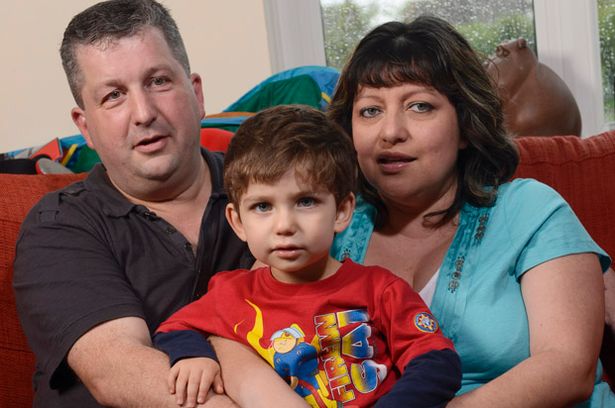 Torn apart: Julia and Chris Norton who's son Harry age 2 has a brittle bone conditon Torn apart: Julia and Chris Norton who's son Harry age 2 has a brittle bone conditonSunday Mirror/Roland Leon
Torn apart: Julia and Chris Norton who's son Harry age 2 has a brittle bone conditon Torn apart: Julia and Chris Norton who's son Harry age 2 has a brittle bone conditonSunday Mirror/Roland LeonA couple were banned from being alone with their two young children after they were wrongly accused of abusing their baby.
Worried Chris and Julia Norton took 10-week-old Harry to hospital when a lump appeared on his head... but doctors blamed THEM for causing the injury.
Harry was later diagnosed with osteogenesis imperfecta, a rare brittle-bone disease which means a light touch can snap his bones. But it was seven months before the ordeal was over. In that time, social services were called and Harry and older sister Vicky were placed on the “at-risk” register.
Chris and Julia were interviewed by police and forced to sign over the children to Julia’s parents. The family had to move in with the parents just to be with Harry, now two, and Vicky, four.
Julia, 38, from St Ives, Cambs, said: “The accusations against my husband and I were like a sick joke. We were so scared.”
The disturbing story is part of a rising trend of cases. The number of children taken into care is set to hit a new high in a surge known as the Baby P Effect after the horrifying 2007 death of 17-month-old Peter Connelly.
Julia and Chris, 46, first took Harry to Hinchingbrooke Hospital in Cambridge after a bruise appeared on his chest in 2009.
Doctors thought it was an allergic reaction to a spider bite and he was sent home. But more bruises followed. And when the lump appeared on his head, his anxious parents took him back to hospital. Julia said: “The doctor asked if we knew where it had come from. Then she said they were trained to suspect abuse. I couldn’t believe we were accused of harming our baby.”
After the family moved in with Julia’s parents, she wasn’t even allowed to change Harry’s nappy on her own. “The children weren’t allowed to sleep in the same room as us either,” she said.
All allegations against Julia and Chris have been dropped and they are speaking out now to raise awareness of parents wrongly accused of harming their children.Matthew Winn, of Cambs Community Services NHS Trust, said: “We are sorry... we’ve worked with the Nortons to introduce improvements to prevent distress to other families in future, while not compromising child safety.”
Source: Mirror (UK)
Petition
April 28, 2012 permalink

MPP Ernie Hardeman presented a petition to the Ontario legislature requesting that the government ensure that social workers register with the college as provided under existing law.
expand
collapse
SOCIAL WORK
Mr. Ernie Hardeman: I have a petition signed by a great many people from around the province, a lot of them from my great riding of Oxford. It is to the Legislative Assembly of Ontario.
“Whereas many children and their families have been and continue to be adversely affected by the actions of CAS workers who are engaged in the practice of social work but not registered with the Ontario College of Social Workers and Social Service Workers … as required under law; and
“Whereas unregulated and unregistered CAS workers are entering schools, detaining children and violating the rights of children and parents under sections 7 and 9 of the Canadian Charter of Rights and Freedoms to the right to life, liberty and security of their persons, as well as the right not to be detained; and
“Whereas the Social Work and Social Service Work Act (1998) … requires that all persons who engage in the practice of social work in the province of Ontario must be registered with the Ontario College of Social Workers and Social Service Workers; and
“Whereas the college has a duty under sections 3.1 and 3.2 of the act to regulate the practice of social work in Ontario to protect the public interest but has failed to fulfill its legal mandate since the year 2000; and
“Whereas the unlawful practice of social work by CAS workers is causing significant harm to children and families and bringing disrepute to the profession of social work and is undermining the administration of justice and the rule of law;
“We, the undersigned citizens of Ontario, petition the members of the Legislative Assembly of Ontario to take steps to protect children and families in the following way:
“That the government of Ontario take steps to ensure that all CAS workers in the province of Ontario who are engaged in the practice of social work be required to be in compliance” with “the Social Work and Social Service Work Act … and to be registered with the college, as is now required under existing legislation.”
Thank you very much, Mr. Speaker, for allowing me to present this petition.
Source: Ontario Hansard
Avarice
April 28, 2012 permalink
Here is an item to be indexed under "agency avarice".
Lisa Jennings So, the CAS Lawyer called me today at 5pm to tell me that he had gotten a quote for me for a copy of my file, $770.00 with half upfront before they will even start copying!! Like they don't get enough $$ by stealing my son!! Does anyone know a way around this??
Source: Facebook
He or She
April 28, 2012 permalink
Can you tell the difference between a man and a woman? An expert providing evidence to a British court could not. She identified a mother throughout her report with the pronoun "he". The court placed her children for adoption anyway.
expand
collapse
'He’, 'she’ – it’s all the same to the family 'expert’
Two more glimpses into the surreal underworld of our 'child protection' system.
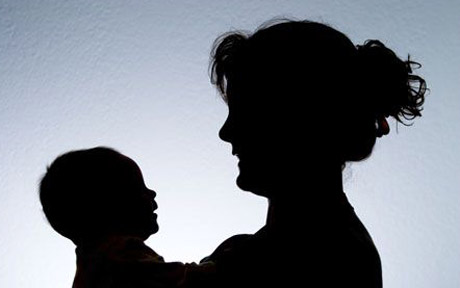 A psychologist's report commissioned by social workers referred to a mother as 'he' throughoutPhoto: ALAMY
A psychologist's report commissioned by social workers referred to a mother as 'he' throughoutPhoto: ALAMYTwo more glimpses of the surreal underworld of our “child protection” system. I spoke last week to a mother whose two young children were recently removed by social workers because she had once been involved with a violent partner. He was long out of her life, and she had been living happily with the father of her younger child. The only evidence against her was a report commissioned by social workers from a “psychological expert”. I gather that the local authority’s lawyer told a court that, according to the report, the mother was suffering from “a severe personality disorder”.
Utterly baffled by this charge, the quite normal mother noticed that the report repeatedly described its subject as “he” rather than “she”. She drew this to the attention of her barrister, who put it to the “expert” that it seemed to refer to someone other than his client. Had it perhaps been copied from a different report? The “expert” acknowledged and apologised for her “mistake”. But the magistrates seemed quite unfazed by this admission, ordering that the children should be sent for adoption because they might be “at risk of emotional harm” – even though the mother only lost them in the first place because of the danger posed by an ex-partner she has not seen for two years.
Meanwhile in a northern city, last Monday, there were ugly scenes when half a dozen girls aged 16 and 17, living “semi-independently” in a local care home under social services supervision, came to the social workers’ offices to collect money they are given for food and day-to-day expenses.
When a social worker accused one girl of spending her money on drink, the girl angrily remonstrated. The social worker then refused to give money to any of the girls, who began shouting abuse and banging at the windows.
Terrified social workers locked them all in and fled, leaving the girls to protest loudly that they want to go back home, while daubing the room with graffiti accusing social workers of being “child snatchers”. I cannot, alas, recount how this unhappy affair ended, but next day, I am told, the offices were still in some chaos.
Source: Telegraph (UK)
How to Fail Mothers
April 28, 2012 permalink
British psychiatric expert Dr George Hibbert knew the sure way to take a baby from a mother: Give her tests that she cannot possibly succeed at. Examples: vacuum a stairway or change a flat tire while holding a baby, or do the shopping for 14 people while caring for a toddler. Other techniques: observe families, but record only the negative. Or report normal activities as pathological, such as watching TV with a child, tickling a child or making a to do list.
expand
collapse
'I never saw him observing parents with children': The woman who said she was forced to take babies from their mothers by the 'expert' who played God
- Keira Roberts worked for Dr George Hibbert at Family Assessment Centre in Swindon
- He set parents odd tasks, like changing a car tyre while caring for a child
- Keira: 'We had to put only bad things in our reports'
- Dr Hibbert made more than £40,000 a week
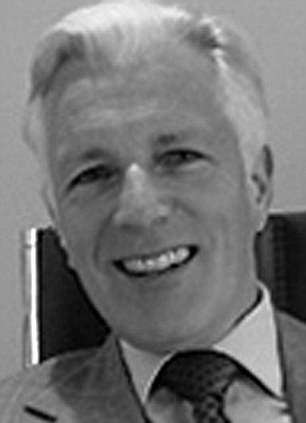 'Playing God': Dr George Hibbert specialised in helping local authorities identify dangerous or neglectful parents
'Playing God': Dr George Hibbert specialised in helping local authorities identify dangerous or neglectful parentsAnyone who works in child protection will tell you that one of the worst aspects of the job is having to take a youngster from its mother’s arms, possibly for ever.
It is heart-breaking enough, even when you are 100 per cent sure that being taken into care is the best thing for that child. But what if you are forcibly removing a child from a mother you believe to be a good and caring parent?
Keira Roberts never imagined that she would find herself in such a position when she accepted a job with an eminent psychiatrist who specialised in helping local authorities identify dangerous or neglectful parents.
Dr George Hibbert was regarded as one of country’s leading experts on child abuse, had lectured at Oxford and had advised MPs on the family courts system.
When Keira agreed to work for him, it was at one of his Family Assessment Centres — places where families who had come to the attention of social services departments were referred. They were placed under round-the-clock observation while it was determined what should happen next.
It was a very intrusive set-up, but Keira assumed that Dr Hibbert — who was highly trusted (and very well paid) by a string of local authorities — knew what he was doing.
And in the wake of the Baby P scandal, she understood how important it was for any concerns about parental abuse to be acted on.
But protecting children is one thing. Ripping families apart — apparently for little reason — is another. Yet this is what Keira claims Dr Hibbert did, and on a scale that is staggering.
Alarm bells first started ringing when she felt Dr Hibbert wanted his staff to concentrate on recording only the negative aspects of what they observed.
And she became dismayed when the parents were set bizarre and, she felt, unfair tasks, to assess how they coped.
She watched one young mum struggle to vacuum the stairs while carrying a baby. Another was sent off to the supermarket with her child in tow to grapple alone with a huge shop for 14 people.
But her bemusement at Dr Hibbert’s methods turned to horror when she realised that when parents ‘failed’ to complete these tasks to Dr Hibbert’s high (or ‘impossible’, as she puts it) standards, it counted against them and their children were being taken.
And what haunts her is that she was sometimes the one doing the forcible removal of the children.
The case that still keeps her awake at night involved a young mother called Anna — a woman Keira had been observing for 14 weeks, and considered a good mother. She had come from a difficult background, but there was no evidence that she was abusive or neglectful towards her child.
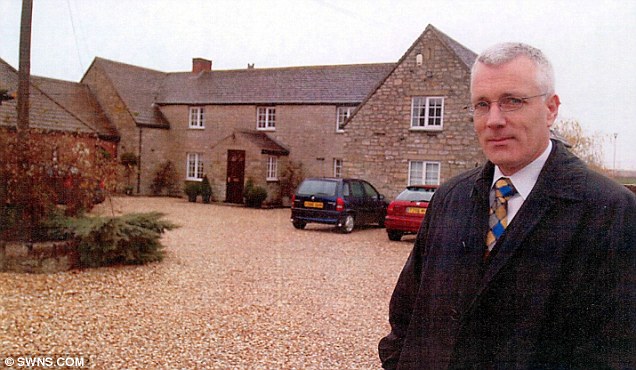 Under investigation: Dr George Hibbert, pictured outside the Family Assessment Centre in Swindon
Under investigation: Dr George Hibbert, pictured outside the Family Assessment Centre in SwindonIndeed, Keira was impressed with what a good job she did of caring for her baby.
Yet at five o’clock one morning when she was working at the assessment centre, Keira was confronted by a sobbing Anna. She was cradling her baby, rocking from side to side and weeping uncontrollably, and begging for Keira’s help.
‘She was convinced she was going home without her baby because she thought she had failed. She was hysterical. She kept asking: “Don’t you think I am a good mother?” I did, but there was nothing I could do. Dr Hibbert had made his decision.’
Eventually, Keira was the one who had to take the baby from her arms. ‘It was the worst thing I have ever had to do,’ she says.
But Anna wasn’t an isolated case. Quite how routinely babies were removed from their parents as a result of Dr Hibbert’s practices is not yet known. But Keira was not the only one to fear that her boss was abusing his powers.
Earlier this year, Dr Hibbert offered to surrender his doctor’s licence when the General Medical Council launched an investigation over accusations that he had deliberately misdiagnosed mothers as suffering from mental disorders to fit in with the view of social services.
The GMC refused to accept Dr Hibbert’s offer, and is investigating his fitness to practise.
This is the first time a member of his staff has come forward to talk about what they say went on inside one of his assessment centres.
Keira spent over a year working for Dr Hibbert at Windmill House, Swindon. Her account — given on the condition we protect her identity — paints a horrifying picture of the lives of the parents he told the family courts were ‘unfit’ to look after their children.
How many families were ripped apart by Dr Hibbert is not known, but Keira confirms there must be ‘many’.
Between four and eight families would live at Windmill House at any one time, with Keira and her colleagues watching them 24 hours a day, scrutinising their every interaction with their babies.
It was ‘just like the Big Brother house, she says, ‘but 100 times worse because they knew if they did something that was deemed wrong, they risked losing their child.’
Even at night, Keira claims, staff listened in to their parenting — and, in the case of couples, their intimate conversations — using baby monitors.
She says mothers were not even allowed to breastfeed in private. ‘I always felt it was very intrusive,’ Keira says.
‘When I was watching the parents in the same room, I would sip water or do a crossword so they wouldn’t feel too watched.’
Perhaps such intrusion could have been justified had honest observations about the parents’ interaction with their children been made.
Keira says things started in a balanced way, with staff being told to write, in the margins of their copious notes, a small ‘G’ for good parenting, ‘B’ for bad or ‘R’ for routine.
But later, she says, they understood they should write down only the bad aspects of parenting they observed.
She says: ‘Dr Hibbert said: “All I want, all I need you to do is highlight anything that’s bad.” We did not include any good parenting because the courts would take it as read.’
Staff were horrified, believing this was going to give a ‘skewed view’.
‘I don’t think anyone thought it was right,’ Keira says, ‘but he said we had to cut down the amount of paperwork we were giving him.’
Another of Dr Hibbert’s methods was to set the parents bizarre tasks, such as changing a car tyre while caring for a child.
‘The assessments were ludicrous,’ Keira says. ‘A lot of the staff said that if we found ourselves in their situation, we’d fail. It was a totally unrealistic, false environment.’
Incredibly, though, the mothers would often succeed against all odds. ‘They were so desperate to pass,’ Keira recalls quietly.
While she and her colleagues had to watch the parents round the clock, Keira claims Dr Hibbert was rarely at Windmill House.
Staff would occasionally see him driving in and out of the car park in one of his two Porsches — one black, one silver — or popping into the office to pick up one of his designer suits, which staff would have dry-cleaned.
But Keira claims she ‘never’ saw the psychiatrist actually observing parents with their children before he wrote his reports for the family courts — which would be extraordinary if this was always the case considering this was a man charging the taxpayer thousands for an ‘intensive and multi-faceted assessment’ of a mother over 12 weeks.
 Rich: Two Porsches can be seen parked outside the home of Dr Hibbert near Swindon. At one point in 2010, when he had 11 residents in the centre at one time, Dr Hibbert was raking in more than £40,000 a week
Rich: Two Porsches can be seen parked outside the home of Dr Hibbert near Swindon. At one point in 2010, when he had 11 residents in the centre at one time, Dr Hibbert was raking in more than £40,000 a week‘In the year I was there, I never once saw him watch a parent with their child,’ says Keira. ‘It was ridiculous. How can he have had an expert opinion on their parenting if he didn’t even observe it?’
Dr Hibbert accepted he limited his direct interactions with parents because of the powerful effects he believed that could have.
Yet few would have suspected how little he seems to have observed people parenting their children.
Not only that, the sums Dr Hibbert charged for his family assessments are staggering. The courts were paying him thousands of pounds a week for his opinion.
Each parent and child at the unit earned him £4,100 per week. This rose to £6,150 per week for a couple and a baby, or £8,200 for a couple with two children.
At one point in 2010, when he had 11 residents in the centre at one time, Dr Hibbert was raking in more than £40,000 a week — plus the £210 he charged for every hour he had to read the parents’ paperwork.
His bill was split between local authorities, the child’s legal representative and the parents’ legally-aided solicitor. Public money in other words.
Despite their huge costs, Dr Hibbert’s assessments appear to have relied to a great extent on notes made by his staff — some as young as 19.
Keira insists Dr Hibbert usually saw parents for no more than 20 minutes per week. The workers — who were paid a starting salary of £16,500 a year — were left to observe the parenting for him.
‘We weren’t experts, none of us were,’ Keira confirms. ‘Some were totally unqualified. Yet we were the ones actually watching the parents with their children.’
With parents paying for their own food, and made to do all the cooking and cleaning themselves, workers often commented that Dr Hibbert ‘must be raking it in’ from his family assessment centre. Yet this was just one of his many lucrative sidelines.
He also made a fortune attending court as an expert witness — which he charged an eye-watering £1,800 per day. Incredibly, he even invoiced £105 per hour just for the time he spent travelling to and from court — plus 45p per mile for petrol.
‘I don’t know how often he went to court, but it was about once a month,’ Keira remembers. He was not, Keira says, a caring employer. She claims he was subject to ‘foul moods’ and prone to ‘stomping about’ if he as angry. She describes him as an ‘intimidating presence’.
‘He looked down on me,’ she says. ‘He was more intelligent, he was the one who knew everything — we were just his lackeys. I had never come across someone who was quite so full of himself. He also thought he was God’s gift to women.’
In the year she worked at the centre, a number of staff resigned over what Keira believes were concerns about Dr Hibbert.
And it wasn’t long before she began to have serious doubts. ‘With some mothers, it didn’t seem to matter what we wrote,’ she says. ‘He seemed to have made his mind up about them from the beginning.’
Others, she felt, were criticised ‘for nothing’.
One young father was accused of having ‘paedophilic tendencies’ after staff observed him lying on the floor with his daughter watching television.
Another was said to have an ‘intrusive’ parenting style because he liked to tickle his baby daughter — something Keira says the baby ‘absolutely loved’.
But most bizarre of all was the case of a married mother who liked to write to-do lists. ‘Dr Hibbert told us that writing a to-do list wasn’t normal behaviour. He said it was obsessive. ‘All of us staff said, hang on — we do that too!’
But the patients couldn’t win.
‘If parents didn’t trust him they were branded paranoid,’ Keira remembers. ‘If they got upset, then he would say they weren’t stable.’
Her final clash with Dr Hibbert came when she observed a meeting he held with a woman who was describing how she had once been raped.
The psychiatrist’s reaction left Keira stunned. She says: ‘I saw him put his fingers in his ears and say: “Na na na, I’m not listening to you.” I really just couldn’t quite believe what I was seeing. I didn’t get the impression he had any empathy.’
In early 2010, Dr Hibbert opened an extra four rooms in his assessment centre.
But then just a few months after this extra building — known as The Annexe — was opened, he abruptly shut the entire assessment centre down.
Staff were told that business from local authorities was drying up due to the economic climate, and that they would all be losing their jobs.
‘It was all very strange,’ Keira remembers. ‘Something about it wasn’t right. He has spent all this money getting it kitted out, and we were still getting phone calls to the office from local authorities asking us to take more parents in.’
It was only later that Keira discovered what she believes is the real reason the centre shut so abruptly: her former employer was facing an investigation by the General Medical Council.
A young mother had claimed he deliberately misdiagnosed her with bipolar disorder — a decision which resulted in her losing her son.
Last night, a spokesman for Dr Hibbert said: ‘The Medical Protection Society, on behalf of Dr Hibbert, confirm there have been no findings made against Dr Hibbert by the General Medical Council or any other body.
Dr Hibbert is unable to comment upon ongoing investigations due to his duties of patient confidentiality and his professional obligations.’
As for Keira, she says she wants to go to the GMC to tell her story.
She adds: ‘Personally, I’d like to see him prosecuted, stripped of his assets and sent to prison. What he did was unforgiveable.’
Some names have been changed.
Source: Daily Mail

Death of Matthew Reid
April 27, 2012 permalink
Matthew David Reid, age 3, died in CAS care in Welland Ontario on December 15, 2005. A new video recreates his death at the hands of a thirteen-year-old foster girl, named as Jane Jennie Ewing. Her mental deficit was not as great as first reported, since she had the capacity to read and write and to understand the criminal nature of her act. Her problems stemmed entirely from her upbringing in foster care, starting at age two months.
Pat Niagara extracted the segment on Matthew Reid from a Discovery Channel documentary. It is available on YouTube or our local copy (mp4). According to Canada Court Watch investigators, the view of Jennie's mother as a drug-abusing alcoholic is not factual. Jennie has been released and is now living with her dad (or stepdad) in Northern Ontario. Previous stories: [1] [2] [3] [4].
Published on Apr 26, 2012 by CAS ONTARIO
★Viewer Discretion Advised★
In December 2005 young Matthew Reid was in foster care in Welland, Ontario through FACS Niagara when a young girl was placed in the home. That night the young girl killed Matthew. This re-enactment depicts approximately what happened. Due to the inadequacy of FACS Niagara a young boy is dead and a young girl's life altered forever.To this day FACS Niagara and the worker have not been held accountable
Source: YouTube
Parental Alienation
April 26, 2012 permalink
Parents drawing attention to the problem of parental alienation rallied outside the courthouse yesterday in Barrie.
expand
collapse
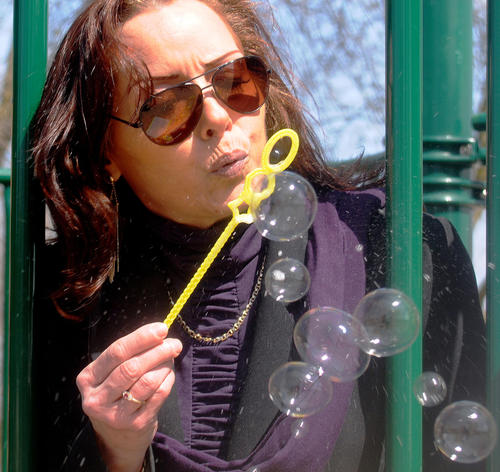 Paulette MacDonald, a family justice advocate, blows bubbles during a Bubbles of Love campaign at Centennial Park in Barrie.J.T. MCVEIGH/BARRIE EXAMINER
Paulette MacDonald, a family justice advocate, blows bubbles during a Bubbles of Love campaign at Centennial Park in Barrie.J.T. MCVEIGH/BARRIE EXAMINERParental alienation rises to surface
‘Children deserve to chose the right to be loved by both parents’
With more than 43% of the Canadian population divorcing, it’s likely you know someone who’s gone through a messy split.
When more than half of those divorces involving families with children, the messy factor ratchets up a notch to a painful custody battle where defeated parents will tell you nobody wins.
A dozen parents decked out with signs in their hands, and their hearts on their sleeves, met at Centennial Park after holding a small demonstration at the Barrie courthouse demanding change in family law.
The real weapons of mass destruction are the family court system, read a placard placed against the climbing equipment at the beach.
The dozen parents, equal parts men and women, stood unified in their pain as all admitted they’d lost custody of their children through long, messy court battles.
“The status quo has got to go,” said Sharon Neary, using her maiden name.
Neary says she has three children, but doesn’t see two of them due to a poor relationship with her ex-husband.
“It’s a form of mental and emotional abuse. Everybody knows about it, but now it’s got a name — parental alienation.
“Children deserve to chose the right to be loved by both parents.”
Paulette MacDonald, a former volunteer with the Parental Alienation group, and now a co-director with the Canadian Equal Parenting Council, said there are 42 organizations across the county pushing for family law reform for equal parenting.
“It removes the incentive for single custody in the legal system,” MacDonald said.
Once joint custody becomes mandatory, parents won’t use children as weapons against their former spouse and joint custody will ensure both parents play a part in their children’s life, she said.
Perched on the children’s playground equipment at the beach, MacDonald read a statement about forgiveness by Dr. Anita Vestal, who offered a free e-book entitled Making Friends with the “F” Word: 20 Practical Ways to Forgive to those in attendance.
At the end of the meeting, and perhaps as a metaphor for a child’s fragility, the assembled group blew bubbles into the cold, strong wind before leaving.
As the rainbow bubbles floated away, a set of twins in matching toques and coats chased them giggling, to the water’s edge.
Source: Barrie Examiner
Abuse Industry Considered Harmful
April 25, 2012 permalink
Tim Dunkin writing in the Canada Free Press points out two consequences of the current system of protection from abuse. It routinely attacks and diminishes the authority of religious institutions. Those institutions are, or by rights ought to be, a prime source of opposition to the system bent on the destruction of the family. And parental authority is diminished by a system that routinely overrides parents with the authority of the state. He ends with a list of mild suggestions for reform.
expand
collapse
If someone wants to use the system to slander, harass, or damage someone else, then this shouldn't be allowed to happen
Regulating the Abuse Industry
It is rare thing indeed that I will advocate for legislative action on just about any matter, as I generally prefer that legislatures do as little work as possible. However, in cases where there are real problems that exist—often as a result of the legal structure itself—then I will join with other voices calling for needed reforms. One area, I believe, where there is such needed reform is in dealing with the abuse industry in this country.
What is the “abuse industry”? What I am referring to is the complex, interlocking structure of social workers and the “child welfare departments” which they staff, child psychologists, counselors, non-profit organizations, and others who generally deal with identifying and confronting allegations of child abuse against individuals and institutions, but which also often resort to inventing and embellishing unsubstantiated accusations as part of the process of rooting out the evil of child abuse. Now, in and of itself, there is absolutely nothing wrong with seeking to stop the abuse of children, of whatever kind it may take. It is a hallmark of civilized society to protect and support its weaker members from mistreatment and exploitation. The principle itself of protecting children from abuse is a noble one. So with this principle, I don’t have any arguments.
However, there’s a reason I refer to the subject of this article as the abuse “industry.” That’s because along with the good that might often be done, there is nevertheless a lot of manufacturing that goes on—false allegations, the abuse of the system itself as a means of revenge-seeking or harassment, and in many cases, just plain old cupidity on the part of those involved in this work. For all involved—from not-for-profit groups receiving donations to governmental child services departments receiving budgeted chunks of taxpayers’ monies—the abuse industry is a multi-million dollar a year operation. This flow of money is directly tied to the prevalence of child abuse—if more abuse is discovered, then there obviously is more need for the services of these groups, with a concomitant need for more funding. This, obviously, provides an incentive to find more child abuse, whether there is a substantial basis for the accusations being made or not. After all, when you’re a saintly do-gooder of a hammer, everybody else looks like a low-down rotten evil-doer of a nail.
This money and the sense of power that goes with it can be a sore temptation. In Ireland, where there has been an ongoing scandal related to widespread child abuse in both the Catholic church as well as many “industrial schools” (schools for poor and often orphaned children that, in Ireland at least, are often ran by members of the Catholic clergy), a lot of good has been done in unearthing these abuses. Nevertheless, some of the non-profit organizations involved in bringing this to light, including groups like Right of Place, the Aislinn Center, and SOCA (Survivors of Child Abuse) have themselves faced accusations related to the mismanagement of funds (often government-provided) and increasingly incredible accusations seemingly designed to gin up more support. As with any other area of life, large amounts of money mean larger opportunities for corruption.
Hephzibah House
Unfortunately, the problems one can encounter with many of these self-proclaimed “survivor support” groups are not limited merely to fiscal irregularity. As an example of what I mean, in several previous articles I have discussed the case of Hephzibah House, a fundamental Christian ministry dedicated to salvaging and educating girls have reached the point where their own families cannot handle them anymore—often because of drugs, violence, and so forth. Hephzibah House has been the target of a five-year ongoing campaign of slander across the internet waged by a group of former students from the school’s forty years of existence who allege horrible abuses to have occurred. While the campaign has mostly been confined to various internet forums and blogs, they have made enough noise to attract the attention of some of the baser elements of the mainstream media, such as Anderson Cooper 360 on CNN. Typical of the attacks are that they rely on emotion and innuendo, rather than substantiated (or even substantiable) facts. While many terrible-sounding accusations are made, the accusers ignore, and even try to suppress, the testimonies of other former students who flatly contradict and deny that any of the alleged abuses ever took place. Further, outside authorities have investigated Hephzibah House on a number of occasions, and found no evidence to corroborate the claims against that ministry. The “Survivors,” as they label themselves, find a great deal of support from individuals and organizations involved in the abuse industry.
On their face, the accusations of abuse against Hephzibah House simply don’t stand up to scrutiny. The accusers rabidly try to prevent deep investigation of their claims. As mentioned above, state and local agencies have investigated and not found anything. Other former students—often hounded and vilified by the “Survivors” - contradict the narrative built by the accusers. Yet, the accusers continue to slander innocent people, and find plenty of supporters who will affirm them in this. This is, itself, a form of abuse—abuse of free speech, abuse of the legal system (the authorities have to investigate when yet another spurious accusation is lodged), abuse of simple decency. It is simply very, very easy for a determined group of people who have a chip on their shoulder and who wish to do this ministry harm to be able to pursue with persistent harassment—and they do so with the full support of many elements of the abuse industry.
Heritage Boys Academy
Hephzibah House isn’t the only falsely-accused victim of abuse-related slander. Take, for example, the case of Heritage Boys Academy, located in Bayou George, Florida. Like Hephzibah House, Heritage is another fundamental ministry dedicated to dealing with “hard case” young people, in this case boys. In 2010, it was shut down, and several of its staff arrested, on the basis of accusations of child abuse lodged by former and then-current residents. Some of the claims indeed sounded harrowing. Staffers at Heritage were accused of holding boys down and punching them repeatedly. It was also claimed that staffers forced several of the boys to chase down and savagely beat (in the middle of a public street) another boy who was trying to run away. One boy presented a pair of bloody underwear as evidence of the abuse he alleged to have suffered. As with Hephzibah House, Heritage has also been roundly vilified across the internet and among “survivor support groups,” one example being this rather drawn-out Youtube video that lays out some very serious charges against the school.
The problem with all of this, however, is that the accusations weren’t true. When the case actually came before the court, the court ruled that there wasn’t evidence to substantiate the accusation, and all charges were dropped. As it turned out, the boys making the accusations had made them up. Investigators found nothing to support the stories of abuse. Yet, because of these spurious accusations, three men had to deal with lost time and money in jail and in court, lost reputation in their communities, and several people were out of work when the school was shut down. Vindictive accusations designed to harass by boys who were angry about their situations ended up ruining, or nearly so, the lives of several innocent people.
Or take, for example, the case of Paul Burritt, who drove a van for handicapped children in Turtle Lake, Wisconsin. Mr. Burritt was accused by an 11-year old girl who was one of his riders of taking her to his home and sexually molesting her. Without any investigation, the police immediately arrested him, and his name was dragged through the media, likely facing the same sort of vilification that Hephzibah House and Heritage Academy have suffered. Ultimately, however, the girl confessed to making the entire story up, when she was confronted with the evidence from the GPS in Burritt’s van that confirmed his account and contradicted hers. Sadly, the only thing that saved an innocent man from spending years of his life in jail and having his reputation forever ruined in his community was the fact of GPS technology. If this had happened twenty years ago, Burritt would have been on the losing end of a “he said/she said” argument. As it stands, his reputation will still likely be forever marred—and all because a girl lied about him and investigators were too willing to believe her without any evidence that her accusations were true. This example ought to make us wary about simply accepting even the “eyewitness testimony” of an accuser prima facie without demanding substantiating corroborative evidence to go along with it.
These, perhaps, also help to explain why Hephzibah House’s accusers have been so reluctant to put their accusations to an impartial test where evidence, rather than emotion, would decide the day.
The unfortunate fact of the matter is that these are not isolated incidents. False accusations leading to destroyed lives are more common than we’d like to think—and the reasons range from overzealous “child services” investigators to non-profit anti-abuse organizations trying to justify the expansion of their donor base to simple vindictiveness on the part of the ones making the accusations.
What’s more, accusations of abuse—especially against religious institutions—and the choice to believe and support them without evidence, often serve more as an excuse to attack religious groups and religion in general than they are truly about righting wrongs and protecting children. Indeed, if you peruse the various forums and other places where organizations like Hephzibah House and Heritage Boys Academy are discussed regularly, it quickly becomes apparent that one of the major factors motivating the animus against them is a hatred of religion, or at least conservative Christianity, and a desire to use the accusations as a bully pulpit against it. This type of sentiment is openly stated in many of these internet locations.
Of course, while Hephzibah House and Heritage Boys Academy may be innocent, this isn’t to say that religious institutions could never be involved in child abuse. Obviously, they can, as the Irish industrial school cases demonstrate. However, those trying to use accusations of child abuse as a soapbox against “religion” or “Christianity” are hypocritical because they fail to address the very real problem of child abuse, often of a sexual nature, in public schools and other secular institutions. Indeed, the problem of sexual abuse in America’s public schools is said to be worse even than what the Catholic church has been accused of. Some have even estimated it to be one hundred times worse. If you are the parent of an 18-year old girl, a public school might not be the wisest place to have her receiving an education. In the Chicago public school system, beating students has been a rampant problem, despite corporal punishment being illegal in Illinois public schools.
So why don’t the self-appointed crusaders against abuse, real or imagined, in institutions like Hephzibah House speak up about the much more pervasive problem in public schools while they’re bad-mouthing Hephzibah House on these forums?
It’s because of the religious bigotry and animus. Many of the people repeating and expanding on the slurs against Hephzibah House are the types of folks who think that simple biblical spanking of children is “abuse.” They think teaching your own child the Bible and raising them in a Christian home is “abuse.” They think that religious “indoctrination” at church is “abuse.” To many folks who comment in these venues, simply raising a child in a Christian environment is reason enough to take that child away from his parents. These are all sentiments I’ve seen expressed at places where Hephzibah House is discussed. It’s quite obvious that a lot of the “anti-abuse” folks out there have some pretty warped perceptions about what constitutes “abuse,” and that they are simply using the accusations against Hephzibah House and other institutions as a horse to ride in their attacks on conservative Christianity. They’re more than happy to pick up on and repeat the wildest of accusations.
Child Protective Services
In a similar vein, the abuse industry is a vehicle used by the Left to undermine the family and parental authority. Because Child Protective Services are granted such wide-ranging authority due to the seriousness of child abuse, bureaucrats and their allies in the non-profits and child psychology fields can use them to try to prevent legitimate and non-abusive discipline in the home. Further, the problem of anonymous “tips” about child abuse that result in the removal of children from a home or other types of disruption of the family unit but which turn out to be spurious, is larger than many people realize. The system as it exists is a perfect vehicle for vengeful people to harass and injure somebody they don’t like or who they feel has crossed them. Your neighbor didn’t return your lawnmower? Call CPS on him and anonymously report that he molests his kids!
So, all of this being said, let me now return to my call for legislative action. Seeing that false accusations of abuse are a serious problem, and that they are often aided and abetted for a number of reasons by various interested parties, what can be done about this? What can be done to protect innocent people and institutions from spurious accusations, while yet keeping the door wide open for cases of actual abuse to be prosecuted to the fullest extent of civil and criminal law?
The abuse industry needs to be brought under regulation by the several states. Controls need to be put into place that will prevent vindictive, cupiditous, or overzealous groups and individuals from being able to use either the power of the state or the corrosive acid of unaccountable slander to damage others. I would suggest the following legislative actions:
- Require that allegations of abuse lodged with a government agency—the police, social services, child protective services, or what have you—cannot be made anonymously. To file the complain, the accuser must fill out appropriate paperwork, with their name and other information clearly attached to it, openly stating the nature of their complaint. Relevant supporting evidence should be documented as well.
- If an accusation is found to be false upon investigation by either the police or the courts, the accuser should be legally unprotected from recourse by civil lawsuit on the part of the person or group they accused, in addition to any standing civil liability under relevant libel/slander statutes.
- Laws should be put into place that require organizations that serve as abuse support networks and the like, whether for-profit or not-for-profit, to adopt complete transparency in both their funding and their expenditures.
- Legislatures should act to bring state CPS or analogous agencies under greater legislative oversight, passing laws as necessary to ensure that these agencies are strictly bound to respect the 4th, 5th, 6th, and 14th amendment rights of the people.
What is the rationale for these suggestions? Simply to correct the abuses of the abuse industry. You shouldn’t be able to make anonymous accusations and get somebody else in trouble. Accusees ought to be able to exercise their 6th amendment right to face their accusers. If you do falsely accuse someone, you ought to be liable for damages that you have done or intended to do to them. Organizations and other groups that have a perceived vested financial interest in dealing with abuse cases ought to be open and transparent so that it can be seen how they are spending their funds and where they’re getting them from—are they doing legitimate work against abuse, or are they trying to gin up more business illegitimately? Lastly, the government and its agencies at every level should be required to respect our constitutional rights—and even accusations of child abuse are not a sufficient justification to violate these rights and to not follow constitutionally-allowed procedure.
With these, a balance can be struck. If there is a legitimate case of abuse, then it can be reported, investigated, and punished, with a child being rescued from an abusive and destructive environment. If someone wants to use the system to slander, harass, or damage someone else, then this shouldn’t be allowed to happen. If we really want fairness for all involved, then states really would get serious about making these types of reforms, so as to bring abusers of the abuse industry to heel, while yet having the system in place to deal with bona fide cases where abuse is taking place.
Source: Canada Free Press
Professional Child Abuser
April 25, 2012 permalink
From time to time fixcas presents stories of real child abusers. Not mom and dad, but staffers of the various institutions dealing with children. Today it is Neville Husband, a guard in Britain's detention system for young offenders. The long article from the Guardian includes instructions for abusers on carrying out successful abuse (successful means without being prosecuted). Select a victim who has no family likely to visit him, and one who has enough past abuse in his record that no one will believe him if he complains.
expand
collapse
A true horror story: The abuse of teenage boys in a detention centre
The prison service and police knew of his interest in young boys. So how did Neville Husband get away – for decades – with the horrific abuse of teenagers in his care?
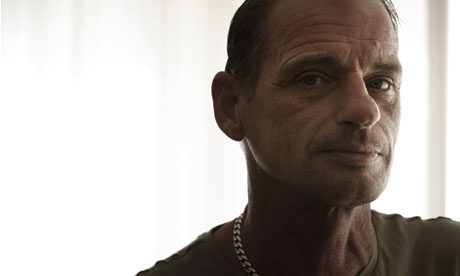 Kevin Young: ‘It was the worst of the worst. I thought I was going to be killed.’Photograph: Gary Calton for the Guardian
Kevin Young: ‘It was the worst of the worst. I thought I was going to be killed.’Photograph: Gary Calton for the Guardian"My name's Kevin Raymond Young and I'm 52 years old." There's something desperate about the way Young says it, as if he's clinging to the wreckage of his identity. Young was 17 when he was sent to Medomsley detention centre in County Durham. He'd already had a tough life – taken into care at two, sexually and physically abused by those who were meant to look after him – but this was something different. As soon as he starts to tell his story, he's in tears.
His experience of Medomsley in 1977 has shaped, or disfigured, his life ever since. He was convicted of receiving stolen property – a watch his brother had given him; the first he had owned. The police asked if he knew where it had come from. No, he said. Could it possibly have been stolen, they asked. He thought about it – well, yes, possibly. He was sentenced to three months' detention.
The morning after he arrived at Medomsley, Young was lining up for breakfast when he was picked out of the queue by Neville Husband, the officer who ran the kitchen. Young later discovered that Husband had asked for his file – he wanted to know everything about him; most importantly, whether he had family who were likely to visit him. Young was one of a handful of new inmates sent to work in the kitchen with Husband.
"There are two things that are important to successfully sexually abuse somebody," Young says. "By successful, I mean without being prosecuted. One, anonymity or silence – if you can't carry out your act without people knowing, you're not going to be at it very long. The second thing you need is a victim who's 'reliable'; a reliable victim is someone who's already been abused to the point where, if they do speak out, who on Earth is going to believe them? And who on Earth is going to believe Kevin Young, the pauper's son, who has been in and out of care, who's a knife-wielding thug, a bully?" That is how a number of care home reports described Young, but he insists he was a quiet, over-obedient boy. "The truth is, nobody would have believed me."
Abuse might be too mild a word for what Husband did to Young over the next two months. "I was raped repeatedly, tied up and ligatured [around the neck]. It was the worst of the worst." That day after Young arrived, Husband took him to a storeroom above the kitchens that he had converted into a lounge. He locked the door, took out the key and stuffed the keyhole with tissues. "I thought I was going to be killed," Young says. "I was told by Husband that you could easily be found hanged at Medomsley, and that that year, six boys had already hanged themselves."
Young insists there wasn't just the one man abusing him. "He was so sure of himself that he was able to take me out of the prison against my will and to his private house just outside the prison gates. He was married with one child. In his house I was blindfolded, ligatured and made to lie on the stairs. Then three or four others raped me as well. I could see them from the bottom of the blindfold. A rope was put round my neck and turned till I passed out. Husband was an expert at it. He was a big, stocky, powerful man."
Perhaps the most horrifying aspect of the Neville Husband story is that the detention centre, the prison service and the police all knew of his interest in boys. In 1969, eight years before Young was jailed, Husband was arrested at Portland borstal in Dorset and charged with importing pornography. The material seized included sado-masochistic images involving teenage boys.
Astonishingly, the charges were dropped. Husband admitted showing the material to boys in his care, but argued that he was interested in child pornography only because he was conducting research into homosexuality. Details of that arrest were written on top of his employment record and went with him throughout his career. He moved to Medomsley, the smallest detention centre in the country, where he abused boys aged between 16 and 19 until he was moved 16 years later. From accounts given by victims and former staff, he may have abused boys every day of his tenure there.
Dr Elie Godsi, a former senior psychologist for the Home Office, gave evidence in the civil action brought by Young and other victims. "This is one of the worst cases of sexual abuse I have come across in 17 years of working for the Home Office, and with some of the most prolific sex offenders in the country," he said.
Today, more than 40 years since Husband started abusing teenage boys, more and more damaged men are coming forward to reveal how he ruined their lives. Some have been paid compensation, but they say that's not enough. They want to know how he was allowed to get away with it for so many years, and why the police and colleagues in the prison system failed to notice his abuse or act on their suspicions.
Kevin Young came out of Medomsley on 17 June 1977, a day before his 18th birthday, and went straight to Consett police station, the nearest to the centre. "I explained to the officer that I'd just been released from Medomsley, where I'd been subjected to a constant series of assaults by one of the officers and others I couldn't identify. I showed him the marks on my neck where I'd been ligatured the night before. I was told it was a criminal offence to make such allegations against a prison officer because I was on licence. They were basically threatening to take me back to Medomsley, so I scattered pretty quick."
After that, Young did his best to block Medomsley from his mind. He tried not to think about it, never told anyone about it, and got on with his life. After a short stint in the punk rock group the Angelic Upstarts, he became a successful businessman, owning 22 cafes and a number of furniture stores. By 1996, he says, he was worth close on £2m and was running a security firm with his girlfriend.
One night they were chasing a couple of store robbers in the centre of York, where Young now lived, when he skidded into a man of the church near York Minster. "He was there with his full carry-on, his big hat and all his gear. When I banged him in the chest, it knocked the wind out of him, and as I was falling backwards, his spit was coming down on me. I looked up and there he was. And in that split second I was back 20 years ago, with him on top of me."
Since leaving the prison service, Husband had trained and qualified as a minister. The shock of seeing him after all this time sent Young into meltdown. He collapsed. "There were people lifting me up, saying, 'Are you all right?' and my girlfriend was shouting, 'What are you doing? We need to be going. There's a chase on.' I was just frozen. I didn't know where I was."
How could he be so sure it was Husband after all that time? "Course I knew it was him. I could taste him." What does he mean? "He spat all over me and humiliated me. He opened my mouth and spat into it time and time again." Young breaks down again. "It was horrendous. Off he trotted and I'm left in the middle of York with my girlfriend shouting, 'What are you doing?' I walked off and wandered about for four hours while my radio was going, 'Where are you going? Where are you?" He's shaking and weeping, and stops for a cigarette.
Young cracked up. He started to drink and became addicted to drugs, spending £1,250 a week on cocaine. He sold the business for a third of its value to subsidise his habit, lost his girlfriend, lost his house, lost everything. Once the memory he'd blocked for 20 years returned, he could think of nothing else. He moved into a barn in the middle of nowhere, spoke to no one and gave up on life.
Two years after he had come across Husband again, the police tracked down Young to a bedsit he was then living in and pushed a note through the door asking if he'd give evidence about abuse that had happened at St Camillus, a home where he had been abused before Medomsley. For months he ignored them, but eventually he agreed to talk. He told the police that what had happened at St Camillus was bad, but there was worse. "I said let me tell you a true horror story, and I rattled off what had happened to me at Medomsley. About three weeks later, a chief inspector came to my door and said, 'We've been after Neville Husband for years.'" Husband had recently been the subject of complaints about abuse of boys and girls in his congregation while working as a minster at two churches in Gateshead, but the parents involved had not wanted to pursue the matter. When his office was later raided, sex aids were found in his drawers and child pornography on his computer.
Young was taken to a safe house in York, where he was shown a film on an 8mm projector. "The film showed a young boy about 16-17 with a rubber thing across his head, being choked. And they asked me, who do you think it is there?" Again, his voice breaks and he takes a few seconds to compose himself. "And I said, 'I don't need to tell you who I think it is.' It was me. So I had to sit down and watch 40 minutes of me being… He'd made films of many of his victims. Ccccrrrrrrrr…" Young imitates the sound of the projector. "When I was being assaulted, I could hear that. Remember the old wind-ups? Half my pain comes from listening to crrrrrrrrrrr."
Young's willingness to give evidence against Husband led to his arrest. It should have been a cathartic moment, a vindication, but it wasn't. If the police had known about Husband for years, why had nothing been done? After all, they had evidence of his obsession with child pornography dating back decades, and Young had reported the abuse 22 years earlier. Young is convinced the police had held on to the film for 14 years without doing anything about it. "I believe the films and photographs were taken from the property of Neville Husband in 1985," he says.
That's the year the police raided Medomsley and arrested Husband's friend Leslie Johnson, a storeman at the detention centre. Johnson was later convicted of abusing a young inmate, Mark Park, who, he said, had been "given to him" by Husband. Park told police that Husband had also abused him, but they took no action. Years later, at Husband's trial, Park named several officers at Medomsley who, he said, had made comments to him about Husband abusing him and other boys. A former officer at Medomsley told the court, "Staff knew something was going on between Husband and the boys." Another former officer said Husband used to keep a boy behind in the kitchen at night and "we always used to feel sorry for that boy". Park himself was later convicted of a rape unrelated to Medomsley. He is now serving a life sentence.
Husband left Medomsley shortly after Johnson's arrest and moved to Frankland, a high-security adult jail near Durham. When staff at Medomsley searched his drawers and lockers, they found pornographic material and sex aids. Husband was to continue working in the prison service for another five years. He requested a move to Deerbolt, a young offenders institution, where it is alleged he abused inmates again. He eventually moved back to Frankland, from where he was medically discharged in 1990. On his retirement, managers at Frankland put him forward for the Imperial Service Medal, writing, "Husband has served with diligence and fidelity and should be recommended for the award."
In 2003, Husband was finally convicted of sexually abusing five young male inmates between 1974 and 1984, after pleading not guilty. Sentencing him to eight years in prison, Judge Cockroft said, "Your victims were young detainees who you chose to work for you in the kitchen so that you could abuse them. There you caused them to submit to your unwelcome attentions. This was a gross breach of trust. You, and others like you, caused their damaged personalities. Until now, they thought no one would believe them."
In 2005, Husband's sentence was increased to 10 years after new victims came forward and he admitted to attacks on four more boys. In 2007, the Crown Prosecution Service announced it would not be charging Husband over an allegation that he went on to abuse a boy in Deerbolt because it would "not be in the public interest".
There has never been a public inquiry into Medomsley, despite the scale of abuse, nor did the prison service hold an inquiry into how Husband's abuse continued for so long. James Millar Reid was governor at Medomsley from 1976 to 1978, which covers the time when Kevin Young was abused. At the beginning of September 2000, he was visited by detectives from Durham, who were investigating Husband. A few days after the visit, he went missing and his body was found in a wood in Stelling Minnis, near Canterbury. The inquest was held in February 2001 and an open verdict was returned. The cause of death recorded was "Unascertainable" as the body was badly decomposed.
Some senior figures who worked at Medomsley are reluctant to talk about their time at the detention centre. Tim Newell, a well-known liberal thinker within the prison establishment, was the governor from 1979 to 1981, when Husband was regularly abusing boys in his charge. According to David McClure, a former officer at Medomsley, who gave evidence at Husband's trial, Newell "thought very highly of Husband". McClure said search teams were banned from the kitchen on the orders of management, but that there were always strong rumours that Husband was sexually abusing boys who were working in the kitchen. "There was general knowledge about this – among staff and boys in the centre," he said. But Newell and other governors wrote letters supporting Husband's many applications to remain at Medomsley when the prison service suggested he be promoted and posted elsewhere. Newell was repeatedly asked to comment on Husband and Medomsley for this piece, but he failed to answer emails and phone calls over a period of months.
Martin Narey was director general of the prison service when Husband was convicted in 2003. He had been the assistant governor at Deerbolt when Husband was moved there after the arrest of Johnson, and the assistant governor of Frankland. He went on to become CEO of Barnardo's, the charity for vulnerable children.
Why did Narey never call for a public inquiry? "For the simple reason that, at the time, I knew nothing about it," he says. "That may sound very odd, with what we know now about Neville Husband. But the first conviction, which came just as I was leaving the director general post, was not brought to my attention. I suspect it was because, at that time, the magnitude of Husband's offending was not known."
Would he support a public inquiry now? "I have no objection to some sort of inquiry – whether a public inquiry would be justified, I don't know. It is troubling that Husband was able, apparently, to hide his offending over such a long period. However, and speaking after having had long experience of child abuse issues at Barnardo's, I am now very aware of the ability and success of such offenders in conditioning those around them."
Narey admits that, when he was running it, the prison service dealt inadequately with sexual abuse in prisons. "As director general, I was intolerant of physical abuse and racism, and sacked a lot of staff… But at that time there was very little awareness of male-on-male sexual abuse, either in prisons or in wider society." Neither Narey nor Newell – still two of the most respected figures in prison circles – has ever publicly apologised for the failure to spot Husband's abuse.
In 2009, Husband was released from prison after serving just over half his sentence. A year later, he died of natural causes. Yet the fallout from his decades of abuse continues.
Steve, whose name has been changed, admits he's paranoid. He has surrounded his home with seven closed-circuit television cameras and spends nearly all his time in his upstairs office, where he works and monitors the CCTV screens. "Work" is obtaining justice for the victims of Medomsley, for whom he is the liaison man. It has been the "cause" of his life for the past 15 years and will continue to be so until he gets somebody in authority to say sorry. "I could maybe then close it all down and move on."
Steve is wearing sunglasses and when he takes them off, his eyes look dead. His story is familiar – like Young, he went through a long line of children's homes, where he experienced differing degrees of abuse, before ending up at Medomsley. Again like Young, he stresses that abuse was nothing compared with what was to happen. Steve was sent to Medomsley for "aiding and abetting in stealing a car". His cousin Kevin had a stolen car, picked him up in it, and that was that. He was 16.
According to Steve, Husband stood out from the other officers. "When we first got there, we'd stand in line and he'd look at all the new recruits, laughing and joking with them, trying to be your friend and have some understanding about why you're here and that. He'd try to ingratiate himself. He picked people who had no one to visit them. All the victims were from the care system."
Husband had a shower built upstairs in the converted storeroom because, he claimed, the boys did not have time to wash before coming to work. That's where Steve was first abused. "He pushed us backwards into the shower, then started grabbing the things he shouldn't. I didn't know what to make of it or do, where to go. I was in prison, I couldn't run away."
How big was Steve then? "I was a scrawny little thing, about nine and a half stone. You tried to say no and it didn't make a blind bit of difference."
Does he suspect Husband abused all the kitchen boys? "I know he did. Everybody knew he was doing it. Nobody would say it was happening to them, yet it was the talk of the place. You'd get comments off the officers: 'What you been up to with Husband?' 'You're one of his boys?'"
The abuse wasn't just sexual, Steve says. "I saw him crushing one guy between two gates. He just kept doing it and laughing. Another time he put my hand in a hot pidi – a metal pie dish – and was pushing my hand down as he was fondling me." Did other officers see any of this? "He had a monopoly in that area. You weren't allowed to go in there. Officers had to ask him to go in."
When did Steve leave Medomsley? "28 August 1979," he says instantly. He came out traumatised: untrusting, angry, a loner. He started to drink heavily. Unlike Young, he didn't report the abuse to the police on his release. Then, in 1994, he was watching television and a report came on about abuse in a care home in Sunderland. Steve says he flipped. He was sitting with his wife, with whom he had never discussed the abuse. "I saw it, and just, pppffff, blew up. First the coffee table went over, and I was just destroying the house. I even hurt my wife by accident, throwing a guitar across the room. I didn't know what had happened."
Once he'd calmed down, he told his wife everything and they went to the police. Why had he never been before? "Well, if it's the system doing it, what's the point in going to tell the system about it? There was no possible redress. When I did eventually go to the police station, I got the answer I expected." Which was? "'We suggest you go home, put it behind you, because you can imagine the effect it will have on your wife and children should this get out on the estate where you live.'" Steve ignored the advice and took it to a higher police authority.
How did he feel after Husband was convicted? "I cried like a baby – with relief and satisfaction. Christ, at long last… Yes, we had done wrong, yes, we possibly deserved to go to a place like that, but we didn't deserve what happened there."
Has he found peace since Husband went to jail? "No, I'll never be over it. You only have one life and once it's irreparably damaged, that's it."
After Husband was convicted came the fight for compensation for his victims. The Home Office fought every allegation. At one point, Steve says, a doctor was brought forward in court to claim that Kevin Young was genetically predisposed to being abused. Young received £94,000 to compensate for his suffering and lost fortune. He reckons he spent £40,000 fighting his case. Steve received compensation in 2009 – £40,000. "It's not about compensation, it's about understanding. I gave it away," he says. Until he saw the report on television, he had worked in a number of jobs, but he has not been employed since. Now he is on jobseeker's allowance and a small sickness payment.
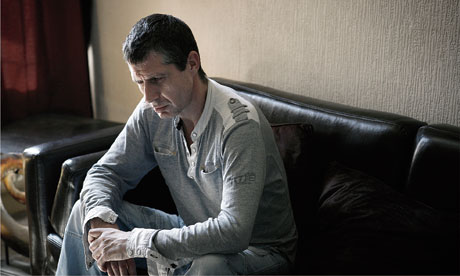 Richard Hall: ‘Nobody will believe you,’ his sister said about his abuse, ‘and you will be in bigger trouble.’ Photograph: Gary Calton for the Guardian
Richard Hall: ‘Nobody will believe you,’ his sister said about his abuse, ‘and you will be in bigger trouble.’ Photograph: Gary Calton for the GuardianRichard Hall, 48, lives in a first-floor flat in Heaton, a pleasant suburb of Newcastle. A quiet, softly spoken man, his eyes dart nervously around the room as we speak. Hall entered the care system aged just three weeks. The son of a prostitute mother and a pimp father, he was briefly placed with foster parents in 1963 before being moved from one care home to another.
By the time he was 12, Hall had been in 15 homes, and had suffered physical and sexual abuse in several of them. He was sent to Medomsley just before Christmas 1979. Like Steve, he had pleaded guilty to being carried in a stolen car and received three months' detention. A week later, while standing in the dinner queue, Hall was tapped on the shoulder by Husband and told, "You are working for me."
The abuse began almost immediately. On one occasion, Husband was about to rape him when he was interrupted by the arrival of another young inmate, Hall's friend Martin Wasnidge. Wasnidge later mocked Hall about Husband. Shame meant the two boys didn't talk to one another about what was going on. In 2003, during Husband's trial, Wasnidge hanged himself in prison: he had been questioned by police as a possible victim, but had denied being abused by Husband. Hall believes the denial was because Wasnidge did not want his fellow prisoners to know what had happened at Medomsley. Hall learned of Wasnidge's death as he stepped out of the witness box. The news left him guilt-ridden because he was the one who had told police Wasnidge had been abused (he had seen Husband groping him). "If I hadn't done that, he'd still be alive," Hall says.
Hall had one visitor at Medomsley – his sister, who was also brought up in care. Hall told her about the abuse Husband was inflicting on him. A victim of abuse herself, his sister advised him to say nothing. "Nobody will believe you, Richard," she said, "and you will be in bigger trouble."
Hall took refuge in drink. After he came out of Medomsley, he would down 24 cans of beer in an average day. Now, he has cut down to a dozen cans, maybe four days a week. On the other three days, he stays in bed with the curtains drawn. He says he feels "empty, a hollow man".
Like Steve, Hall seldom leaves his flat, which he decorated with some of the £40,000 compensation he received from the Home Office in November 2009. It was part of a total of £512,000 the Ministry of Justice paid out to 12 men. Hall is bitter about the settlement, which took six years to negotiate. When the Medomsley victims first sought redress, the Home Office used the statute of limitations to avoid payment. It defended that decision in a costly legal fight that went all the way to the House of Lords. Even when the law lords ruled in favour of the claimants, the Home Office refused to back down and declared its intention of fighting the claim in court.
David Greenwood, of Jordans Solicitors in West Yorkshire, has dealt with all the Medomsley victims' cases, representing 26 abused boys so far. He says that, given Husband's modus operandi, hundreds of boys may have been abused by him. Greenwood estimates the costs to the Home Office of fighting the cases at around £100,000. At the end of the hearing of Young's case, in 2005, his lawyers asked the Home Office if it intended to carry out a review or investigation of Medomsley. They were told there were no plans to do so. Greenwood was surprised by this. "It is odd when a senior prison officer has sexually assaulted boys, including taking them to his house to do so, and other staff seem to have turned a blind eye to it and not reported finds of pornographic material, that no investigation was carried out."
A spokesman for the Ministry of Justice told the Guardian, "In the late 1970s, several detainees held at Medomsley detention centre were physically and sexually abused by Neville Husband… At no stage has the Ministry of Justice attempted to defend the actions of Mr Husband. The prison service has come a long way since the 1980s, and significant efforts have been made to eliminate, so far as is possible, the mistreatment of prisoners."
The victims are appalled that they did not receive an apology. Steve complained to his MP, Stephen Byers, who wrote to the then justice minister Jack Straw. Straw replied: "The terms of the agreement did not include an apology." Hall says the settlement, and the nature of its conclusion, made him feel "abused again".
None of the victims has been offered counselling or psychiatric help; indeed, the terms of their settlement stated that if such help was required, the victims should pay for it out of their award.
Today, Kevin Young lives in a shed in a friend's garden. He's no longer addicted to drink or drugs, but he knows he's far from healthy. He says he's typical of Husband's victims – broken. He is considering suing the police. For decades, they denied he'd complained the day he was released, but he recently received a letter acknowledging that they had in fact received a number of complaints about Husband's abuse, "particularly during the 1970s and 1980s".
Richard Hall says he thinks about killing himself every day. He made one serious attempt in 2003, when he swallowed two packets of Prozac washed down with alcohol. One of the things he finds most devastating is that there were staff at Medomsley who did not act on their suspicions of Husband. "Some of them are still employed by the state, others are drawing their pensions," Hall says. "Do they not feel any shame?"
Martin Narey, former director-general of the prison service, doesn't know why or how those officers failed to report their concerns, but says he is outraged. "I feel angry about them. There is hardly a hair's breadth of culpability between Neville Husband, who abused children, and any of the staff who, apparently, knew about this and failed to take their concerns forward. In my view, there is a case for the police considering whether their failure to protect children amounted to aiding and abetting."
Source: Guardian (UK)
Bad Mom
April 25, 2012 permalink
Pretty Diamond is a baby girl who really is better off without her mother. Mother Kenisha Thomas stabbed the girl during a supervised visit in Baltimore Maryland.
expand
collapse
New horrifying details: Mother says 'I hope my baby is dead,' stabs 8-month-old
Baby found with knife in her neck
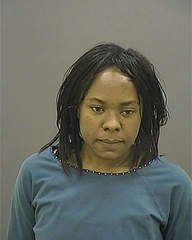
BALTIMORE - In what should have been a safe place for children, an 8-month-old was repeatedly stabbed by her mother.
Kenisha Thomas, was in the Department of Social Services for a one-hour visit with her daughter, Pretty Diamond. Pretty Diamond had been in the custody of Social Services for an unknown reason.
While visiting with her daughter, a social worker says Thomas was complaining about her daughter's care, saying she could do a better job.
At the end of the visit, the social worker says Thomas put the baby on the table and said, "It's about to be over."
The worker says Thomas reached into her purse, pulled out a kitchen knife and stabbed Pretty Diamond.
The social worker screamed. Others came running into the room.
One man picked up a chair and started hitting Thomas. Thomas dropped the baby. The man then grabbed Thomas, trying to control her.
Another worker grabbed the baby and ran out of the room. The baby still had the knife hanging out of her neck.
Other witnesses say they heard Thomas say she wanted to “Kill the baby. I hope my baby is dead. Lock me up. If I can't have her, no one will.”
Thomas has been charged with attempted murder, child abuse, assault, reckless endangerment and weapons charges.
Source: ABC news Baltimore
This freak incident is the pretext for additional humiliations heaped on parents in the name of security.
expand
collapse
Security upgrades made to social services offices after infant stabbing
Additional measures planned; child attacked at Baltimore office has recovered
A series of safety improvements are in the works at Maryland social services offices after an infant girl was allegedly stabbed by her mother during a supervised visit this spring, state officials said last week.
The child, Pretty Diamond, who is about a year old now, has recovered from her physical wounds and is in a "loving and safe home," state human resources secretary Theodore Dallas said. Her mother, Kenisha Thomas, is scheduled for trial Oct. 29 for attempted murder, assault, child abuse and related charges.
Thomas, 30, allegedly stabbed the baby, who was then 8 months old, five times in the head, neck and chest with a kitchen knife at the end of an hour-long visit in April. The mother, who had lost custody of the girl, sneaked the knife into the Baltimore Department of Social Services, according to authorities.
Since then, Dallas said, the state has taken steps to improve security at the social services offices. The agency has installed lockers in family meeting rooms and begun mandatory bag searches. Bags must now be stored in the lockers or kept in the visitors' vehicles.
"The system works best for everybody involved when everybody feels safe," Dallas said. The intent of the changes is to "make sure we have the proper balance of security and openness."
The Department of Human Resources will also install panic buttons in the family meeting rooms and install secure employee entrances to be used by staff to escort children for family visitation, according to the agency. Surveillance cameras will also be mounted throughout the offices and at employee entrances.
The cost of the repairs won't be calculated until after the installations are complete because the necessary improvements will vary by facility, said Brian M. Schleter, the department's director of communications.
Thomas allegedly smuggled the kitchen knife in her purse into the social services office in the 3000 block of E. Biddle St. Her purse was searched by a security guard but not put through a metal detector, which procedure did not require, Department of Human Resources officials said. Thomas did, however, walk through the metal detector, officials said.
A caseworker who was in the room when Thomas allegedly stabbed the baby screamed for help. A second social worker who responded hit Thomas over the head with a chair, according to authorities.
Thomas' public defender did not immediately return a request for comment.
Security at the social service offices is provided by private contractors. Watkins Security Agency was contracted for $7.4 million to provide armed and unarmed guards from November 2008 until March. The company was outbid by Admiral Security Services, which took over providing security at the offices recently.
Source: Baltimore Sun
Guilty after Proven Innocent
April 24, 2012 permalink
British couple Rohan Wray and Chana Al-Alas were falsely accused of abusing their own child. After Jayden was taken from mom and dad, he died in state care. When the courts determined that he died not from parental abuse, but from rickets, social services refused to return the other child Jayda to the parents for four months.
expand
collapse
Accused of killing our son... then robbed of our newborn daughter: The couple wrongly blamed for shaking their rickets-stricken baby to death relive their horrific ordeal
- Rohan Wray and Chana Al-Alas endured murder trial over death of Jayden
- Police and doctors adamant they had beaten him and damaged his brain
- But cleared after post-mortem revealed he had bone-weakening disease
- Then forced to face another hearing to win back custody of daughter Jayda
- 'We've had no apologies from those who caused us this unforgivable agony'
Jayda Wray came home on Good Friday for the first time.
The excited little girl, wearing a bright red cardigan, was carried through the front door by her father and mother, who had waited since the day she was born for the precious moment.
At their neat London home, the young parents watched wide-eyed Jayda play with new toys laid out on the floor.
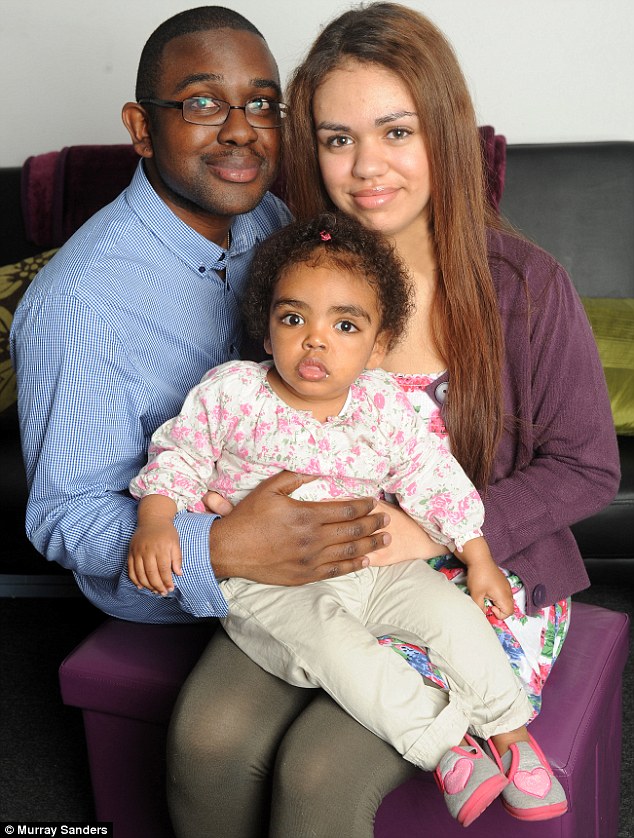 'Agony': Rohan Wray and Chana Al-Alas reunited with baby daughter Jayda, who was taken away from them after the couple were wrongly accused of murdering their son, Jayden
'Agony': Rohan Wray and Chana Al-Alas reunited with baby daughter Jayda, who was taken away from them after the couple were wrongly accused of murdering their son, JaydenThat evening, they bathed their little girl before she went contentedly to sleep.
‘When she woke the next morning she was so happy, as if she had been with us all her life,’ says her 22-year-old father Rohan now.
Yet behind this image of contented family life is a story so horrendous it’s hard to believe it happened in Britain in the 21st century. It has frightening echoes of Stalin’s Russia or the events in a Kafka novel.
Jayda was taken by social workers from her mother, Chana, now 19, the minute she was born in October 2010 and has, at 17 months old, only just been returned.
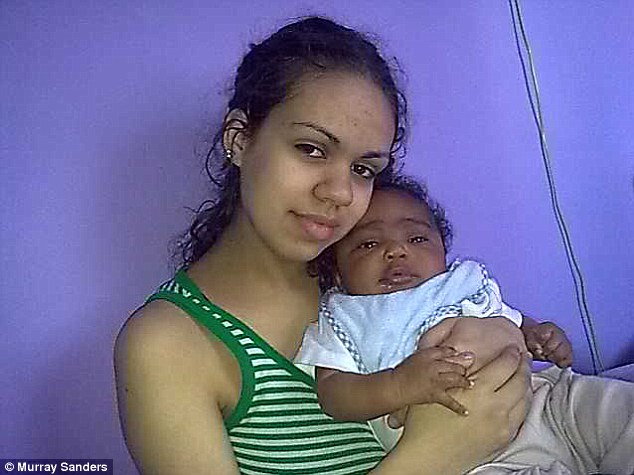 No apologies: Chana cuddles a two-month-old Jayden, who doctors and police believed had been gripped and twisted so brutally by his parents that it shattered bones throughout his body. They were cleared after it later transpired he had the bone-weakening disease rickets
No apologies: Chana cuddles a two-month-old Jayden, who doctors and police believed had been gripped and twisted so brutally by his parents that it shattered bones throughout his body. They were cleared after it later transpired he had the bone-weakening disease ricketsChana was not even allowed to hold her daughter before she was given to a foster family who hoped to adopt her.
For she and Rohan had been accused of one of the worst crimes imaginable: shaking and beating to death Jayda’s older brother, Jayden, a year and a half earlier, when he was four months old.
Scotland Yard detectives and doctors at the world famous children’s hospital, Great Ormond Street, believed the couple had gripped and twisted Jayden so brutally that bones throughout his body shattered, while blows to his head damaged his brain.
It was only after a six-week murder trial at the Old Bailey last year that the couple were cleared of all wrongdoing.
The judge ordered the jury to find them not guilty because a post-mortem revealed for the first time that Jayden had been born with rickets — a serious disease, linked to a lack of vitamin D, which causes seizures, weakens children’s skulls and causes their bones to break easily.
These are symptoms that closely mimic those of a deliberately shaken baby.
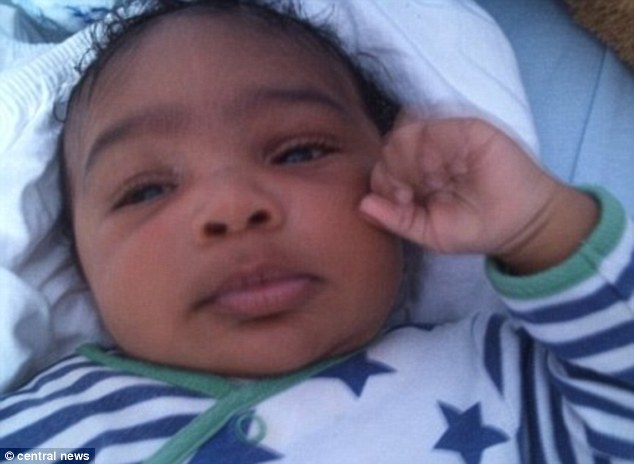 Cruel: After arresting them for grievous bodily harm, the Metropolitan police stopped the couple from seeing Jayden (pictured) before he died, three days after falling ill at home
Cruel: After arresting them for grievous bodily harm, the Metropolitan police stopped the couple from seeing Jayden (pictured) before he died, three days after falling ill at homeDoctors had, it transpired at the hearing, missed a vital clue when Jayden became ill and died three days later. They failed to detect Jayden had rickets, caused because Chana had so little vitamin D in her body that her son had not received it in the womb, or when she breastfed him.
But despite the couple being exonerated in December, their local authority in Islington continued to suspect them of causing Jayden’s death. Social workers refused to hand over their daughter, still with foster parents, and made them face a second hearing in a family court which ended just before Easter.
At the end of this hearing, High Court judge Mrs Justice Theis also ruled the couple were blameless, and said Jayda should go home immediately. And last week, the judge made public an important written judgment on the Wray family’s case.
It highlighted a growing epidemic of rickets among children in Britain, often caused by them or their mothers being deprived of sunlight in countries of the northern hemisphere.
The judge called for more research so medics spot rickets and do not jump to conclusions that a child with broken bones has been abused. She also pinpointed a failure by doctors to treat Jayden for seizures, often provoked by a vitamin D deficiency. This, she said, led to brain damage, which in turn may have played a role in the boy’s death.
But what happened to the Wray family is not an isolated case. The return of rickets — thought to have been eradicated in this country a century ago — has led to an alarming rise in false allegations of parents shaking children to death.
Yet when Jayden was rushed by his parents to University College Hospital in London on July 22, 2009, rickets wasn’t detected from an X-ray.
The child, who was soon having seizures and becoming dangerously ill, was rushed to London’s Great Ormond Street, where radiologists also examined X-ray images. They, too, failed to spot he had rickets.
When, later the same day at Great Ormond Street, scans showed a multitude of fractures all over Jayden’s body and head, the finger of blame was pointed directly at Rohan and Chana.
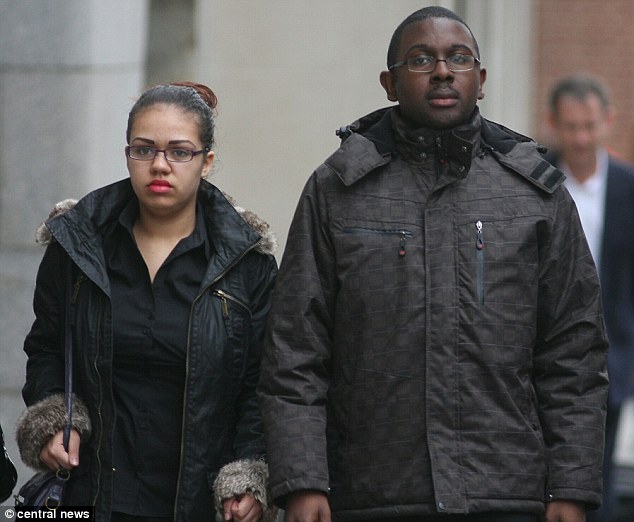 'Dangerous allegations': Rohan and Chana at the Old Bailey, where they had to endure a six-week murder trial before being found not guilty when evidence revealed Jayden had been ill rather than abused
'Dangerous allegations': Rohan and Chana at the Old Bailey, where they had to endure a six-week murder trial before being found not guilty when evidence revealed Jayden had been ill rather than abusedSome might say it is easy to understand how the medics, when examining a young child with what looked like serious shaking injuries, thought the parents had hurt him. Yet that can hardly excuse their failure to diagnose his rickets — and the horrific ordeal the couple suffered.
Jayden’s parents were accused by doctors of breaking his skull, his knee, elbow, shoulder, hip, ankle and wrist. Medics believed he had been intentionally shaken, and had his head hit on something hard.
The Metropolitan police were called in, and the couple were arrested at the hospital in the middle of the night, and charged with causing him grievous bodily harm.
Police stopped them from seeing their son before he died, on July 25, 2009, three days after falling ill at home. Cruelly, they were barred from a cot-side christening of Jayden by a vicar, which they had requested. It was watched only by nurses.
‘We never saw Jayden alive again from the moment of our arrest, because doctors and police thought we might harm him again,’ recalls Rohan. ‘The next time we were close to Jayden was at his funeral just before Christmas last year, when we’d been cleared of murder and his body was released by Scotland Yard.
‘Yet we have received no apologies from those who caused us this unforgivable agony. There are medical staff who, we believe, should be disciplined over Jayden’s death. Since the tragedy of Baby P, doctors, the police and social workers have become over-keen to snatch children from innocent parents.’
And Chana adds: ‘These people in positions of authority made allegations against us without any proof, or discovering Jayden had rickets. This is dangerous.’
Rohan and Chana met through friends when Chana was 14 and still a schoolgirl. When she gave birth to Jayden aged 16, he was a much-wanted and loved baby.
The young parents attended all the antenatal appointments at the hospital or GP’s surgery. And after he was born, no one — from the health visitor to local doctors — saw as much as a bruise on the boy.
The couple’s nightmare started when they woke at five one morning in July 2009. They found Jayden, who slept in a cot in their room, with his tongue stuck to the top of his mouth and refusing to be breastfed.
Rohan says: ‘We thought he looked very sleepy, and saw his mouth would not open properly. But he had suspected flu a week or two before, and we thought he was still ill.’
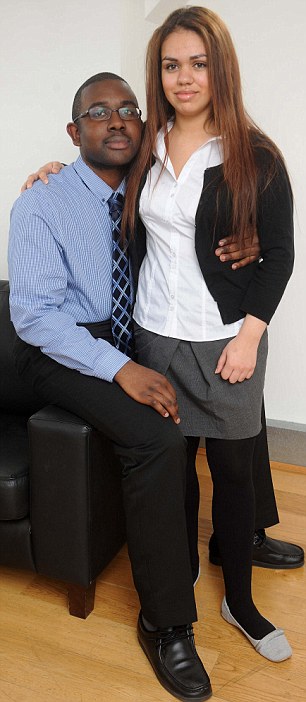 Second torment: Rohan and Chana after their victory in the High Court, where they had to face similar accusations after the local authority refused to hand back their daughter, Jayda
Second torment: Rohan and Chana after their victory in the High Court, where they had to face similar accusations after the local authority refused to hand back their daughter, JaydaRohan walked around with his son in his arms. The couple put Jayden in his baby bouncer, and tried waving a set of keys, his favourite plaything, in front of his face. The boy reached out for them, and followed them with his eyes. But still he refused to breastfeed.
The couple then rang University College Hospital near their home. But when Rohan described his son’s symptoms to a doctor, he was told it did not sound like ‘anything serious’ and to take the baby to a GP.
Rohan phoned his local doctor’s surgery for an appointment the instant it opened at 8.30am.
The doctor they saw, a student in his second year of training, examined the baby and found little amiss. But he told them to go to University College Hospital paediatric walk-in clinic to double-check on him.
They travelled there by bus, and a paediatric specialist said there was nothing wrong with the child, apart from him not opening his mouth. One doctor even pronounced him as ‘fit as a fiddle’.
Crucially, nothing was ever done at the hospital to deal with the seizures he had started having.
During the day, doctors decided to scan Jayden’s body. While rickets was never suspected, those initial scans showed Jayden had a fracture to his skull and that his arms were broken.
By 6pm, his condition had worsened and doctors said they wanted to send him to Great Ormond Street. They warned his parents that the baby might not even make the journey by ambulance. CCTV hospital footage shows Chana collapsing to the floor in grief.
That night, at Great Ormond Street, a paediatric consultant also told the couple that Jayden was unlikely to survive.
Rohan says: ‘It was like, “Oh sorry to be so blunt, but you know your son is going to die.” I asked the consultant what had caused this — and he just glared at me as if he believed we had done something to our son.’
It emerged at the criminal and family court hearings that the consultant had that night written in the child’s medical records: ‘In the absence of any explanation, this has all the features of inflicted head trauma.’
The couple were later arrested by police, alerted by the hospital, for suspected grievous bodily harm.
Two days later, they were told Jayden had died. The following year the police changed the charges to murder. Chana — by then seven months pregnant with Jayda — was sent to Holloway prison to await a Crown Court hearing.
Rohan was also sent to prison for two months at the start of the murder inquiry. At other stages, he had to wear a tag, obey a strict curfew and for a time was banned from seeing or speaking to Chana.
When she gave birth to Jayda, their daughter was taken from her, and the couple were only allowed to see her, supervised, for a few hours a week. They were barred from visiting her on Christmas Day two years running.
Rohan says: ‘I blame University College Hospital for killing our child.
‘We want an investigation into how Jayden died — and why our daughter was taken from us. We are taking legal advice on suing the police, and the hospitals that treated him.’
There may be some who still doubt the couple’s innocence, but the fact is they have been cleared — twice.
Their solicitor, Jenny Wiltshire, says: ‘So many lessons must be learned. Doctors should be aware of the dangers of vitamin D deficiency in mothers and their babies and must be trained to spot signs of rickets on X-rays.’
It was only by chance that an eminent paediatric pathologist, Dr Irene Scheimberg, was called to give evidence at the couple’s murder trial. She conducted a post-mortem on Jayden and found ‘obvious sign of rickets’, including weak bones and a weak skull.
Rohan says: ‘If Dr Scheimberg had not done the autopsy, we would have been found guilty of murder and Jayda would have been put up for adoption.
‘Not only would we have lost our son, but we would never have seen our daughter again.’
Source: Daily Mail
Going Home
April 24, 2012 permalink
After a year of foot-dragging by Norway social services, toddlers Abhigyan and Aishwarya Bhattacharya are back on Indian soil.
expand
collapse
Norway children back home: Top 10 developments
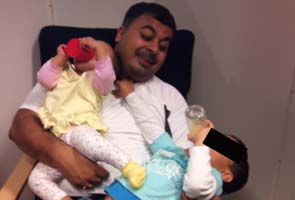
New Delhi: The Norway nightmare, which lasted almost 12 months, has finally ended for the Indian family with toddlers Abhigyan and Aishwarya returning home today morning. The children landed in Delhi a little before 10 am with their paternal uncle Arunabhas Bhattacharya, foster father and a case worker from Norway's Child Welfare Services (CWS). Here are the top 10 developments in the case so far:
- In a major breather for the Bhattacharya family, a Norwegian court on Monday decided to hand over the custody of two children to their uncle. "I am very relieved today," Anurup Bhattacharya, the father of the children, had said after the verdict was announced. The children's return home is also seen as a diplomatic win for India. External Affairs Minister SM Krishna said, "They belong to India; they are Indian nationals. I thank the government of Norway and my distinguished counterparts."
- Arunabhas and the two children left Norway for India less than two hours after the court gave him custody. While the mother of the children, Sagarika Bhattacharya, is in India, father, Anurup, is still in Norway.
- Abhigyan, 3, and Aishwarya, 1, were separated from their parents Anurup and Sagarika Bhattacharya by the Norwegian Child Welfare Services in May last year. Trouble began for the Bhattacharyas when the workers of the kindergarten, where three-year-old Abhigyan used to go to, noticed that the boy had been showing symptoms similar to autism. The workers reported his condition to the CWS which began observing the family closely ostensibly to offer help even inside the privacy of their homes.
- The parents' interactions with the children were recorded on camera and were analysed. The CWS later concluded that the boy was suffering from attachment disorder which they said was the result of a disconnect between the mother and child; they also said the child had witnessed violence between the parents. The CWS workers started then interfering over how their children should be fed or where and with whom they should sleep. They asked the father to take leave from work to help build the relationship.
- On May 11, 2011, when three CWS workers came to the Bhattacharya home, an argument broke out with the mother. One of the workers said the little girl should be taken outdoors as the atmosphere at home was too tense, but a little later the parents were told over the phone that their daughter had been in emergency foster care. On the same day, their son who was away at the kindergarten was also taken away directly to an undisclosed location. He too had been put in emergency foster care.
- In November 2011, a family court in Stavanger declared that the children will stay in foster care till they turned 18. The CWS refused to give custody of the children to any family member.
- Sagarika's parents then started a campaign back in India and sought the help of the Foreign Ministry which intervened and got the case reopened.
- Anurup and Sagarika fought a long legal battle with Norwegian authorities to get their son and daughter back to the family. The CWS, which has kept the children in foster care since May last year, made a recommendation to the Stavanger district court that the children's custody should be given to the uncle and they should be allowed to return to India.
- Sources say just before they left for India, a faction of the CWS reportedly wanted to get a stay on the court order.
- Gunnar Toresen, the head of the Child Welfare Services, still insists that their initial decision to separate the children from their biological parents was correct. He, however, said they were satisfied with the uncle as the new primary caretaker of the children.
Source: NDTV
Addendum: In November 2012 a court in West Bengal restored custody of the children to their mother Sagarika Chakraborty.
Protecting While Intoxicated
April 24, 2012 permalink
Scottish social worker Ian Armstrong has been caught driving with an alcohol level double the legal limit.
expand
collapse
Vulnerable children social worker banned for driving over the limit
Social worker who reported his neighbour for drink-driving banned for doing the same thing.
A social worker who works with vulnerable children has been banned from driving after being caught behind the wheel at nearly double the limit.
Ian Armstrong was caught driving at almost double the legal limit after spending the previous night drinking to celebrate getting a new job.
Armstrong, 44, believed he was safe to drive on his way to work but was found to still be well over the legal limit.
A court was told that Armstrong was celebrating getting a new post which meant he would no longer face a 140-mile round trip to drive to work each day.
Perth Sheriff Court heard he was banned from doing any driving at all for 12 months and fined £500 after he admitted drink-driving.
Armstrong of Abbey Lane, Edinburgh, admitted drink-driving on the M90 between Inverkeithing and Perth at Bridge of Earn on 16 December last year.
Fiscal depute Nicola Manison told the court police officers had been carrying out random checks, which were part of the festive clampdown on drink-driving.
She said Armstrong's vehicle was pulled over and it was immediately apparent that he smelled strongly of alcohol. He then failed a roadside breath test.
Solicitor Richard Freeman, defending, said Armstrong was a social worker who worked with children and had faced a lengthy commute to his job in Dundee.
Mr Freeman said he had been having drinks with a friend the previous evening after getting a new job which meant he would not face such a long commute each day.
He told the court that Armstrong had specifically arranged to use his flexi-time to start work later on 16 December and was on his way to the office when he was stopped around 10am
Mr Freeman added:"He has told me he has strong views about drink-driving and some time ago reported a neighbour of his family who he suspected was drink-driving."
Source: STV (Scotland)
United Church
April 24, 2012 permalink
Kathryn Blaze Carlson continues her series on forced adoption, this time the United Church is poring over its archives.
Beyond Belief
April 24, 2012 permalink
An entry-level social worker with the Catholic Children's Aid Society of Hamilton can earn $51,416 - $69,778 in addition to an excellent benefit package. We found this offer on their web page. The actual offer is child protection worker (pdf), local copy.

No More Social Work
April 24, 2012 permalink
The University of Southampton is ending its social work program. Translated out of bureaucratese, the announcement seems to say that the programs are being dropped because they do not meet standards of international excellence. Social work is junk science.
expand
collapse
University of Southampton to scrap social work courses
MSc programmes face the axe as university cites lack of 'internationally excellent research' in social work studies
The University of Southampton has launched a consultation on plans to close two postgraduate social care programmes.
In a letter to stakeholders, professor Judith Petts, dean of the faculty of social and human sciences, says that following a three-year review and analysis of the department, the university is considering to stop offering MSc in social work and MSc in professional studies because it cannot meet its "overall strategic commitment in this area".
"This would occur when our current students have completed their studies," Petts writes.
"Southampton is committed to ensuring that internationally excellent research can be found in all our academic disciplines, and that our teaching is strongly informed by this research.
"We are therefore channelling our resources into the university's greatest research strengths and reviewing activities within our portfolio of programmes that align with these strategic objectives."
A spokesman for the university said the consultation was taking place as the quality of the research being produced by the university was not of a high enough level to sustain the courses. It said it had not been able to reach a position where it could ensure that "internationally excellent research can be found in this academic discipline".
A blog has been set up to provide information for those wishing to respond to the consultation, which will run until 1 February. Responses to the consultation will then be summarised and a report taken to the university's executive group. A final decision on the future of the programmes will be announced on 29 February.
If agreed, the closure would happen once the current students have completed their respective courses, most likely to be in the summer of 2013.
Clare Parkinson, a respondent to the university's blog, describes the proposed decision to close the programmes as a "blow to the profession".
"The innovative approaches of specialist social work academics at Southampton make a significant contribution to the teaching, practice and research developments in social work, especially in the area of reflective and relationship based social work practice and interprofessional practice," she says in her comments.
Fran Fuller, chair of the British Association of Social Workers, said that it was following the development "with concern" and hopes that it is not becoming a trend.
"While admittedly there is currently a surplus of social work graduates, which has led to difficulties with them gaining employment as newly qualified social workers; rather than scrapping these degrees, the numbers of students on all courses should be capped so that students get quality tuition and a valuable experience. This would also help to manage the issue of placement shortages," Fuller said.
"Social work programmes make a strong contribution to university life as they offer opportunities for people without conventional academic backgrounds to engage with university study and to become qualified professionals. This is an opportunity that people local to Southampton may miss out on now."
In December there were reports that the government was planning to cut social work education grant in 2012-13 by 18%. However, the government has not yet confirmed or denied this.
Source: Guardian (UK)
Get a New Teacher
April 23, 2012 permalink
Ontario's school students have discovered they can get a teacher suspended by making an allegation of abuse. The CBC profiles substitute teacher Susan Dowell who was docked a month's pay on an unsubstantiated allegation. Once the allegation is made, the teacher is suspended and CAS takes its time about investigating. Our video Get a New Daddy (flv) is becoming "Get a New Teacher".
While the CBC pleads for falsely-accused teachers, they have no regard for families. Their solution for teachers is to sic CAS and the police on falsely-accusing students and parents. How about just ignoring silly accusations?
expand
collapse
Falsely accused teacher calls for accountability
Accused of abusing students, teacher spent weeks under suspicion
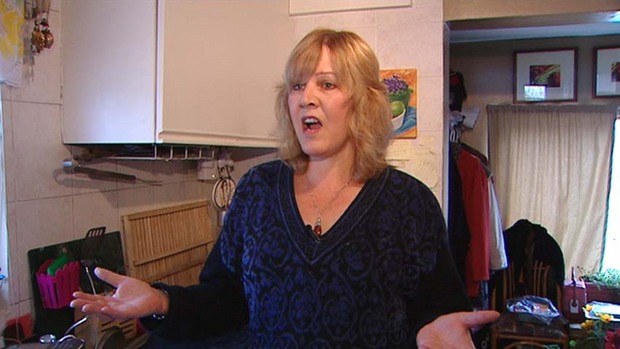 Teacher Susan Dowell was accused of abusing students after she challenged a boy for throwing out a banana at lunch.CBC
Teacher Susan Dowell was accused of abusing students after she challenged a boy for throwing out a banana at lunch.CBCAn Ontario substitute teacher who was cleared of abuse allegations is speaking out, suggesting that parents and students be held accountable for making false accusations.
"Something is terribly wrong here," said Susan Dowell, who has taught school for 15 years. "Children who do make false allegations – parents who make false allegations – what happens to them in the end?"
The complaint against Dowell came after she told a grade five boy not to throw away an uneaten banana at lunch. Dowell was on lunch room duty, during a one-day teaching assignment at R.L. Graham elementary school, in Keswick, Ont.
"I told him to eat it…or put it back in his lunch box and take it home. His parents paid good money for fruit like that for him to eat," said Dowell.
Dowell said the boy went home that night and complained, so one of his parents went to the school vice principal.
"The story that the parent heard and later told the administration…is that I had him go into the garbage to take out a squishy banana — eat garbage basically — and humiliated him in front of his friends."
Dowell said the incident happened right after she had enforced classroom rules, for a group of unruly students – the boy’s friends – that morning.
"They came in with an attitude immediately…like they're going to see how far they can go," said Dowell. "I know enough, in a situation like this, I'm not going to get into a battle with students…so I asked them to go to the office immediately."
Banana incident sparked investigation
The following week, while teaching at another school, she was suddenly sent home and told she was under investigation by Ontario's Children's Aid Society.
"I was just shocked and confused," said Dowell. For over a week, she said, no one would tell her what she was accused of doing.
"For nine days. It feels like you're waiting to find out a diagnosis with cancer. It's crazy making…I was told not to speak to anyone."
Dowell later learned that after the parent complained about the banana incident, the vice principal talked to the other students she taught that day. She said the group of unruly students she’d sent to the office had plenty of complaints.
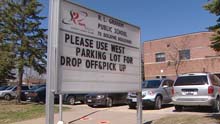 Dowell was on a one-day teaching assignment at R.L. Graham Elementary School, when the incidents happened.CBC
Dowell was on a one-day teaching assignment at R.L. Graham Elementary School, when the incidents happened.CBCThe following week, while teaching at another school, she was suddenly sent home and told she was under investigation, by Ontario's Children's Aid Society.
"Somehow all these children came up with all these incredible stories of how I had grabbed their wrists and I left red marks that apparently weren't showing later," said Dowell.
"Children are getting a lot more savvy these days. It used to be, 'make the occasional [substitute] teacher cry.' Now they know they can have you suspended."
Without talking to Dowell, the school immediately called the Children’s Aid Society, which it is required to do by law, when there is an allegation of abuse.
"I thought I'd be treated as a professional colleague and I'd be given the benefit of the doubt and at least gotten a phone call afterwards to ask what had happened, from my perspective."
Told to expect police
Dowell was removed from the board’s substitute teacher roster. Her union told her she might even be arrested.
"You are told police could come to your door any moment. What do you tell your family and friends? It's a horrible situation to be in, knowing that you're totally innocent," said Dowell. "I knew I had never been alone with a child. I never put my hands on a child…but it felt like I was guilty until proven innocent."
Dowell spent a month at home on partial pay, borrowing money to pay her bills, before the CAS concluded the allegation was unfounded.
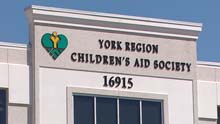 The Children's Aid Society concluded the complaints against Dowell were unsubstantiated.CBC
The Children's Aid Society concluded the complaints against Dowell were unsubstantiated.CBC"The Society…has determined that Ms. Dowell did not use excessive physical force with the students in her class or intentionally embarrass the student during her interactions with him in the lunchroom," read a letter to Dowell’s lawyer from the York Region Children’s Aid Society.
"The Society is not substantiating any concerns related to the alleged use of physical force or public humiliation by Ms. Dowell, nor would the Society be concerned should Ms. Dowell return to her occasional teaching position."
Dowell was then allowed to go back to work, but she still faces a probe by the school board, which is standard protocol when a complaint is made.
"These are separate investigations with different standards," said Christina Choo-Hum of the York Regional School Board. "We have a much closer eye and more detailed approach to our investigation."
Due diligence
When asked why a minor incident would lead to a full-blown investigation, Choo-Hum said, "If there is the slightest question [about a teacher] we err on the side of caution. It’s due diligence."
Choo-Hum said no one from the school or the board would comment on Dowell’s case, because it’s a personnel matter. She said the board does not keep statistics on how many complaints against teachers it investigates, or what the outcome is.
Nadia Ciacci, president of the union representing 1800 occasional teachers in the York district, said she’s seen false complaints multiply every year, from none three years ago, to eight this school year. Ciacci said all were unfounded.
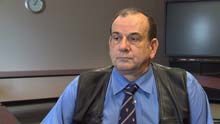 McGill University associate professor Jon Bradley has studied false accusations against teachers and said accusers who lie should be held accountable.CBC
McGill University associate professor Jon Bradley has studied false accusations against teachers and said accusers who lie should be held accountable.CBC"It’s devastating for teachers," said Ciacci, who said one has left the profession as a result. "It’s important to insure the safety of students, of course, but also to insure the safety of teachers. The message has to get out there – that this has to stop."
Jon Bradley, associate professor of education at McGill University, has studied false allegations against teachers. He knows one case where the teacher committed suicide. He said careers and lives are ruined, particularly for men falsely accused of sex abuse.
"It’s really a mess," he said. "We seem to be almost afraid. We seem to be saying – if a kid makes an accusation it must be true. Kids don’t lie. That’s the first thing we say – kids don’t lie."
He cited one case that should have been suspect from the start, because of how the nine-year-old girl characterized what happened.
"She said 'he leered at me suggestively.' I don’t know how many grade four students would use an expression like that."
No consequence for accusers
He said parents and children involved in false allegations don’t face any consequences, and they should.
"What’s really sad in this is we’ve got adolescents making terrible accusations against teachers and getting off scot-free with absolutely no penalty whatsoever," said Bradley.
Ciacci of the teacher’s union said she would like to see parents held legally responsible, perhaps through an amendment to Ontario’s Parental Responsibility Act.
"Look at the cost to taxpayers as well for the Children’s Aid involvement," she said. "Parents need to be held accountable."
 Dowell said the group of Grade 5 students misbehaved and challenged her in class, then claimed she had abused them.CBC
Dowell said the group of Grade 5 students misbehaved and challenged her in class, then claimed she had abused them.CBCChoo-Hum said there is no school board policy or standards for dealing with students who make false allegations.
"Students are dealt with on a case-by-case basis [at the school level]," said Choo-Hum.
Dowell said she is confident the board investigation will also find she did nothing wrong. Regardless, though, she said she will never feel the same in the classroom.
"The next time I see a kid throw out a banana I am obviously not going to say anything. And next time I see belligerent, defiant behaviour – am I to turn the other cheek?" said Dowell.
"“I feel very much I am damned if I do I am damned if I don’t."
Source: CBC
Compensation for Bereaved Parents
April 22, 2012 permalink
Prime minister Harper has announced an income supplement to help parents of children who die or go missing. According to recent reports from the Pediatric Death Review Committee, close to a hundred children a year die with open CAS cases in Ontario. The new program won't help the two hundred parents of those children. Only cases investigated by the police as criminal are eligible for compensation.
expand
collapse
Parents of killed or missing kids to get income help
Parents on leave from work to receive $350 a week for up to 35 weeks
 Prime Minister Stephen Harper discusses the income support program for parents of victims of crime alongside Senator Pierre-Hugues Boisvenu.Jacques Boissinot/Canadian Press
Prime Minister Stephen Harper discusses the income support program for parents of victims of crime alongside Senator Pierre-Hugues Boisvenu.Jacques Boissinot/Canadian PressParents with children who have died or disappeared as a result of a crime will be eligible to receive income support if they take time off work to cope with their loss, the federal government announced today.
Beginning on January 1, the new income support benefit will provide $350 per week for up to 35 weeks for parents of murdered or missing children who are younger than 18 years old, and whose death or disappearance is the result of a Criminal Code offence.
A child's disappearance would be considered a Criminal Code offence if police investigate it as a suspected crime.
"Often and understandably, parents are unable to return to work after their children disappear or are murdered," said Prime Minister Stephen Harper at a news conference in Sherbrooke, Que.
Harper announced the program alongside Human Resources and Skills Development Minister Diane Finley and Senator Pierre-Hugues Boisvenu, who became a victim's rights activist after his own daughter was killed in 2002.
Jobs of mourning parents to get protection
To be eligible, parents will need to have earned a minimum income of $6,500 in the previous calendar year and take leave from employment. The government said it would also alter the Canada Labour Code to allow for unpaid leave for federally-regulated employees and ensure the person's job is protected while receiving the benefit.
If missing children are found, the benefits would continue for two weeks after the child is found, assuming the parents are still entitled to the benefits for those weeks.
The government says the benefit will help more than 1,000 parents annually, basing those numbers on a 2008 Statistics Canada crime survery. The total number of youth who were victims of homicide, other offences causing death, kidnapping and abduction was 1,229 in 2008, according to Statistics Canada.
Parents who receive the benefit that are later determined to be criminally responsible for the death or disappearance would have to repay the benefit, a spokesperson for Human Resources and Skills Development Canada said.
Parents will apply for the benefit through Service Canada.
The program follows on a campaign promise to provide support for parents of child victims of crime. That same campaign promise also included families of gravely ill children as potential recipients of benefits, but Friday's announcement made no mention of those families.
"That was a platform commitment and we are reviewing legislation," said a spokesperson for HRSDC.
Source: CBC
Foster Runaway
April 21, 2012 permalink
Sixteen-year-old Tristan Zimmerman is missing from foster care in Saskatchewan, a likely runaway.
expand
collapse
Police seek missing Yorkton teen
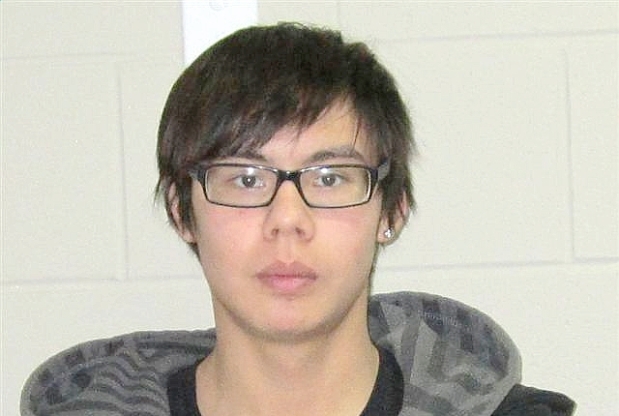 Tristan Zimmerman, 16, has been missing since April 18.Photograph by: Courtesy RCMP , handout
Tristan Zimmerman, 16, has been missing since April 18.Photograph by: Courtesy RCMP , handoutPolice are requesting the public's help in locating a missing 16-year-old Yorkton boy.
Tristan Zimmerman last seen on Wednesday afternoon in Yorkton, according to an RCMP media release. Zimmerman had been visiting a friend before he was reported missing by his foster mother.
Zimmerman, or "chachi mac" as he is known to friends, is 5-foot-4, weighs 100 pounds and is of aboriginal descent. He has short, dark hair with long bangs and wears glasses. He was last seen wearing beige pants and a black, hooded sweatshirt. He was also carrying a black knapsack and had taken his skateboard with him. Zimmerman does not suffer from any physical or mental health related issues.
Police said they believe Zimmerman is still in Yorkton, although he has been known to hitchhike to Regina.
Anyone with information on his whereabouts is asked to call the RCMP's Yorkton Rural Detachment at 306-786-4500.
Source: Regina Leader-Post
Baby Boy Dies in Shelter
April 21, 2012 permalink
An eleven-month-old baby boy has died in a Toronto women's shelter. Since the death was in the social services system, expect silence from authorities.
expand
collapse
Baby pulled from bathtub dies
An 11-month-old boy has died after being pulled from a bathtub at a women’s homeless shelter.
Toronto Police say paramedics responded to the Sherbourne St. residence around 8:18 a.m. Tuesday and found the tot with no pulse.
“The baby wasn’t breathing,” Const. Tony Vella added.
He said the child was rushed to hospital where he was pronounced dead.
A manager inside the city-run short-term shelter declined comment as she was still speaking with investigators.
Other workers told media to “go away,” saying many of the women staying in the facility didn’t know about the incident and they didn’t want to cause grief to expectant mothers. Some mothers pushing their babies in strollers appeared upset.
Around 10 a.m., police forensics investigators arrived at the scene.
A man, who would only identify himself as Willie, said he saw the baby being carried out on its back by paramedics.
“The mother came out, I could see her bawling,” said the witness. “She wasn’t in handcuffs, so I thought there must have been some sort of accident.
“The baby wasn’t wet, so they couldn’t have just pulled him out of a tub,” he said.
Police wouldn’t say if there is anything suspicious about the baby’s death.
Source: Toronto Sun
Volunteers Help CAS
April 20, 2012 permalink
OACAS leader Mary Ballantyne extends thanks to the thousands of volunteers who work for CAS at no charge. Because of their generosity, Mrs Ballantyne can collect her annual salary of $150,000 without the need to share it with a small army of volunteer workers trying to help children.
expand
collapse
Recognizing volunteers at Ontario's Children's Aid Societies, National Volunteer Week time to support children, youth and families involved with child welfare
EMC news - During National Volunteer Week, April 15 to 21, the Ontario Association of Children's Aid Societies (OACAS) and Ontario's Children's Aid Societies recognize the crucial role played by those community members, parents, teachers and retirees who give their time to support vulnerable children, youth, and their families.
"Volunteers at Ontario's child welfare agencies make an enormous difference to the lives of children and youth by being there for them and for their families," said OACAS executive director Mary Ballantyne.
"More than 5,600 volunteers help by being there for children and youth as tutors or special friends, by helping families by being a parent aide or support during visits, by driving children and youth to activities, appointments and visits, and by supporting the work of their local Children's Aid by being an involved community member or board member."
As the OACAS honours and celebrates 100 years of service to child welfare in Ontario, the role of volunteers in history and today is also recognized.
Up until the 1920s, much of the work of Children's Aid Societies was carried out by volunteers.
"Volunteers have always played an integral role in caring for and supporting children, youth and families, and we really appreciate their contributions," added Ballantyne.
Today, volunteers make valuable contributions which allow agencies to provide enriched services to children, youth and their families.
The stats show:
- 5,608 volunteers gave their time to agencies.
- More than 25 million kilometres were driven by volunteers.
- Volunteers gave more than 600,000 hours of their time.
Volunteers have a wide range of skills and fill roles in various capacities at agencies.
Some volunteers offer skills that can be used in working directly with children and youth, others offer their expertise to provide leadership and guidance to their local Children's Aid Society as members of the board of directors, working with the administrators of the agency. If you are interested in supporting the work of your local Children's Aid, contact them to learn more or for more information, visit www.useyourvoice.ca
ABOUT THE SOCIETIES
Since 1912, OACAS has represented Children's Aid Societies in Ontario and provided service in the areas of government relations, communications, information management, education and training to advocate for the protection and well-being of children. In 2012, OACAS is honouring, reflecting upon, and celebrating 100 years of service to child welfare in Ontario.
Source: Nepean/Barrhaven EMC
No More CAS
April 20, 2012 permalink
M’Chigeeng Chief Joe Hare has banned CAS from his territory.
expand
collapse
Chief Joe Hare bans Children’s Aid from entering M’Chigeeng territory
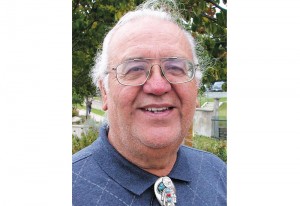
M’CHIGEENG—M’Chigeeng Chief Joe Hare is seeking assurance from the Children’s Aid Society (CAS) of the Districts of Manitoulin and Sudbury that an overly aggressive approach of removing children from their homes will never be used on the M’Chigeeng First Nation, and while he waits for this assurance in writing from the executive director, a 30-day ban has been placed on all CAS organizations, preventing them from setting foot on reserve territory.
The chief said the CAS should always seek an alternate plan of care, with the help of the community, with apprehension as a last resort.
This month-long ban comes on the heels of the news that the family of a M’Chigeeng band member, living off-reserve in Algoma, had their family separated earlier this month in what Chief Hare believes is an unacceptable fashion, calling the move “heavy handed.”
In a press release, the chief reports that the family was met with two CAS workers (from the CAS of Algoma), six Ontario Provincial Police Officers and an ambulance attendant “because the house where the family was living was not spotlessly clean and dirty dishes had not yet been washed.”
“This invasion of a home is what alarms me,” said Chief Hare, noting it was this act that prompted the ban. “They are treating parents like criminals, and they don’t even bother contacting our office, as they are required to do.”
The Expositor contacted Jim Baraniuk, executive director of the Algoma CAS, and while he could not comment on this case directly, he said his organization always tries to accommodate the needs of their First Nations clients, but sometimes, because of the risk involved for the children, alternative measures are not an option and apprehension occurs.
Mr. Baraniuk said that generally when a case involves a First Nations family, the CAS is accompanied by Nogdawindamin Family and Community Services, a child welfare protection service akin to Manitoulin’s Kina Gbezhgomi.
When asked if the Algoma CAS contacts the member band of the families, he says they do if the case is before the courts, but not necessarily before an apprehension. This, says Chief Hare, breaks the rules.
Colette Prevost, executive director for the Children’s Aid Society for the Districts of Sudbury and Manitoulin, acknowledged that chief, council and band representatives will always have the welfare of the children of their community first and that “we’re all on the same page.”
She also said that direction is taken on a case-by-case basis, but that the respect of the First Nations and their children is first and foremost.
“Before we come onto a First Nation or engage a member of a First Nation community, that community is advised of the plan,” she explained, noting that Kina Gbezhgomi workers will also attend the home along with band representatives or even the chief.
Ms. Prevost said she received a letter from Chief Hare advising her of the ban, but said she hopes to have a meeting with the community leader.
“We respect and understand what the priorities are and we will certainly work toward addressing the question as to whether a ban is necessary for that amount of time,” she said. “We need to ensure the families still get CAS services, through band representatives and the chief. Chief and council need to always be advised and make sure they’re not left unaware.”
“We’ve always maintained a good relationship with the First Nation communities, not meaning that it’s free of problems, but this is clearly an issue to the chief, given his level of response, and I look forward to meeting with him,” Ms. Prevost added.
Chief Hare talked with Ms. Prevost on Monday morning, asking her for assurance in written form. “Talk doesn’t mean very much to me,” he said. “I need to be assured that their approach will be careful and considerate.”
The chief acknowledged that there are currently more aboriginal children in care than ever before—three times the amount of the 1940s, in fact.
“Obviously something isn’t being done right,” Chief Hare said, “and a preventative approach is more effective.”
The chief said the last time something similar to the situation on the North Shore happened in M’Chigeeng, the council chambers were designated a safe zone for the children and the CAS was told they could by no means enter the room. Eventually, he continued, the CAS left.
When asked about the plan of action should the CAS be found in M’Chigeeng, the chief replied matter-of-factly, “Well, I’ll just ask them to leave.”
Source: Manitoulin Expositor
Addendum: The Indians want their own children's aid society.
expand
collapse
First Nations opt out of non-Aboriginal Children’s Aid Service
Chief Isadore day says First Nation agency has better working knowledge of Aboriginal culture, history
A northern reserve wants to end its relationship with non-native children’s aid services.
The chief of the Serpent River First Nation said people have concerns about children being removed from the reserve without a full understanding of First Nations values.
Isadore Day said the community wants to have a local First Nation agency provide child welfare services instead of those provided by both Algoma and Sudbury CAS, depending on the case.
But until Nogdawindamin Family Services is certified by the province, Serpent River will use a native children's aid agency — Dilico Anishnabek Family Care — based out of Thunder Bay.
“They do have all of those things that we need as [a] First Nations community, in terms of knowledge of the language, knowledge of the history and the culture,” Day said.
“And they have a very good working sense of how to work in First Nations communities because they are a First Nations organization."
Nogdawindamin does preventative work and child mental health work for the community and began working toward its CAS certification in the early 2000s. Day estimated the group was about halfway through that process.
The change is another example of a First Nation taking back its identity and community control, he added, noting they want to stop children from being removed from First Nations communities — something that is striking familiar to the residential school experience.
This past spring on the M'Chigeeng First Nation, the chief there banned CAS workers from the community for a month.
Currently the Canadian Human Rights Commission is holding hearings in Ottawa to look at whether the federal government has discriminated against native children by underfunding child welfare.
Source: CBC

Baby Theft
April 18, 2012 permalink
After Texas mother Verna McClain suffered a miscarriage, she decided to steal another mother's baby to present to her fiancé. Possibly she intended to keep their impending marrage on course. She murdered Kala Marie Golden Schuchardt and took her three-day-old baby Keegan Schuchardt. The stolen baby was not even the same color as the thief. Police found the baby alive and unraveled the whole story within hours. Baby thief and killer McClain has been arrested and Keegan is back with what is left of his family.
expand
collapse
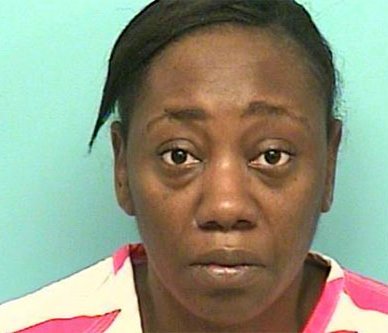 The defendant Verna McClain
The defendant Verna McClain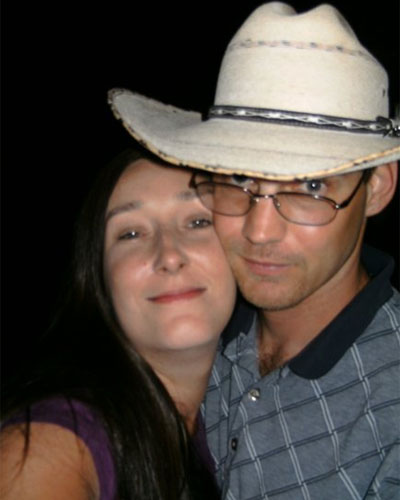 Kala Marie Golden, left, with husband, Keith Schuchardt
Kala Marie Golden, left, with husband, Keith SchuchardtSheriff: Verna McClain took baby, told fiance' he was the father
SPRING, Texas — Authorities say a woman accused of killing a young mother and abducting a 3-day-old boy had suffered a recent miscarriage.
Officials in Montgomery County say Verna McClain, 30, had told her fiance' she was pregnant with his child. They planned to marry in May.
After she had a miscarriage, McClain allegedly killed Kala Golden and abducted tiny Keegan Golden from outside a pediatrician’s office in suburban Houston. Keegan was found unharmed hours later with McClain’s sister.
McClain now faces a capital murder charge and is being held without bail. Her fiance, who was not identified, is being interviewed by authorities.
Montgomery County deputies say McClain — a licensed vocational nurse— went to the Northwood Pediatric Center to find a woman with a baby.
"We think she knew the patterns of the pediatric center because she’d taken her children there in the past," said Lt. Dan Norris with the Montgomery County Sheriff's Office.
Kala Golden took her baby to Northwood for a checkup. When she returned to her truck, McClain was waiting with a handgun.
"An altercation erupted with the suspect. The suspect shot Kala several times, then took the child from the pickup," said Montgomery County Sheriff Tommy Gage.
Despite her wounds, deputies said Golden tried to get the baby away from McClain. The suspect hit the dying mother with her car as Golden reached into the Lexus screaming, "My baby!" according to Norris.
An Amber Alert was issued for the baby, 3-day-old Keegan Schuchardt.
Golden was rushed to Memorial Hermann in The Woodlands where she died.
Hours after the abduction, detectives who canvassed parking lots in the area spotted a Lexus fitting the description of the killer's car at the Fawn Ridge apartment complex, located in the 12400 block of Sawmill Rd.
While officers were searching the complex for the missing child, they said McClain showed up and asked to speak to them.
Investigators said McClain admitted to shooting Golden so she could take the baby, and told investigators where Keegan was.
Texas Rangers found the child at a home off FM 1960, where McClain's parents live, around 8:15 p.m. Tuesday. The baby was with McClain’s sister, deputies said. He was not harmed.
The sheriff’s office said that McClain tried to represent Keegan as her own child to family members. Her sister allegedly told authorities that McClain had plans to "do the adoption" after taking Keegan.
Keegan was placed in CPS custody, but was released to unnamed family members late Wednesday morning.
Keegan’s father, Keith Schuchardt, said he did not have his son.
Schuchardt said he hasn’t yet signed Keegan’s birth certificate, complicating the process of getting his child back.
"My son-in-law is trying to get his child, and they got to run background checks on everybody before we can even get our baby back. My daughter’s baby. It was my daughter that was murdered. And it’s just really sad," said Linda Golden, the victim’s mother.
Keith Schuchardt said he was at work when he got the call about the shooting, and by the time he got to the hospital, his wife was dead. He said he didn’t know why anyone would want to harm her.
"It’s just a random thing, I think. We don’t have any enemies. I don’t know why anyone would do it. Maybe she lost her baby and wanted a baby … or to sell him. I want to get my baby back. I know that," Schuchardt said.
Though initial reports from the scene of the abduction indicated there was a man in the car with McClain, detectives on Wednesday morning said they believe she acted alone.
Still, the investigation was ongoing, and investigators were planning to examine evidence and conduct additional interviews later in the day.
Source: KHOU-TV
Two weeks after the killing of his wife, father Keith Schuchardt is not allowed to see his own children.
expand
collapse
CPS worsens husband's grief over slain wife
On April 17, Keith Schuchardt absorbed the horrific news that an unknown assailant had gunned down his wife of 3½ years, Kala, and had fled with the couple's three-day-old son, Keegan. When he learned from news reporters that the infant had been found safe, Schuchardt went to the Montgomery County sheriff's office around 3 a.m. on April 18 to retrieve his son. He had hoped his nightmare was coming to an end. It was only beginning.
A caseworker from Child Protective Services noticed that his name was not on the birth certificate. It was a clerical error that could be resolved easily with the Schuchardt's marriage certificate. Then she started asking questions.
Did Schuchardt have a criminal history? Did he abuse illegal substances? The 38-year-old air conditioning worker owned up to a seven-year-old drug conviction. He also answered honestly that a drug test would likely find marijuana in his system.
That's when Schuchardt, who only hours before learned his wife had been murdered in a senseless act of violence, received the second devastating blow: CPS would require him to allow a brother-in-law to take temporary custody of Keegan, as well as his 2-year-old son, Keaton, and Kala's 4-year-old son from a previous relationship, Kamden.
"They told me I couldn't get my kids," Schuchardt recalls. He asked if he could call a lawyer. "She said if you get a lawyer, they will stay in CPS custody. I didn't want to do that. I just found out my three-day-old baby is safe. I want to sit there and hold my three-day-old baby."
'I'm like nobody'
As expected, the drug test showed marijuana use, as well as an opiate, which Schuchardt attributes to a Vicodin Kala handed him when he complained of a headache that morning. "I didn't do anything wrong," Schuchardt told me.
The next day, he voluntarily signed an agreement temporarily leaving his children in his brother-in-law's care while attending family classes "for three to six months."
Since then, he's buried his wife, and followed the news of the arrest of his wife's alleged murderer. In court, the judge denied bail to alleged shooter Verna McClain. Ironically, "the judge says, 'why should I give you bond when Kala doesn't get to be with her kids?' I don't get mentioned. I'm like nobody," Schuchardt says.
Veteran family law attorney Julie Ketterman, who has been retained by Schuchardt to get his children returned, maintains CPS had no legal right to take the children because there was no proof of "an immediate risk of physical or emotion harm of the child."
"Here you have children who have lost their mother and now the state has forced them to be without their father," Ketterman said. "As he is preparing to bury his wife, he doesn't get the solace of holding his own children."
While Schuchardt voluntarily signed an agreement to temporarily place his children with his brother-in-law, "it was two days after his wife's been shot," Ketterman said. And the report notes that "he says he doesn't understand why he is there because he's done nothing wrong. The government is basically holding his children hostage."
'He's been very honest'
Not so, said CPS media specialist Gwen Carter. Law enforcement called CPS into the case after the abduction. "If we are called to talk to a parent, we ask 'do you have a history of substance abuse?' and then we have to develop a plan with that family," Carter said. Of Schuchardt, she said, "He's been very honest."
But doesn't there need to be evidence of some injury? "The majority of calls we get are about neglect," she says. Was Schuchardt advised not to call an attorney? "I can't imagine anyone on our staff saying that," she said.
Ketterman says she would have advised Schuchardt that he didn't have to answer questions. Today, she says she will inform CPS that her client plans to reclaim his children, and revoke the "voluntary" placement plan signed under duress.
Clearly, Keith Schuchardt hasn't followed the straight and narrow path in his life. In one news report of the murder, a family friend described him as a "wild kid" who found stability in his marriage and in fatherhood.
CPS encounters frightening cases of drug-addicted parents abusing their children on a daily basis, and their vigilance is understandable. But in Schuchardt's case, Ketterman believes the agency intimidated a distraught, grieving husband and father, and in the process, trampled his parental rights.
I asked Schuchardt what Kala would do in his situation. He teared up, but said the feisty mother of three boys would fight until the children were returned.
Source: Houston Chronicle
Dufferin DCAFS/FTP in the News
April 15, 2012 permalink
MP David Tilson is proud to have his picture taken with the staff of Family Transition Place, which in the past has cooperated with children's aid to separate children from mothers taking shelter there. And DCAFS itself is holding a Wellies to Wishes auction at the Dufferin County Museum.
expand
collapse
FTP wins $187,000 in federal funding
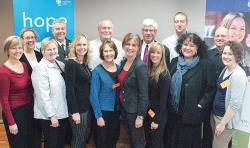 FTP FUNDING ANNOUNCED: Dufferin-Caledon MP David Tilson was at Family Transition Place (FTP) in Orangeville Tuesday to announce a grant of $187,000 under the federal government’s Status for Women program to FTP over the next two years. Other community partners, including Dufferin Child and Family Services (DCAFS), joined FTP staff and Mr. Tilson for the funding announcement. Representatives from the Social Innovation Research Group (SIRG) from the Faculty of Social Work at Wilfrid Laurier University will be partnering with FTP over the next two years. Shown here (left to right): back row – Lynette Pole-Langdon (FTP), Deputy Police Chief Wayne Kalinski, Pete Renshaw (FTP), Mr. Tilson, Mark Yungblut (SIRG), Orangeville Police Const. Scott Davis. Front row – Brenda Courtney (DCAFS), Stacey Copland (FTP), Lyn Allen (FTP), Trish Keachie (DCAFS), Norah Kennedy (FTP), Morgan Broganza (SIRG), Ginette Lafrenière (SIRG), and Gillian McCallum (SIRG). Photo/LINDSEY PAPP
FTP FUNDING ANNOUNCED: Dufferin-Caledon MP David Tilson was at Family Transition Place (FTP) in Orangeville Tuesday to announce a grant of $187,000 under the federal government’s Status for Women program to FTP over the next two years. Other community partners, including Dufferin Child and Family Services (DCAFS), joined FTP staff and Mr. Tilson for the funding announcement. Representatives from the Social Innovation Research Group (SIRG) from the Faculty of Social Work at Wilfrid Laurier University will be partnering with FTP over the next two years. Shown here (left to right): back row – Lynette Pole-Langdon (FTP), Deputy Police Chief Wayne Kalinski, Pete Renshaw (FTP), Mr. Tilson, Mark Yungblut (SIRG), Orangeville Police Const. Scott Davis. Front row – Brenda Courtney (DCAFS), Stacey Copland (FTP), Lyn Allen (FTP), Trish Keachie (DCAFS), Norah Kennedy (FTP), Morgan Broganza (SIRG), Ginette Lafrenière (SIRG), and Gillian McCallum (SIRG). Photo/LINDSEY PAPPFamily Transition Place (FTP) is to receive $187,000 in new funding from Status for Women Canaa for a community-based project addressing the issue of violence against women.
Dufferin-Caledon MP David Tilson along with representatives from the Orangeville Police Service and Dufferin Child and Family Services (DCAFS) were present for the funding announcement.
“Family Transition Place is an essential organization and this project will enhance their capacity to help women in our community,” said Mr. Tilson in a media release. “Our Government is pleased to support exciting projects like this one, which will work to develop a community action plan.”
Status of Women Canada (SWC) is a federal government organization that promotes the full participation of women in the economic, social and democratic life of Canada. SWC works to advance equality for women and to remove the barriers to women’s participation in society, putting particular emphasis on increasing women’s economic security and eliminating violence against women.
Also announced on Tuesday was the partnership between FTP and the Social Innovation Research Group (SIRG) from the faculty of social work at Wilfrid Laurier University to do a community development and research project.
SIRG “has got the academic credibility to be able to look at it from a purely research perspective but have the practical experience to then come forward with a model or ideas that we’re going to be able to carry out,” said Norah Kennedy, FTP Executive Director. “They have a bit of an outside lenses so they’re able to come in without any preconceived ideas or biases or notions, really look at our community in general.”
Ms. Kennedy says that with this grant money FTP and SIRG will be able to do this project completely apart from everything else that they are doing. The project will enhance community collaboration and create a community services and university collaboration that will be a first for FTP.
Ginette Lafrenière, Associate Professor, Faculty of Social Work and an SIRG director, said she has been working with FTP since 2007 on different research projects, which made this partnership a natural progression of their partnership.
“Essentially what we will be doing are interviews with local leaders, we will be supervised by a research advisory group in Orangeville so that they will be sort of guiding us throughout the entire process,” she said. “The focus is on violence prevention, with a focus on women and girls.”
She added that this is at its core a community project that has both men and women and different community partners, including the police, family and children’s services, local businesses etc.
Ms. Lafrenière admits to some excitement as they prepare for the project. She says that in a gender-based analysis around violence as a community problem, the solution has to come from the community in terms of being able to work collectively.
“So we’re going to be shooting a documentary and interviewing different stakeholders in the community, and there is also a very interesting prevention program that FTP runs in one of the schools and that will be a focus of interest,” she said.
“There is not a lot of time or money geared towards prevention work but I think Orangeville is on to something in terms of doing something around prevention work, so we’ll be talking a lot about prevention in the documentary as well.”
Ms. Lafrenière believes that from a leadership standpoint, FTP has demonstrated that they are possibly the best place for this kind of project.
She says this project aligns perfectly with this year’s theme for International Women’s Day and Week, Strong Women, Strong Canada – Women in rural, Remote and Northern Communities: Key to Canada’s Economic Prosperity.
This themes states that recognizing women and girls who live beyond urban centers as individuals who need support through projects yielding concrete results and strengthening families, communities and over all Canada, as a whole.
“The specificity of violence within a smaller remote communities and bigger cities is one of the things being researched more in depth in this study,” said Ms. Lafrenière. “We are of the mindset that there are enormous strengths and that we can learn form those strengths and that a small community actually has lessons to teach a larger urban centre as well.”
She says towns like Orangeville have different strengths and challenges than bigger cities. Some of the strengths are based on the informal network and relationships that community members can tap into.
“People know each other by name, when something happens in the community people hurt, it’s not a nameless individual, its somebody’s neighbor, or somebody’s mom. The ties are a lot more solid,” she said.
According to Ms. Kennedy the grant will be spread out over two years, covering costs, expenses, salary, etc., “with a couple of specific outcomes.
One is the documentary the other is a website, so some of the money will go into making sure there is an end product, they we’re not just walking away.”
She said FTP is excited about the grant approval. “Through this project we look forward to working with come of our community partners, such as the Orangeville Police Service and DCAFS to further our goal of a healthy, safe community, specifically for women and girls but ultimately for everyone,” said Ms. Kennedy.
“I am pleased to announce Government of Canada’s support for (FTP) to carry out a new grass-roots project that will partner key local stakeholders to develop a community action plan to reduce violence against women,” said Mr. Tilson in his funding announcement. “Along with providing a safe shelter to women and children in crisis (FTP) have become a model in our community reaching out to educate and inform residents.”
Source: Orangeville Citizen
DCAFS to host 3rd Wellies to Wishes live auction
Dufferin Child and Family Services (DCAFS) will host its third annual Wellies to Wishes live auction at 7 p.m. on April 21 at the Dufferin County Museum. Supporting Wellies to Wishes helps our youth to pursue post-secondary education or kids to get actively involved with art, music or sports.
“We have been very fortunate to have wonderful support from the art community, local businesses as well as caterers and restaurants,” said Trish Keachie, Executive Director, of DCAFS.
Wellies to Wishes has received support to date from 22 local artists including S.J. Pringle, Hugh Russell, and Sandi Wong, just to mention a few.
A number of Experience Packages will also be auctioned off by the amazing Bob Severn. The “Love to Ride” package includes a horseback ride for two from Rawhide Adventures, dinner, a night under the stars, breakfast and a ride in the morning, as well as a gift certificate from Herberts. For gardeners, “The Gardener’s Delight” package includes tickets to Canada Blooms 2013, a gift certificate to Home Depot, garden tools from Dufferin Garden Center and a gift certificate for a pair of Boggs.
“The highlight of the evening for many is the scrumptious food,” commented Heather Hayes, lead organizer. “We have had appetizers donated by Absolute Catering, Soulyve, Catering by Designs, Robins Catering, Greystones, cheese from Woolwhich Dairy, oysters from Ruby Pier, chocolates from the Chocolate Shop, and coffee from Starbucks – it is a foodies delight.” The event also features a signature drink and cash bar.
Visit the Wellies to Wishes facebook page to view the art work, the Experience Packages and to enter the contest to win two tickets to the event.
Tickets are available at Cobwebs and Caviar in Shelburne, Dufferin Child and Family Services (655 Riddell Road) and the Dufferin County Museum. For more information visit www.dcafs.on.ca or contact Jacqueline Moore by email at jacqueline.moore@dcafs.on.ca or by phone at 519-941-1530 ext 246.
Source: Orangeville Citizen
Titanic Abuse
April 15, 2012 permalink


A hundred years ago the Titanic struck an iceberg and sank at a cost of 1514 lives. So what is deadlier, an iceberg sinking a ship or a smiling social worker arriving to help a family? Our list of children who died after separation from their real families, mostly by social workers acting in the best interest of the child, has 1625 names. And that is only the few that make it into the press. Statistical estimates are that in the USA alone the death rate of foster children equals the Titanic every year.
Alberta Foster Deaths
April 14, 2012 permalink
The province of Alberta says that ten children died in foster care last year, and thirteen the year before. The two year death rate over 8700 foster children is 132 deaths per 100,000 child years, 4.7 times the general population. According to our statistical analysis, this is safer than any dependable report of foster death rates. Either Alberta has the world's safest foster care, or the report leaves some things out.
expand
collapse
All child deaths in care revealed
For the first time, the Alberta government has released the full number of children who died while in provincial care, and the number is much higher than previously reported.
Ten children died in the year that ended March 31, and 13 children died the year earlier, including those who died from illness.
"That's unbelievable. I had no idea there were that many," said Bernadette Iahtail, whose group Creating Hope Society holds a candlelight vigil every time they hear of such a death.
"There's a lot that don't even hit the news. That's just shocking," she said.
In the past, Alberta Human Services reported only deaths they confirmed happened because of a serious accident or homicide. Under that system, the department would have confirmed only two deaths last year, and six deaths the year before. There are about 8,700 children in care in Alberta at any one time.
The new, fuller reporting system is an effort to increase public accountability and transparency, said department spokeswoman Roxanne Dube Coelho. "Now we're going to be reporting all the deaths."
The deaths last year include five children who died for medical reasons and one youth who died from a blow to the head suffered at a house party. One child died from an alleged homicide, but it's unclear which case the provincial records refer to.
The information released contains only a few words about each death.
The medical examiner ruled the cause of one death could not be determined, and the causes of two deaths are still pending.
Jamie Sullivan's daughter Delonna, who died in care when she was four months old, is included in the 10 deaths last year.
Sullivan went to court to get the publication ban lifted from her daughter's name, and has been fighting for more transparency.
Her daughter died six days after being apprehended without a court order last April.
But Sullivan expected the numbers to be much higher, based on cases she's heard of in the news or through activist channels.
More information needs to come out about how each child died, she said.
"It's unacceptable how many children are dying. I want people to see the numbers so they become as horrified as we are."
Del Graff, the provincial Child and Youth Advocate, said he will investigate more deaths in the future since his office got increased independence April 1.
More information statistics on deaths and injuries will allow his team to compare Alberta's performance with other jurisdictions, he said.
"Our interest is really to look at the situation so we can learn how to prevent deaths in the future."
Source: Edmonton Journal
Addendum: The reporter provided the raw data for the figures in the article.
expand
collapse
From: Robert T McQuaid [mailto:rtmq at fixcas.com]
Sent: Saturday, April 14, 2012 7:46 PM
To: Stolte, Elise (Edm Journal)
Subject: Alberta foster deathsApril 14, 2012
Elise Stolte
Edmonton Journal
estolte@edmontonjournal.comSubject: Alberta foster deaths
Madam:
In an article you wrote for the Edmonton Journal (copied below) you cite a report from the Alberta government giving details of ten deaths in the last year in foster care, and thirteen more the year before. It sounds like you have a copy of that report. Are you able to share it, such as by pointing to a location on the internet where it can be found?
Thank you for your attention.
Robert T McQuaid
558 McMartin Road
Mattawa Ontario P0H 1V0phone: 705-744-6274
email: rtmq at fixcas.com
web: www.fixcas.com
Hi Robert,
The numbers will be in the annual report to be released this summer, but they gave me the numbers in an email ahead of time because they were ready and I asked.
But here's what I have (copy and pasted from the email). Hope it's helpful,
Elise
A reminder from our phone chat that up to 2010/11, the criteria we reported on was the percentage of children receiving child protection services who sustained an injury that led to overnight hospitalization or death, and did not include deaths due to natural causes and medical conditions as well as those that were the result of undetermined causes.
As part of our commitment to greater transparency, in the upcoming 2011/12 annual report the number of deaths for all children in care, regardless of cause of death, will be reported.
To be clear, children are classified as "in care" if they were receiving services under Emergency Apprehension, Apprehension Order, Custody Order, Custody Agreement, Temporary Guardianship Order, Permanent Guardianship Order, or Permanent Guardianship Agreement. They are not receiving services while in parental care.
- Between April 1, 2011 and March 31, 2012, there were 10 deaths of children in care, including those due to injuries (homicide, suicide, or accident), medical reasons or unknown causes:
- Five children died due to medical conditions.
- One youth died due to head trauma (sustained at a house party).
- One child died due to homicide.
- The cause of death for one child is undetermined (according to the Medical Examiner's report).
- The cause of death for the remaining two children is pending.
- Under the previous criteria, the number that would have been reported publicly is 2 deaths.
- Between April 1, 2010 and March 31, 2011, there were 13 deaths of children in care, including those due to injuries (homicide, suicide, or accident), medical reasons or unknown causes:
- Seven children died due to medical conditions.
- Three children died due to homicide.
- One infant's death was ruled by the Medical Examiner as cause and manner undetermined.
- One youth in permanent care overdosed on methadone.
- One youth in permanent care was hit by a car.
- Under the previous criteria, the number that was reported publicly was 6 deaths.
Addendum: Three days later the same reporter follows up with more on the foster death story.
expand
collapse
Fatalities of children in care symbolic of ‘broken system’
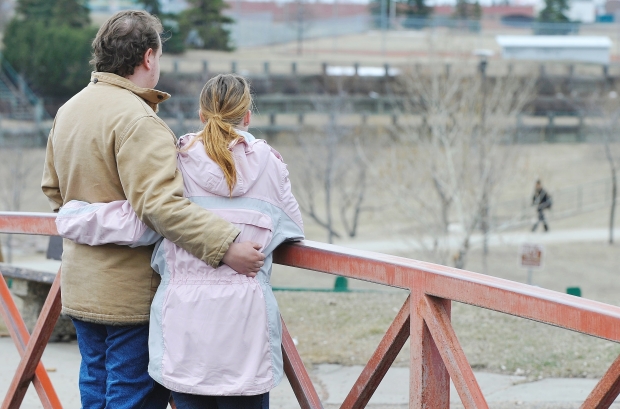 This couple who cannot be identified, had their baby taken away about a month ago and are worried about his welfare and unable to get any information in Edmonton, April 18, 2012.Photograph by: Ed Kaiser , edmontonjournal.com
This couple who cannot be identified, had their baby taken away about a month ago and are worried about his welfare and unable to get any information in Edmonton, April 18, 2012.Photograph by: Ed Kaiser , edmontonjournal.comEDMONTON - Over the past decade, children apprehended by the Alberta government have been almost twice as likely to die as children in the general population, according to numbers made public for the first time Wednesday.
That’s a painful number for people who feel like their children are trapped in the system.
It “scares the hell out of me. I’m more concerned about him dying than anything else,” said Scott, a 24-year-old from the Edmonton area whose infant son was apprehended one month ago.
“There shouldn’t be any deaths. They should have way less injuries because (child care workers) are supposed to have all this extra training,” said Scott, who can’t be identified under Alberta law.
Scott is fighting for access through the courts. His son was apprehended at a hospital after he and the boy’s mother brought him in, concerned he wasn’t keeping food down.
The numbers of deaths of children in care since 1999, both medical and accidental, were released to the Alberta Union of Provincial Employees under a freedom of information request.
About 10 children die in care on average each year, a rate of 0.08 per cent. That compares to 0.05 per cent for the general population aged under 18, as tracked by Alberta Health and Wellness.
Prior to this year, the provincial government had refused to release statistics on all child deaths in care, listing only those who died of serious injuries.
Guy Smith, president of the AUPE, said the number of deaths highlights broken system where too much responsibility has been contracted out, especially since the system was restructured in the mid-1990s.
“There’s way more potential for children to fall through the cracks,” Smith said. “When (the child welfare system is) not fully public, the lines of accountability get blurred.”
Front line staff are underpaid, see a high turnover, and have few ways to advocate for changes when they see substandard care, especially since contracted staff aren’t unionized, Smith said. “Advocacy and the ability to speak up is so important for people on the front line.”
But the numbers of deaths does not show an increase or decrease over time, and Jean Lafrance, a former child advocate, said blaming contracting out of services is too simplistic. “There are issues around case loads, issues around the complexity of the system,” said Lafrance, a University of Alberta professor who now works with community groups to help families navigate the system.
Government case workers spend the majority of their time on paperwork, leaving those with less training to work on the front lines, he said. For the parents, “we tend to give them a lot of hoops to jump through, never addressing the core problem.”
Mark Hattori, assistant deputy minister for Alberta Human Services, said contracting out has nothing to do with the death rate.
“The kids we serve are already in what we consider a vulnerable population,” Hattori said. “Sometimes kids coming into our care already sustained an injury.”
He gave the example of a shaken baby who dies within days of being taken into care.
Other children are exposed to drugs or alcohol in the womb, resulting in heart abnormalities and other problems, and still others have genetic disorders, he said. “Parents are unable or unwilling to care for these kids, then they die (as children in our care).”
Over the past three years, the department has been signing larger contracts, giving community organizations responsibility for all families in a sub-region through a project called “outcomes-based service delivery.”
They will evaluate that project in one year, said Hattori, and children’s safety will be part of the review.
Source: Edmonton Journal
Addendum: A memorial for the deceased children.
expand
collapse
Honouring aboriginal children in care
Hundreds of Edmontonians are honouring aboriginal children in the care of the child welfare system this weekend.
Bernadette Iashtail, executive director and founder of the Creating Hope Society of Alberta, says the event "Blanket of Remembrance" is to honour those who have died while in the system and also to find solutions for the problems that continue to exist.
"Some of them who are placed or gone into homes where they are hurt or abused and some of them have died," says Iashtail. "One of the biggest things, it's not about blaming. It's about how do we do things differently? How do we work differently with our families and our communities?"
The organization says about 67 per cent of children in care are aboriginal, and in the past two years there have been 23 deaths of children in care.
A traditional round dance ceremony is being held from 2:00pm until 9:00pm Sunday at Churchill Square. Iashtail says the organization is expecting between 500 to 1,000 people to come out. (ks)
Source: iNews880
Addendum: The only Alberta government publication mentioning the child death numbers is Human Services Annual Report 2011-2012 (pdf) and local copy. By our arithmetic on pages 35 and 36 they are giving 11 foster deaths.
Protecting Immigrant Children
April 14, 2012 permalink
Toronto Councillor Michael Thompson wants to put all immigrant children on a central database. For their protection, of course.
expand
collapse
City council looking to protect immigrant children
 City council looking to protect immigrant children. Toronto Council voted Wednesday to send off a notice of motion from Scarborough Centre Councillor Michael Thompson, here, to find ways to co-ordinate services to protect immigrant children.Staff photo/NICK PERRY
City council looking to protect immigrant children. Toronto Council voted Wednesday to send off a notice of motion from Scarborough Centre Councillor Michael Thompson, here, to find ways to co-ordinate services to protect immigrant children.Staff photo/NICK PERRYNewcomer families with children could have their names collected on a registry to help prevent and intercept instances of child abuse within their families.
Toronto Council voted Wednesday to send off a notice of motion from Scarborough Centre Councillor Michael Thompson to find ways to co-ordinate services to protect immigrant children.
The motion came after the high-profile arrest of the parents of 17-year-old Jamaican Canadian Melonie Beddersingh, whose body was found 18 years ago and was only recently identified.
The parents have been charged with first-degree murder. But child welfare agencies who attended a news conference with Thompson to promote his motion said it is often difficult to protect children who have recently arrived in the country with their families.
Immigration lawyer Mendel Green said that over 50 years of working in immigration law, he's seen numerous instances of what amounts to abuse.
"Unfortunately what I have recognized over the years is that when families come to Toronto what the parents do is freeze in their culture and don't modernize, and their children change and modernize and they go on dates, they want to go dancing and go to discos and in many cultures that is taboo," he said. "I have seen excessive parental punishment on children that have just done these simplistic things."
Thompson said co-ordinating services - including creating a registry - would make it easier for agencies to spot problems and deal with them.
"If we fail to act now children will continue to suffer and die needlessly," he said. "We have an extensive safety net in our city but immigrant children are often disconnected from the support in their communities and they do not know how to turn to the social service agencies that can help them. Our motion seeks to bring the services already in place to bear on the issue."
David Rivard, CEO of the Children's Aid Society of Toronto, said the agency would find a registry useful - but he wasn't sure that such a registry wouldn't amount to profiling.
"The difficulty I would be worried about would be the question around the profiling - that would be something I would want to think about," he said.
He did acknowledge that it is difficult for the Children's Aid Society to find instances of the worst abuse, because many children don't have official status.
"The difficulty is that most of these children have no status when they end up in our organization," he said. "When they have no status that makes it very difficult."
The matter was referred to the city's Community Services and Recreation Committee to develop a policy.
Source: Inside Toronto
Leaving Kids in Playground is a Crime
April 13, 2012 permalink
Pennsylvania father Govindaraj Narayanasamy left his children in a park to play for two hours. He has been charged with a crime, and his family is under investigation by child protectors.
expand
collapse
Police Say Dad Left Kids at Park To Shower
Police say a father left his two young children alone at Scott Park for nearly two hours Saturday to shower at LA Fitness.
Police say a father left his two children alone at Scott Park while shopping at Walmart and showering at LA Fitness.
Govindaraj Narayanasamy, 38, of Scott, was charged with two counts of child endangerment after township police said he left the 6-year-old girl and 9-year-old boy alone in the park for nearly two hours Saturday.
Officers were called to Scott Park at around 12:30 p.m. Saturday from a person who noticed the two children playing on the swings and slides alone without a guardian. The woman told police she had been keeping an eye on them for an hour because she knew the girl and became concerned.
Police officers were able to get Narayanasamy’s phone number and called him as he was driving back to the park. He arrived shortly after 1 p.m. and told officers he left the children only briefly while going to shop for snacks at Walmart in Raceway Plaza and shower at the LA Fitness in Great Southern Shopping Center.
Narayanasamy estimated he had only been gone for about 45 minutes, but the investigation revealed that he likely left the kids alone for nearly two hours, according to court records.
Police said Narayanasamy told officers he went to LA Fitness to shower after playing tennis at the park.
The county's Office of Children, Youth and Families is also investigating the incident.
Source: Chartiers Valley Patch
Nastygram
April 12, 2012 permalink
The District School Board Ontario North East, through their lawyer has asked us to make corrections to an article copied from Canada Court Watch.
expand
collapse
 HUMAN RESOURCES
HUMAN RESOURCES
LAW AND ADVOCACYToronto
Waterloo
London
Kingston
Ottawa
Hicks Morley Hamilton Stewart Storie LLP
77 King St. W., 39th Floor, Box 371, TD Centre
Toronto, ON M5K 1K8
Tel: 416.362.1011
Fax: 416.362.9680LAlLA KARIMI HENDRY
laila-karimihendry@hicksmorley.com
Direct: 416.864.7282
Cell: 416.473.6428File No. 2668-209
April 11, 2012
HAND DELIVERED AND E-MAIL (rtmq@fixcas.com)
Dufferin VOCA- Voices of Children Alliance
c/o Robert T. McQuaid
558 Martin Road
Mattawa, Ontario
POH 1VODear Mr. McQuaid:
Re: Notice of Libel Action and Request for Takedown
We are counsel for the District School Board Ontario North East (the "Board") in this matter.
We are writing to request that Dufferin VOCA- Voices of Children Alliance ("VOCA") immediately take down a posting and letter written by Richard and Henrietta Green that is currently posted on their website that defames the Board and its employee, Principal Sharon Bowes. Principal Bowes is the current principal of the Haileybury Public School, which is under the Board's jurisdiction.
We are also writing to serve you with a notice of intended action in defamation in accordance with section 5 of the Libel and Slander Act.
The letter at issue is dated March 24, 2012 and was posted on a website that is hosted by VOCA at the <www.fixcas.com> domain on or about March 28, 2012. The posting is entitled, "School Asked to Exclude CAS" and copies an article posted on <http://canadacourtwatch.com/content/parents-northern-ontario-get-ready-take-school-board-regarding-childrens-aid-society>.
The following words appear at <http://fixcas.com/cgi-bin/go.py?2012b.Green> (a printout of which is enclosed):
- "Parents Richard and Henrietta Green have sent a letter to their school board asking them to exclude Timiskaming children's aid workers from their school. The request came after their son was traumatized by a CAS worker interviewing him at school, and leaving him fearful that he would be removed from his parents."
This statement is untrue. Neither the Board nor Principal Bowes received this letter. Rather, the letter came to their attention from Canada Court Watch's website and VOCA's website.
- "A number of parents in District School Board 1 Ontario North East have reported problems with the Children's Aid Society going into the school to interrogate and to terrify children."
This statement is untrue. The Board has not received any complaints from parents in this regard, except from Richard and Henrietta Green.
- "A letter has been sent to the school board as the first salvo by local parents to get CAS out of the schools and to stop harassing their children."
This statement is untrue. Neither the Board nor Principal Bowes received this letter. Rather, the letter came to their attention from Canada Court Watch's website and VOCA's website.
- "Canada Court Watch has downloaded and reviewed the official school board policy and has found that it violates the law."
This statement is untrue. All of the Board's policies are in compliance with applicable laws. In any event, Canada Court Watch's terms and conditions of use specifically state that it does not provide legal advice, and yet it purports to advise the public that one of the Board's unspecified policies is unlawful.
At the end of the posting, VOCA posted a letter to the Board written by Richard and Henrietta Green, which was not actually sent to the Board or Principal Bowes, but rather was simply posted online at <www.canadacourtwatch.com/files/all/2012Mar24-RichardGreenToSchoolBoard.pdf>, a link to which is posted at <http://fixcas.com/cgi-bin/go.py?2012b.Green>. This letter includes the following words:
The whole letter has been removed from the fixcas site. To avoid leaving more objectionable material on the web, Mrs Hendry's paragraphs making specific objections to the letter are omitted.
The italicized segments of the above-noted words are untrue and defamatory on their face. The posting and letter published by Richard and Henrietta Green, Canada Court Watch, the National Association for Public and Private Accountability and VOCA together, infer that:
- The Board has perpetrated child abuse and poses a safety risk to public school students
- The Board's policies are unlawful
- The Board ignores complaints brought forward by parents
- Principal Bowes terrorizes children, and is otherwise hostile and of questionable character
- Principal Bowes is incompetent and unfit to fulfill the duties of a principal
These claims are defamatory, untrue and not otherwise defensible at law. They go to the core of Principal Bowes' professional reputation and do serious damage to the Board's interest in providing its students and employees with a safe and harassment free environment.
VOCA has the means to prevent further harm to the Board and Principal Bowes by taking down the impugned websites. We request that VOCA immediately disable and not re-post the contents of the following websites on its website, and confirm that such action has been taken:
- <http://www.canadacourtwatch.com/content/parents-northern-ontario-get-ready-take-school-board-regarding-childrens-aid-society>;
- <www.canadacourtwatch.com/files/all/2012Mar24-RichardGreenToSchoolBoard.pdf>; and
- <http://fixcas.com/cgi-bin/go.py?2012b.Green>.
If you require any further information, please feel free to contact me.
Yours very truly,
Laila Karimi Hendry
LKH/
En c.c: Linda Knight, Director of Education
Source: Email/courier from Hicks Morley Hamilton Stewart Storie LLP, Toronto
Fixcas has responded to this letter by posting corrections in the original article School Asked to Exclude CAS and by deleting our local copy of the full Canada Court Watch letter. As of this posting, the full letter is still available on the Canada Court Watch website.
We close with a sentence in the Canada Court Watch letter that Mrs Hendry claims is untrue: In addition, XX XXXXX told me that the Board had lots of lawyers to fight us on this issue. No further comment.
Addendum: Here is a contemporary letter to silence a critic. The bully lawyer cannot even spell the name Pentlope correctly.
expand
collapse
 HUMAN RESOURCES
HUMAN RESOURCES
LAW AND ADVOCACYToronto
Waterloo
London
Kingston
Ottawa
Hicks Morley Hamilton Stewart Storie LLP
77 King St. W., 39th Floor, Box 371, TD Centre
Toronto, ON M5K 1K8
Tel: 416.362.1011
Fax: 416.362.9680LAlLA KARIMI HENDRY
laila-karimihendry@hicksmorley.com
Direct: 416.864.7282
Cell: 416.473.6428File No. 2668-210
April 17,2012HAND DELIVERED
Pentelope Millen
L3 C3 Cane Twp RR2
Kenabeek, ON
P0J 1M0Dear Ms. Millen:
Re: Sharon Bowes
We are counsel for the District School Board Ontario North East (the "Board"), Principal Sharon Bowes and Ms. Van Amelsfoort.
We are writing to demand that you cease and desist from making defamatory statements about the District School Board Ontario North East (the "Board"), Principal Sharon Bowes, Ms. Van Amelsfoort, and any other employees of the Board.
It has recently come to our attention that you have been contacting various parents of children who attend schools under the Board's jurisdiction and have made the following untrue statements:
- Principal Bowes threw a kid up against a brick wall around March break. She is currently under investigation for this incident.
- Principal Bowes threw a kid up against a brick wall in Englehart two years ago. She was charged for this incident.
- Ms. Van Amelsfoort has left finger marks on approximately six children's arms as if she is holding them too tight.
- Ms. Van Amelsfoort is mean, rude, verbally abusive and uses inappropriate language in the classroom.
- Ms. Van Amelsfoort has spanked six students so hard that she left hand prints on their bums.
- You are assisting parents in 19 cases against Ms. Bowes.
- The Board is under investigation.
In each of the statements you have made to members of the public. Principal Bowes, Ms. Van Amelsfoort and the Board are easily identifiable by use of the name and context. The statements above defame Principal Bowes and Ms. Van Amelsfoort based on their literal meaning. They also infer that:
- Principal Bowes and Ms. Van Amelsfoort hurt children, and are otherwise hostile and of questionable character
- Principal Bowes is unfit to fulfill the duties of a principal
- Ms. Van Amelsfoort is unfit to fulfill the duties of a teacher
- The Board poses a safety risk to public school students
These claims are defamatory, untrue and not otherwise defensible at law. They go to the core of Principal Bowes and Ms. Van Amelsfoort's professional reputations and do serious damage to same as well as the Board's interest in providing its students and employees with a safe and harassment free environment
We demand that you refrain from making any further public defamatory statements with respect to the Board, Principal Bowes, Ms. Van Amelsfoort or any of its employees, failing which the Board will pursue all legal remedies available to it. We trust that this will not be necessary.
If you have any questions or concerns, feel free to contact me.
Yours very truly,

Laila Karimi Hendry
LKH/
c: Linda Knight, Director of Education

Foster Numbers
April 12, 2012 permalink
A sidebar in a Daily Mail article on British foster care gives the experience of former foster girl Samantha Morton, and a fact sheet with numbers on foster outcomes.
expand
collapse

HOW LIFE IN CARE NEARLY KILLED ME, BY ACTRESS SAMANTHA MORTON
'I came horribly, dangerously, massively close to not surviving': Samantha Morton spent almost 18 years in care or living in foster homes
Actress and director Samantha Morton, pictured, spent almost 18 years in care or living in foster homes.
During her time in care she claimed she was physically abused, took class A drugs and almost ended up in jail after threatening to kill a girl who bullied her.
She said she escaped a life addled by drugs and violence after being saved by television and drama at the age of 16.
Miss Morton, now 34, was taken into care as a baby, began going to raves when she was 12 and dropped out of school at 13.
In the past, the Minority Report star said: ‘I came horribly, dangerously, massively close to not surviving.
'My weakness – if you can call it that – was drugs. I took all sorts from a fairly young age, ecstasy and LSD among them.’
In 2009 Miss Morton directed a film, The Unloved, based on her experiences. The film tells the story of a young girl in a Nottinghamshire care home.
In one scene, a 16-yearold girl is sexually abused by an adult care worker. Miss Morton said that the scene mirrored incidents in her own life.
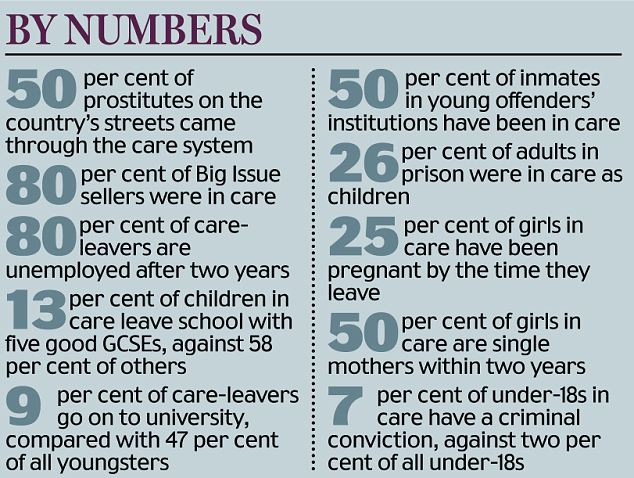
Source: Daily Mail
Christopher Booker comments.
expand
collapse
Children stolen by the state needlessly, causing utter misery in one of Britain's most disturbing scandals
Yesterday the Daily Mail reported that applications to take children into care in England have soared to an all-time record, for the first time topping 10,000 in just 12 months.
Since 2008 alone, the figure has much more than doubled, to some 225 cases a week — bringing the total number of children in care in the UK as a whole to at least 90,000.
The official reason given for this explosion in the number of children being removed from their families by social workers in only four years is that 2008 was the year when the nation was shocked by the events leading to the death of Baby P — later named as Peter Connelly.
He was just 17 months old when he died in North London at the hands of his mother Tracey and her violent partner, suffering more than 50 injuries.
 Scandal: How many children are needlessly being taken from loving homes to the detriment of both them and their parents?
Scandal: How many children are needlessly being taken from loving homes to the detriment of both them and their parents?The story goes that social workers have become much more eager to take children into care because they do not wish to see any repetition of the scandal surrounding their failure to save Baby Peter, even though they and other officials had visited his home 60 times.
But one hugely important ingredient is missing from the way this version of events is being put across by the authorities responsible for ‘child protection’.
Evidence is accumulating on all sides to show that far too many children are now being removed from their parents wholly unnecessarily, often for laughably inadequate, even absurd, reasons.
No one could object if the rise in the number of families being torn apart was simply due to the increased determination of our social workers to intervene in situations likely to lead to another Baby P tragedy.
But the fact is, happy children are today being snatched from loving parents for reasons they cannot begin to fathom, leaving all concerned in a state of utter misery. And this can constitute a tragedy in its own way scarcely less heart-rending than those where a child has been genuinely abused.
Having investigated scores of such cases over the past three years, I do not hesitate to describe this as one of the most disturbing scandals in Britain today.
The manner in which, every week, dozens of families are wantonly ripped apart has become truly horrifying. And the only reason this does not itself make headline news is that our so-called ‘child protection’ system has become so ruthlessly hidden from view by the wall of secrecy built round it by our family courts.
What is most shocking about our child-care system is the extent to which, behind that wall of secrecy, every part of it has gone off the rails,
The social workers have become far too prone to target not genuine problem families like those of Baby P or Victoria Climbie — the eight-year-old girl from the Ivory Coast who in 2000 was tortured and murdered by her guardians in London — but normal, respectable homes where children are being happily brought up by responsible parents.
The reasons given by the care industry for seizing these children these tell their own story.
Since 2008 the proportion of children removed because they are being physically or sexually abused has actually gone down.
 Happy: Social workers take children from respectable homes where children are being happily brought up by responsible parents
Happy: Social workers take children from respectable homes where children are being happily brought up by responsible parentsInstead, the social workers cite vague reasons based on opinion rather than testable evidence — they use terms such as ‘emotional abuse’ the use of which has soared by 70 per cent.
In many cases the social workers don’t even need to produce evidence, only their personal view that a child might be ‘at risk of emotional harm’.
Once the social workers have made their decision, children and parents find themselves caught up in a shadowy system which seems rigged against them.
The social workers hire ‘experts’, such as psychologists, who earn thousands of pounds writing reports which appear to confirm the case planned for the courts. The reports can contain woolly allegations, such as that a mother might suffer from a ‘borderline personality disorder’. (Which of us could not have that charge levelled against them?)
Far too often the parents aren’t allowed to challenge the reports in court — even though the ‘experts’, rather than practising in clinics and seeing patients, may earn all their living from writing such reports, and endorsing what the social workers want them to say.
Judges are then presented with allegations made against the parents based on no more than the wildest hearsay. Such allegations elsewhere in our legal system would instantly be ruled inadmissible. But because of the secrecy of the family courts system, the parents are not permitted to even question these claims and the media is denied the opportunity to present them for scrutiny.
Meanwhile, countless children find themselves living with strangers in foster homes, where all the evidence shows — despite many shining exceptions — they may risk physical abuse or emotional harm far worse than anything their parents were accused of inflicting on them.
The only contact the accused parents and their unhappy children are allowed with each other is in brief, rigorously supervised ‘contact sessions’, staged in grim council ‘contact centres’. Even these are likely to be brusquely terminated if any sign of affection is shown, or if a bewildered child dares to ask its parents for an explanation of why all this is happening.
I would not believe all this and much more could happen in England if I had not heard remarkably similar stories again and again from dozens of parents and children — even though the parents are routinely threatened with prison if they discuss their case with anyone from outside the system.
Just how ruthless and Kafkaesque this system has become behind this impenetrable wall of secrecy is almost impossible to convey to anyone unfamiliar with it.
It makes a complete mockery of a system that has been set up in the name of ‘protecting children’, to ensure their lives are somehow better and happier than they were before.
Nothing in yesterday’s Mail report was more shocking than the statistics showing what happens to children who have emerged from Britain’s care system.
Fifty per cent of all this country’s prostitutes are girls who have been in care, and 80 per cent of all Big Issue sellers.
Half of all those in young offenders’ institutions have been in care, and 26 per cent of adults in prison have the same background.
Meanwhile, half of all girls who leave care become single mothers within two years, not least because they want someone to love.
These devastating statistics go on and on — hard evidence of just how horribly our ‘care system’ is failing those who fall into its clutches. Many of the children, of course, have already had an appalling start in life, being born to drug-addicted, alcoholic, genuinely abusive or otherwise incapable parents.
It is hard to argue that social workers and the courts were wrong to remove these tragic youngsters.
But this makes it all the more incomprehensible that among such children in care today are ever more thousands who should never have been taken from homes where they were properly cared for.
This is the real price we are paying for that impersonal statistic we saw blazoned across the front page of yesterday’s Mail: that the number of children being seized from their parents has now soared for the first time to 10,000 a year,
Having heard too many of their accounts in chillingly repetitive detail, I must say that this scandal is the most shocking story I have reported in all my many decades as a journalist.
It is high time it was pulled from behind that wall of secrecy and reported across the world.
Source: Daily Mail
Boy Apprehended
April 11, 2012 permalink
Apprehensions are hardly ever reported in the press, but here is one from Orillia. There are not enough facts in the article to be worthy of comment,
expand
collapse
POLICE APPREHEND FOUR YEAR OLD FROM RESIDENCE
A disturbing find for two OPP officers when they entered a home on Neywash Street in Orillia.
Police say they found a four year old child in the care of two men, both of them were drunk.
Nearby the child was marijuana and drug paraphernalia.
The youngster is in the care of relatives while Children's Aid investigates, and the males in their early 20's face drug charges.
Source: B101FM
Legislators Attacked
April 11, 2012 permalink
The New Hampshire legislature formed a House Redress of Grievances committee, which let the public file petitions alleging improper conduct by state officials. There were 27 petitions in the first year, many about child custody and guardian decisions relating to DCYF matters. The committee questioned DCYF about them. Now the attorney general of New Hampshire has lashed out at the legislators, while state prosecutors are advising DCYF officials not to answer the legislators' questions.
This is an example of the real relationship between legislators, who appropriate funds, and bureaucrats, who spend appropriations. According to the civics books, the elected legislators are in control. In real life, the bureaucrats spending public funds have more power and influence than the legislators, and in cases like the one in New Hampshire, can bully them into submission.
And what were the objectionable questions? Whether slandering parents and family members is allowed, are DCYF workers who lie given immunity and does the agency have the right to sabotage a parent’s drug test results?
expand
collapse
Attorney General accuses House committee of harassing, intimidating DCYF
CONCORD – Attorney General Michael Delaney accused a House committee of having a “chilling effect” on the state’s ability to protect its most vulnerable children by harassing officials with the Division for Children Youth & Families.
In a strongly worded letter to House Speaker William O’Brien, R-Mont Vernon, Delaney said the House Redress of Grievances committee repeatedly asked loaded questions and tried to badger those leading DCYF to defend the agency about sensitive and private cases.
“The Committee’s questions to DCYF demonstrate a bias that would lead any neutral observer to conclude that the Committee is motivated by an agenda that does not include a search for the truth,” Delaney wrote in the six-page letter.
He also weighed in against the recent House move to give committee chairs subpoena power. He insisted this would put child protection workers in a no-win predicament.
“State officials will be placed in the unenviable position of having to decide whether to honor a legislative subpoena or adhere to the laws of confidentiality,” Delaney wrote. “Given the bias of the questioning outlined above, I am concerned that subpoena authority will only aggravate, rather than enhance, the due process concerns I bring to your attention.”
O’Brien fired back in a prepared statement, saying Delaney appears more interested in playing politics than in giving citizens a thoughtful response when they ask the Legislature to look into their complaints about government operations.
He described Delaney’s statements as “baffling and inconsistent with accountable government.”
“We certainly did ask that the Department of Justice provide meaningful feedback to improve the process so that our residents could get an open airing of their concerns, but instead we received an attack on allowing New Hampshire citizens a chance to have their voices heard,” O’Brien said.
“Unfortunately, this is just one more example of an attorney general more interested in playing politics than administering justice,” he said.
Rep. Paul Ingbretson, R-Haverhill, the committee chairman, called Delaney’s letter “bizarre” and insisted the committee has not prejudged those citizen complaints it received.
“These charges are very serious,” Ingbretson said. “If they are true, we need to know about it. If they are not true, we need to know that, too. The attorney general’s characterization of our work is just bizarre to me.”
After becoming speaker in December 2010, O’Brien created the grievance committee, which lets the public file petitions alleging improper conduct by state officials.
In its first year, there were 27 petitions, many of which were about child custody and guardian decisions relating to DCYF matters.
Specifically, Delaney objected to the committee asking DCYF whether slandering parents and family members is allowed, are DCYF workers who lie given immunity and does the agency have the right to sabotage a parent’s drug test results.
“I believe the one-sided hearings by the Redress of Grievance Committee are having a chilling effect on those who perform an essential function of state government – protecting children from abuse and neglect,” Delaney wrote.
State prosecutors have advised DCYF workers not to answer these questions while the office requests their withdrawal, Delaney wrote.
“Clearly, the Committee is not asking these questions to inform public hearings but rather, to harass, or perhaps intimidate DCYF,” Delaney concluded. “The fact that these questions are the basis for expanding the Committee’s authority to issue subpoenas is troubling on many levels.”
Last month, Chairman Ingbretson asked the House Rules Committee, and it agreed to forward a change in procedures, to allow chairman to pursue subpoenas.
On March 21, the House voted, 241-114, to extend subpoena power to committee chairs who need to get a majority of the Rules Committee to endorse and the speaker to sign such requests to make them effective.
Ingbretson said he’ll give DCYF Administrator Margaret Bishop another chance to appear in person before pursuing a subpoena about these matters.
Source: Nashua Telegraph

Breastfeeding Mother Harassed
April 11, 2012 permalink
When Paula Loe's baby daughter did not gain weight quickly, Utah DCFS tried to force her to give up breastfeeding.
expand
collapse
Mom says DCFS showed up at her door because of breastfeeding
LAYTON, Utah (ABC 4 News) - For weeks, doctors told Paula Loe she wasn't doing enough to feed her baby, despite her attempts to breastfeed and give her daughter formula.
After threats from the Utah Division of Child and Family Services, she plans to take her fight to lawmakers.
Now, she's pushing for a new lactation law.
Rebekah Loe is a healthy, active nine month old, but she’s small, barely on the growth chart for her age. Her mother, Paula Loe says she was born about a month early, and has gained weight slowly since. “I showed up for the appointments, and she was slow to gain. She had a very slow start.”
But, Paula never dreamed it would become a problem.
“I had already been here before. I have an older child who is ten, and they grew very similar.”
Paula continued to visit a pediatrician, and even began supplementing her breast milk with a prescription calorie enhancer as recommended. Rebekah continued to gain weight slowly. “Every time I would go back to the doctor he would tell me she is just a little low.”
Eventually she was told she should give up on breast feeding all together, and feed her daughter formula. She tried, but says he daughter couldn’t keep it down so she stopped.
Loe also told the pediatrician she would be looking for a new doctor. Paula says that’s when the Division of Child and Family Services showed up at her door to investigate a case of neglect. “I was incensed. Here I am. I am doing everything I can.”
DCFS told her Rebekah needed to see a recommended pediatrician. She was sent to a nurse practitioner instead. She told her to give up breast feeding because it was causing problems with brain development. “That was about it. I said there is no way you are taking my baby from me. I said I will gladly go to Primary Children’s.”
Loe says Primary Children’s Medical Center reached a very different verdict; not only was it determined Rebekah is healthy, and normal, so is Paula’s milk supply. “They tested my milk and they found actually that I have high milk, which is 27 calories per ounce, which is more than I could have gotten from any formula.”
DCFS says it has a responsibility to investigate potential cases of neglect and abuse, and doctors have an obligation to pass on concerns. Paula has something to pass on to other mothers. “They can stand up to the doctor. They can stand up to DCFS if they come knocking, and say I will gladly quit when you prove to me that my milk supply is inadequate.”
Loe is now working with breastfeeding advocacy groups to craft legislation that would require all pediatricians and family physicians to receive lactation training. She says breastfeeding has been proven to be the best form of nutrition for babies. Loe also says just because a child doesn’t land on a standardized growth chart in the right place, doesn’t mean the baby is neglected.
Source: ABC-4 Salt Lake City
Inside Opinion
April 11, 2012 permalink
Thomas Verburg This is a letter written by an 11 year old Chatham boy who has been victimized and traumatized by the CKCS-CAS.
Source: Facebook, Canada Court Watch, Thomas Verburg
expand
collapse
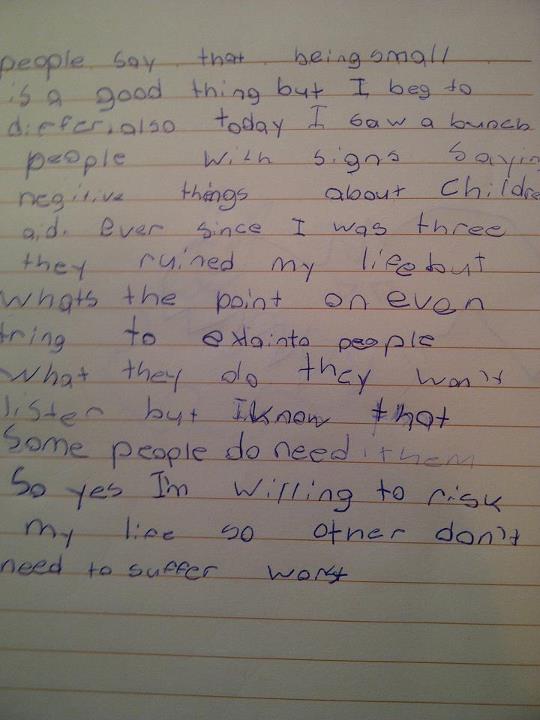
Source: Facebook, Canada Court Watch, Thomas Verburg
More Petitions
April 11, 2012 permalink
Bobbie Gellner, Kim Shook, Chris York and Pat Niagara spent the day working the Welland Courthouse collecting names on the Ombudsnman Oversight Petition on April 10th 2012
Source: Facebook, Canada Court Watch
Video link: YouTube and local copy (mp4).
Foster Care Harms
April 9, 2012 permalink
Social services couldn't find anything wrong with a teen mother so they forced her away from her partner while they looked for faults. The only thing they could find was that she herself grew up in foster care. That was enough to justify taking her baby forever. This is the one situation where social workers admit that their care is harmful.
expand
collapse
You’ve suffered 'care’, so you lose your child
Social workers judge that being brought up in care makes you unfit to be a parent.
 A baby has been taken into care, because her mother was brought up in carePhoto: ALAMY
A baby has been taken into care, because her mother was brought up in carePhoto: ALAMYCritics of the Government’s plans to extend the secrecy of Britain’s court system are still insisting that, where courts operate behind closed doors, this is likely to allow justice to be horribly abused. They are, of course, quite right. But they do not point out that a perfect illustration of their case is what goes on daily in many of our family courts.
Last week, I learned of the case of a sensible but desperately unhappy 17-year-old, who has just lost her child forever. She herself has spent most of her life in local authority care, although she maintains that she was quite rightly taken away when young from her mother, who was a drug addict and an alcoholic.
The girl nevertheless seems to have triumphed over such adversity and, having found a boyfriend, she last year had a baby. The couple would have been only too happy to bring up the child together. The boyfriend is said to be “a brilliant dad”.
But social workers, as is their wont, told her that if she wanted to keep the baby, she must stop seeing him, and sent her for a six month “assessment”.
She apparently passed this test with flying colours and was found to be a “competent mother”. But the social workers were still not satisfied. They tried in vain to establish whether, because of her background, she might have problems with drugs or alcohol. So they then paid thousands of pounds to have her assessed by a psychological “expert”.
He could find nothing wrong with her, but he was prepared to agree with those paying his fees that, because she had been brought up in care, she might have difficulty bringing up a child. Her daughter might therefore be exposed, in that vague term beloved by social workers, to a “risk of emotional harm”.
After a great deal of public expense on three groups of lawyers, a court found, I gather, that, the young mother having been brought up in care, her daughter must now in her turn be put into care. No testimony from the mother was heard.
What does it tell us about our system of “care” when, as it seems, social workers and the judiciary are in agreement that the system is not capable of bringing up a person who is fit to look after her own child?
Source: Telegraph (UK)
Edmonton Rally
April 9, 2012 permalink
Jamie Sullivan and Marilyn Koren, mother and grandmother of the late Delonna Victoria Sullivan, are marching in Edmonton to draw attention to the failings of Alberta child protection.
expand
collapse
Foster death rally planned
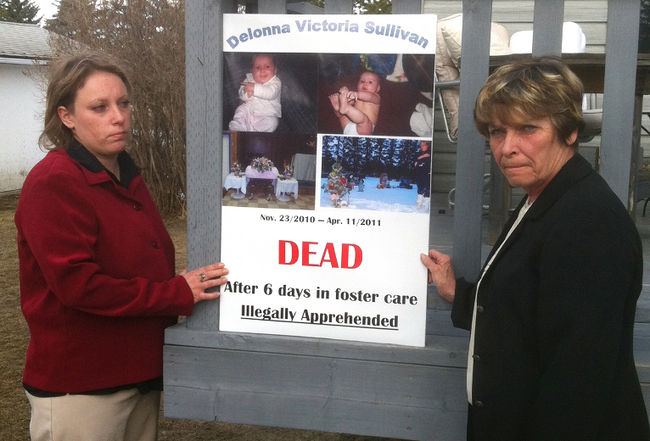 Care Horror (left to right) Jamie Sullivan and Marilyn Koren pose for a photo, Saturday April 7, 2012. Jamie is the mother of Delonna Sullivan, an infant who died while in foster care April 2011.Photo Supplied by Family
Care Horror (left to right) Jamie Sullivan and Marilyn Koren pose for a photo, Saturday April 7, 2012. Jamie is the mother of Delonna Sullivan, an infant who died while in foster care April 2011.Photo Supplied by FamilyOne year after her four-month-old baby died in foster care, an Alberta mother is calling on the province to re-examine its Child and Family Services' laws.
On Wednesday, Jamie Sullivan, along with dozens of supporters, will march on the Alberta Legislature in a bid to raise awareness about what she calls a 'lack of accountability' within the province's foster-care system.
"The message is social services needs to be looked at very closely," said Sullivan's mother, Marilyn Koren, who's been making signs and printing posters for the event.
"We need our government to wake up and pay attention to our children who are under their protection in foster care."
Sullivan's infant daughter Delonna died April 11, just six days after she was taken from her home by two social workers and an RCMP officer.
The trio of officials were executing an apprehension order for children of an unrelated person staying at the house and seized Delonna as well, eventually placing her in an Edmonton foster home.
"I was begging them to just let me take her home with me," said Koren. "They took her without an apprehension order, and 100% if she was left at home, she'd still be alive today."
Sullivan has been telling her story every since, and last year she successfully won a court order to lift a publication ban on her daughter's identity.
Edmonton Justice M.D. Gates ruled that the baby girl's name was "a matter of public interest".
"The community and citizens of Edmonton and Alberta have substantial interest in the welfare of all children in this province," he said in a statement at the time.
According to Koren, Delonna was seized because social workers at the home believed Sullivan may have had an alcohol problem -- a problem her mother says does not exist.
"They just started accusing Jamie, there was no proof," she said. "Delonna was happy and beautiful and healthy and they just took her away."
Koren says she, and her daughter still don't know what led to her child's mysterious death.
"The autopsy was 'inconclusive' and they called it an 'unexplained death'," said Koren through tears Saturday. "We could never know, but that doesn't mean we shouldn't try to stop it from repeating."
The two women have organized Wednesday's rally in Delonna's memory and Koren is hoping the peaceful march, slated for 11 a.m. will urge officials to start making changes to certain policies."We're encouraging everyone to come out and support our children in the foster system," urged Koren. "And especially anyone who has faced issues with the system or been through a similar situation."
Friends of Delonna Sullivan -- a Facebook tribute page in honour of the infant -- has already amassed 350 'likes' and drawn supporters from all over Canada.
"We're expecting a good turnout," said Koren, adding several members of the group Protecting Canadian Children are traveling to Edmonton from as far as New Brunswick to attend the rally. "We want to make it clear social services should work for the families, not against them."
Officials with Alberta's minister of Children and Youth Services, could not be reached for comment over the weekend.
Source: Edmonton Sun
A news report of the actual rally. One of the photos with the article showed Delonna's father, not previously mentioned in the press.
expand
collapse
Go public when children die in care, say protesters
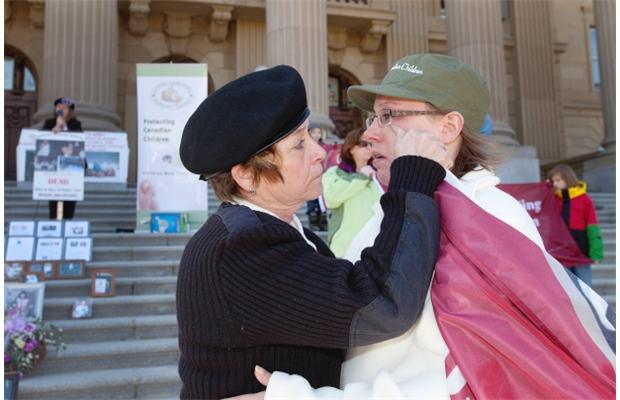 Jamie Sullivan is comforted by her mother Marilyn Koren, left, in front of the legislature on April 11, 2012, during a demonstration recognizing the one year anniversary of Jamie’s daughter Delonna Sulivan who died while in child protective custody.Photograph by: Greg Southam , edmontonjournal.com
Jamie Sullivan is comforted by her mother Marilyn Koren, left, in front of the legislature on April 11, 2012, during a demonstration recognizing the one year anniversary of Jamie’s daughter Delonna Sulivan who died while in child protective custody.Photograph by: Greg Southam , edmontonjournal.comEDMONTON - A group of parents protesting secrecy and lack of oversight at Child and Family Services launched a chapter of the Children’s Army in Alberta Wednesday.
“We believe in accountability and we believe in truth. We want the deaths of children to end,” said Velvet Martin, whose daughter Samantha died at age 13 after spending most of her life in foster care. A report from a fatality inquiry into the teen’s death is expected any day.
The local chapter of the small national organization wants the provincial government to publicly state how many children die in care each year, and to lift the ban preventing parents from publicly naming children after they’ve died in care.
The provincial government also needs to do better investigations before children are taken from their parents, and respond faster if anyone has concerns about the child’s health or safety while they are in foster homes, said Jamie Sullivan, whose four-month-old daughter Delonna died in care one year ago Wednesday.
Both Martin and Sullivan fought in court for the right to publicly name and share pictures of their children. They believe they are the only two parents of foster children in Alberta with the right to do so.
Sullivan said her daughter was happy and healthy before two social workers and an RCMP officer came with court orders to apprehend her roommate’s children last April.
Sullivan says they had no legal right to apprehend her daughter.
Martin said her daughter seemed sick and had diarrhea when she held her on a supervised visit three days later. She said she asked the social worker to take the child to the hospital, but that wasn’t done until the next Monday, three days later. She said the child died about two hours after reaching the hospital.
“I knew my daughter was sick but they took away all my rights to protect my child,” said Sullivan, adding that she is working with a lawyer to file a lawsuit.
“I’ve never felt so helpless in my life,” said Sullivan’s mother, Marilyn Koren. “We want all parties charged. Our government needs to get up and address these issues. I’d like to see one of these parties put it on their platform.”
Roxanne Dube Coelho, spokeswoman for Alberta Human Services, said department officials would not comment on individual cases.
She said it is legal for social workers to apprehend a child without a court order if they believe the child is in immediate danger. Such a case must go to a judge within 10 days.
Dube Coelho said the provincial government will, for the first time, publish the number of children who died in care in their annual report this summer. Until now, they have only been publishing the number of children who die from injuries, not illness.
The provincial government also established the external Council for Quality Assurance last year, which got investigative powers April 1. Their reports on serious incidents will also be public, said Dube Coelho.
Source: Edmonton Journal
The groups organizing the Edmonton rally addressed some suggestions to the provincial government:
expand
collapse
The Honourable Alison Redford
Premier of Alberta
307 Legislative Building
10800 - 97 Ave.
Edmonton, Alberta T2K 2B7Dear Premier Redford:
Our organizations are writing to you with recommendations that we believe will save Child and Family Services Ministry a large amount of money and make the system more efficient and family oriented. We believe the family unit is the backbone of our province and must be kept intact. Enactment of the recommendations, listed below, are in the best interest of keeping children and their families together.
RECOMMENDATIONS:
- Change the way child services are funded. Direct funding away from apprehension and foster care, and direct funding towards helping families and utilizing the extended family.
ADVANTAGE: Extended family could care for children for nothing or much less money than foster parents. A possibility of 60% savings
- Openness and accountability. Stop publication bans. All cases of death and abuse to be made public. Automatic Police investigations of all deaths and abuse of children in care. Charges laid against the worker of the offending foster parent if negligence showed.
ADVANTAGE: Improved trust of the system by the general public.
- Criminal activity or behavior of workers and foster parents to be made public and appropriate charges laid. Inform the public when criminal or civil actions are or have been taken against any employee of Child Services. This includes foster parents.
ADVANTAGE: Public trust that the system is not corrupt and self-serving.
- Workers to follow the Act and not make their own interpretations of same based on their standards or beliefs.
ADVANTAGE: Public trust that the act is geared towards keeping the family together.
- All interviews with children to be videotaped.
ADVANTAGE: Stops accusation that the worker is committing perjury by lying about what the child has said. It will ensure exactly what the child and worker said. It ensures that accurate testimony is given while making the system transparent and accountable.
- Child Advocate being independent of Child Services.
ADVANTAGE: Assures the public that the Child Advocate is not a bias department of Child and Family Services. A transparent honest system.
- Children 9 and older must testify in a child friendly court.
ADVANTAGE: Assures the child’s voice is heard by the courts, and stops accusations workers are “twisting” what children say. This ensures accurate testimony.
- All children 9 and older to be given a written copy of their rights and their lawyers must explain these rights to the children.
ADVANTAGE: Assures the public that children are not being denied their rights, and the system puts the children first.
- Child Services to be overseen by a voluntary independent council of ordinary citizens. All complaints against Child Services investigated by this council and their decisions enacted as law.
ADVANTAGE: Takes the burden of the system to police itself and stops accusations of unfair or prejudice practices. Assures the public that complaints are heard and acted upon fairly. Saves money as the council will be made up of volunteers.
- Remove Preponderance of Evidence as the method judges use to decide cases and Enact Burden of Proof i.e. Beyond a Reasonable Doubt into Family Law. The onus of proof is on the director and their legal counsel. Families should not be destroyed on the pretense that allegation might have or possibly happened.
ADVANTAGE: Assures the public that Family Court is a fair and just court and ends the stigma of it being called a Kangaroo Court. This would cut the court cost of long drawn out trials that are based on false allegations.
- TGO's to be for 30 days and then the director has to go back to court and prove (Burden of Proof) the child(ren) needs to be in care. PGO's to be only 2 years long and then another hearing held to determine need of PGO. The onus of proof, Beyond a Reasonable Doubt, again is on the director and their legal counsel.
ADVANTAGE: Assures the best interest of the child and the family is met. This assures the public that the child and the family are the priority and will reduce the cost of Foster Care, Family Court costs and Appeal Court costs.
- No secret witnesses. All witnesses to appear in court and testify. This includes all complainants, including anyone who made past allegations that are used against you in court. The onus of proof, Beyond a Reasonable Doubt, is again on the director.
ADANTAGE: Would save money spent on the court system for frivolous allegations. It would stop those who would lie and use the system as a way to cause problems for someone they do not care for or to get revenge for a real or perceived problem.
- An Independent Physiatrist to determine mental health of child(ren), and Parental Alienation Disorder, by spouse or others family members, to be recognized.
ADVANTAGE: Substantial savings in the cost of mental health care for children in the system and for these children when they become adults and leave the system.
- When a criminal trial has or is taking place at the same time as a PGO trial, all evidence in the criminal trial must be accepted and considered as evidence in the Family Court Trial.
ADVANTAGE: Assures evidence is not contradictory from one court to the other.
Thank you for your time and consideration of these recommendation and their advantages.
Source: Facebook, Canadian Child and Family First
The letter was signed on behalf of two organizing groups by Barb Wiebe and Terence Webb
One Side Only
April 8, 2012 permalink
The Ottawa Citizen prints an article that sounds like one of those distorted affidavits filed in court by children's aid. The reporter includes no comments from the family itself, only those from children's aid and a court ruling. And since the family is not named, it is impossible for anyone to check.
expand
collapse
Children’s Aid seizes “wild, destructive and uncontrollable” Ottawa children
OTTAWA — They ate pizza off the floor, had dried mucous on their faces, smelled, had lice for six months and they lived in a home that had garbage and broken belongings hoarded in piles, holes in every wall and feces smeared in a child’s bedroom.
One four-year-old boy didn’t know how to speak and only grunted. The children tortured another family’s dog. They bit and spat at people. One boy, only 5, had already been suspended from school twice. His temper was short and he didn’t know how to play with other children.
One child’s socks had been on so long they had to be peeled off the soles of his feet.
It was this home life of “chronic anxiety created by woefully unprepared parents” that contributed to their special needs, a child-protection worker said.
The children, who ate every meal as if it were their last, were described as “wild, destructive and uncontrollable.” These three Ottawa children, aged 4 to 7, have now been seized from their biological parents and put up for adoption by the state.
The Children’s Aid Society took the parents to court and won state wardship of all three children earlier this year. A fourth child — a three-year-old girl — was made a permanent ward of the state last year after state supervision since birth.
In 2009, child-protection workers sent an alert about her birth to all Ottawa hospitals after a report that her mother had punched herself in the belly while ranting about being pregnant a fourth time. The girl was put up for adoption.
In a poignant ruling by Superior Court Justice Catherine Aitken, the remaining three children, two boys and a girl, were also made state wards and put up for adoption.
“Having considered all the evidence, I conclude that the best interests of the children can only be served by an order of wardship. The [Children’s Aid] Society and numerous community services have done everything in their power to assist first [the mother] and [the father], and more recently [the father] on his own, to maintain the family unit.
“Those services have failed to bring [the father’s] parenting and household management capabilities to the point where he can adequately meet the children’s needs. One cannot help but feel very badly for both [the mother and father] for having tried as hard as they have. Society let them down when they were children. Now the court is permanently removing the children from their care. I hope that both [mother and father] will come to understand that this step is necessary to ensure that we do not let their children down the way they were let down as children.”
The Children’s Aid Society seized the children shortly after a late January court ruling.
The first thing they did was take them to McDonald’s. After the fast-food meal, the children were taken to a foster home in Ottawa.
When the two boys and their sister took off their shoes, the smell was ‘overpowering’, according to court records.
Then they ran wild, tearing all the curtains and ripping blinds off the walls. They smashed all in their path and tortured the foster family’s dog.
The children have since shown signs of improvement socially after being exposed to good foster parents.
The Children’s Aid Society has identified three Ottawa families approved and willing to adopt the three children together.
Because the child-welfare agency does not publicly comment on its cases, it is not known if the children have been adopted, let alone together.
Judge Aitken noted in her ruling that if the children are adopted by different parents and separated, they have legal access to one another.
The court records also show that the parents were also neglected as children. Their father suffered horrific abuse at the hands of foster parents from an infant until he was 10 years old. When he met his wife, then 19 and living on the streets of Ottawa, he was a petty criminal and drug addict.
She got pregnant with the first of what would be four children while homeless.
The family of six went on to living in a public-housing project only to get evicted.
They were put into emergency shelter at a Rideau Street motel room, then into a family shelter and finally to that dirty apartment from which the children were seized.
Their parents, especially the father, tried and tried to present a good, clean home to child-protection workers but always came up short. The place was still a mess, he still had anger problems that had him punching holes in the walls, and when he once couldn’t find his kids he never bothered to notify authorities.
In one inspection of their intended family apartment, child-protection workers noted another couple present, two guard dogs, and a crack addict living in the basement who had frequent male visitors.
The father then left his wife and was granted supervised visits, then ultimately overnights at his new apartment. But in time, he again failed his children with his anger, lack of attention and inability to keep a clean home.
According to a standard publication ban, it is against the law to identify the children or their parents.
Source: Ottawa Citizen

Spoilsport
April 5, 2012 permalink
Even when they are not taking children, social services have a way of making everybody miserable. A British mother reports on her experience helping her son's school stage a play.
expand
collapse
How the child-abuse gestapo turned my son’s play into a drama
Towards the end of last year my nine-year old son, Monty, landed the lead role in Oliver! at our local amateur dramatic society and the news had me bursting with maternal pride.
Even though I suspected that his floppy blond hair and deceptively innocent face had probably nailed the part, rather than any discerning acting ability,
I was still thrilled he was chosen ahead of dozens of other boys. I was expecting weeks of gruelling rehearsals, late nights and costume-making — everything that goes with the slightly eccentric world of a village amateur dramatic group. And I wasn’t disappointed.
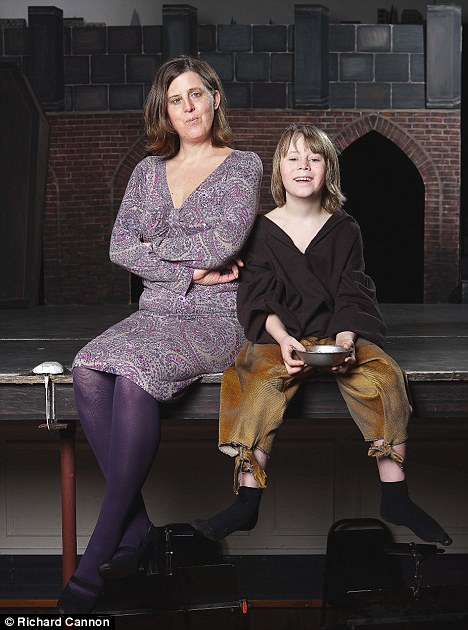 Supporting role: Shona with Monty, who is playing Oliver in a local am dram play
Supporting role: Shona with Monty, who is playing Oliver in a local am dram playWhat I couldn’t predict was the petty, politically correct and ridiculous tangle of town hall bureaucracy that comes with staging a production featuring children.
All the mothers of kids in the show were asked if they would volunteer to help backstage during the week of performances. As the production had taken over all our lives, I didn’t hesitate to agree. I felt — after months of commitment — I wanted to be there for Monty.
Anyhow, how difficult could helping backstage be? I imagined we’d have to keep an eye on the boys in their dressing room, escort them to the loo, and stop them eating too many Haribos. Easy-peasy. I expected to be subjected to a CRB (criminal record) check and was happy to consent. As a mother of four, I think it’s right that anyone working with children should have their background looked into.
But what followed was a catalogue of lengthy form-filling and hoop-jumping at the hands of my over-zealous county council. I’d been warned I would have to obtain a ‘chaperone licence’. No matter that I was doing this voluntarily, and for only three out of six performances. Legislation dictates that any children in a public performance — professional or not — must be safeguarded by approved ‘matrons’, one for every 12 children.
First, came the form filling. What experience had I to supervise a group of boys for two hours? Er, motherhood. Could I provide two references for my suitability as a chaperone? And the clincher. Could I confirm my availability to attend two two-and-a-half-hour evening training sessions? All this I agreed to, even though it was starting to feel a little like Mr Bumble’s workhouse. Except ‘more’ was the last thing I wanted.
I turned up at the first lecture expecting advice on fire drills and dressing room etiquette. Instead, I was handed an enormous pile of paperwork with a brochure entitled: ‘Children in entertainment — recognising child abuse.’
This session was conducted by an earnest woman from the local authority child employment unit. She told us ‘amateur dramatic groups are a magnet for paedophiles’, and that the abuse of children is ‘not rare’.
She then told us almost one in seven children experiences sexual abuse in childhood. Statistically, this meant of the 20 or so children appearing in our production of Oliver!, three of them would have been abused. Now, I don’t want to belittle an extremely serious issue, but this scaremongering felt over-the-top for an amateur production when the only chaperones were mothers of the boys.
Next was role-playing. ‘What would you do if you saw a six-year-old in the dressing room attempting to hide a cigarette burn on his arm?’ Or: ‘What would you do if you saw a male adult member of the cast stroking the hair of a 14-year-old girl he wasn’t related to?’
By the time I got home, well after 10pm, I felt emotionally drained and more than a little paranoid about what lay ahead. The excitement of the show had been sapped out of me. Forget Fagin on stage and his hold over a troop of boy pickpockets. According to Surrey County Council this was nothing compared with what I might see in the dressing rooms.
And I felt we were being asked to spy for social services. We were told: ‘You are the eyes and the ears of the local authority.’ Everyone was given the mobile telephone numbers of staff in child protection which could be used any time of day or night ‘if we had any concerns’.
We were also told we were not allowed to discuss doubts or observations with other chaperones on duty at the same time. Not all local authorities follow this procedure. Some hand out matroning licences following a simple CRB and reference check, but every county council operates a different system. My home is on the border of Hampshire, Surrey and West Sussex, and if I’d lived three miles away I could have obtained the same licence with a visit to a different council’s offices.
Our next session, the following week, was a slide show of scenarios to help us unravel the seemingly endless list of rules and regulations. Did you know a 17-year-old girl is not allowed to share a dressing room with her 15-year-old sister because one is an ‘adult’ and one a ‘child’ — despite the fact they may share a bedroom at home?
And a four-year-old boy is not allowed in the same dressing room as a five-year-old girl simply because they are different genders.
Surrey County Council insists this training is their ‘statutory duty’. ‘We owe it to all our children,’ I was told. But all I wanted to do was help out backstage — not embark on a career in social services.
Three weeks after my course finished, opening night saw me with no licence. For some reason it hadn’t been issued, which meant I still wasn’t allowed backstage. Instead, I was in the audience. And where Mr Bumble says: ‘The law’s an ass — an idiot’, you could hear me applauding wildly.
Towards the end of the run I received my matroning licence in the post. This allowed me backstage.
I had nine boys to chaperone — all of them far too glued to their hand-held computer games between scenes to cause any problems.
But then a woman from Surrey County Council turned up for a ‘spot check’. She went from dressing room to dressing room, until she stopped at mine. ‘Is that squash?’ she said pointing to a jug I’d got for the boys. ‘Er, yes,’ I replied. ‘You have to taste it yourself before giving it to them,’ she said, officiously. ‘Health and safety.’
For the record, the boys in my care are happy and well. They weren’t abused, hurt or, indeed, poisoned by rogue jugs of squash. But if anyone asks me to help with a show again, I know where I will be — at home, glass in hand watching the TV.
Source: Daily Mail
How do you Spell Abuse?
April 4, 2012 permalink
S-o-c-i-a-l W-o-r-k-e-r. When five-year-old Cleo spelled a word wrong, social worker Victor Lindsay put a 5cm rupture in her bladder by jumping on her with his full weight. Earlier he had put the girl in the same hospital by breaking her jaw. When Lindsay's three stepchildren complained to police and social services, they were dismissed as troublemakers.
expand
collapse
Social worker, 45, jailed for nine years after subjecting his own stepchildren to a DECADE of abuse
- Victor Lindsay, 45, beat and tortured three children aged five and under
- Children were dangled from balcony, jumped on, suffered broken bones, and made to run four miles to school
- Judge says actions were an 'extraordinary contradiction'
A social worker who subjected his stepchildren to almost a decade of 'deliberate and unceasing cruelty' has been jailed for nearly nine years.
Victor Lindsay, 45, brutally beat and tortured his girlfriend's three children Leon, Leona, and Cleo, who were aged five, four and two respectively when the attacks began in 1985.
Horrified Judge William Kennedy said Lindsay's actions represented an 'extraordinary contradiction' considering he had worked for many years as a social worker and a youth worker.
The horrific abuse began with Lindsay dangling the youngsters over a high balcony before degenerating into extreme violence.
Each injury was explained away by mother Heather Seraphim while police and social workers did nothing to help the children, Snaresbrook Crown Court heard.
 Snaresbrook Crown Court heard that Victor Lindsay, 45, brutally beat his stepchildren over a decade
Snaresbrook Crown Court heard that Victor Lindsay, 45, brutally beat his stepchildren over a decadeWhen Cleo was just four years old, Lindsay broke her jaw with a right hook because she failed to stand still with her arms up in a 'stress position' he often imposed as a punishment.
She was left without treatment for days until staff at her nursery school noticed her injuries and took her to hospital.
Five months later in January 1989 the little girl, then aged five, was admitted to the same hospital with suspected appendicitis.
Surgeons found a 5cm rupture to her bladder caused by her stepdad jumping on her with his full weight when she got a spelling question wrong.
All three children remember being made to run four miles from their home in Hackney to their school in Islington with Lindsay following in his car to make sure they did as they were told.
He would swing punches at Leon for no apparent reason and once threw a plastic plate at Leona, leaving a permanent scar on her face.
On one occasion Lindsay refused to let the youngsters use a bridge to cross the River Lea near their house in Pedro Street and insisted that they waded across.
Only when Cleo was in trouble and seemed on the point of drowning did he get in and rescue her.
 The River Lea in Ware: The court heard how Lindsay made one of his daughters wade across the river
The River Lea in Ware: The court heard how Lindsay made one of his daughters wade across the riverAll three children reported the abuse to police and social services but were not believed, with social workers even branding Leon a 'troublemaker' and sending him to live with family in the Dominican Republic.
Aged just 13, the youngster was told he was going on a two-week holiday then refused any help getting back to the UK.
Lindsay was arrested in October 2010 after all three children reported him to the police.
He denied any wrongdoing until the day of his planned trial in March, when he admitted six counts of child cruelty and two of assault causing grievous bodily harm.
Passing sentence, Judge Kennedy condemned the 'disgracefully inept' police and social services staff who let the abuse continue.
Jailing Lindsay for eight years and 11 months, he said: 'Relatively small incidents of cruelty, for example dangling tiny children over a high balcony so that they feared they might fall, began as soon as you joined the household.
'These quickly degenerated into physical violence, where each child was hit with objects such as coat hangers, punched and kicked on what seemed to them to be a daily basis for no reason at all.
'By way of further example, you from time to time dragged Cleo round by her hair and you ground Leon's head with your fist.
'So many acts of cruelty, all against youngsters in your care and who should have been able to look to you for protection against the ordinary dangers of young life, were visited upon them by you on a daily basis.
'Every injury was explained away by you and the children's mother. The Hackney Social Services Department at that time seems to have been entirely ineffectual.
'Cleo was made the subject of a care order, and although she complained of assault by you, was eventually returned to you and her mother.
'Leona ran away from home to escape the violence, but was returned there despite having told police officers of repeated assaults.
'Reports made to police officers were uninvestigated, despite an unceasing tide of injury and complaint.
'Man's inhumanity to man always disappoints, but a man's deliberate and unceasing cruelty to disadvantaged children repels and sickens.
'The fact you have spent many years as a social worker, both in residential establishments and as a youth worker, represents an extraordinary contradiction.'
The court heard Lindsay had been abused as a child and had gone on a domestic violence education programme when convicted of assaulting Ms Seraphim in 1997.
Lindsay, of Homerton High Street, Hackney, admitted six counts of child cruelty and two of assault causing grievous bodily harm.
Source: Daily Mail
Laws Don't Apply to Social Workers
April 3, 2012 permalink
In their enthusiasm to seize a baby from a couple who fled Britain, British social workers cut legal corners to retrieve a baby born in France.
expand
collapse
UK social workers snatch a child from France
A baby born in France has been seized by English authorities in a landmark case.
 English social workers seized a newborn baby from its mother in France Photo: ALAMY
English social workers seized a newborn baby from its mother in France Photo: ALAMYAn English court recently made legal history by using EU law to authorise social workers to travel across the Channel to snatch a baby from its English parents, even though it was born in France. I have often written about pregnant mothers fleeing abroad to avoid their babies being seized as soon as they are born. But social workers have never been authorised before to track down a baby abroad to return it to a country where it has never lived. In this ground-breaking case, however, they may have overstepped the mark.
The couple emigrated to France last year when the woman became pregnant, to live with the man’s mother. They feared that if they stayed in England their child would be seized, on grounds they believed to be highly questionable. The social workers, however, were not to be deterred. After the baby’s birth, two of them arrived in France, bent on taking it back with them.
The French authorities opposed the removal of a child born in France to another country where it had no “habitual residence”. A French court agreed, though, that it should be put in local foster care until the legal issues were resolved. The social workers, insisting that they had legal authority, nevertheless took the baby back to England.
Only last week, I am told, did the distraught parents at last see the document which supposedly authorised this: a court declaration made under Article 39 of EU Regulation 2201/2003 (known in the trade as “Brussels II”). But Articles 39 and 42 of this regulation clearly lay down that such a removal from one EU country to another can only take place when “the parties” have been present in court, and that the order has been properly served on them. In this case, I gather, the parents had no knowledge of the order until after their child was taken to England.
So eager were the English social workers and courts to lay hold of this child that it seems they may have failed to follow the procedures laid down by EU law. This unhappy case could make legal history in ways they did not anticipate.
Source: Telegraph (UK)
Addendum: In a later article Mr Booker identified the parents in this case as Joe Ollis and Marie Black,
Questions for Our Local Children Aid Society
April 2, 2012 permalink
Enclosed is a letter to the editor found on the website of the Belleville Intelligencer.
expand
collapse
Questions for Our Local Children Aid Society
Questions for our local Children Aid Society
I am writing this letter as one of many concerned members of the public that feels that the information that I am about to share with you is deeply troubling and it is also extremely important for every member of the public and most importantly the parents to be warned about.
This is concerning the unlawful and immoral practices used by our local Children’s Aid Society on a regular basis.
As we all know, two of our local Children’s Aid Societies have recently amalgamated and are now running under the name of the Highland Shores Children’s Aid Society and allot of these questions are geared towards the former Hastings Children’s Aid Society but with that being said, these questions are still valid towards not only the new Highland Shores Children’s Aid Society but also to every other Children’s Aid Society in the Province of Ontario as most of the issues that happen in our local area are also happening all across the province.
Unfortunately the common misconception of the Children’s Aid Societies in Ontario is that this corporation is here to protect children and help families in need. Another misconception is that the Society will only take children away from a home if there is a real threat to the child. This is simply untrue! The Children’s Aid Societies in Ontario grossly abuse their godlike powers and in most cases the children they apprehend are from good loving families with no need of protection. They do however in many cases leave children in bad homes and do nothing about them! There are many family & OCL lawyers that say that in over a course of ten years they can count on one hand the amount of times that they have seen CAS remove children from a home with Just Cause.
Here is a list of questions for the Highland Shores Children’s Aid Society that require some serious consideration and attention because families are being ripped apart by the Society every day for no reason other than to help with their corporation’s bottom line and this is immoral and completely unacceptable.
I also have to let you know that the questions in this letter may seem outrageous or you may not believe them at all, however every one of these questions are valid and require answers so that we can all live without fear of having our children kidnapped from our homes for no other reason than the profit of the Children’s Aid Society which is a private corporation and has absolutely no oversight from our government.
For more information on the reality of the Children’s Aid Societies in Ontario, please visit the following websites:
http://www.blakout.ca/
http://www.fixcas.com/
http://www.casontario.blogspot.com/
http://www.afathersnightmare.com/
http://www.canadacourtwatch.com/Here are the Questions:
Why does the Children’s Aid Society allocate the majority of their resources into the apprehension of children from good loving families and once they have done so, the Children’s Aid Society focuses entirely for these loving children to remain in care rather than to consider the best interest of the child?
Does this have something to do with trying to justify the massive amounts of funding that the Children’s Aid Society receives from the government each year? Our government pays an amount per day to the Children’s Aid Society for every day a child is in their custody!
In 2012 Hastings Children’s Aid Society alone was expected to receive 42.6 million of our tax dollars for their services!
Is this also a reason why the Hastings Children’s Aid Society has an open file on over 40% of all families living in the region?
Does this mean that HCAS believes that four in every ten families in the area have bad parents?
Why is it that the Children’s Aid Society does not promote the fact that they are NOT a government agency of any kind and neither is any of the other Children`s Aid Societies across Ontario?
Is this because CAS feels that if people knew that they were a private corporation, maybe the public would look into them more seriously?
Why is it that the Children’s Aid Society feels that once a child is in their care, that it is then no longer a priority to make sure that the child is in a safe and loving environment at the foster home?
How come it is more likely for children in the Children’s Aid Society’s care to become depressed and at risk of committing suicide than children outside of their care?
Is this because the children feel that they need to be with their family and they get depressed because of the Children’s Aid Society’s efforts to stop this from happening?
Or could this be because the majority of foster parents are only taking care of children for the financial incentives and not because they want what is in the best interest of the child?
Do the foster parents even understand their own rights and legal risks of being a foster parent?
Why is it common Children’s Aid Society practice to put children in their care on dangerous drugs, often without parental consent? This is including but not limited to psychotropic drugs and even promoting the highly controversial and proven deadly Gardisil Vaccine!
Why is it common practice for foster parents in Hastings to force children to eat microwavable tv dinners and deny children nutritional meals, even if the children ask for them?
Why is it HCAS policy is to only allow a minimal clothing allowance of $60 per month, per child even though Children’s Aid Societies in Ontario can get up to $300 per day per child in their care?
Is this because it is more important to make sure that the staff and directors of the society can keep their extremely high salaries than putting clothes on the backs of children in their care?
Does the public know that in 2010 alone Hastings Children’s Aid Society felt it necessary to line the pockets of all of their senior staff with at least a $100,000.00 salary, including Mark Kartusch with a salary of $126,652.40 and Len Kennedy with a Salary of $162,736.56?
Shouldn’t the family unit be more important than corporate profits and personal salaries?
Why is it common practice for foster homes in Hastings to lock children up like they are in a prison by locking bedroom doors and boarding up or sometimes even putting bars on the windows?
Would this be because the Children’s Aid Society is afraid to let the children have the opportunity to escape the horrors of the foster homes and try to get back to their loving families?
Or is it because if there is a fire in the home, the children would be unable to escape and the Children’s Aid Society would now be able to collect on the lucrative life insurance policies that they take out on the children as soon as they went into the care of the CAS?
Maybe these life insurance policies are why Children`s Aid Societies all across Ontario allow child abusers and murderers become foster parents?
Did you know that it is statistically safer for a person to join our military and fight for our country in Afghanistan than it is to be a child in the “Care” of the Children’s Aid Societies in Ontario?
Did you know that on average every year in Ontario alone; over 100 innocent children die in the direct care of Children’s Aid Societies?
Why is this allowed to continue?
How come the HCAS and all other Societies use the line, “In the best interest of the child” religiously but in fact the Society violates almost every definition of this sentence according to the Child & Family Services Act on a regular basis when the children are in the Society’s care?
Why is it also common Children’s Aid Society practice to deny the children in their care of the majority of their fundamental rights according to not only the Canadian Carter of Rights & Freedoms but also the international United Nations Convention on the Rights of the Child?
Why is it common Children’s Aid Society practice to purposely severe the children’s communications with all of their friends & family while they are in care, and then use brainwashing techniques on the children including telling children over and over again that their parents & family no longer love them and are not fighting to get them home, while in the background the parents are using all of their resources and efforts in the fight to get their loving children home?
Is this just another tactic that the Children’s Aid Society feels is “in the best interest of the child”?
Or is this so that the Children’s Aid Society can use the recently brainwashed and often drugged children to their advantage in the courtroom?
On another note, why is it that over 90% of all Social workers that HCAS has under employment are not licensed and are committing a crime by unlawfully performing social work as outlined under section 46 of the Social Work & Social Service Work Act of 1998?
Is this because HCAS believes that they are above the law?
Why is it also HCAS policy to allow Co-Op students to unlawfully assist their unregistered workers in home visits and even child apprehensions? Please see the careers section of the HCAS website for more details on this!
Why is it that Children’s Aid Society workers appear to be trained on how to talk to parents in such a way to obtain information to base more “concerns” on for their advantage to be able to keep the children longer?
Why do the Children’s Aid Society workers blatantly lie to parents on a regular basis to give them hope while in the background, they are secretly building a fraudulent case against them so that during the hearing, the Children’s Aid Society is ready to keep the children and the parents get devastated?
Is this the Children’s Aid Society’s way of “Acting in good faith” as the Child and Family Services Act requires?
Why is it that the Children’s Aid Society appears to be able to get away with going against the Family Law Rules in the Ontario Courts of Justice Act by giving parents less than 24 hours notice of a court date and also serving them with papers sometimes even minutes before they enter the courtroom?
Is this not a blatant step by the Children’s Aid Society to make sure that parents are unprepared for hearings so that CAS always has the unfair advantage in the courtroom?
Does the Children’s Aid Society only do these unfair practices in court because they know that they already have the unfair advantage of always having a team of high priced lawyers on standby while most parents cannot even afford their own lawyer and are only able to deal with the duty counsel on the day of the hearing?
Why is it that the Children’s Aid Society worker avoids feverishly to put anything in writing or to respond to anything in writing? Why do they not answer the phone and why do they not return phone calls?
Is this because the Children’s Aid Society is afraid that if they put anything in writing, that they may be able to be held accountable for their unlawful actions later? Do they avoid the phone because; even they feel guilty regarding what they are doing?
Why does the Children’s Aid Society feel the need to drag unwitting Schools, Hospitals and Police into their unlawful actions?
It is illegal under the Criminal Code of Canada & the Canadian Charter of Rights & Freedoms for any school or hospital to keep children from their loving parents for any reason. This includes when the Children’s Aid Society tells them to do so! The schools and hospitals that do this are never told that they have the risk of not only a serious lawsuit but they could also face time in prison for these actions!
Why is it that police services blindly listen to the Children’s Aid Society and then become their own private force to do the unlawful actions for CAS?
Why does HCAS and other Societies across Ontario believe that it is within their right to go against The Child & Family Services Act, The Social Work & Social Service Work Act, The Criminal Code of Canada, The Canadian Charter of Rights & Freedoms, The Education Act and many other laws on a regular basis?
Why does the Children’s Aid Society think that homeschooling is evil and will try to keep children from their loving families and homes for this reason?
Why does the Children’s Aid Society even think that it is in their jurisdiction to talk about home schooling or any educational issues for that matter, considering that under the Education Act it is unlawful for the Children’s Aid Society to be involved in education matters at all? Under the Education Act, the only organizations that are allowed to deal with education matters are either the ministry of education or your local school board, not the Children’s Aid Societies!
Again I will ask the question, does the Children’s Aid Society believes that they are above the law?
Why is there absolutely no government oversight into the actions of Children’s Aid Societies in Ontario?
Why is it that Ontario is the only province in Canada where the Ombudsman is not allowed to investigate social services?
Is this because HCAS and other Societies across Ontario put enormous resources (our tax dollars) into lobbying against all government oversight including the recent bill for Ombudsman oversight of the MUSH sector?
Do the workers of the Children’s Aid Society understand the enormous emotional and physical damage that their work does to loving families every day or are they just blinded by the money that keeps rolling in?
Why is the mainstream media not covering any of this?
Is this because the mainstream media is afraid of going against the enormous amounts of CAS propaganda?
Or is it because the mainstream media is more worried about loosing the massive amounts of advertizing/propaganda dollars that they receive from Children's Aid Societies rather than the well being of innocent children?
These are just some of the questions that need answers and hopefully it will not be long before the public wakes up on this issue and does not let it continue.
I encourage every parent to learn and understand your rights, prepare for Children’s’ Aid Society involvement in advance of a possible confrontation, and to let this letter spread and contact your local politicians to make sure that they know about this because in the end the only way we can stop this madness and for the government to hold these Societies accountable for their horrendous actions.
Source: Belleville Intelligencer
No Apologies When CPS Investigation Kills
April 1, 2012 permalink
Baby Alyssa O'Shell suffered from a genetic defect, spinal muscular atrophy, that caused her bones to break and led to her death at only seven months. But Colorado child protectors had a different idea. They thought father Dave O'Shell was an abuser and seized the baby. They advised mother Tiffany Cuin-O'Shell to get a divorce if she wanted to get her baby back. The pressure of losing his baby, his wife, his job as a policeman and his home to pay for lawyers, and the treatment he could get in prison as an ex-cop, was too much for father Dave O'Shell. He killed his wife and himself. A few days later, CPS investigators changed their opinion, and decided the baby had not been abused. CPS has never apologized to the surviving family members.
expand
collapse
Mistaken allegations of child abuse lead to murder-suicide before baby's rare genetic disorder found
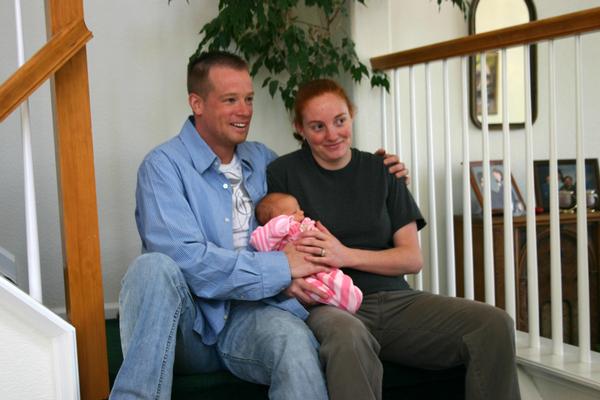 Tiffany and Dave O'Shell met when both worked for the Lakewood Police Department. He was working on a doctoral degree in philosophy in his spare time. Tiffany left the police force during her pregnancy, then returned to work as a halfway-house guard after Alyssa was born.(Photo provided by Paul Cuin)
Tiffany and Dave O'Shell met when both worked for the Lakewood Police Department. He was working on a doctoral degree in philosophy in his spare time. Tiffany left the police force during her pregnancy, then returned to work as a halfway-house guard after Alyssa was born.(Photo provided by Paul Cuin)HENDERSON — Jackie Cuin stood outside her daughter's house, too frightened to walk through the door. All day long, Tiffany had not called or returned a call. That wasn't like Tiffany.
This was an important day. Tiffany and her husband, Dave O'Shell, were supposed to meet with lawyers and a criminal investigator about the alleged abuse of their baby girl, Alyssa. Yet, late in the afternoon, their cars were parked in the garage. And their dog, Pandora, sat unattended on the front porch.
Jackie tried calling her daughter one more time. Still no answer.
"I knew right then that something had happened," she said. "I didn't go in."
 Paul Cuin still struggles to forgive his son-in-law, Dave O'Shell, for the murder-suicide that took his daughter's life as O'Shell faced allegations of child abuse. "He was a wonderful man. I loved him dearly," he said. But "he had choices. He made the wrong one." Jackie Cuin found forgiveness easier. "He was going to lose his wife. His job. His military service. He was never going to get Alyssa back."(AAron Ontiveroz, The Denver Post)
Paul Cuin still struggles to forgive his son-in-law, Dave O'Shell, for the murder-suicide that took his daughter's life as O'Shell faced allegations of child abuse. "He was a wonderful man. I loved him dearly," he said. But "he had choices. He made the wrong one." Jackie Cuin found forgiveness easier. "He was going to lose his wife. His job. His military service. He was never going to get Alyssa back."(AAron Ontiveroz, The Denver Post)Two weeks before, on June 17, 2008, Adams County child protection workers had taken Alyssa and handed her to a foster mother. They did so after a hospital found 11 broken bones in Alyssa's 3-month-old legs, but no bruises or other signs of abuse.
Dave and Tiffany had been allowed to see their daughter just once in those two weeks. Tiffany's lawyer was advising her to divorce her husband if she ever wanted her baby back. Clouds of suspicion swirled around Dave. Police were about to arrest him, he thought, for felony child abuse. He had grown more despondent day by day.
Nobody seemed to hear the family's pleas that there must be some other explanation for all those broken bones.
Jackie drove home, found her husband, Paul, and returned to Tiffany and Dave's house. Paul opened the door and went inside, calling their names. Jackie pulled out her cellphone.
"I had already dialed 911," she said, "when I heard him scream."
Upstairs, Paul saw Dave's legs sticking out the bedroom doorway. Tiffany lay in bed, covered to her neck by a white comforter, a pool of blood surrounding her head.
Sometime the previous night, Dave had gone downstairs and returned with two handguns. He put one to the right side of his sleeping wife's face and shot her twice. Then he stuck both guns in his mouth and pulled the triggers.
That very day, 15 miles away, a doctor at Children's Hospital Colorado in Aurora detected an illness in Alyssa that others at the same hospital had not. Something in her muscles: She was 3 months old and could not lift her head. Her tiny hands turned inward.
Dr. Joyce Oleszek ordered genetic testing.
A week later, the results came back. Alyssa had spinal muscular atrophy, a debilitating genetic disease in a young child, lethal in a newborn.
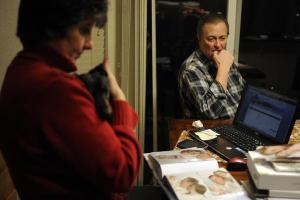 Paul and Jackie Cuin were eventually granted custody of their granddaughter, Alyssa O'Shell, for three months between her parents' murder-suicide and the baby's death from spinal muscular atrophy.(AAron Ontiveroz, The Denver Post)
Paul and Jackie Cuin were eventually granted custody of their granddaughter, Alyssa O'Shell, for three months between her parents' murder-suicide and the baby's death from spinal muscular atrophy.(AAron Ontiveroz, The Denver Post)She would never develop the muscles needed to sit or hold her head up, let alone stand. As her body grew, she would need supplemental oxygen in order to breathe, a feeding tube to eat. Her bones could break easily.
Her mother and father were dead, suspected to the end of repeatedly breaking her legs. Her own life would end in months.
Three and a half years later, Paul and Jackie Cuin shared their account of a family tragedy, hoping to broaden knowledge about a genetic killer of infants and to spare someone else from mistaken accusations of child abuse. They also want Colorado to give accused parents better ways to appeal if a child protection agency balks at performing tests that could disprove abuse. To tell the story, The Denver Post obtained medical, social services and police investigative records produced during the Cuins' lawsuit and used a detailed timeline Paul Cuin compiled after Alyssa died.
On the 50-inch television screen in the living room of their Henderson home, Paul Cuin played a short video, a family album set to the John Denver song "You Fill Up My Senses."
There's Alyssa, a beautiful baby with green eyes, a mop of red hair and a great smile. Alyssa, lying in bed on her father's bare arm. Alyssa, held by her proud parents on the staircase. Alyssa, still smiling with oxygen tubes in her nose, the day of her feeding-tube surgery.
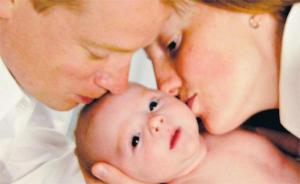 Photos and memories are all that the families have of Tiffany and Dave O'Shell and their daughter, Alyssa, a beautiful baby with green eyes, a mop of red hair and a great smile. At three months, child protection workers took Alyssa and handed her to a foster mother. (Photo provided by Paul Cuin)
Photos and memories are all that the families have of Tiffany and Dave O'Shell and their daughter, Alyssa, a beautiful baby with green eyes, a mop of red hair and a great smile. At three months, child protection workers took Alyssa and handed her to a foster mother. (Photo provided by Paul Cuin)Cuin recalled his final conversation with his daughter.
"The last thing she said to me was, 'Please help me save my husband and my family.' And I said, 'We're doing everything we can.' "
Tears fill his eyes. His voice falters.
"Nobody would listen."
Agencies under fire
When an abused child dies, child protection workers often take the heat. Why didn't they take those bruises more seriously? Couldn't they see the kid was starving? They left the girl with her mom and dad after Grandma's eighth abuse report?
In Colorado, the list of children who died despite calls to child protection agencies keeps growing. Chandler Grafner starved to death in a Denver closet after a worried teacher's aide called a child protection agency to save him. Caleb Pacheco's body was found under a Sterling mobile home after, an aunt said, she called authorities 70 times about the missing boy. Gabriel Trujillo, emaciated and covered with bruises and cigarette burns, died of a head injury weeks after an aunt told Adams County investigators that his grandmother was abusing him.
Gov. John Hickenlooper and his human services director have responded with reforms intended to save the next little Gabriel from agency inattention.
Paul Cuin sees these reforms as a double-edged sword. While all eyes are now focused on cases in which social services agencies failed to save children in danger, there are others "where the departments become overzealous," he said, with tragic results.
He said he thought child protection agencies tried to reunite families whenever possible. But "they didn't in this case. They literally tore the family apart," he said. "And you have no recourse. You have to prove you're innocent to get your child back."
By law, child protection agencies cannot divulge details of their cases. "Children's Hospital Colorado cannot comment on individual child-abuse cases, past or present," spokeswoman Elizabeth Whitehead said.
Darwin Cox, the child and family services director in Adams County, also said he could not discuss details. But he noted that Alyssa was referred from a hospital renowned for its child-abuse expertise.
Hospital records show that its specialists believed Alyssa had been horribly abused and the family was in denial.
"This was a terrible, terrible tragedy," Cox said. But "we did the job we could with the best information we had at the time."
A love for children
Tiffany was a red-haired tomboy. She ran cross-country, played soccer, rode a motorcycle, became a starting point guard on her high school basketball team, coached basketball — a boys team — at an Adams County middle school.
"Guys loved having Tiffany around. She was one of them," her mother said. "I don't think I had a dress on her past age 2."
Tiffany loved kids. She went to the University of Northern Colorado, planning to help children in special-education programs develop physical skills.
To lower her college costs she joined the Army Reserve, where she grew interested in law enforcement and changed career plans. To her mother's shock, she announced one day that she had decided to become a police officer.
She graduated and found a job with the Lakewood Police Department, where she met William David O'Shell — Dave.
Dave was a bright, ambitious police officer who also served in the National Guard and worked on a doctoral degree in philosophy in his spare time.
"They got married, had the baby. Everything was going great for them," Paul Cuin said. "Until all this happened."
Tiffany had left the Lakewood police force during her pregnancy, then returned to work as a halfway-house guard after Alyssa was born. On the morning of June 16, 2008, as she was changing Alyssa's diaper, she noticed her baby cried when she lifted her right leg. But then Alyssa went to sleep in her swing, so it didn't seem that serious.
Tiffany dropped off Alyssa at her mother's house, where her younger brother, Mykal, watched the baby until Jackie came home from work.
Jackie also found Alyssa unusually fussy that day. She cried whenever her right leg was moved. When Dave came home from work, Jackie dropped off Alyssa and told him. Seeing no swelling, he decided just to watch Alyssa closely that evening. He fed her, and she went to sleep.
By morning Alyssa's leg had swollen. Tiffany called her pediatrician immediately. X-rays showed something, possibly a fracture, possibly a cyst. The pediatrician's office sent Tiffany and Alyssa to Children's Hospital for more tests. Dave joined them there.
Children's X-rayed Alyssa's entire body — and found 11 fractures in various stages of healing in her legs. The hospital called the Adams County Human Services Department.
Because Jackie and Mykal had cared for Alyssa while her mother worked, the entire family became child-abuse suspects. Child protection workers took Alyssa, called a foster mother and opened an investigation.
From that day forward, Alyssa's parents and grandparents insisted that there had to be some explanation other than child abuse.
"There was no way. They loved that baby," Paul Cuin said.
He and his wife turned to the Internet, researching possible medical explanations. They suggested brittle bone disease, a genetic illness. The child-abuse team doubted that. Alyssa had corner fractures, a type associated with violently yanking or twisting her limbs.
A hospital report called her injuries "highly suggestive of nonaccidental trauma," adding that nothing in Alyssa's medical history or physical exam pointed to a different cause.
Still, on June 19, two days after Alyssa was taken from her parents, an Adams County judge agreed that other possible causes had to be explored. The judge ordered "emergency medical testing" of Alyssa for genetic illnesses.
There were people who questioned the instant diagnosis of child abuse.
Dr. Callie Black, Alyssa's pediatrician, was one. She told Tiffany and Dave that she wanted a bone specialist to look at Alyssa for "weak bones."
Alisa Thomas, a social worker at the hospital, noted the absence of external injuries and also suggested extensive medical testing of Alyssa.
Adams County child-abuse investigators, meanwhile, interpreted emergency testing to mean sometime in the next few months, according to the Cuins. Jackie said a social worker told her that a genetic test had been scheduled for Oct. 4 — more than three months away.
Tiffany and Dave were allowed to see their daughter once, for one hour, at Adams County social services. They were told the next visit would have to occur before a therapist, Jackie Cuin said, because Alyssa had looked away from them several times.
Jackie was incredulous. "She looked away. A 3-month-old looked away," she said.
Dave O'Shell quickly became the main suspect in a Commerce City police investigation because he had held Alyssa by the legs.
"The only thing that he's done that I tell him not to do is hold her upside down. She is way too little for that," Tiffany told an investigator.
But "I know he would never hurt her intentionally. He loves her to death."
Dave described picking up Alyssa by her legs to kiss her belly — and wondered aloud if that could have hurt her.
"Did I hold her too strongly whenever I was holding her by the legs? That's the only thing I can think of," he said. "I'd give her a kiss and put her back down."
"Did she cry when you put her back down?" the investigator asked.
"No, she liked it. She gave a little smile," he said.
Yet as the investigation focused on him, Dave grew desperate.
June 26: Dave visited Charles Cooper, Tiffany's grandfather. Over a basement game of pool, he talked about going to prison.
"I just cannot stand anyone else with Tiffany," he said.
Dave had heard he was about to be arrested on felony charges — and become a police officer behind bars. He would be fired in Lakewood, discharged from the military, lose his house, his wife, everything.
He would need a criminal defense lawyer and about $50,000 for bail.
Tiffany, who had her own lawyer, confided to a friend that her lawyer recommended filing for divorce if she wanted her baby back. Given a choice, her friend told her, always choose your child.
June 28: Tiffany told her mother that Dave said he was "going to shoot people" so police would have a real reason to arrest him. Tiffany was getting desperate, too. She talked wildly of going to jail herself, living in her grandpa's basement on welfare, Alyssa growing up without a father.
At the same time, she said, "she had to be the strong one" for Dave. He was saying scary things.
June 30: Tiffany and Dave had an 8 a.m. appointment at the hospital on their child-abuse case. Then Dave had an 11 a.m. appointment with his lawyer, who would take him to be questioned by the case detective. Tiffany had a 1 p.m. appointment with her lawyer.
Tiffany had agreed to call her mother throughout the day to let her know what was happening.
She didn't call.
At 3 p.m., Jackie tried calling her daughter. No answer.
Two more hours passed. Jackie decided to drive over to Tiffany and Dave's house, about a mile away. That's when she found the dog on the porch and the cars in the garage.
Inside, Tiffany and Dave had been dead all day.
Foster mother's concerns
Also on June 30, Alyssa's foster mother brought her back to Children's. She told the doctor that she was concerned about the baby's lack of development. Alyssa also had a rapid breathing pattern that sometimes sounded raspy.
Dr. Oleszek noted that Alyssa "makes sounds, smiles and laughs," but "does not grasp objects well. She does not have significant movement of her limbs and has no head control. She also tends to keep her thumbs in her palms."
Normal intelligence, but a failure of muscles to develop — this pointed to a potentially devastating genetic illness.
"Most concerning today," Oleszek wrote, "is the diagnosis of spinal muscular atrophy." She independently ordered the genetic tests that a judge had ordered 11 days earlier.
There had been other clues.
Dr. Black, the pediatrician, worried when Alyssa was 2 months old about her weak muscles, and she talked with Dave and Tiffany about possible physical therapy.
When the hospital first questioned Dave and Tiffany, they told a social worker that they had recently sought physical therapy for Alyssa. She was "smiling and making noises," they explained, but "not rolling and not holding her head up" — and wanting to turn her head to only one side.
At the hospital, another doctor had noted that Alyssa "really has very little head control" and keeps "her thumbs in her hands."
On July 9, test results confirmed the disease.
Spinal muscular atrophy afflicts about one of 10,000 children. But if the symptoms appear after a child's first birthday, the consequences are less severe — poor muscle tone, weak legs and arms, a risk of broken bones and living in a wheelchair.
If the disease appears prenatally or in a newborn baby, it's a death sentence.
On July 11, an Adams County caseworker called Paul and Jackie Cuin's lawyer to inform them of the diagnosis. But since Tiffany O'Shell "was being buried on 7/11/08," the caseworker noted, she and the lawyer agreed "it would be best to wait and inform the relatives over the weekend."
None of this altered the child-abuse team's opinion that Alyssa should remain a foster child.
"This diagnosis does not rule out the physical abuse that Alyssa suffered," the caseworker wrote, because the types of fractures in her legs "are usually obtained when someone yanks or twists the limbs forcefully."
Jackie Cuin said the agency also declined to bring Alyssa to her mother's funeral.
On July 15, Adams County social services recommended keeping Alyssa in foster care and letting her grandparents visit her at some "appropriate place, given Alyssa's issue around the susceptibility of getting a cold/germs."
Back with grandparents
On July 16, Jackie and Paul Cuin went to court for another hearing in the child-abuse case. They offered to take care of Alyssa for the rest of her life. Adams County social services asked the judge to leave Alyssa in its care.
Judge Katherine Delgado asked whether Jackie Cuin had been cleared as a child-abuse suspect.
She had.
Then why was the agency still involved?
The caseworkers "offered no substantial reasons," Paul Cuin said, and "the judge immediately ordered Alyssa turned over to us and granted temporary custody. Thank God for Judge Delgado."
The Cuins kept their jobs, with revised schedules. Jackie worked days at a horse association. Paul, a supermarket manager, switched to a night shift.
They put one crib upstairs and one crib downstairs, so that a baby who would never sit up by herself always had a place to play.
Each morning, her grandfather changed her diaper, dressed her, fed her, then gave her a little physical therapy on the couch. "Run run run run, jump," he said as he exercised her legs.
Then he would put her in her swing, "and I'd catch a quick nap."
Gifts arrived from other families whose children had spinal muscular atrophy. Lightweight things that a baby with weak arm muscles could gaze at and maybe bat — feathers, balloons, chimes, mobiles, bath toys. Alyssa liked baths. She was almost weightless there.
Police officer William David O'Shell's doctoral dissertation, on the philosophy of Friedrich Nietzsche, also came in the mail one day.
In September, the Cuins received an opinion from a specialist that the broken bones in Alyssa's legs were attributable to her illness.
A lawyer and family friend had called a national spinal muscular atrophy association to ask for doctors familiar with the disease. The association provided several, and one in Utah, Dr. Gary Chan, offered to look at Alyssa's X-rays.
"I have spent 3 hours reviewing the xrays and the reports. The fractures are consistent with subjects with SMA," he responded in a Sept. 19 e-mail. "I would guess some of these fractures may occur at time of delivery, but most occurred after birth from normal handling. It does not surprise me that Alyssa had fractures noted at 3 months of age."
As Alyssa grew and her muscles didn't, breathing and eating grew harder. When she could no longer eat enough on her own, the Cuins took her to a hospital to put a feeding tube in her tummy.
They also needed to suction her nose and used an electric pump to pull mucus from her throat. By October, they were suctioning her six times a day.
Through it all, Alyssa never lost her smile. "She was happy," Jackie said. "That was our biggest joy."
Jackie bought Alyssa a Christmas present, a singing, dancing Elmo. Then, fearing Alyssa might not live that long, Jackie gave it to her early.
And "she just loved that thing," Paul said. "She would try to reach for him. Or just watch him and smile."
On an autumn morning, the day after a hospice nurse told Paul and Jackie that she thought Alyssa would make it to Christmas, Alyssa's skin turned blue.
"She died upstairs in my arms," Paul said.
In The Denver Post, a brief obituary appeared: "Alyssa, 7 months old, rejoined her parents on Oct. 28, 2008."
The Cuins say they never heard a word of apology, or regret, or even an acknowledgment of a mistake, from the people who put Alyssa in foster care and investigated their daughter and son-in-law as child abusers.
With one exception: On the day Alyssa died, the Commerce City case detective, Daniel McCoy, arrived at the Cuins' home before Jackie did.
"Detective McCoy was awesome," she said. "He heard the address come across on the radio, and he was one of the first people in the house."
The Cuins sued, seeking some admission that the child protection team had played a role in their family tragedy, but they lost without reaching a jury. The hospital argued successfully that a murder-suicide was not a foreseeable consequence of a child-abuse investigation. Adams County social services also countered that government agencies are immune unless their behavior is willfully and wantonly wrong.
Today, Paul Cuin still struggles to forgive Dave. "He was a wonderful man. I loved him dearly," he said. But "he had choices. He made the wrong one."
Jackie found forgiveness easier. "I get it. I understand. He loved her too much," she said. "He was going to lose his wife. His job. His military service. He was never going to get Alyssa back."
Still, "I'm heartbroken. There's no other words."
They live with their memories now. The family videos Paul found therapeutic to make, the photos of Alyssa and Tiffany and Dave displayed through the house.
And the Elmos.
There are a dozen Elmos now in their middle-class suburban home, all reminders of a beautiful baby girl who couldn't lift her head but never lost her smile.
Mistaken accusations
On the day her mother and father died, a murder-suicide following a child-abuse accusation, a doctor guessed the truth: Alyssa was born with a genetic illness that would kill her before her first birthday.
June 16, 2008
Tiffany O'Shell notices that Alyssa cried when she lifted her right leg.
June 17
Tiffany takes Alyssa to the doctor and then to Children's Hospital, where X-rays show multiple fractures. Adams County child-protection workers place Alyssa in foster care.
June 19
An Adams County judge orders "emergency medical testing" of Alyssa for genetic illnesses.
June 28
Tiffany says her husband, who feared he would be arrested for child abuse, had said he was "going to shoot people" so police would have a real reason to arrest him.
June 30
Tiffany and David O'Shell are found dead; Alyssa's foster mother takes her to a doctor who independently ordered the genetic tests a judge had ordered 11 days earlier.
July 9
Test results confirm a diagnosis of spinal muscular atrophy.
July 16
Over the objections of Adams County social services, a judge returns Alyssa to grandparents Jackie and Paul Cuin.
Oct. 4
The date on which emergency genetic testing, scheduled more than three months earlier, is scheduled to occur.
Oct. 28
Alyssa dies.
Source: Denver Post
Warm Cuddly Baby Available!
March 30, 2012 permalink
The Children's Aid Society of Ottawa prepared a poster advertising an Inuk baby for adoption.
This baby boy is just months old. He loves being cuddled and is a happy little boy. When born, he needed some help to learn to eat well, but is stronger everyday.
He is a beautiful, calm and loving baby
We are seeking a strong Inuit family to adopt.
Here is the poster (pdf).
expand
collapse
Children's Aid Society under fire for Inuk baby adoption poster
The Children's Aid Society in Ottawa is being criticized this week for advertising an Inuk baby available for adoption on posters.
The poster, which was distributed this week, says the society is seeking a "strong Inuit family" to adopt the three-month-old boy. The poster describes the boy as "calm and loving" and says he "loves being cuddled."
Some say it makes the boy sound like a puppy up for adoption, and the poster is also littered with images of traditional Inuit Inukshuks, parkas and qulliqs – Inuit oil lamps.
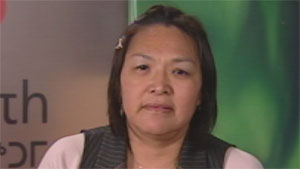 Okalik Eegeesiak, from the Qikiqtani Inuit Association, said the poster's wording is unacceptable.CBC
Okalik Eegeesiak, from the Qikiqtani Inuit Association, said the poster's wording is unacceptable.CBC"The way it was worded, it sounds like a marketing tool. It is a marketing tool, and we found it quite offensive that that kind of wording would be used now, in 2012," said Okalik Eegeesiak from the Qikiqtani Inuit Association.
A spokesperson from the Ottawa Children's Aid Society apologized, saying the advertisement wasn't meant to offend. The society says posters are often used to find adoptive parents for Inuit and non-Inuit children.
The new poster has now been scrapped, but it might have already done the job. The society says a couple of people have come forward hoping to adopt the boy.
Outreach to Inuit Community (PDF)
Source: CBC
Childhood Obesity Targeted
March 29, 2012 permalink
Dalton McGuinty has plans for your children. Tucked away in this week's Ontario budget announcement is the statement:
The Ministry of Health and Long-Term Care is moving forward with a plan to transform the health care system that will help manage expenditure growth at an average of 2.1 per cent a year, over the next three years, by:
- Keeping Ontarians healthy by reducing childhood obesity and combating smoking.
Source: Ontario budget (pdf, page 3) local copy
Thanks to Anne Patterson for finding this item.
Ontario's children's aid societies will be eager to help enforcing this plan by seizing overweight children and placing them on half-rations. They can tag the children special needs to justify enhanced funding for the deficient diets.

Councillor Learns the Truth
March 29, 2012 permalink
The Daily Mail profiles Lucy Allan, a thoroughly respectable British woman and councillor. Twice a month, she sat on the local fostering panel, which oversaw the removal of children from their parents and placed them with new families. At each meeting she was presented with horrifying cases of abusive parents, almost always depicted as “substance abusers”, mentally unstable or “unable to put the needs of their children over their own needs”. Often, this portrayal was supported by an expert report from a psychiatrist, psychologist or medical doctor. Lucy believed the experts.
But a year ago, child protectors turned on Lucy. Soon the bewildering array of abuses were appearing in reports about herself.
Aside. When a parent shows outrage at the abduction of his own child, one of the standard lines from "experts" is: He places his own needs ahead of the needs of his child.
expand
collapse
The 'experts' who break up families: The terrifying story of the prospective MP branded an unfit mother by experts who'd never met her - a nightmare shared by many other families
Lucy's son was nearly taken into care when she was wrongly accused of putting his life in danger
 Ordeal: Lucy's son was nearly taken into care when she was wrongly accused of putting his life in danger
Ordeal: Lucy's son was nearly taken into care when she was wrongly accused of putting his life in dangerA little over a year ago, Lucy Allan led what most people would regard as an eminently respectable life.
The middle-class mother, a Tory councillor, was happily married to her stockbroker husband, Robin, and doted on their ten-year-old son, who loved going to school and was a passionate cricketer.
Indeed, such was Mrs Allan’s standing in the community that this accountant and former investment banker was on David Cameron’s A-list of potential MPs and a prospective Conservative candidate at the last election.
She devoted her spare time to her council duties. Twice a month, she sat on the local fostering panel, which oversaw the removal of children from their parents and placed them with new families.
It was heart-rending work, as she recalls. ‘At each fostering meeting we were presented with horrifying cases of abusive parents, almost always depicted as “substance abusers”, mentally unstable or “unable to put the needs of their children over their own needs”.
‘Often, this portrayal was supported by an expert report from a psychiatrist, psychologist or medical doctor,’ says Lucy.
‘It never occured to me, or any member of the panel, that the information we were presented with might be a distorted, twisted fiction — or that the reports were anything other than independent.’
Now, her view has changed. She suspects that many of the damning reports were written by experts who had never met the families in question, to suit the wishes of social workers under pressure from the Government to increase the number of children adopted.
As a result of this process, more and more children are being taken into state foster care.
So why has her faith in the system she once facilitated been shattered? Because, thanks to a bewildering chain of events, this eloquent, educated woman found herself under attack from social workers and fighting to stop her own son being taken into care.
Hers is a Kafkaesque story involving family experts who passed judgment on her fitness as a mother without, in some cases, even meeting her.
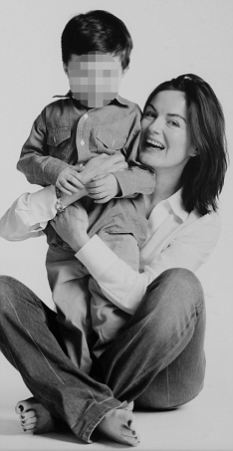 Ordeal: Lucy Allan with her adored son, whose identity we are protecting
Ordeal: Lucy Allan with her adored son, whose identity we are protectingLucy’s story is particularly disturbing in the light of a report released this month which found that decisions about the futures of thousands of children are being based on flawed evidence from well-paid ‘experts’, some of whom are unqualified and, time and again, never meet the families concerned.
The damning study by Professor Jane Ireland, a forensic psychologist, examined more than 127 expert witness reports used in family court cases in three areas of England. She found that 90 per cent were produced by clinicians who no longer practise, but instead earn their living entirely as ‘professional expert witnesses’ paid for by council social work departments. Sixty-five per cent of the reports were poorly or very poorly carried out.
This has led to accusations from MPs, lawyers and families that many of the experts are on a gravy train — ‘hired guns’ paid to write precisely what social workers want to read.
This month the Mail reported how just such an accusation has been levelled against one leading psychiatrist, Dr George Hibbert — who faces allegations that he deliberately misdiagnosed parents as having mental disorders, which led to them having their children taken by social services.
John Hemming, a Lib Dem MP who is calling for a national inquiry into the use of expert testimonies in family court hearings, says this dubious system has resulted in families being torn apart and hundreds of children being wrongly taken for adoption from innocent parents.
It is a scenario Lucy Allan feared could happen with her own son. Her nightmare began last March when, aged 46, and having begun to feel depressed for no apparent reason, she decided to go to see a doctor.
‘I am close to my son, so I was worried that he knew I was feeling sad. I went to my local GP surgery expecting to be given a course of anti-depressants and then feel better,’ she recalls.
She was seen by a young female locum, who listened to what Lucy had to say, and then told her she wanted to refer her to social services to ‘see if the family needed support’.
The locum turned to Dr Peter Green, a consultant forensic physician and head of child safeguarding in Wandsworth, South London, where Lucy lives. A flamboyant figure with flowing grey hair and a penchant for bow ties, he has written thousands of reports for the family courts.
According to documents seen by the Allan family, Dr Green told the locum his view was that Lucy was ‘very self-centred’ — this despite the fact he had never set eyes on Lucy or spoken to her. (When she later complained about the conclusions he had drawn without even having seen her, the doctor is alleged to have told her he had relied on a ‘gut feel’).
 Families torn apart: Liberal Democrat MP John Hemming has called for a nationwide inquiry into the use of expert testimonies in family court hearings
Families torn apart: Liberal Democrat MP John Hemming has called for a nationwide inquiry into the use of expert testimonies in family court hearingsTo Lucy’s horror, following Dr Green’s assessment, the locum informed social services that Lucy’s son was at significant risk of harm from his mother.
Thus it was that a woman whose job it had been to make decisions on the fostering panel about which children should be removed from their families suddenly found herself under the most intense scrutiny.
‘Instead of reading reports on another mother’s “emotionally abused” child or her “chaotic” home life, I was reading the same accusations in reports about me and my family,’ she says.
Social services insisted they interview her son, but as the inquiry unfolded, the evidence from his teachers suggested he was happy and thriving. An independent report from an NHS psychiatrist also said Lucy was ‘no risk to anyone, including her son’.
But social services hired their own psychiatrist from the Priory Hospital in Roehampton, south-west London — at taxpayers’ expense naturally.
Without meeting Lucy or her son, and based only on information provided by social services, the private psychiatrist stated in an ‘expert’ report that there was an ‘urgent need’ for the assessment and treatment of Lucy.
The psychiatrist added that there was ‘no way’ her depression would not have a ‘significant impact on her parenting’.
As the investigation dragged on, Lucy underwent a series of interviews by social services and by experts paid by them to examine her and her family. Many of their subsequent reports, says Lucy, were inaccurate, biased and took her family’s words out of context.
For example, her son had mentioned that when he got off the school bus, he always asked Lucy how she was, but this was described in one report as: ‘Her son demonstrates inappropriate anxiety for the wellbeing of his mother on a daily basis.’
When Lucy admitted taking sleeping pills for insomnia and diazepam for anxiety, another report on her said such ‘drug abuse would make her barely conscious on a daily basis’.
Her confession of sharing a bottle of wine with husband Robin most nights was written up as ‘alcohol abuse’, and the risk of Lucy harming her son was deemed to be ‘substantiated’.
All this begs the question of how often such judgments are passed down by ‘experts’ and social workers on those less well equipped than Lucy to defend themselves.
She has spent the past year trying to clear her name, paid out £10,000 on legal fees and has had to pull herself off the A-list of David Cameron’s potential Tory candidates, quit as a school governor, and, of course, resign from the fostering panel. ‘I am now ineligible for the Criminal Record Bureau check required for working with children or young people,’ she says sadly. Her son’s social services records state that she was once considered a ‘risk’ to him, and it will remain on his file till he is 18.
Finally, at Christmas, the council’s social services said officially no action was required concerning Lucy. She is trying to rebuild her life with the help of husband Robin — who, incredibly, was never interviewed by social services — but still fears she could come under scrutiny again.
 'Alcohol abuse': Social Services' verdict on Lucy's confession that she and her husband shared a bottle most evenings
'Alcohol abuse': Social Services' verdict on Lucy's confession that she and her husband shared a bottle most evenings‘The system is designed to silence people,’ she says. ‘I have been prescribed anti-depressants and I am better. But at the back of my mind is the fear that if I complain too loudly about the child protection system they will be back at my door.’
No doubt she would agree with Nigel Priestley, a lawyer involved in family law, who said recently: ‘Just about the most draconian act the state can carry out is to remove a family’s child. What is at stake is the loss of their children, and on the basis of a report which might, or might not be, questionable.’
Those who write these reports — often psychologists or psychiatrists, but also medical doctors and consultants — do not face the glare of public scrutiny precisely because of the secrecy of the family court system. Lucy can describe her ordeal only because her case never got as far as those closed courts — no parent who appears at one of these hearings, which operate in every town and city in the land, is allowed to speak to anyone later about what has happened there, even to their own MP.
Every year, 200 mothers or fathers are jailed for ‘contempt of court’ for breaking this silence — while the same family courts request the removal of 225 children each week, 97 per cent of whom are never returned to their families.
Now, there are demands for an American-style ‘class’ legal action against the Government by parents who have had dubious or even bogus reports written about them. Paul Grant, a legal adviser at Bernard Chill & Axtell Solicitors in Southampton, says devastated parents have contacted him after his firm took on the case of a mother, known only as Miss A, who claims she was misdiagnosed with bipolar disorder by psychiatrist Dr George Hibbert because social workers wanted her baby adopted.
Now, Hibbert could be struck off by the General Medical Council, which is investigating extraordinary suggestions that he deliberately misdiagnosed ‘caring’ mothers as having ‘personality disorders’ in order to help social workers take away children.
When he was confronted with the allegation about Miss A, Hibbert offered to surrender his licence to practise as a doctor.
This week, his spokesman said he is ‘unable to comment due to his professional duty of confidentiality’. But I have learned that Porsche-driving Dr Hibbert amassed up to half-a-million pounds a year from his work as an expert witness, and from his reports on parents and children for social services departments.
Accounts for his company, Assessment in Care Ltd, show that profits soared from £23,000 in 2001 to a peak of £468,000 in 2007. It is now worth £2.7million, according to Companies’ House records.
Paul Grant says that Miss A’s distressing case ‘may be the tip of a very large iceberg’. He adds: ‘We contend that when a practising clinician becomes a professional expert witness with a private company, there is no registration process, and no machinery to vet what they do.
‘By failing to put in a regulatory framework, we would argue that the state is failing to protect families under Article 8 of the Human Rights Act, which says everyone has the right to a private and family life.’
As Dr Hibbert’s professional conduct comes under scrutiny, it is emerging that he is not the only one whose actions are being questioned.
The Mail has been contacted by scores of parents who believe they have been mistreated on the word of these ‘experts’. We have been told by lawyers about clinicians charging £1,800 a day to appear at family courts, on top of the thousands of pounds a time they receive for writing the reports, which often contain lies, ambiguities and insinuations.
One mother said she had her children taken away because an ‘expert’ said she ‘liked shopping’; another was criticised as mentally unfit for ‘burning the toast’, and lost her child, too.
In another case, an expert was paid handsomely to write a report based on the observations of a social worker who said a five-year-old girl was ‘monosyllabic’.
Yet we are told a secret tape recording of the social worker’s interview showed the child chatting away about school, her family and her home. The little girl has since been removed from her mother.
We have also been told about a gregarious 47-year-old business adviser in the north of England who had to fight to keep her five-year-old daughter after being labelled a ‘totally isolated schizoid’ by a psychologist, who we understand is trained only to treat children, and should never have been involved in the analysis of adult behaviour.
The psychologist in question (who writes up to 100 expert reports a year) charged £6,000 for his written opinion on the mother, her husband and child. Yet the mother says she was given no chance to deny the ‘schizoid’ report — and kept her girl by the skin of her teeth only after the child’s nanny vouched for her parenting skills.
In another extraordinary case, after a woman was found by a psychologist to be a ‘competent mother’, the social workers are said to have insisted on commissioning a second expert’s report. It agreed with the first.
They then commissioned a third, which finally found that the mother had a ‘borderline personality disorder’. All three of her children were taken away for adoption.
So how have such apparent travesties been allowed to go on virtually unchecked in child protection?
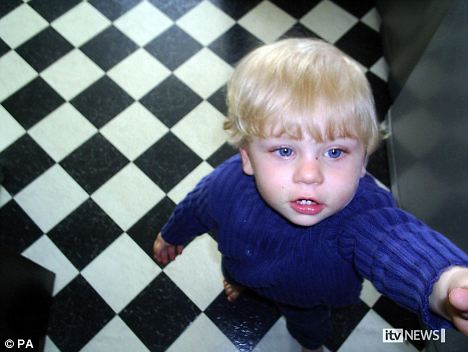 Knee-jerk reaction? Since the harrowing case of baby Peter Connelly more youngsters than ever before in British history are being removed from families every week
Knee-jerk reaction? Since the harrowing case of baby Peter Connelly more youngsters than ever before in British history are being removed from families every weekNo other country in Western Europe removes so many children from their parents. The numbers taken into care — the first step towards adoption — have doubled in a decade to more than 10,000 a year.
The last Labour government set adoption targets and rewarded local councils with hundreds of thousands of pounds if they reached them.
The targets have been scrapped after protests from MPs and lawyers, but the dangerous legacy persists. Social workers now get praise and promotion if they raise adoption numbers. David Cameron is also demanding more adoptions — and that they are fast-tracked.
Since the case of 17-month-old Baby P, more youngsters than ever before in British history are being removed from families every week. Many say this is a knee-jerk reaction, which is probably true. But it’s not the whole story.
It is the 1989 Children Act — which introduced a blanket secrecy in the family courts — that is the real culprit. It encouraged a lack of public scrutiny in the child protection system and what MP John Hemming calls the ‘twaddle and psychobabble’ peddled there, which has caused dreadful miscarriages of justice.
Ian Joseph, who has written a book on forced adoption, told me this week: ‘It’s time the criminal rules of justice applied in the family courts. We need parents to be considered innocent until proven guilty and also be free to talk about what is happening in those courts without being thrown into jail.’
Until that happens, hundreds more children may be seized from their families on the word of experts — many of whom are either not qualified or are receiving huge sums of money to play God.
Source: Daily Mail
Richard Wexler Retires
March 29, 2012 permalink
Richard Wexler is leaving his work and NCCPR to pursue a career in another field. The blog post below is his last as an advocate for child protection reform.
expand
collapse
Thanks for the 4,683 gifts
By all logic, NCCPR never should have been funded at all.
There’s the fact that we had to convince people that, just because we wanted to bring fundamental concepts of civil liberties to child welfare, we’re not a bunch of right-wingers who want to let parents do whatever they want to their kids.
Then there was the problem of convincing potential funders of the importance of changing the way media cover child welfare; or if they understood it was important, convincing them it could be done.
And finally there was the matter of persuading foundations, which tend to be genteel by nature, to fund NCCPR’s blunt-spoken approach to advocacy.
Given all that, it’s no wonder that it took eight years from our founding in 1991 to raise enough funding to hire a full-time executive director.
When I started, in June of 1999, it was with enough money to last eight months. I’ve been on this job for nearly 13 years. But logic, finally, is catching up.
Earlier this year, it became clear that NCCPR would not be able to continue in its present form much longer. So effective at the end of the day tomorrow, (March 30), NCCPR will suspend operations. This Blog and NCCPR’s main website, www.nccpr.org will remain online but, for the foreseeable future, they will not be updated. Starting Monday I will have a new job with an organization that does superb advocacy work in another field.
I leave NCCPR knowing that we have left child welfare a lot better than we found it. In 1999, on any given day there were 565,000 children trapped in foster care. Years of smears against efforts to keep families together and created a climate so hostile that some in the field seriously considered abandoning even the term “family preservation.” Today there are about 408,000 children in foster care – and family preservation is back. The progress has been amazing – and also not nearly enough.
It would be ludicrous to say that NCCPR was solely responsible for that. It would be equally ludicrous to say that NCCPR did not play a role in it far disproportionate to our size. Indeed, to some extent our funding problems are a result of our success.
I want to thank the two foundations that were our principal funders, the Open Society Foundations and the Annie E. Casey Foundation. Each funded us for more than a decade – that’s an eternity in “foundation years.” And during the entire time neither foundation pressured us in any way concerning what to say or, more to the point, what not to say.
Over the past 13 years, I’ve had the privilege of meeting many true heroes. I won’t name them because I’m afraid I’ll leave someone out, and because in a few cases, being praised here won’t help their efforts. They include people who provide direct services and do advocacy, people who work on changing the system from within and without at the same time. They include people who have transformed entire child welfare systems, some by running those systems, some by pressuring those systems.
But I have to take this opportunity to thank NCCPR’s “founding mother” Betty Vorenberg, who first wrote to me in 1990 asking if I wanted to try to start an organization based on the principles in the book I’d just written, Wounded Innocents. And NCCPR’s “founding father” Prof. Martin Guggenheim, who has been NCCPR’s President for most of the past 13 years, and whose guidance and wisdom have been vital to keeping it going. His work at NCCPR is only a tiny fraction of what he has accomplished in the field of child welfare law and policy.
To those who say: “You could have stayed alive if you’d been nicer to those standing up for the status quo” I say: “No kidding.” But from the very beginning we had no intention of doing traditional “goody two shoes child advocacy.” The family preservation movement nearly “niced” itself to death in the 1990s, and we weren’t going to make that mistake again. As a result, I believe NCCPR achieved far more in just under 13 years than traditional groups do in 30.
As I said, when I started we had eight months of funding. There was almost never a time when we were funded for more than a year at a time. That’s why I resolved at the outset to try to treat every day I got to do this work as a gift.
On the internet, there is some website somewhere where you can calculate just about anything. Thank you all for the 4,683 gifts.
Source: Richard Wexler blog
Don't React to Abuse in Foster Care
March 29, 2012 permalink
Robert Franklin writes on the irony that child injuries and deaths inflicted by parents produce calls in the press for more children to be taken to the safety of foster care. But injuries and deaths in foster care produce reports of the abuse without any calls for action. His essay is followed by copies of the two news articles he cites.
expand
collapse
The Silence of the Press When Children Injured in Foster Care
In California, a foster mother allegedly left a four-year-old child with special needs alone and her swimming pool unattended. The boy fell in and almost drowned; he was discovered with neither pulse nor respiration. He remained in a coma for a time but has since recovered although with some brain damage. The foster mother is charged with child endangerment. Read about it here (Merced Sun Star, 3/23/12).
In Arizona, foster mother, Angelica Jimenez was sentenced to 10 years probation for her part in the severe beating of a four-month-old girl in her “care.” Her boyfriend, Steven Saldana, will be sentenced shortly. Jimenez brought the little girl to the emergency room not breathing and with 14 separate fractures. Read about the sentencing here (WAVE 3/22/12).
Those were just two of the cases that came across my screen in a single day late last week. Sadly, there are more very much like them, every day of every week. So, as devastating as they are to the children and all who love them, the two cases are not outstanding. They should be, but they aren’t.
Except in one way. I’ve commented a lot about the tendency of various news organizations to seize on every case in which a child is injured or killed by a parent to call for ever more takings of children from parents by child welfare agencies. What’s remarkable about the two cases I mentioned is that there have been no such calls by any newspaper, magazine, ezine, radio or television network. Indeed, I can’t recall ever seeing such a call when a child was injured by a foster parent. The incident is reported, the grisly details spelled out, the charges revealed. Child injury is horrific and thus, big news.
But what we don’t hear are the impassioned pleas for radical change to the system of child welfare. When a parent injures a child, we’ve heard cries of righteous indignation from the likes of the Arizona Republic and the Boston Globe. Each calls for greater intrusion into family life and parental decision-making. And who could argue when little children are terribly injured or killed?
But those very things happened to the children I mentioned earlier, and not a peep from the MSM. Why not? After all, the writers who follow child welfare agencies surely know the data on foster care; it’s far more dangerous to children than parental care, even when the parents are known to be somewhat abusive or neglectful of their children.
Into the bargain, unlike parent/child relationships, the relationship between foster parents and their children ends when the child becomes 18. Certainly some foster parents continue to care for their foster children after that time, but most of the kids “age out” of the system. That means that at age 18, ready or not, they’re on their own.
But despite all its drawbacks, the news media seem to embrace foster care at the expense of parental care. When a parent harms a child we hear only “CPS should take more children into foster care.” When a foster parent does the same, silence.
It’s true that parents injure more children than anyone else, but that’s just because they provide far more care than anyone else. It’s also true that, compared with foster care, parental care is, on average, far superior. Of course some children need to be in foster care; their parents just aren’t capable of caring for them properly.
But moves to increase the rate at which children are taken into care, based on a few egregious examples, are steps in the wrong direction. As most child welfare agencies already so, children should be kept with parents if possible. If that means providing parenting courses, so be it. If it means providing special services for special situations, so be it.
And of course, when children are taken from single mothers, child welfare agencies routinely ignore the fathers as possible placements for the children. That disgraceful, expensive practice needs to change.
Whatever the case, it is beyond disingenuous for news organizations to criticize child welfare agencies when a parent harms a child but turn a blind eye to the same misdeeds done by foster parents. Sauce for the goose.
And if those same news organizations simply prefer foster care to parental care, they need to explain why. The breakdown of the family is one of the most destructive phenomena American society faces. Promotion of that process by the press is unacceptable.
Source: Fathers and Families.
Merced woman charged in foster child's pool incident
Foster son nearly drowned; prosecutors allege inattention.
A 44-year-old woman has been charged with felony child endangerment in the April 2010 case of a 4-year-old foster child who nearly drowned in her swimming pool.
Merced County prosecutors say foster parent Wendy Ford should have been more attentive when caring for the special-needs foster child, Dexter Xavier Dixon, at her home in the 1500 block of West 20th Street. Merced police say they believe the child was riding a tricycle around the pool and fell in.
When police and paramedics responded, the boy was unconscious without a pulse and not breathing. The boy was in a coma after the accident, but survived and is recovering.
Ford was scheduled to appear in Merced County Superior Court on Feb. 27, but didn't show up for the hearing. Judge Carol Ash subsequently issued a $10,000 bench warrant for Ford's arrest. Ford was contacted by the Sun-Star on Thursday about the case, but declined comment.
Chief Deputy District Attorney Rob Carroll said prosecutors reviewed the case and filed the charges based on numerous factors. For example, Carroll said a gate at Ford's swimming pool wasn't secured and the child was apparently left unattended.
Witnesses also told police that children had been seen running around unsupervised at Ford's home. "We just felt she should have been watching this child better," Carroll said.
According to a police report, the child was placed in the home by Approachable Foster Family Agency -- a Merced nonprofit that provides services to Merced County Child Protective Services.
The state licenses, supervises and oversees private foster family agencies such as Approachable Foster Family Agency. Merced County Child Protective Services can place children using the services of foster family agencies like that agency.
Officials with the agency told police the home had last been inspected by their agency on May 22, 2009, more than year before the near-drowning incident, according to the Merced police report.
Civil suit also pending
Franklin Vincent, Approachable Foster Family Agency's executive director, couldn't be reached by the Sun-Star's deadline Thursday. The boy's mother has filed a civil lawsuit in Merced County Superior Court against the state, Approachable Foster Family Agency, Merced County and Ford seeking undisclosed damages for the child's injuries.
In the police report, officers said a wrought iron gate outside the kitchen door and leading to the swimming pool was standing wide open. Police said there was no lock on the gate and it didn't appear the gate could be secured.
A chain-link fence surrounded the property in the back yard, with a gate on the west side, according to the report. That gate was also standing wide open and wasn't secured by any locking mechanism, police said.
On the northwest side of the chain-link fence, there was another gate secured with a lock and chain. Still, police said there was enough slack for the gate to be pulled open enough for someone to slip through and enter the back yard.
Darmahn Dixon, the boy's father, said the child is back with his biological mother. Dixon said his son suffered brain damage from the near drowning, but is back in school.
"He's blessed. It's a miracle," Dixon said, "He's working on living a normal life."
If convicted, Ford faces a maximum of six years in prison.
Source: Merced Sun-Star
CPS caregiver sentenced in child abuse case
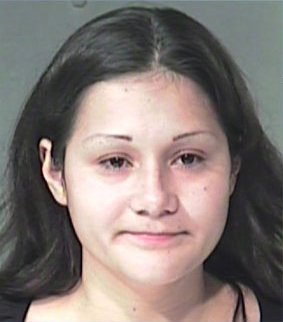 Angelica Jimenez
Angelica Jimenez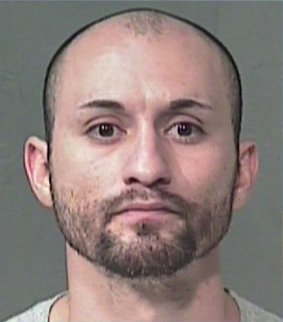 Steven Saldana
Steven SaldanaCHANDLER, AZ (CBS5) -
A caregiver for Child Protective Services has been sentenced to 10 years probation for child abuse.
A judge sentenced Angelica Jimenez Thursday morning, according to the Maricopa County Superior Court.
In January, Jimenez plead guilty to one count of Child Abuse and Hindering Prosecution.
Chandler Police arrested Jimenez in August after a baby girl she was caring for was rushed to the hospital. Jimenez initially told police she was alone when the infant stopped breathing.
Doctors found multiple bruises, abrasions and a cigarette burn on the baby's body. It was also discovered that the baby had 14 broken bones, some believed to have been caused by severe shaking.
Detectives learned later that Jimenez was with her boyfriend, Steven Saldana, when the baby was found not breathing and that he'd been staying at her home.
After a number of interviews, Jimenez admitted that she knew Saldana had been abusing the baby since the end of July, but that she never called police or CPS.
Police said Saldana is a convicted felon with a long criminal history. He faces three counts of child abuse in the case.
Source: WAVE
School Asked to Exclude CAS
March 28, 2012 permalink
On April 11 a lawyer for the District School Board Ontario North East complained of certain errors of fact in this post. Corrections responsive to the letter are added in this color (red).
Parents Richard and Henrietta Green have sent a letter to their school board asking them to exclude Timiskaming children's aid workers from their school. The request came after their son was traumatized by a CAS worker interviewing him at school, and leaving him fearful that he would be removed from his parents.
"This statement is untrue. Neither the Board nor Principal Bowes received this letter. Rather, the letter came to their attention from Canada Court Watch's website and VOCA's website." — Since Mrs Hendry represents the school board, we will assume that the original statement was incorrect. The letter was not delivered, except by posting on the internet.
expand
collapse
Parents in northern Ontario get ready to take on school board regarding the Children's Aid Society
A number of parents in District School Board 1 Ontario North East have reported problems with the Children's Aid Society going into the school to interrogate and to terrify children.
"This statement is untrue. The Board has not received any complaints from parents in this regard, except from Richard and Henrietta Green." — Again, since Mrs Hendry has better information, we will say that the school board has not received complaints from other than the Greens. Canada Court Watch, however, may have received more complaints.
A letter has been sent to the school board as the first salvo by local parents to get CAS out of the schools and to stop harassing their children.
"This statement is untrue. Neither the Board nor Principal Bowes received this letter. Rather, the letter came to their attention from Canada Court Watch's website and VOCA's website." — Once again, we assume that as the representative of the board, Mrs Hendry is correct, that the letter was not sent to the board.
Canada Court Watch has downloaded and reviewed the official school board policy and has found that it violates the law.
"This statement is untrue. All of the Board's policies are in compliance with applicable laws. In any event, Canada Court Watch's terms and conditions of use specifically state that it does not provide legal advice, and yet it purports to advise the public that one of the Board's unspecified policies is unlawful." — Fixcas has never suggested that Canada Court Watch is an authoritative source of information on the law. For example, on our help page we clearly state that legal help from a lawyer is always the best. Some persons unable to afford competent legal counsel have been forced to rely on Canada Court Watch as the best help available.
Anyone from this school district can contact Canada Court Watch for information on how to contact other parents in the region who are going to start fighting back. Read the letter to the school board at the link below: Richard Green to School Board (pdf) (local copy.
Source: Canada Court Watch
Birthnappers Sued
March 28, 2012 permalink
The Home School Legal Defense Association has decided to take up the case of Scott and Jodi Ferris whose newborn baby was seized without cause by a hospital in Hershey Pennsylvania.
expand
collapse
Newborn Seized in Hospital by Police, Social Worker
I am not content to sit on the sidelines while the government gradually usurps the very essence of parental rights. I hope you share my determination. We need to stand with people like Scott and Jodi Ferris (obviously no relation to someone named Farris). Here’s their story:
Jodi went into labor a bit earlier than she had expected—and the baby was coming rapidly. Given their location and other factors, the midwife they had hoped would deliver the baby at their home encouraged them to get in an ambulance and head to the hospital.
Their baby, whom I will call “Annie,” was born in the ambulance in the parking lot of the Hershey Medical Center—a government hospital in Pennsylvania. Hospital personnel arrived very quickly and took charge of both baby and mom.
As any mother would do, Jodi immediately began to ask the nurses and attendants how her baby was doing. The hospital staff was utterly unresponsive. When they started to give Jodi an injection, she asked what it was and what it was for. They gave her vague answers like, “It’s just to help.” Only after giving her the injection of oxytocin did they tell her what it was and then asked, “You aren’t allergic to that are you?”
Jodi persisted in asking about Annie. No one would tell her anything other than “she’s in good hands and you’ll be able to see her soon.”
Eventually a doctor told her that Annie scored a 9 on a physical exam applied to newborns known as the APGAR test. A score of 8 or higher is considered healthy. (It is unclear when the score was given since she was in the ambulance at birth.) But shortly after this a different doctor told Jodi that Annie was “very sick” and would need to stay in the hospital. This doctor’s comments were accompanied by an explanation of his disdain for midwives saying, “Too many people think they know what they’re doing.”
About an hour later, another hospital staffer finally brought Annie to Jodi and said, “The baby is doing good. She will be able to go home in no time.”
Legal Requirements?
However, several hours later yet another staffer told Scott and Jodi that Annie would have to stay in the hospital for 48 to 72 hours for observation. Even though they persisted in asking why Annie would need to stay, his only answer was that “the law requires us to keep the baby for 48 hours.” When they asked for a reference to this supposed law, he answered, “you’ll have to get that from risk management.” (By the way, there is no such law in Pennsylvania.)
The risk management staffer eventually told them that even though they saw nothing wrong with the baby, they just like “to keep babies like this” for 48–72 hours. The Ferrises were told that Annie would not be released for this period since it was “unsafe for her to leave the hospital.”
Eventually, a risk management staffer admitted that the risk that was being managed was not the health of Annie but the risk that the hospital might get sued if something went wrong after she was discharged.
Ultimately, risk management said that they would be satisfied with a 24-hour stay and that Jodi and Scott could remain with the baby overnight.
You have been Accused
Late in the afternoon, a government social worker named Angelica Lopez-Heagy came into Jodi’s room announcing that she was there to conduct an investigation. Jodi asked to know the allegations. The social worker claimed that it would be against the law for her to show Jodi the allegations.
Jodi replied that she would not be comfortable answering the questions if she couldn’t know the allegations. Immediately the social worker proclaimed, “Since you’re not going to cooperate, I’ll just go and call the police and we can take custody of the baby.”
Fearing that the social worker would carry out her threat, Jodi replied that she was willing to cooperate.
The social worker soon intimated that the issue was Jodi’s refusal to consent to medical treatment for the baby. Jodi replied that she had no idea why anyone would say that. The social worker claimed that she had refused to allow a Vitamin K shot for Annie. Jodi replied that no one had asked her about such a shot. Moreover, she had overheard hospital staffers saying that they had already given Annie such a shot.
Neither the social worker nor any hospital staffer ever gave Jodi or Scott any example of any medically necessary treatment that they had refused for Annie.
At this point, Scott left the hospital to tend to their older children who were staying with friends.
Ordering Tests
Shortly after this, the hospital asked to check Annie’s white blood cell count and to perform a strep test. Jodi agreed to the testing.
Then the hospital demanded that they give Annie shot for Hepatitis B. Jodi said that she would agree only if they tested her or Annie to see if either of them were positive. If so, then she was quite willing to have the shot for Annie. The hospital claimed that they had forgotten about this earlier when it was still possible to test that day, and that they needed to give the shot anyway without any testing.
When the social worker pressed her to make an immediate decision about this shot, Jodi asked her if they could simply wait until Scott got back before they decided.
Put yourself in Jodi’s shoes at this moment. You gave birth that morning in an ambulance. The hospital has made wild and conflicting claims about your baby’s health all day long. You are exhausted. You are in pain. Your husband has gone to check on your children. And a social worker who has threatened to take your baby into police custody is standing in your hospital room demanding that you make an immediate decision.
Jodi simply said, “Please can’t this wait until my husband gets back.”
The social worker renewed her threat. If Jodi would not answer her question right then, she would call the police. And then the social worker started adding conditions. She and Scott would have to agree to sign a safety plan before she could conclude her investigation.
Jodi said that she wanted her husband and an attorney to look at the plan. She felt she was in no position to read such a document and really understand what she was being pressured to sign.
Thrown Out
And then the story turns ugly.
The social worker left the room and called the police. Without a court order they took custody of Annie, immediately claiming that she was suffering from illness or injury—a patently false claim.
The social worker consented to the administration of the Hepatitis B shot even though no blood test had been done.
The police made Jodi Ferris get up out of her hospital bed and escorted her to the entrance—they were expelling her from the hospital because she had not signed the “safety plan.”
Scott met her at the entrance to the hospital. The police escorted them both off of the grounds of the hospital.
Jodi was told that she would be allowed to return every three hours to nurse the baby through the night.
Jodi and Scott were forced to spend the night that she had given birth in their car in the parking lot of a nearby Wal-Mart. You read that right. They kicked this mother out of the hospital, and in order to be close enough to feed her child, she had to sleep in the car.
To add insult to injury, Jodi was given access to Annie only sporadically and not every three hours.
Baby Returned
The next morning a judicial officer held a shelter care hearing. After hearing the evidence, the officer immediately returned custody of Annie to her parents.
No parents should be put through this kind of ordeal. It is not a crime to ask questions about the well-being of your child. It is not a crime to ask for testing to ensure that a procedure is needed before it is done. It is not a crime to be a protective mom.
It is a moral offense of the highest order to kick a mother out of a hospital and to seize her child on the day of her birth simply because a mom wanted to have her husband read a legal document before she signed.
Both the medical personnel and the social worker engaged in outrageous behavior toward this family.
And we believe that they violated their rights under the Constitution of the United States. And we are going to court to prove it.
Why is HSLDA fighting for parental rights in this context? It is not a homeschooling case.
Parental Rights at Risk
We are taking this case because we are tired of seeing the erosion of parental rights in virtually every area of life. Parental rights in medical cases have an impact on broader parental rights, including educational decisions.
And the plain fact is this: If we don’t fight for parental rights, it is probable that our rights will be eroded bit by bit until there is nothing that remains.
We cannot afford to fund cases like this out of HSLDA’s membership dues. We are taking this case because we believe that our members and friends will stand with Jodi and Scott Ferris. We believe that parents should not be punished by “over-the-top” social workers and doctors.
The social worker’s priority was not the welfare of Annie, but her own convenience and her own perception of her power. She was aiming to teach this homeschooling mother a lesson.
And the hospital was clearly not concerned that Annie had a medical issue—they were just trying to avoid being sued for medical malpractice.
When government workers run over parents in cases like this, the lesson that needs to be taught is to the government.
This case will cost tens of thousands of dollars. Your tax-deductible gifts to the Homeschool Freedom Fund of the Home School Foundation will make it possible for us to take this case to court and to try to establish a precedent that will help protect us all.
All of our families are at risk when the government is allowed to run over one of us. When we stand together, we can fight back for freedom and for truth.
Thanks for giving as the Lord leads you. And pray for us. This is not an easy case. We really need your ongoing prayers.
Source: HSLDA, Home School Legal Defense Association
Addendum: Michael Farris interviewed mother Jodi Ferris. audio (mp3).
Source: Home School Legal Defense Association
Las Vegas Rally
March 28, 2012 permalink
Discontent with family law is spreading. Here is a photo of a rally in Las Vegas on March 21.
A video of the rally is on YouTube and a local copy (mp4).
Source: Facebook
Misrepresentation of the Day
March 27, 2012 permalink
Melody Blackier That's another dirty trick of theirs. They were called to my house when I was about six. That worker was actually decent. They found nothing wrong and went away. Then ten years or so later when they were taking my siblings, a new worker said "this family has a ten year history with CAS"
Source: Facebook,Canada Court Watch
Social Worker Abducted
March 27, 2012 permalink
Scottish social worker trainee Holly Loudoun was abducted by three teenagers while visiting their home.
expand
collapse
Social worker abducted and assaulted on home visit
Holly Loudoun was forced to her knees and hit repeatedly as three teenagers discussed what they would do to her.
Three teenagers who abducted and attacked a trainee social worker on a home visit have been jailed for a total of five years.
Holly Loudoun, 23, was forced to her knees and hit repeatedly as James Muir, Lauren Taylor and Tammy Sangster discussed what they would do to her.
Ms Loudoun, who was left with a broken nose and covered in blood, said: "I didn't think I was going to get out of that house alive."
Sheriff Alistair Watson described the attack as "appalling" and said it would have a lasting effect on the victim.
The teenagers launched the assault on Ms Loudoun as she visited supported accommodation in Merryvale Drive, Irvine, Ayrshire.
She told Kilmarnock Sheriff Court: "James pushed me towards Lauren and she grabbed me by the hair and punched me in the face three times.
"I was screaming 'Let me go' but Lauren said, 'No'. She pushed me down onto my knees while they looked for money. They were wondering what to do with me,"
Muir, 16, Taylor, 17, and Sangster, 19, were earlier convicted of abducting Ms Loudoun, detaining her against her will and assaulting her in the course of her employment.
Muir, of Paisley, admitted the offence while Taylor, of Bishopton, Renfrewshire and Sangster, of Kilbirnie, Ayrshire, were found guilty by a jury of the attack in June 2011.
The court heard Ms Loudoun was seized and pushed against a wall before being punched repeatedly on the head, shoved to the floor with her nose and mouth covered and robbed of two mobile phones and her car keys.
Ms Loudoun, who had been on a student work placement, told the court the trio discussed keeping her in the flat overnight and taking her car.
Suzanne Fotheringham, prosecuting, asked her: "What did you think was going to happen?
Ms Loudoun replied: "I didn't think I was going to get out of that house alive."
Muir was given two years detention while Taylor and Sangster were each given 18 months detention.
Passing sentence, Sheriff Watson said: "What you did to the victim in this case was appalling. She was detained in circumstances that she was in fear of her life."
Sheriff Watson said Ms Loudoun showed "considerable courage" and added: "The gravity is such that only a custodial sentence can reflect the seriousness of what you did and the long-term effect it will have on Ms Loudoun."
Source: STV
Forget Your Kids
March 25, 2012 permalink
A mother who does not know whether her children are dead or alive is being legally ordered to stop speaking about her children in public.
expand
collapse
Shawna Maheu I was served with papers today at 10am from Patricia O'Connor who is the lawyer for the Department of Youth Protection here in Montreal to take down the posts I've been posting about my children or else they will take further action and use it against me saying I am endangering the security and well-being of my girls. What would you do if you felt your kids were dead because you haven't heard a word nor received any information concerning thei well-being even those you sent hundreds of emails to anyone in the department and till this day, not 1 person has called me back? Pretty strange since their organisation promotes helping aiding and assisting blablabla... I asked to please interfere that Anna Renda and her team be stopped from practicing parental alienation for this is illegal and against the human rights. I am a Canadian citizen, so are my children. It be known my children's names have been removed as well as anything revealing their identity but I will continue posting all the corruption and injustices along with the names of the people alienating from my children. I am asking anyone who has been following me to please erase my two girls's names but still spread the word on how Batshaw does nothing but destroy families, rob innocent children of their innocence. Let it also be know that I will not be intimidated by the Department of Youth Protection. There's nothing more they can do to me that they haven't already done .
Source: Facebook, Canada Court Watch
Addendum: An update five days later.
expand
collapse
Shawna Maheu Update: If you have been following my posts, Batshaw tried to play dirty and thought they had us when they used their influences and had warrants put out on us for a complaint put on us by my oldest daughter! Unfortunately for Batshaw, we have an excellent lawyer who after speaking with certain people in the upper position had our warrants dismissed... They found the complaint to be bogus (we proved it) I found some disturbing information regarding ten Batshaw workers and one of those workers is Elliot Zelnicker,who is our current workers manager. I confronted Elliot Zelnicker about his ten million dollar lawsuit granted by justice Roy and he then tried to set us up by talking with my oldest daughter pressuring her to file charges on us. Google Elliot Zelnicker for complete story of how Zelnicker and nine other Bathshaw youth protection workers were found guilty of many things mainly falsifying documents, perjuring himself in court, the list goes on! Today I received documents wrote up by Zelnicker. It is an addendum. We had had a meeting regarding this document and 1 have a draft pages. This one has 3 an extra page of lying crap! Why? Cuz I confronted Zelnicker. We go to court Tuesday our heads held high and we have recordings of a certain person saying... "I'm recommending closure". This guy is asking for another year??? How can he make the decision when we met him for 15 mins? He wants revenge for embarrassing him in front of his team.
Source: Facebook, Canada Court Watch
Sarnia Rally
March 25, 2012 permalink
Canadians for Family Law Reform conducted a rally in Sarnia on March 23. Here are some photos: [1] [2] [3] [4] [5] [6] [7] [8] [9] [10] [11] [12] [13] [14].
Source: Facebook
expand
collapse
Local family law reform activists held ‘Occupy the Courthouse 2012′ rally this week, similar rallies held across country
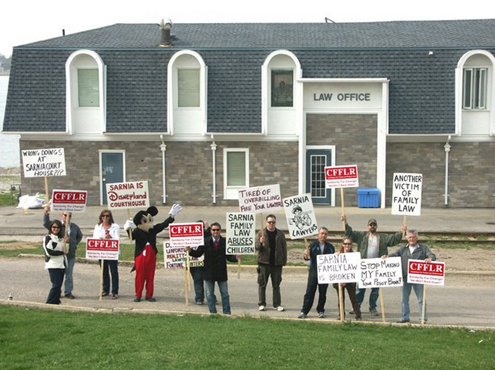 Photographs by Rick Terpstra Photography
Photographs by Rick Terpstra PhotographyLocal family law reform activists took part this week in "Occupy the Courthouse 2012" concurrent with other grassroots law reform organizations across the country.
On Friday, Mar. 23 demonstrations took place in three separate locations including at the entrance driveway to the Sarnia courthouse located at the intersection of Christina St. N. and Errol Road, as well as in front of the respective law offices of George McFadyen on Napier St. and Janet Whitehead on Ferry Dock Hill.
Whitehead, who is vice-chairperson of the County & District Law Presidents’ Association, submitted a letter to the Editor of the Sarnia Observer Mar. 16, on behalf of the group that represents 11,000 lawyers across the province, admonishing the local family law reform group for bringing "unfair attention to the family justice system."
Dave Burgess, a co-founder of Canadians For Family Law Reform, said he wanted to make two points during the day's demonstrations. He started by saying, "Anyone should be able to take a recorder into a courthouse, to record what goes on to supplement their notes."
Presently, it is not permissible to bring an audio recorder into a courtroom in Canada unless otherwise granted permission by a judge.
He said the other issue that needed highlighting was, contrary to the lawyers group's letter to the Observer, Sarnia's courthouse is not one of the 17 unified family courts and, he asserted, does not enjoy the benefits of a unified courthouse.
Ontario recently expanded its unified family court program to include Sarnia and Chatham courthouses. Services include a mandatory information session, free on-site meditation, an information referral coordinator and subsidized off-site mediation.
When asked in a recent interview with the Sarnia Observer if people are aware of these new services, Whitehead replied the association is “working on public education.”
Burgess pointed out that Sarnia has two divided, separate courts, Ontario Court of Justice and Superior Court of Justice, and makes the assertion the divided nature of the courthouse "breeds conflicts of interest."
He added, "Let's fix family law here in Sarnia because it's very broken and it's hurting us, it's hurting our moms and dads, and most of all it's hurting our children."
Sarnia is not presently listed on the Ontario Attorney General’s website as one of the 17 unified family courthouses.
Whitehead, who has practiced family law for 17 years, told the Observer that she has seen the system improve, adding that it’s always evolving because family dynamics change with each new generation.
Occupy the Courthouse 2012 demonstrations took place in cities and towns across Canada on Mar. 23.
Source: Lambton Shield
Dead Baby Scam
March 24, 2012 permalink
Kathryn Blaze Carlson is covering all aspects of forced adoption, this time falsely telling a mother that her baby died shortly after birth. Link: Your baby is dead: Mothers say their supposedly stillborn babies were stolen from them. Some of the cases in the article are the same ones on our page Dead Baby Scam
Ombudsman Bill Coming
March 24, 2012 permalink
A bill to allow the ombudsman to look into children's aid societies will be introduced in the Ontario legislature soon. Neil Haskett says it will be some time in April on a Thursday. All are invited to attend.
expand
collapse
We are sending an open invitation to everyone fighting for accountability of Hospitals, Long-Term Care, Children’s Aid Societies, School Boards, Universities/Colleges, or the independent Police Review to join accountability advocates from across Ontario to the First Reading of the next Bill at the Legislative Assembly of Ontario (Queens Park) in Toronto.
The NDP have been working hard on the next bill and it’s increasingly drawing support from members of both the Ontario Liberal and PC Parties. It’s expected to be introduced early April and it will be on a Thursday so leave your calendars open! Stay tuned for further details shortly after the Ontario budget is released on Tuesday, March 27, 2012.
Source: Facebook, Neil Haskett
Eggleton Calls for Inquiry
March 24, 2012 permalink
Senator Art Eggleton is calling for an inquiry into Canada's forced adoptions. Kathryn Blaze Carlson continues her series
Family Disrupted
March 24, 2012 permalink
British parents David and Julie Nevin lost their son Reilly for eleven months because he got a bruise hitting his head on furniture.
expand
collapse
Social workers took away our baby for nine months: With no evidence against them, couple were banned from looking after their son
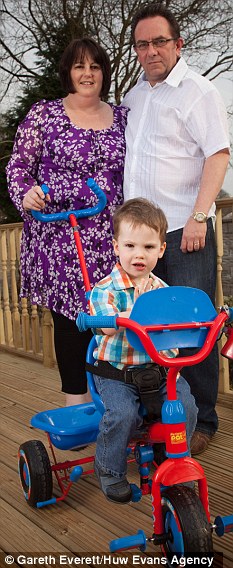 Outrage: David and Julie Nevin had their son taken from them by social workers for nine months after they were wrongly accused of having hit him
Outrage: David and Julie Nevin had their son taken from them by social workers for nine months after they were wrongly accused of having hit himWhen Julie Nevin put her only son to bed in late December 2010, he was seven months old.
The next time she was allowed to perform that simple act, Reilly was a 16-month-old toddler.
She and her husband David lost nine months of their little boy’s life after social services took him away over a minor bruise on his forehead.
They believed Mr and Mrs Nevin may have slapped their beloved son, with the couple at one point being arrested on suspicion of assault and subjected to the humiliation of police taking their DNA, fingerprints and mugshots – despite all the initial checks coming back clear.
The couple’s nightmare only ended when a consultant paediatrician belatedly conceded that the bruising had most likely been caused by the little boy accidentally bumping into the metal legs of the family’s sofa – as they had originally suggested.
A judge dismissed the council’s application for a care order, ruling that Reilly was already a ‘well-cared for child’, and his parents were allowed to take him home.
Last night the Nevins told how their lives had been ‘turned upside down’ by the horrific experience, and called for an urgent overhaul of the child protection system.
Mrs Nevin, 40, who works for the Red Cross, said: ‘Reilly left us as a baby and came back as a toddler. We have had to start all over again. For nine months we came back to an empty house, it was very distressing.’
‘The whole system is loaded against parents. You are guilty until proven innocent. Nobody believed us apart from our GP. Our backgrounds and medical history were checked and there was nothing.’
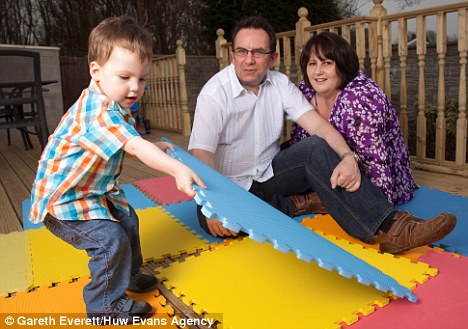 Catch up: David and Julie are finally getting some time to play with their son
Catch up: David and Julie are finally getting some time to play with their sonShe added: ‘We felt we were stuck in a system in which social workers were ticking the right boxes just to make them look as if they were working.’
The couple’s ordeal began on Christmas Eve 2010, when Reilly woke up at the family’s semi-detached bungalow in the village of Rhos, near Swansea, with a minor bruise on his forehead.
Mrs Nevin called her husband, a manager in a dairy company, who advised her to take Reilly to their family doctor to be on the safe side. The GP concluded he was a ‘well, bright and lively’ child who had probably hurt himself rolling around the sitting room floor, and that there was no evidence that the injury was deliberate.
But five days later, Mrs Nevin took Reilly for a check-up at a medical centre, and staff referred him to the paediatric assessment unit at Morriston Hospital in Swansea. There, a consultant paediatrician suggested a slap could have caused the bruise, describing it as a ‘non-accidental suspicious injury’.
His parents rejected this and gave other possible explanations, including him hitting his face on the metal legs of the sofa, or on his cot bars, or on his toys.
But Mrs Nevin said: ‘Although the paediatricians did not say it in so many words, they thought we had slapped him.’
Reilly stayed in hospital for two nights for observation and tests, including one for shaken baby syndrome, which all came back clear. Despite this, the devastated couple were told they were not allowed to take Reilly home because of concerns about his safety.
Arrangements were made for the baby to stay with relatives, initially his uncle and aunt. Reilly then spent the next nine months being fostered by Mrs Nevin’s parents, who live a few miles away from Rhos, with a social worker acting as his legal guardian.
The couple were allowed to see their son, but only on a strict schedule, and they had to be supervised at all times. They visited each day but overnight stays were banned.
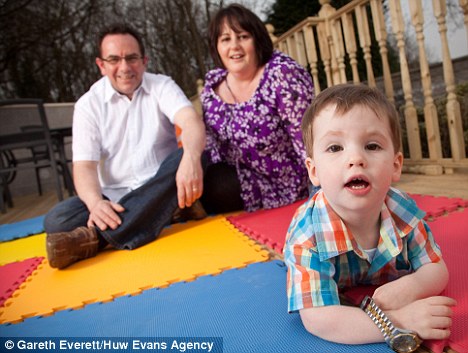 Innocent: Reilly had a bruise on his forehead - which social services believed may have been caused by a slap
Innocent: Reilly had a bruise on his forehead - which social services believed may have been caused by a slapMr Nevin, 48, said: ‘On the first day, we got back home and we just hugged each other in the kitchen and cried. Even though it was New Year’s Eve, we were in bed by 8pm and cried all night.’
Then in February last year, the couple were arrested for suspected assault. A few weeks later however, police told the Nevins the case was being dropped because of lack of evidence. Despite this, social services still sought a care order and told the couple Reilly might be put up for adoption.
Over the next few months, the couple, who have been married for nearly four years, attended the family court in Swansea four times to try to get Reilly back. A second consultant paediatrician, instructed by Reilly’s guardian, initially told the hearing the bruising was caused ‘most probably by a hand slap’.
But after various alternatives were put to him he changed his evidence, conceding the bruising was narrower than he would have expected if Reilly had been slapped. He eventually said he believed the most likely cause was Reilly bumping against a sofa leg.
District Judge Jane Garland-Thomas dismissed the care order application, ruling that Neath Port Talbot Council had failed to prove the injury was non-accidental and that there was ‘no evidence whatsoever’ of any other causes of concern.
She added: ‘Reilly was a well-cared for and no doubt still is a well-cared for baby and these parents have been totally compliant and engaged fully with the social services.’
 Scene: Morriston Hospital in Swansea, where it was suggested that Reilly may have been struck on the head
Scene: Morriston Hospital in Swansea, where it was suggested that Reilly may have been struck on the headFinally, on September 27 last year, the couple were able to take Reilly home.
Nearly six months later, Mr and Mrs Nevin are still recovering from the pain of being separated from Reilly for nearly a year.
They have written to the Prime Minister asking for changes to child protection procedures, highlighting the ‘stress, heartache, family upset and depression’ they suffered.
Mrs Nevin, who was prescribed anti-depressants, said: ‘He is the most loved child ever. But I still don’t think I have got over it. I am even afraid to take Reilly to the doctor now.’
A spokesman for Neath Port Talbot Council said: ‘We take safeguarding of children extremely seriously. We are satisfied that all appropriate actions were taken.’
Source: Daily Mail
Christopher Booker comments on the Nevin case, and on the use of experts in family court generally.
expand
collapse
Why do our family courts rely on 'hired gun’ experts?
Recent revelations bring the authority of expert witnesses called by social services into severe doubt.
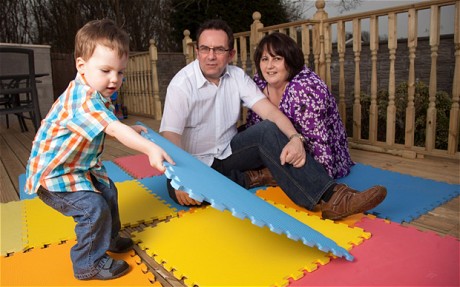 David and Julie Nevin of Swansea, with their 22-month-old son ReillyPhoto: Gareth Everett/Huw Evans Agency
David and Julie Nevin of Swansea, with their 22-month-old son ReillyPhoto: Gareth Everett/Huw Evans AgencyThere was one highly unusual thing about the newspaper report yesterday on a Welsh couple, David and Julie Nevin, whose young son was removed by social workers for nine months, with a view to possible adoption. Two paediatricians had suggested that a small bruise on the boy’s forehead was caused by parental abuse – but, in this very exceptional instance, a judge found the doctors’ evidence unconvincing and ordered the boy to be returned to his parents. Hundreds of similar cases each year remain unreported because the evidence of “experts” is almost invariably accepted by the courts.
Devastating new light was recently shed on the “expert” evidence on which our courts so crucially rely by Professor Jane Ireland’s report analysing 126 psychological reports used in family cases. A fifth of their authors, the study found, had no proper qualifications; 90 per cent were not in practice but earned their living from producing reports for social workers, and two thirds of the results were “poor” or “very poor” in quality.
The publication of this damning report, which had been delayed for six months, coincided with the reporting to the General Medical Council of another psychological “expert”, Dr George Hibbert, accused of writing hundreds of reports framed to suit the views of social workers. He had allegedly earned £6,000 a week for each family he was asked to “assess”.
A charge commonly heard against these psychiatric and medical “experts”, endorsed by countless informed observers, is that too many of them are just “hired guns”, regularly employed by social workers to come up with the evidence they need to justify removing children from their parents. Naturally, those in charge of the system are anxious to deny such claims. In 2009, Lord Justice Wall, now our senior family judge, went out of his way, in one well-publicised case (W (Children) EWCA Civ59), to claim that to regard experts as “hired guns” was “a misconception”: their impartiality was a glory of our family justice system. Yet that very case, involving the Webster family, has become a byword for the fallibility of “experts”.
Three children were taken from their parents after metaphyseal bone fractures in one of them had been diagnosed as evidence of parental abuse. When the parents refused to admit to this, a psychiatric “expert” testified that this showed they must be guilty of both physical and psychological abuse. The children were sent separately for adoption.
When the wife again became pregnant, the parents escaped to Ireland to avoid the baby being taken. But they also began to track down independent experts who might take a more informed view than that accepted by the court. Eventually no fewer than five experts, including one of the most respected paediatricians in the land, testified that the bone fractures came from natural causes. This led to the parents being allowed to keep their fourth child. But Wall ruled that, though the case was clearly distressing, it was too late to return the adopted children.
In another published judgment in 2010 (EWHC B12), Mr Justice Bellamy summarised a case that cost taxpayers more than £1 million, involving three children removed from their parents by Coventry council. Social services, which had been intervening in the family’s life for 10 years, found a psychiatrist who reported, on the basis of medical records, that the parents had been fabricating various medical conditions. Bellamy, in his judgment, excoriated this 235-page report, for which the “expert” was paid £35,000, and ordered that the children be returned to their parents.
Last year, however, Bellamy ordered the publishing of another judgment (EWHC 2011 B8), in a case I had several times reported, which arguably showed that he too was susceptible to experts whose one-sided evidence had not been questioned. The judgment (continaining several remarks directed at me, some of which he later had to retract) ordered the removal of a baby from its devoted mother, accusing her of having harmed her child, on evidence remarkably similar to that which proved so flawed in the Webster case.
I now have files full of similar examples of families torn apart on the basis of “expert” evidence. Only very occasionally do these get publicity, via a higher court. Last year, for instance, the Court of Appeal overturned a ruling by Judge Orrell that three children should be removed from their parents. It had been arrived at after a 15-minute hearing where a medical expert testified that bruising on one child could possibly have been caused by “pinching”. The parents had not been allowed to challenge this evidence. Mr Justice Thorpe memorably observed: “I am completely aghast at this case. There is nothing more serious than a removal hearing, because the parents are so prejudiced in proceedings thereafter. Once you lose a child it is very difficult to get a child back.”
The removal of children into care by what the BBC calls our “brave” social workers is now at a record level of some 900 a month. In a Commons debate last week, Jonathan Djanogly, a junior Justice minister, stated in answer to John Hemming MP that some 90 per cent of these family care proceedings rely on the evidence of expert witnesses, the average case being based on four such reports. These make for their authors a remarkaby good living. (A senior paediatrician, a doctor tells me, can receive £100,000 for writing one.)
Recent evidence seems to confirm there is much more here which those professionals whom Mr Djangogly described as “stakeholders” would not wish to see exposed to public view.
Source: Telegraph (UK)
More on Shaken Baby Syndrome
March 24, 2012 permalink
The case against shaken baby syndrome continues to grow, while more innocent victims are convicted and jailed.
expand
collapse
In 1971, pediatric neurosurgeon Norman Guthkelch helped come up with the medical diagnosis of shaken-baby syndrome.* Guthkelch and another pediatrician each wrote a paper proposing that unexplained bleeding in the brain of infants could occur because of whiplash—via shaking—without causing a visible neck injury and without direct impact to the head. That diagnosis became the basis for “do not shake” campaigns and, over the years, hundreds of criminal prosecutions for child abuse.
Now Guthkelch is worried that medical examiners and prosecutors have been too quick to turn to the shaken-baby diagnosis—and that innocent people may be in prison as a result. He called me to express that concern after I wrote about some questionable shaken-baby prosecutions for the New York Times Magazine last year. Guthkelch told Joseph Shapiro of NPR about an Arizona case he found particularly troubling after reviewing it for the defense. “I think I used the expression in my report, ‘I wouldn’t hang a cat on the evidence of shaking, as presented,’ ” he said.
Guthkelch, who is 96, was talking about the conviction of Drayton Witt, who was an 18-year-old when he was charged with shaking his 4-month-old son, Steven, to death in 2000. Based on the standard medical theory of the time, the case looked like a classic case of abusive shaking to doctors who treated Steven in the hospital as well as to the medical examiner who conducted the autopsy. Later at trial, these doctors testified against Witt, who was convicted of second-degree murder and sentenced to 20 years.
But now the case doesn’t look so clear-cut. It may, instead, be an example of doctors applying an outdated method of diagnosis—one that ignored Steven’s troubled medical history and thus missed an alternate explanation for his death. It’s not just Guthkelch who is raising the alarm: The medical examiner who testified against Witt, pathologist A.L. Mosley, has recanted his position at trial. Mosley now believes that Steven died of natural causes. Which raises a couple of questions: Is Drayton Witt serving time for a crime he did not commit? Will prosecutors in Arizona continue to argue that his conviction should stand?
Steven Witt’s health problems started at birth. He was born with the umbilical cord wrapped around his neck, and he had trouble breathing. He got better and went home, but a few weeks later, his mother, who lived with Drayton Witt and later married him, brought the baby to the doctor because he’d been feverish and vomiting for three days. A few weeks later, Steven was sick again, with a fever and an upper respiratory infection. From then on, his mother was in frequent touch with the pediatrician.
A few days before Steven turned 4 months old, his mother took him to the emergency room because of what was by then his familiar fever, congestion, and vomiting. The doctors thought he had pneumonia, and they prescribed an antibiotic. After Steven took his first dose, his left eye couldn’t focus, he refused the bottle, and he lay limp. The next morning, he threw up and started shaking. Witt came home from work, and he and Steven’s mother rushed the baby to the hospital.
In the ER, Steven had a grand mal seizure. He spent the next six days in the hospital, with a fever and pupils that weren’t dilating normally. The doctors weren’t sure what was wrong, but tests showed more massive seizures, even though Steven was taking anti-seizure medication. His mother told the doctors that Steven had lost head control and couldn’t track with his eyes as he could before. Still, they sent the baby home with his parents before the week was up, on May 7, with antibiotics and the anti-seizure drug Phenobarbital.
According to Witt’s defense, Steven was never again a normal, healthy baby. Sometimes, his eyes twitched back and forth. He threw up repeatedly. His mother called the pediatrician and the hospital; his grandmother worried about his health; and a neighbor who was a nurse noticed the baby’s recurring problems. Steven’s mother brought him back to the pediatrician on May 26 because he’d again had a fever for days and had been projectile vomiting. She was told to continue the antibiotics and Phenobarbital, and she and the baby were sent home.
On June 1, Witt took care of Steven during the day while his mother went to work. Shortly after 8 p.m., Witt told Steven’s mother over the phone that he thought the baby was having another seizure because his eyes weren’t normal. They agreed that Witt would pick her up at work and they would drive to the hospital. On the way, Steven had a major seizure, and Witt tried to resuscitate his son. At the hospital, it took 32 minutes to get Steven’s heart started again. He was also seriously dehydrated—because of the vomiting, he’d been unable to keep down food or liquids.
And yet despite the baby’s long medical saga, Witt was almost immediately suspected of abuse. The social worker from child protective services who talked to Witt and his wife at 4 a.m. on June 2 wrote in her notes that the couple had no specific explanation for the baby’s “severe head trauma.” After Steven’s death on the afternoon of June 2, Dr. Mosley, who knew that the doctors at the hospital thought he’d been killed by shaken baby syndrome, concluded that the death was a homicide caused by “shaken/impact syndrome.” Mosley noted that Steven had no neck injury, no bruising or fractures, no external signs of abuse. But none of that mattered. At Witt’s trial, Mosley testified against him, along with several other doctors. Because of the state of the science at the time, Witt had just one doctor in his corner, who only partially rebutted the shaken-baby theory.
Twelve years later, lawyers from the Arizona Justice Project have gone to court asking for a hearing for Witt. They want the state courts to reopen the case and order a new trial, based on the way the scientific understanding of shaken-baby syndrome has shifted. The mainstream position still holds that it is possible to shake a baby to death. But many doctors now allow that a history of illness like Steven’s can account for the subdural and retinal bleeding, and brain swelling, that used to be blamed exclusively on shaken-baby syndrome.
It’s Steven’s medical history that distresses Norman Guthkelch. “This was always a sickly baby,” he told me when I reached him over the phone. “I was taught to start by considering the non-criminal explanation, and this little guy was in sufficient trouble without any need to postulate someone had shaken him.” Mosley has joined Guthkelch in asking the Arizona courts to revisit Witt’s conviction. “There is now no longer consensus in the medical community that the findings I reported in my autopsy report are reliable proof of SBS [shaken baby syndrome] or child abuse,” Mosley told the court. “Steven had a complicated medical history, including unexplained neurological problems. He had no outward signs of abuse. If I were to testify today, I would state that I believe Steven’s death was likely the result of a natural disease process, not SBS.”
Drayton Witt reminds me of Shirley Ree Smith, a grandmother accused of shaking her baby to death in California in 1996. Both may well have been convicted based on past medical assumptions that may not stand up to present scrutiny. That may also be true of some people sent to prison more recently. I still wonder about the conviction of Trudy Munoz Rueda, a daycare provider whom I wrote about in the Times Magazine. Another is a former New York daycare provider named Alma Calderaro. When she was convicted of assault and child endangerment in 2009, and sentenced to eight and half years in prison, Calderaro’s lawyer did not call a single medical expert to testify on her behalf. Now on appeal, three doctors are saying that the baby who collapsed in Calderaro’s care had subdural bleeding that was chronic and that this condition, rather than shaking, probably caused her injuries. Prosecutors have until mid-April to respond.
By calling attention to these cases, I don’t mean to suggest that every defendant convicted of harming a baby who has the symptoms associated with shaken-baby syndrome is innocent. I’ve learned from my reporting that these cases are incredibly fact-specific. In a pending prosecution in Queens that has gotten a lot of attention, the baby who died, Annie Li, had serious bone fractures as well as internal bleeding. The lawyer for Li’s father, who has been charged with manslaughter and second-degree murder, says that while the test results aren’t in yet, a congenital bone condition may be to blame for the fractures. We’ll see.
Meanwhile, the district attorney who prosecuted Drayton Witt hasn’t responded to his petition for a hearing and a new trial. As these cases move through the courts, they are testing prosecutors’ and judges’ willingness to undo old verdicts. That’s never an easy step to take. But sometimes it’s the only one that is just.
Correction, March 15, 2012: This article originaly referred to Dr. Guthkelch as a pediatrician. (Return to the corrected sentence.)
Source: Slate
New Logo
March 24, 2012 permalink

The merger of the Northumberland and Hastings children’s aid societies has created a new name, Highland Shores Children’s Aid, and a new logo. Link for high resolution copy.
The new organization will be respectful of the wishes of parents and children, and will never separate them against their will. When problems develop between husbands and wives, social workers will assist them to resolve their differences so that family disruption will not ensue. Social workers will be true to their word and will be truthful in all court filings and will always follow through on promises to families. These new policies will commence on the date of the merger, April 1.
expand
collapse
New CAS has new look
The Northumberland and Hastings Children’s Aid Societies have adopted a new visual identity to go along with the merged organization's new name.
The Children’s Aid Society of Northumberland and Hastings Children’s Aid Society have released a new logo for Highland Shores Children’s Aid — its new name following the amalgamation of the two agencies, effective April 1.
The name “reflects the geographies of the two societies within the Hastings highlands and hills of Northumberland and along the shores of the Bay of Quinte and Lake Ontario,” according to a statement by the CAS.
“Protect, care, empower” are the words that will embody the new organization's philosophy and goals, said the agency.
The orange, green and white logo incorporates colours from the existing logos of the two societies and incorporates the key words for the new organization.
The three leaf motif further emphasizes the three key words, as well as signifying the growth and development of the new society that will now serve children, youth and their families in the counties of Hastings and Northumberland.
In addition to releasing the new logo, a new website for Highland Shores Children’s Aid, will be launched on April 1 under the domain name www.highlandshorescas.com.
Source: Belleville Intelligencer
Addendum: A link to their website
Addendum: Puffery, showing executive director Mark Kartusch.
expand
collapse
New Children's Aid Society open in Cobourg
Northumberland and Hastings CAS team up and launch the new Highland Shores Children's Aid
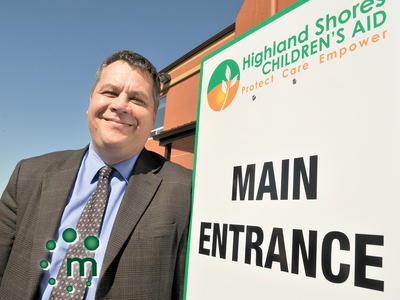 Highland Shores Children's Aid Society. COBOURG -- Mark Kartusch, executive director of Highland Shores Children's Aid Society, celebrated the new children's aid society on April 2. Highland is the merger of the Children’s Aid Society of Northumberland and the Hastings Children’s Aid Society. April 2, 2012.Karen Longwell / Northumberland News
Highland Shores Children's Aid Society. COBOURG -- Mark Kartusch, executive director of Highland Shores Children's Aid Society, celebrated the new children's aid society on April 2. Highland is the merger of the Children’s Aid Society of Northumberland and the Hastings Children’s Aid Society. April 2, 2012.Karen Longwell / Northumberland NewsCOBOURG -- Protect, care, and empower -- that's the motto of Cobourg's new Highland Shores Children's Aid. And as of April 2, it's officially ready to do just that.
As the Children's Aid Society of Northumberland and Hastings team up, the new Highland Shores CAS will provide care for kids, youth, and families within both counties.
"Thanks to all the staff, the hard work they do, and the planning. They truly made today come together," said Mark Kartusch, Highland Shores CAS executive at a celebratory ribbon cutting April 2.
It shouldn't matter where anyone lives; everyone is entitled to a little help and support here and there, Mr. Kartusch added.
From April 2010 to March 2011, the Northumberland and Hastings CAS combined helped nearly 2,000 families.
As Northumberland and Hastings CAS team up, the end goal is to continue to provide the services that can help children and families grow and succeed, and make services more available and more consistent.
Youth programs and services will remain the same, but organizations will be working closer together.
"We look forward to continuing to provide support for our kids and families," said Mr. Kartusch.
Anyone interested in learning more about Highland Shores Children's Aid, or about the services offered, can visit the new office at 1005 Burnham St. or visit the new website at www.highlandshorescas.com.
Source: Northumberland News
Addendum: Three years later Chris Carter obtained the Amalgamation Agreement (pdf).
Foster Girls Trafficked
March 23, 2012 permalink
Police in England have busted a child trafficking ring that provided underage girls for sex. The article is vague when it comes to specifics, but suggests that some or all of the girls supplied were in the care of child protectors. Comments from John Hemming follow the Daily Mail article.
expand
collapse
Police swoop on paedophile gang accused of modern-day slavery of girls in care aged 11 'bought and sold' for sex
- More than 100 officers swoop on homes across Oxford yesterday
- Alleged victims as young as 11, many of whom brought up in care
- 'Groomed and given drugs so they could be raped by tormentors'
- Police chief: 'Arrests intended to protect girls from further harm'
Dozens of vulnerable girls were bought and sold for sex by paedophiles running a modern-day slavery ring, police revealed yesterday.
Many of the 24 victims – some as young as 11 – were groomed, drugged and routinely raped over six years.
Council chiefs last night faced calls to set up an inquiry after it emerged that all the girls involved were known to social services or had been in their care.
 Major operation: Dozens of officers are briefed before descending on homes across Oxford in a series of dawn raids to arrest a gang on suspicion of child sex trafficking
Major operation: Dozens of officers are briefed before descending on homes across Oxford in a series of dawn raids to arrest a gang on suspicion of child sex trafficking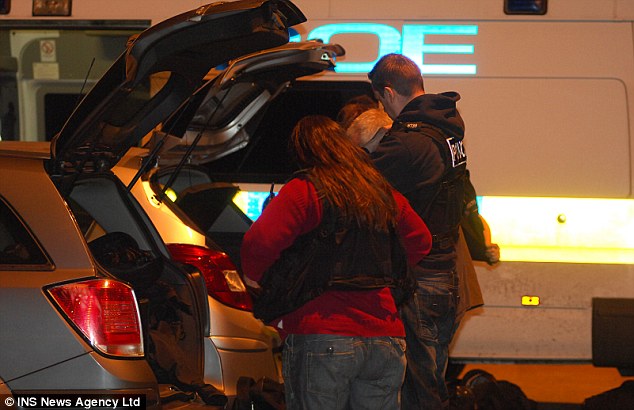 Mobilising: Officers loads up their cars as prepared to execute 14 warrants across the city
Mobilising: Officers loads up their cars as prepared to execute 14 warrants across the cityThe shocking scale of abuse in the affluent university city of Oxford was revealed after police arrested 13 men on suspicion of a variety of offences, including causing the prostitution of females under the age of 18, trafficking and rape.
Police are investigating the theory that the paedophile gang used social networking sites to swap information about victims, who in some cases were ‘conveyed’ to other parts of the country for sex.
All the victims were aged between 11 and 16, and were described as being ‘very, very vulnerable’ by a senior detective. It is feared many more under-age girls were targeted by the gang.
All the victims were approached individually before being groomed for sex and sold on for profit. The amounts of money involved are unclear but investigators believe thousands of pounds could have exchanged hands.
Thames Valley Police refused to reveal the ethnicity of the suspected gang members, saying such information could result in victims being identified.
Nor would they reveal whether the victims had been in foster care or care homes when they were
 Ready to move in: Police vans lined up ahead of the operation, which is investigating the alleged sexual exploitation of girls as young as 11
Ready to move in: Police vans lined up ahead of the operation, which is investigating the alleged sexual exploitation of girls as young as 11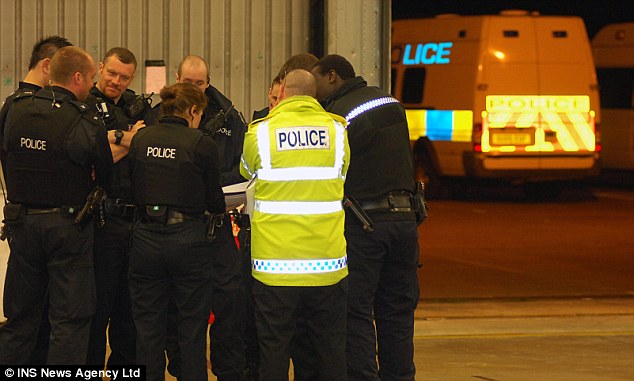 Last-minute preparations: Officers huddle round as they receive final instructions. Police believe the suspects carried out the alleged abuse for six years as the youngsters were sold for sex and even given drugs so they could be raped
Last-minute preparations: Officers huddle round as they receive final instructions. Police believe the suspects carried out the alleged abuse for six years as the youngsters were sold for sex and even given drugs so they could be rapedAmong those detained was a married father of two, aged 29, from the Cowley area of Oxford. A relative, who would not give his name, said: ‘The police came early this morning and arrested him. They would not say what he was arrested for. They said they were looking for evidence.’
Esther Davidson, from Oxford Community Against Trafficking, said: ‘We now have to face the fact modern slavery takes place in our community, and it involves children.
‘Yes, criminals are at work, but they are also exploiting demand. Demand for sex with under-age children is completely unacceptable.’
Sharon Highton, who runs the Include project at East Oxford Community Centre for youngsters who have been excluded from schools, said: ‘There is a huge problem with sex grooming in the area and social services are not taking any action. They seem to wait until something major happens before they intervene.’
Alleged members of the child sex ring were detained in a series of police raids early yesterday. More than 140 officers burst into the homes of gang suspects and their ‘customers’ in synchronised raids across Oxford at 6am and arrested 12 men. A thirteenth suspect was arrested.
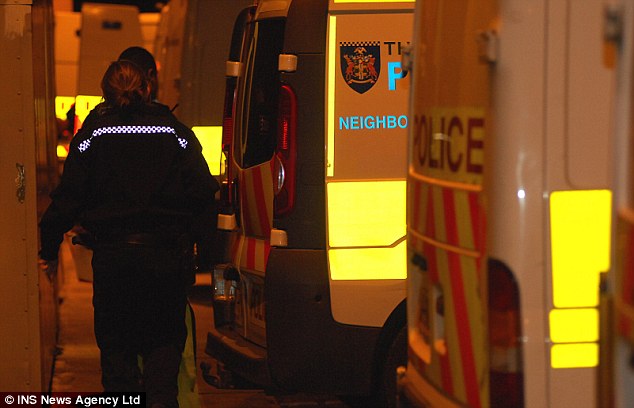 Protection: Detective Superintendent Rob Mason, of Thames Valley Police, said the arrests were intended to protect the girls from further harm
Protection: Detective Superintendent Rob Mason, of Thames Valley Police, said the arrests were intended to protect the girls from further harm‘The investigation involves a criminal gang who are selling young girls for sex,’ said Detective Superintendent Rob Mason. ‘These include people involved in the business of selling young girls, and their customers.’
Most of the victims, who cannot be identified for legal reasons, are from the Oxfordshire area. ‘It would be fair to say that at different times in their lives they have all come to the notice of children’s services,’ said Detective Superintendent Mason.
Police said they were being trafficked within the UK.
‘What we believe we have uncovered is a criminal gang getting financial profit from selling young girls and they are conveying them from Oxford to customers,’ he added.
‘We consider the girls to be very, very vulnerable and that’s why they have been targeted. The girls have gone missing and when they returned they have made certain disclosures.
‘Through children’s services and Oxfordshire County Council we have become aware of some of the activities the girls have been getting into when they’ve gone missing.’
The trafficking came to light when police began an investigation – codenamed Operation Bullfinch – looking at reports of girls going missing from their homes. The 13 suspects, aged between 21 and 37, were being interviewed at various police stations.
More than 40 uniformed officers and community support officers were yesterday handing out A5 flyers about the operation to reassure the public.
Detectives also posted a video on YouTube to reassure community members and urge any potential victims to come forward.
Stuart Craft, an Oxford councillor, said he had grave concerns about children’s services in the area. He added: ‘I would not be surprised if these exploited girls did not have any confidence in their social workers and that is why this has been allowed to go on for so long.’
Local councillor Mary Clarkson said: ‘Children in care have had a bad start to life and they need to be protected. I would be very upset if it came to light that this was a failing on the part of social services and will be calling for an investigation if these girls were not given the right protection.’
Councillor Louise Chapman, cabinet member for children, young people and families at Oxfordshire Council, said: ‘The council has assisted in what has been a complex investigation leading to today’s events. Its focus has been, and will continue to be, on the care for alleged victims.’
Last night, four of those arrested, aged in their 20s and 30s, were released on police bail while detectives continue there
Source: Daily Mail
Govenment Complacency about Child Trafficking
The link is to a story about child trafficking in Oxfordshire. Extracting from the start of the article:
Police swoop on paedophile gang accused of modern-day slavery of girls in care aged 11 'bought and sold' for sex
- More than 100 officers swoop on homes across Oxford yesterday
- Alleged victims as young as 11, many of whom brought up in care
- 'Groomed and given drugs so they could be raped by tormentors'
- Police chief: 'Arrests intended to protect girls from further harm'
I have been worried for some time about the number of children that are lost to the care system. These are children that leave care for "other reasons". Some of the reasons are reasonable (such as babies leaving with their mothers), but others are children being trafficked.
I asked a simple question of the government which was to keep better records so we knew what was happening to the children.
They refused see here
John Hemming: To ask the Secretary of State for Education if he will expand the destination codes in the SSDA903 return to identify when a child runs away from care or is abducted or trafficked. [82417]
Tim Loughton: The Department has no plans to expand the codes under which local authorities provide statistical returns on children missing from care, as this will lead to an unnecessary increase in reporting requirements. It is the responsibility of local authorities to safeguard and promote the well-being of children in care, and they will hold more detailed information on each child who has gone missing from their care.
This is in my view another sign of the government's dreadful complacency about the care system.
Source: John Hemming blog
Newborns Judge Character
March 23, 2012 permalink
Research published in the journal Pediatrics shows that newborn babies have the ability to judge the character of their parents. Any chance babies and toddlers might be able to judge social workers?
expand
collapse
Study Finds Newborn Infants Can Tell If Parents Are Losers
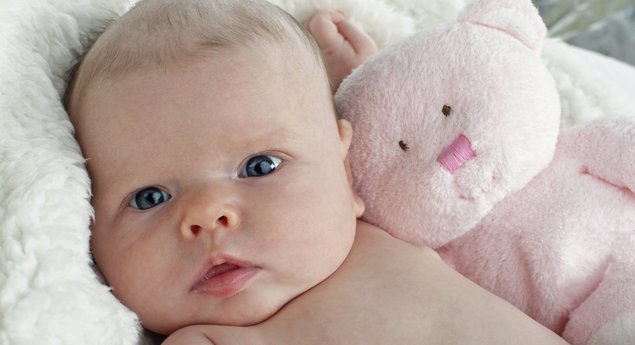
CHICAGO—A study published this week in the journal Pediatrics found that, within seconds of their birth, babies have the ability to sense whether their parents are losers. "From the moment they open their eyes, newborns can tell if their mother had no other options and was forced to settle for their father, or if their father is a sad sack who has no friends and gets drunk on a single glass of chardonnay," said researcher Dr. Stuart Lindstrom, explaining that despite their blurry vision, infants can still identify basic loser body types, and have specialized olfactory receptors allowing them to detect the odor of failure. "In fact, we've determined that as early as the second trimester, a fetus picks up on the income and social standing of its mother via the umbilical cord." The study also concluded that the screams of newborns stem from the sudden realization they will be stuck with their loser parents for at least 18 years.
Source: The Onion

Stratford Rally
March 21, 2012 permalink
A small group assembled in Stratford today to express their opinions of children's aid. The weather was unseasonably warm.
Photos: [1] [2] [3] [4] [5] [6] [7].
Source: Facebook, Catherine Frei
Susan Campbell It was great, not a big turnout, but we got our message across. A CAS Worker actually drove by and showed us the finger, at the same time as the Newspaper Reporter was there, real professional worker. We also all got a nice sunburn :) pretty nice weather for March, I would say!!
Source: Facebook, Canada Court Watch
Addendum: A press report.
expand
collapse
CAS protest
Members of Canada Court Watch Grey-Bruce and the Ontario Coalition for Accountability were in Stratford last Wednesday holding a small protest outside the Children's Aid Society office at the corner of Lorne Avenue and Downie Street. Group spokesperson Catherine Frei, of Waterloo, said they were aiming to raise awareness about issues surrounding the Children's Aid Society, including a lack of accountability and oversight, and the need for an ombudsman to handle complaints about the agency. Similar rallies have been held throughout the province over the last few years. Frei said response in Stratford was mostly positive, and many motorists honked to show their support or stopped to find out more about the cause.
Source: Stratford Gazette
Minister Not Aware of CAS Policies
March 20, 2012 permalink
Responding to a question in the legislature yesterday from Monique Taylor, the Minister of Children and Youth Services, Mr Eric Hoskins, said that his ministry was "not aware of a concerted policy to obtain babies for adoption from unmarried mothers".
expand
collapse
ADOPTION
Miss Monique Taylor: My question is to the Minister of Children and Youth Services. I know many in this House have read in recent weeks about the hidden tragedy of coerced adoptions in our province. Unmarried mothers were forced to give up their newborn children. I’ve spoken to some of those mothers, and let me tell you, the stories are heartbreaking. They were separated from their babies at the time of their birth and still live with the trauma of that experience to this day.
Will the minister meet with these mothers to hear their stories and help them uncover what happened to Ontario women in maternity homes?
Hon. Eric Hoskins: I want to thank the member opposite for her question, and I have been following coverage of this story very, very closely. I have to say, as a parent myself, these stories are extremely difficult to read, and I want to commend the women involved for showing the courage to speak out.
Mr. Speaker, it is absolutely paramount that all women have their rights protected when making an important decision such as adoption and that they’re provided with all the information they need and provided with that information in an unbiased fashion.
My ministry is not aware of a concerted policy to obtain babies for adoption from unmarried mothers. We are committed to supporting an adoption system in Ontario that emphasizes the rights of and the respect for children, birth parents and adoptive parents.
The Speaker (Hon. Dave Levac): Supplementary?
Miss Monique Taylor: The Salvation Army and the United Church were among those running maternity homes where these practices have taken place. They have committed to investigating what happened.
Will the minister also commit to following their example by ordering an investigation into past adoption practices in Ontario?
Hon. Eric Hoskins: Thank you again for that question. I want to reiterate that my ministry is not aware of any concerted policy to obtain babies for adoption from unmarried mothers. Our government has worked hard to strengthen transparency and accountability when it comes to adoption practices and adoption laws in Ontario.
Child protection in Ontario currently has a variety of independent and rigorous government-mandated oversights, reviews and systems of accountability, including such measures as the Child and Family Services Review Board, which has the authority to review certain decisions and complaints.
Our government is committed to a transparent and accountable system of adoption. In 2008, we introduced the Access to Adoption Records Act, Mr. Speaker, which was subsequently passed into law, so that adopted adults and birth parents may be able to receive more information contained in records —
The Speaker (Hon. Dave Levac): Thank you. New question?
Source: Ontario Hansard
We have no idea how many newborns are taken from Ontario's delivery rooms because of confidentiality laws. Only insiders, such as Mr Hoskins, have the ability to penetrate confidentiality to see the real numbers, and real policies.
But from the outside we have been able to show in these columns for years that Ontario's children's aid societies take around seven thousand children a year from their parents by force of arms. Most cases are the taking of children from single mothers. Some of them are seizing newborns in the delivery room. It is impossible to believe that the responsible minister is unaware of these facts and policies.
Kathryn Blaze Carlson continues her series on forced adoption with her reaction to minister Hoskins' statement: NDP MPP Monique Taylor ‘shocked’ at lack of response to push for coerced adoption probe

Privacy Demanded
March 20, 2012 permalink
Here is a new tactic developed by Chris York on behalf of an expectant mother. CAS had its eye on her, anticipating apprehending her baby at birth. Chris had her draft a letter to the hospital where she intended to give birth:
To Niagara Health System,
CAS/FACS is a private organization in Ontario and as such are not entitled to any information regarding any patient under the care of Niagara Health System without prior consent. Any breach of this notice and release of any information will be considered a direct breach of the privacy act and will be met with swift legal action.
According to Chris the hospital board immediately took notice of this and directed the delivery ward that they were not to notify anyone because of potential litigation. It would be violating the patients privacy and be in violation of the Privacy Act. But a nurse did violate the direction of the hospital board of directors and the is currently under investigation for this direct violation of the Privacy Act by the hospital board of directors. The baby was apprehended and as a result of my (Chris) attendance at court and speaking to the duty counsel an argument was made that gave the mom maximum visits between now and next court date and an order that the CAS MUST check into the kinship placement given and also must attempt to secure placement for the mom and baby in a maternity house program so that the baby can be returned to mom on the next court date.
Source: Facebook, Canada Court Watch
Fixcas suggests this tactic will work better when it comes from a family clearly able to hire competent counsel, even when the letter to the hospital uses more restrained language. If it catches on, expect the OACAS to run to the legislature with an amendment to the Privacy Act.
Take Your Medicine (or Else)
March 20, 2012 permalink
Michigan is demanding that nine-year-old Jacob Stieler undergo chemo-therapy for a cancer already completely eradicated, in spite of the fact that some of the prescribed treatments are not yet approved and have severe side-effects including inducement of new cancers.
expand
collapse
Michigan DHS Trying to Force Parents to Give Child Meds
In a prime example of what seems to be a pervasive endeavor across the nation to usurp parental rights, Michigan state officials have told a couple that the state has the power to prosecute them if they refuse to administer certain medications to their child.
Attorneys from the Home School Legal Defense Association (HSLDA) — an organization focused on parental rights cases — have come to the defense of parents Ken and Erin Stieler, after they refused to comply with state mandates to provide certain medications to their son Jacob.
When nine-year old Jacob was diagnosed with Ewing Sarcoma, a type of bone cancer, he underwent surgery to remove the tumor, as well as chemotherapy to follow up.
HSLDA chairman Michael Farris explained:
The treatment was incredibly difficult, and Jacob’s mom, Erin, told me that when she looked her son in the eyes, she knew in her heart that he simply could not survive many more rounds of these drugs.
The family then joined a prayer network to pray for their son’s recovery.
“After all of these rounds of chemotherapy were completed, there was a PET scan done to check on the status of the cancer. There was no evidence of cancer detected in Jacob’s body. Jacob’s family and friends rejoiced in his healing — praising God for this wonderful outcome,” Farris said.
Still, doctors continued to demand further treatment, and more rounds of radiation.
World Net Daily reports, “In what is being seen as a preview of a fully implemented Obamacare, government officials in Michigan are demanding that a 9-year-old child follow standard procedure and take a dangerous course of cancer medications that can cause additional cancer — even though the boy has had three scans indicating an absence of the disease.”
Regardless of the scans, the Michigan Department of Human Services has already filed suit to force parents to administer cancer drugs to their son.
Lower courts ruled against the Michigan Department of Human Service; however, the agency filed an appeal with the Michigan Court of Appeals, demanding that Jacob receive ifosfamide, etoposide, and doxorubicin for treatment — even as the U.S. Food and Drug Administration states that the safety and effectiveness of ifosfamide and etoposide “have not been established.”
And the FDA’s statement on doxorubicin's side effects is even more harsh: “Pediatric patients are at increased risk for developing delayed cardiotoxicity.”
Farris asserts that the entire mandate is unnecessary because Jacob’s previous treatments have rendered him cancer-free.
And even as the treatment being mandated by the state is not guaranteed to be helpful, or safe, the parents face potential charges of medical neglect if they refuse to comply.
On the HSLDA website, Farris wrote:
If they succeed they will force Jacob to resume chemotherapy despite the fact that the drugs in question are not FDA approved (either for children in general or for this particular cancer). Moreover, these drugs do not promise anything close to a guaranteed cure. And, the FDA requires the drug manufacturers to disclose that these drugs cause new cancers to form, heart disease in children, failure to sexually mature, and many other serious side effects in some cases.
The HSLDA reported that Jacob’s parents “begged the doctors to make an individual diagnosis, rather than simply following unbending standards. But the doctors were steadfast. All children with this cancer needed multiple rounds of these drugs — regardless of PET scan results, the doctors contended.”
Doctors then contacted Child Protective Services when the parents refused to comply. CPS refused to press charges, prompting the doctors to contact the state.
Farris asserts that much of the case rests on how safe and effective the drugs being mandated are for Jacob.
“ ‘Have all of these drugs been approved by the FDA as safe and effective for children?’ I asked Jacob’s treating oncologist,” Farris said. “‘Yes,’ she replied, they have been FDA-approved for children.”
But Farris said that the doctor was “flat wrong,” simply based on the inserts mandated by the government that describe the drugs and their complications. “In fact, as it turned out, the treating doctor had never even seen, much less read, these official FDA-required package inserts,” he reported.
The warning for the drug vincristine, for example, reads, “Patients who received chemotherapy with vincristine sulfate in combination with anticancer drugs known to be carcinogenic have developed second malignancies.”
Chemotherapy drugs have a number of side effects, according to Natural News, including damage to the kidneys, liver, and brain. Ironically, a side effect of chemotherapy is also cancer.
It is for these reasons that Farris observes:
This is not an easy case. It is not a case where a child has a current illness and the treatment is tested and proven to be safe and effective — those cases are easily resolved. The best evidence is that Jacob no longer has objective evidence of cancer. And not a single drug that the doctors want to give Jacob is FDA-approved for children for his kind of cancer.
Farris contends that a case of this nature is particularly difficult because it is highly discretionary:
The doctor told me during the deposition that she thinks that she should make the call — for every child in this situation. And she would give the same answer every time, rather than making an individual judgment. I can’t imagine a more clear case of the need for parental rights.
Jacob’s case highlights some of the greater concerns voiced by critics of ObamaCare. Michigan’s Department of Human Services is asserting that the drugs mandated for Jacob are in the “national standard of care” for his condition. World Net Daily reports, “That’s the same type of concern that has been raised by many organizations and individuals about Obamacare, which is to face arguments before the U.S. Supreme Court later this month.”
Farris maintains that overall, medical decisions for a child rest with the parents, not the state. Furthermore, he observes, this particular case is even more clear cut, as there is no clear and present medical danger.
When Jacob’s parents requested an individual evaluation for their son, they were reminded about the “standard” that the state must follow.
“If we are put in a position where national standards are established, whether by practice or the government, it comes out the same,” Farris said.
A trial judge already dismissed the case of medical neglect against the family, but Farris contends that the bigger issue is “the ability of parents to make medical decisions contrary to the views of doctors.”
“This case may well shape parental rights principles for the long haul. We believe that parents, not doctors, should make tough decisions like this,” Farris stated.
Mike Adams of Natural News asserts that this is a case of “gunpoint” medicine, which he describes as “medicine administered at gunpoint by the government.” He even called it “government-sponsored medical terrorism,” concluding, “A system of medicine that requires enforcement at gunpoint is not medicine at all. It is coercion and torture.”
Source: New American
Family Destroyed
March 20, 2012 permalink
In the struggle in Norway to seize the children of a young Indian family, the stress of the child protection case has led to separation of the parents, Anurup and Sagarika Bhattacharya. So Norway social services can now plead that the children no longer have a family to return to. A success for social services achieved through shotgun divorce. Previous stories: [1] [2] [3].
expand
collapse
Norway child custody row: parents’ fight comes out into the open
Ahead of court hearing on March 23, children's father shifts blame to his wife
Given the rapidly unravelling sequence of events within the family in question, Indian diplomats who have left New Delhi for Oslo to resolve the ongoing custody crisis involving Abhigyan (3) and Aishwarya (1), taken into care by the Child Welfare Service (CWS) in May 2011, may have a tough time getting the compromise agreement between India and Norway work, it became clear on Monday. Battle-lines between the children's young parents, Anurup and Sagarika Bhattacharya, were hardening over the weekend. The father has now virtually given a clean chit to the CWS and put the blame on his wife for what had been going on.
The diplomats sent to Norway by External Affairs Minister S.M. Krishna are to oversee the transfer of custody of the Bhattacharyas' children from the parents to the paternal uncle, Dr. Arunabhash Bhattacharya. The dental surgeon from Kolkata is considered by the CWS as “fit, capable and responsible enough to shoulder the burden” of caring for children, one of whom has been described as “severely damaged.” But the newly revealed acrimony between the couple could yet derail the process.
The relationship has deteriorated to such an extent that the two have come to blows. Mr. Bhattacharya said his wife had attacked him – hitting him and clawing at his face, hands and legs in the early hours of March 19. On Monday morning, he met the chief of the Stavanger CWS to seek help, apparently determined not to continue with the pretence. Mr. Bhattacharya moved out of the apartment he shared with his wife.
Mr. Bhattacharya's allegations are upsetting and sensational. “This is not the first time this has happened. Sagarika has assaulted me many times before. You can find all those details in the dossier. But this time she created a massive commotion and physically assaulted me. The noise was so great that the neighbours came and my wife told them I was hitting her! If I concealed the seriousness of Abhigyan's and our family's problems it was because I thought that was the only way we could get our children back. But I now realise that was a mistake and I should have spoken the truth right from the start.”
“It was not just cultural bias that prompted the CWS to act. My wife has a serious psychological problem. She is extremely immature, like a teenager really, and all this media attention has gone to her head. I tried to protect her and do her bidding. But last night was such a shock that I have now moved out and am seeking a legal separation,” Mr. Bhattacharya told The Hindu.
In fact, this correspondent received a phone call in Paris at 3 a.m. on March 19 from Arunabhash, the panic-stricken brother of Mr. Bhattacharya, seeking help. He was advised to contact Rahul Tiwari, a geophysicist with Total in Stavanger, who knows the family well. Mr. Tiwari apparently managed to call Ms. Bhattacharya and calm her down. But he told The Hindu it was extremely difficult because she was “shouting and in an almost hysterical rage.”
Attempts to contact Ms. Bhattacharya failed; her telephone had been switched off.
Mutual suspicion between the two sides now runs deep: Mr. Bhattacharya was advised to have the scratch marks and bruises on his body photographed — in case he was eventually accused of wife-beating.
Arunabhash, who has been visiting the children in the kindergarten and with the foster-parents, says the children have made remarkable progress since they were taken into care. This fact was confirmed by the Stavanger CWS chief, Gunner Toresen. “Every time I see Abhigyan play and laugh, my heart wells over with joy. He's so happy here. And then I get worried because I don't know how much support I'll get in India. If Sagarika's family comes to our home to take away the kids, what will I do?” the desperate uncle asked this correspondent.
India has put much pressure on Norway to hand over the children, accusing the CWS of cultural bias. But the CWS had all along insisted that the children were removed because they were victims of parental neglect and that the older child had serious psychological or neurological issues. Both were “damaged children,” the CWS has contended.
How all this pans out on March 23 when the court is to hear the case, will become clearer in the days ahead.
Source: The Hindu
It only took two days. After Norway created stress breaking up the family, they are using that break-up as their reason for keeping the children.
expand
collapse
Norway 'not to release' India children in custody row
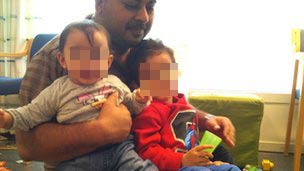 The children were put into foster care by Norwegian child services last May
The children were put into foster care by Norwegian child services last MayA child welfare agency in Norway has said it cannot hand over the two Indian children taken into foster care to their uncle because of reports of "conflicts" in the family.
A Stavanger District Court hearing planned for Friday to decide the fate of the children has also been put off.
This followed media reports of "marital problems" between the parents.
Local social services say the parents failed to look after their children. The parents deny this.
The couple, Anurup and Sagarika Bhattacharya, say "cultural differences" led to the situation.
On Wednesday Indian diplomats also put off a trip to Norway to monitor the court case for the custody of the children.
Recently the child welfare agency had said that custody of the children should be awarded to their uncle.
A statement issued by Stavenger City Council said "new developments in the child welfare case involving two Indian children make it impossible to carry out the hearing in Stavenger district court that was scheduled for 23 March".
It quoted Gunnar Torensen, chief of the city's child welfare services, as saying that the "conflict" in the family "could influence the outcome of the case".
Mr Torensen said the child welfare service is "aware that there is great deal of external pressure on the family, and that makes it difficult for them to agree on a clear position".
"In light of the great uncertainty that prevails now, the child welfare servce cannot maintain that a move to India would be in the best interests of the children," he said.
Three-year-old Abhigyan and one-year-old Aishwariya Bhattacharya were put in foster care by the Stavanger Child Welfare Service last May, because they felt the children were at risk.
The case has received a lot of media attention in India and caused anger. Earlier this year the government decided to intervene and try to bring the children back to India.
This became a diplomatic issue between the two countries, with India saying the children should be allowed to live in their own cultural and linguistic environment.
But latest media reports have highlighted the "marital problems" between the parents and said this has complicated the case for the government.
Source: BBC
Family Erased
March 19, 2012 permalink
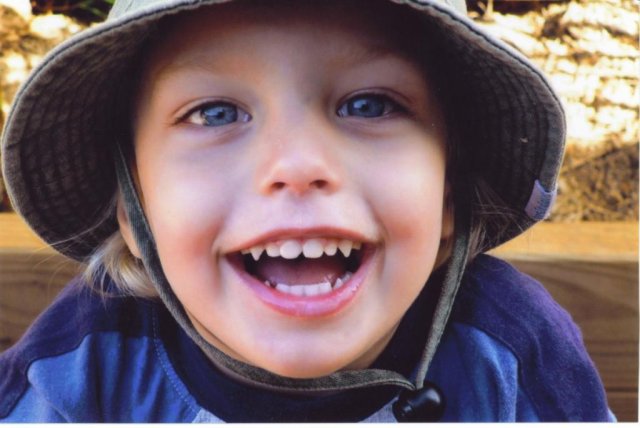
Three years after Luke Borusiewicz, age 2, died in the custody of Australian child protectors, not only does his father have no answers about the death, but his own name and face are eradicated from the public domain.
expand
collapse
Grieving dad just wants answers
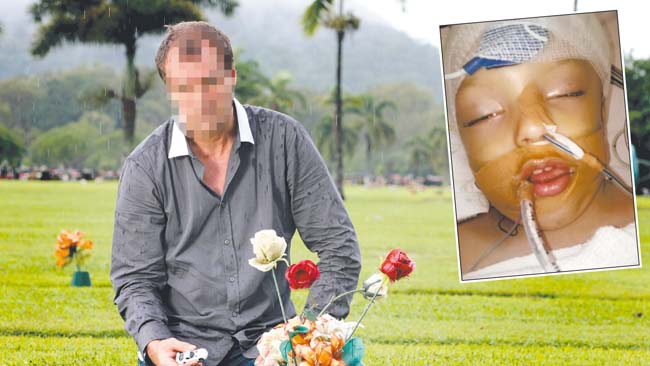 TRUTH QUEST: Michael, the grieving father, lays flowers in memory of his infant son, who allegedly died from injuries while in care. Source: The Cairns Post
TRUTH QUEST: Michael, the grieving father, lays flowers in memory of his infant son, who allegedly died from injuries while in care. Source: The Cairns PostLITTLE Luke has been dead longer than he was alive - but his father Michael is still trying to find out how and why he died.
The blond, blue-eyed boy was just two years and four months old when he died in his father's arms in hospital in January 2009.
He had been in a coma for six days after being admitted with head injuries suffered while in foster care.
More than three years later, Michael is still waiting for answers about what happened.
Northern Coroner Kevin Priestly has opened an inquest, but no date has yet been set for a hearing.
Six months ago, after criticism over other cases, Child Safety Minister Phil Reeves said he was seeking to have the results of child death case review committee reports released publicly. But the Department of Communities last week refused a Sunday Mail request for the report on Luke's death because it believed it could prejudice an inquest.
Court orders mean we can't even tell you their surname or show you their photographs without disguising them. The heart-broken Cairns father says he is determined to get the full facts and is calling for an inquiry into the child protection system.
"This is my reason for living now," he said.
On the day of his son's funeral, Michael called child support workers and told them: "I'm looking at my boy - he's in his coffin. I just rang to say 'I'm coming for youse'."
Luke was taken into care because both his parents had been drug users, although Michael says he was clean and holding down a full-time job for six months before Luke died.
Meanwhile, State Coroner Michael Barnes is still considering whether to reopen inquests on two girls who apparently killed themselves within weeks of each other in 2009.
The state's child death review committee criticised child safety officials and police over the deaths of 16-year-olds Zoe Gough and her friend Felicia Goodson, both from Maryborough.
The Australian newspaper said the report on Felicia's case found that "inaction" by Child Safety Services after repeated disclosures of sexual abuse and requests for help were directly related to her suicide.
In Zoe's case, the report found that the department was not ultimately responsible for her death, but highlighted systemic failure to protect her.
She had been in and out of care for nearly a decade. A spokesman for the State Coroner said he was "awaiting information from agencies" before making a decision.
Source: Courier-Mail
Spanking
March 19, 2012 permalink
While spanking is de facto outlawed for parents by the child protection system, it continues in schools. NPR reports. Here is an audio local copy (mp3).

Secret Shame
March 19, 2012 permalink
Ted Korol was in these columns in December 2010 when he spoke to the CBC. Last year he produced a report on child welfare from an insider's perspective. Some quotes from social workers in his report:
I remember I must have been about six years old when we first got our television. The first commercial I can remember was a commercial on UNICEF. I remember running to my mother telling her we had to help and feed those children. From that day on I knew all I ever wanted to be was a social worker. Even in my play I pretended I was a social worker. For a time in my adult life I considered other career paths but they just weren't right. I finally became a social worker, I had made it. I worked with different community based organizations and it seemed I was always advocating on behalf of families against the Ministry. I finally decided that I should try working from inside the system. I joined the Ministry and worked in protection. It was brutal! The system was so opposite of what I was as a social worker, opposite to what social work was supposed to be. It was even a shocker to see that the Ministry conducted itself in a manner opposite to how the Ministry policy people taught us to be. We were always behind, worn down, there never was a feeling of accomplishment. The Ministry is so crazy making and bizarre!
I was reviewing some concerns relating to a 1st Nations child who was in the care of the Ministry for a number of years. Much to the chagrin of the manager (who was having trouble understanding and explaining policy to me) I discovered that the child was still in care months after the court ordered the child to be returned to the child's kin. It was also clear that the Ministry had no legal authority to hold this child in foster care over the last few months. I raised it with the manager who immediately acknowledged the fact and replied we could draw up the appropriate documents and backdate them. When I raised my concern that such action would be unethical, unlawful and quite possibly fraudulent the manager shrugged it off stating "we do it all the time."
After a child death occurs, an internal report from the Ministry may take up to two years to be finalized and published. I have reviewed instances like this and I find the delay appalling. Furthermore, the Children's Advocate Office has an agreement with the Ministry that it will not begin their investigation until the Ministry's report is concluded. All the while the parents are languishing in their grief and despair, not knowing what happened. All the while witnesses and evidence are disappearing, the public is forgetting what happened and children remain at risk for a cause not reported and corrected.
We found Korol's report at The Secret Shame: Saskatchewan Child Welfare. Here is a local copy (pdf)
Psychic Social Worker
March 19, 2012 permalink
A psychic has found the career to make use of her skills: social work.
expand
collapse
Abby: Social worker looks for best way to use her psychic gifts
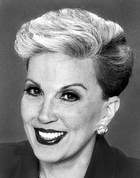 Dear Abby: Abigail Van Buren, aka Jeanne Phillips
Dear Abby: Abigail Van Buren, aka Jeanne PhillipsDear Abby: I will graduate from college in June and be a social worker. I am psychic, although I dislike that word because it conjures up visions of crystal balls, quacks and scams. For legitimate psychic individuals, it can be overwhelming to live this way.
I first noticed my ability when I was young, but I repressed it because my folks thought I was imagining things. It began to resurge in college. This school is haunted, so I have become used to daily interactions with ghosts -- often in the dead of night. I also notice that during client counseling sessions images will pop into my head. I once gave a classmate the "willies" by perfectly describing the garden in her backyard having never laid eyes on it. My adviser says I must never tell my clients the things I "see" in them because it will frighten them.
It's hard to separate my own thoughts and emotions from those of spirits around me. I'm concerned about my psychic ability in relation to my clients. If I pick up on abuse in the mind of a child, for example, am I obligated to report it?
Being psychic is as natural to me as my having blue eyes. It will never go away. I must now find the means to manage it. I don't want a career as a medium. I'm dedicated to the profession I have chosen. Can you offer me advice? -- Gifted In New York
Abby: Instead of using your visions to form JUDGMENTS about your clients, use them to guide you during interviews. If you do, you will then be better equipped to provide concrete proof of the need for an intervention than revealing you "saw" something that others can't see or wasn't disclosed to you.
Many people have psychic abilities to a greater or lesser degree than you do, and those "vibes" can be invaluable. It is possible that your gift will give you insight into the individuals you will serve. I wish you success.
Source: thetowntalk.com

Alberta Class Action
March 17, 2012 permalink
A class-action lawsuit on behalf of Alberta foster children is approaching a legal deadline. Class members who do not wish to be included have until May 4 to opt out.
expand
collapse
Plaintiffs have until May 4 to opt out of foster child suit
A long-running class-action lawsuit suing the Alberta government on behalf of foster children is nearing another milestone on its long legal road. Public notices appeared across Alberta this week telling potential plaintiffs of an approaching May 4 deadline to opt out of the lawsuit.
The suit is being launched on be-half of children taken into care by provincial authorities between July 1966 and Feb. 2008.
One of the lawyers behind the action estimated as many as 20,000 people could be eligible to join.
The suit isn't claiming abuse com-mitted while children were in the care of provincial authorities.
Rather, the lawsuit alleges provincial authorities were negligent for not pursuing civil damages or restitution on behalf of children who suffered sexual abuse or physical injury at the hands of others prior to being taken into care.
"This lawsuit is for everybody who could have had a lawsuit or could have applied for victim-of-crime compensation," said Edmonton lawyer Robert Lee.
The suit began with a statement of claim filed in 2004 by a 39-year-old woman who now lives in Calgary.
She is one of three plaintiffs who now represent the class of victims, however large it may become.
The upcoming deadline is to al-low anyone who wants to sue the government as an individual to drop out of the class-action suit.
Source: Calgary Herald
Call for Insiders
March 17, 2012 permalink
Attila Vinczer Canada Court Watch is seeking information from CAS workers about the inner workings of Children's Aid Societies in Ontario. Please contact us with any information you may have exposing anything that occurs within the CAS that is of concern. Your identity will be protected and never revealed. Thank you.
Source: Facebook, Canada Court Watch
Some of the information on fixcas is also the result of conversations with CAS workers, though no confidential CAS workers have ever been named here. You can also help expose CAS actions by phoning fixcas confidentially at 705-744-6274 or email to [ rtmq at fixcas.com ].
No Apology
March 17, 2012 permalink
Here is a pattern seen several times before by fixcas in cases not reported on the web. A Burmese family in Winnipeg took their child to a hospital where an x-ray revealed a broken bone. Child protectors seized the children. When the doctors corrected their interpretation to say there was no broken bone, child protectors refused to return the children for a month. (In other cases it is much longer). Adding to the injury in the Winnipeg case, the family spoke only the Karen language, and there was no interpreter to explain to them why the children were being removed. Manitoba CFS has refused to apologize to the family for the unjustified detention of their children.
expand
collapse
Winnipeg Free Press - PRINT EDITION
Don't expect big apology after family torn apart
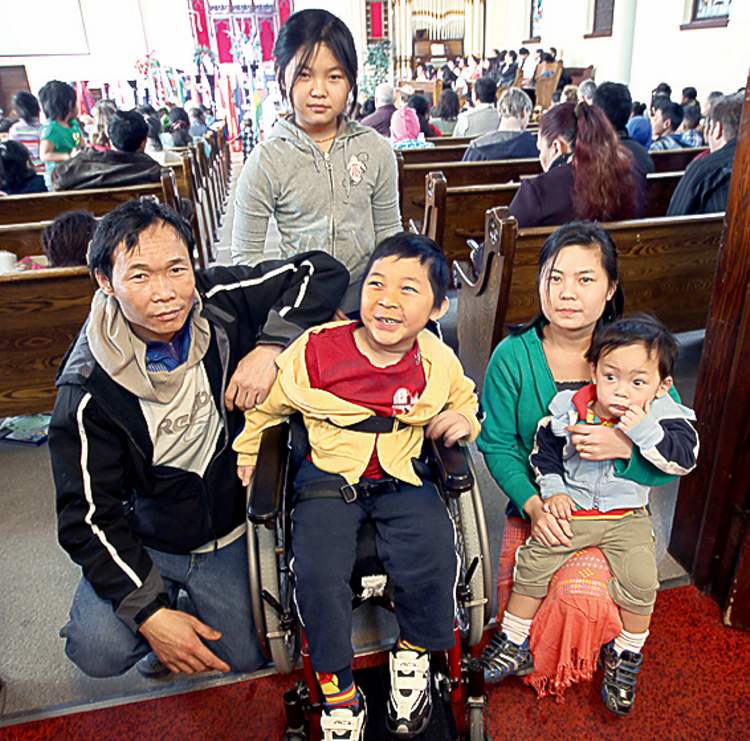 JOE BRYKSA / WINNIPEG FREE PRESS ARCHIVES Shwe Le Say (left) and K�dah Ra Wah with children Blessing (in wheelchair), Buna (rear) and little Thaena.
JOE BRYKSA / WINNIPEG FREE PRESS ARCHIVES Shwe Le Say (left) and K�dah Ra Wah with children Blessing (in wheelchair), Buna (rear) and little Thaena.A family of Burmese refugees waiting for a meaningful apology from Child and Family Services for wrongly seizing their children and refusing to return them in a timely manner is out of luck.
K'dah Ra Wah and Shwe Le Say's three children were apprehended on June 15, 2010, after a Health Sciences Centre employee misread an X-ray, leading child-protection authorities to believe the couple's five-year-old paraplegic son had a broken scapula. Abuse was suspected.
Although the allegation was quickly disproved, it would be a month before CFS returned Blessing, 5, Buna, 8, and Thaena, a nursing infant.
There was no language translator provided when the children were taken. The couple, who speak the Karen language, thought the government had kidnapped their children. The workers left in such a hurry they didn't take Blessing's wheelchair or his medication. No letter was left by the agency to explain why the children were taken.
Jay Rodgers, CEO of the General Child and Family Services Authority, maintains HSC deserves the majority of the blame in the case.
HSC officials met with the family and their Canadian advocates on April 8, 2011, and apologized for their role.
Hospital staff tried to right the wrong from the start. On June 18, 2010, Dr. Elske Hildes-Ripstein, HSC head of pediatrics (and Blessing's pediatrician), sent a letter to the parents and to the CFS workers assigned to the case.
She said she and her staff had no concerns about the child's safety. More letters from medical professionals followed, all of them supporting the family.
Still, CFS kept the children. They were not returned to their shattered parents until July 14.
Rodgers said the decision was made based on a June 29 letter sent to CFS by Dr. Charlie Ferguson, director of the child protection branch. The letter clearly says the final X-ray report revealed Blessing did not have a scapula fracture. He added:
"No suspicions were ever held that the parents of this boy inflicted his injuries."
The family and their supporters have always seen this letter as vindication. CFS saw it differently. Because Ferguson went on to speculate there may (he underlined the word) be other factors at play in the home, they kept the children. Ferguson wondered if Blessing's mother was depressed, if the young daughter was doing any or all of the mothering and whether the father was away a lot.
"The actions of the agency, based on the information they had, I think were warranted," Rodgers said.
Sue Burak, an advocate for the family, is outraged.
"If these were their suspicions, why didn't they tell the family? Why didn't they come to the house to investigate?"
A family advocate met with CFS officials on Nov. 23, 2010. The family was not asked to attend, nor were they told an investigation into their case was underway. Repeated family requests for information and updates from CFS went unanswered.
As a result of this case, CFS bumped up their efforts to communicate with non-English-speaking families. They've developed a multilingual one-page document to be left when children are seized from non-English-speaking parents.
CFS hasn't notified the family its investigation is complete, nor have they set up the meeting where Rodgers says he will explain the agency's position. He'll apologize for what he calls a "hairy" situation and explain where the true fault rests.
Last month, Rodgers said it would be appropriate to return children more quickly when there is evidence no abuse occurred. To the best of his knowledge, no CFS employee was reprimanded for their handling of the case.
CFS was right to take these children. You've got a paraplegic child with a suspected scapula break. There's a six-week-old baby and a little girl in the house. Those kids need to be in a place of safety.
But when it becomes rapidly, abundantly clear there has been no abuse, the agency must return the children. Delaying that process and ignoring entreaties for information by the family and its supporters is unconscionable.
Point all the fingers you want. This family was savaged by our child-welfare system.
Source: Winnipeg Free Press
Professional Expert Disqualified
March 17, 2012 permalink
Further to the story of professional experts, Britain is moving to revoke the credentials of Dr George Hibbert, who condemned hundreds of parents as unfit.
expand
collapse
The doctor who broke up families: Psychiatrist who damned hundreds as 'unfit parents' faces GMC probe
- Dr George Hibbert could be struck off over his conclusions that hundreds of parents had ‘personality disorders’
- Millionaire is now being investigated over shocking suggestions he distorted the assessments to fit the view of social services
- Lib Dem MP writes to Justice Secretary Ken Clarke demanding a full parliamentary inquiry
 Extraordinary: Dr George Hibbert faces claims he deliberately misdiagnosed parents with mental disorders - decisions which meant their children were taken away from them
Extraordinary: Dr George Hibbert faces claims he deliberately misdiagnosed parents with mental disorders - decisions which meant their children were taken away from themA leading psychiatrist faces extraordinary claims he deliberately misdiagnosed parents with mental disorders – decisions which meant their children were taken away from them.
Dr George Hibbert faces being struck off over his conclusions that hundreds had ‘personality disorders’ after assessing them at his private family centre.
He was paid hundreds of thousands of pounds by social services for the reports which tore children from their parents – many of them young mothers.
He is now being investigated over shocking suggestions he distorted the assessments to fit the view of social services.
In one case, he is alleged to have wrongly diagnosed a ‘caring’ new mother – named only as Miss A – with bipolar disorder because her local authority wanted the baby adopted.
After being confronted with this allegation, Dr Hibbert offered to surrender his licence to practise as a doctor rather than face a General Medical Council inquiry.
But his request has been rejected by the GMC which says there are still ‘unresolved concerns regarding his fitness to practise’. He will now face a full fitness to practise hearing.
Yesterday John Hemming MP, who has raised concerns about Dr Hibbert in Parliament, described the claims as shocking.
The Lib Dem MP – alerted by a whistle-blower – said he had since spoken to ‘three or four’ other families who said the same had happened to them.
He has written to Justice Secretary Ken Clarke demanding a full parliamentary inquiry.
Mr Hemming said: ‘He is someone about whom a number of people have complained. I am told that at least one person has refused to work for him because of what she saw as his unethical provision of reports to suit the demands of local authorities.
 Rich: Two Porsches can be seen parked outside the home of Dr Hibbert near Swindon. He is worth more than £2.7million
Rich: Two Porsches can be seen parked outside the home of Dr Hibbert near Swindon. He is worth more than £2.7million‘Much of the decision making in care proceedings rests on reports from experts such as Dr Hibbert,’ he told Parliament.
He added that supposedly independent experts such as Dr Hibbert, 59, were often little more than ‘the hired gun of the local authority’.
The lack of transparency over such experts was leading to ‘thousands of miscarriages of justice in care proceedings’.
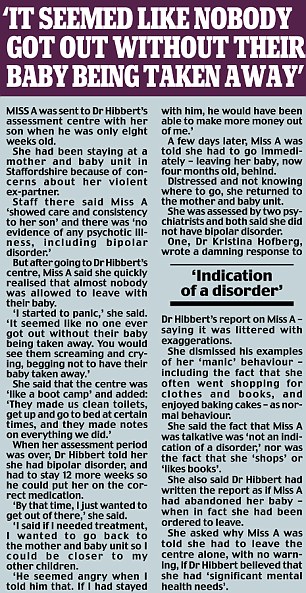
Earlier this week, a study for the Family Justice Council revealed how life-changing decisions about the care of children are routinely being made on the basis of flawed evidence. A fifth of ‘experts’ who advise the family courts are unqualified.
Dr Hibbert charged local authorities £6,000 a week for every family in his care and £210 an hour just to read documents such as medical records.
By 2007 his company, Assessment in Care, was making a profit of around £460,000 a year from his lucrative arrangement with social services.
He is now worth more than £2.7million. Last night a black Porsche Turbo, thought to be worth around £120,000, and a grey Porsche 911 Carrera, worth around £80,000, were parked on the gravel driveway outside his £500,000 country cottage.
A former honorary lecturer at Oxford University, who has previously advised the government on care assessments, Dr Hibbert left the NHS to set up his private assessment centre in 2000.
Since then, hundreds of parents in contact with social services – usually mothers and babies – have been referred to his centre to be assessed.
Concerns were first raised in 2007, when mother Miss A complained that Dr Hibbert had wrongly diagnosed her with a bipolar disorder.
One consultant psychiatrist accused Dr Hibbert of having ‘no evidence’ for some of his claims and of deliberately ‘exaggerating’ and ‘misrepresenting’ aspects of the woman’s behaviour.
Her report is among a number of documents being examined by the GMC with regards to Dr Hibbert.
Miss A, who has seen her son just a few times since, said Dr Hibbert was ‘corrupt and evil.’
‘Nothing will ever make up for what he has done to me and my child,’ Miss A said. ‘I want to make sure this man is exposed and that he can never do this to anybody else.’
In a letter sent to Miss A, a GMC investigations officer confirmed Dr Hibbert ‘has now applied for voluntary erasure from the medical register’.
The letter continued: ‘He has no intention of returning to clinical practice in the future.’
However, the GMC officer concluded it was in the ‘public interest’ for his request to be denied ‘in view of the nature of the performance allegations and in the view of the conduct concerns.’
He has not been available for comment at his two-storey detached cottage in the small village of Blunsdon near Swindon. His assessment centre next to his home appeared to be closed.
A spokesman for Dr Hibbert at the Medical Protection Society, the indemnity organisation for doctors, said professional confidentiality meant Dr Hibbert was ‘unable to comment on allegations raised in relation to care of a patient’.
Paul Grant, of Bernard Chill & Axtell Solicitors, who represents Miss A, said: ‘Our client has instructed us to launch proceedings against Dr Hibbert and the local authority.
‘We believe this distressing case may be the tip of a very big iceberg.’
Source: Daily Mail
Christopher Booker writes on professional experts.
expand
collapse
Dubious 'experts' are paid to tear families apart
A new report condemns the shoddy standards of psychologists' reports in our family courts.
 Many mothers have been declared unfit on the strength of 'very poor' psychologists' reportsPhoto: ALAMY
Many mothers have been declared unfit on the strength of 'very poor' psychologists' reportsPhoto: ALAMYA long overdue scandal hit the headlines last week when a semi-official report exposed one of the murkiest corners of our child protection system – the way that supposed professional “experts” help social workers to remove children from their parents.
A study by Professor Jane Ireland, a forensic psychologist, for the Family Justice Council examined 126 psychological reports trawled at random from family court documents. It found that two thirds of them were “poor” or “very poor” in quality; that 20 per cent of their authors had no proper qualifications; and that no fewer than 90 per cent of the authors were not practising psychologists but appeared to earn their livings, wholly or partly, from writing reports for social workers. Already one psychologist, whose company has made nearly half a million pounds a year from such reports, is under investigation by the General Medical Council.
The picture Prof Ireland conveys is one with which I am only too familiar. I have seen how families can be torn apart largely on the basis of highly dubious psychological evidence designed, as John Hemming MP puts it, to “suit the demands of local authorities”. One mother lost her children, for instance, on the basis of a 235-page report, costing £14,000, which found that she was “likely to have a borderline personality disorder” – without the author ever having met her.
Another woman was found by a psychologist to be “a competent mother” – so the social workers went to a second witness, who found the same. They then commissioned a third, who at last came up with what they wanted: that the mother had, again, “a borderline personality disorder”. On that basis, her three children were sent for adoption.
A married couple lost their daughter because the father, who had had four “psychological assessments”, saw no reason to submit himself to a fifth. The Court of Appeal found that he seemed to be putting his “emotional needs before those of his child”, and ordered that the child be adopted.
Damning as Prof Ireland’s report is, her remit was only to look at psychological assessments. An equally disturbing picture might emerge from examining other groups of medical “experts” who earn thousands of pounds from evidence which parents may not be allowed to challenge or even read.
One contentious area, for instance, is where parents are accused of having injured infants who are found to have small fractures to their bones. A fashionable theory, pioneered by a Dr Kleinman in the US, holds that such fractures are a sure indicator of “non-accidental injury”, ie the child must have been abused. In one case (which I was able to report last year because the judge, unusually, published his judgment) it was clear that all the four medical witnesses had supported this “Kleinman theory”, unquestioningly accepted by the judge.
But other experts strongly disagree, citing studies which suggest that such fractures may quite often arise naturally from a deficiency of vitamin D (as tests had shown was the case with this particular mother). When I showed the judgment to a doctor expert in this field, he immediately recognised three of the witnesses as doctors who “go round from one court to another to support the Kleinman theory”. Since no one was in court to challenge them, the heartbroken mother – like many before her – lost her son.
Several scandals have hit the headlines in recent years involving doctors struck off after making a reputation as witnesses, pushing some theory about “brittle bones”, “shaken baby syndrome” or “Munchausen syndrome by proxy” which was eventually exposed as fallacious. But these causes célèbres have centred on criminal courts, where evidence can be put more rigorously to the test than is required by the much laxer procedures of family courts. As I have observed before, once a court system is allowed to hide itself away behind a wall of secrecy, the chances are high that it will become corrupted. A perfect example is the role played in our family courts by many of these professional “experts”. The good work Prof Ireland has begun cannot be allowed to stop there.
Source: Telegraph (UK)
Addendum: More on Dr Hibbert.
expand
collapse
The doctor who took my baby away
As Dr George Hibbert, an 'expert’ child-care psychiatrist, faces being struck off, we talk to one mother who was labelled unfit, while a whistle-blower gives an insight into his unconventional methods
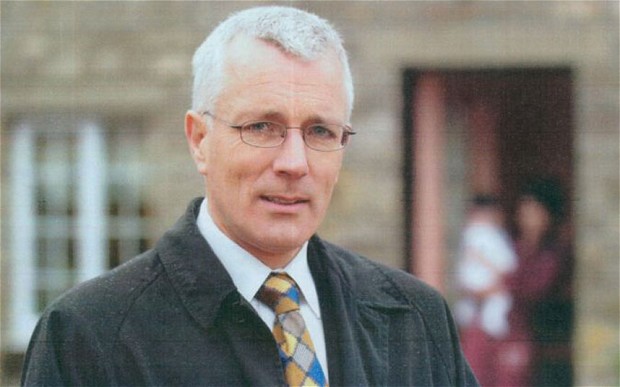 Dr Hibbert faces being struck off by the General Medical Council following claims that he misdiagnosed many of his patients with mental disorders and tailored his conclusions to suit the view of the relevant social services departmentsPhoto: SWINDON ADVERTISER
Dr Hibbert faces being struck off by the General Medical Council following claims that he misdiagnosed many of his patients with mental disorders and tailored his conclusions to suit the view of the relevant social services departmentsPhoto: SWINDON ADVERTISERBy Patrick Sawer, 7:00AM BST 01 Apr 2012
"I miss my daughter so much when I’m not with her,” says Maria, staring longingly at a photograph of the pretty three‑year-old. “People who’ve seen me with her know I’m a good mother, but what Dr Hibbert said about me meant that I wasn’t allowed to keep her.”
The 36-year-old is talking about Dr George Hibbert, a controversial psychiatrist whose damning verdict on her character and personality resulted in Maria (not her real name) losing custody of her only child.
Maria’s story raises disturbing questions about the power one man could exercise over those he judged to be unfit parents. Between 2000 and 2010 he was commissioned by social services departments throughout England (who paid him around £6,000 per case a week) to determine whether the parents referred to him were fit to keep their children. As a result of his reports, dozens of children were separated from their mothers or fathers.
But in a sudden turn of fortune, Dr Hibbert, 59, now faces being struck off by the General Medical Council, following claims that he misdiagnosed many of his patients with mental disorders and tailored his conclusions to suit the view of the relevant social services departments. And it is indicative of the doubts being raised over Dr Hibbert’s methods that his assessment that Maria was suffering from mental health problems – which led to custody of her child being given to the father – was later contradicted by an eminent psychiatrist, who concluded that there was no evidence she was an unsuitable parent.
“If it wasn’t for Dr Hibbert, I could still be with my baby,” says Maria. “It has been terrible. Being without her, and only seeing her for short periods, is very upsetting. I feel so sad whenever I have to say goodbye. I miss her very much.”
The controversy surrounding Dr Hibbert comes at a time of growing concern over the activities of child‑care experts on whose opinion courts rely to determine whether a parent is a fit and proper person to bring up their own child. Only a few weeks ago a report by Professor Jane Ireland, a forensic psychologist, warned that decisions about the future of thousands of children are being based on flawed evidence from well-paid “experts”.
Maria, who is originally from South America and whose identity cannot be revealed for legal reasons, is a domestic worker in Oxfordshire. A naturally emotional woman, her tough life experiences have left her with a deep distrust of authority figures, and she has often – to her own detriment – clashed with social workers and those with influence over her child’s future.
Social workers originally become involved after Maria suffered a period of postnatal depression following the birth of her daughter in May 2009. She then entered into a dispute with the father of the baby over custody. The couple were estranged and their relationship had been troubled, at times violent.
Oxfordshire County Council referred her to Dr Hibbert because they believed her to be impulsive, volatile and unable to prioritise the needs of the child.
Maria was sent to the Windmill Hill Centre near Cricklade, Wiltshire, one of two residential family centres run by Dr Hibbert, the other being Tadpole Cottage outside Swindon. She was one of hundreds of parents sent there over the years, who spent up to 14 weeks at a time having every aspect of their behaviour and interaction with their children monitored and recorded as part of their assessment. The opinion of Dr Hibbert – who trained as a psychiatrist in Oxford and worked in the NHS for 20 years before setting up in private practice – was key in deciding whether a child should be allowed to stay with its mother or father.
As part of their assessment, Maria and the other parents were set a number of weekly challenges. These included doing a large supermarket shop for about 14 residents and staff and involved loading and manoeuvring two heavily laden trolleys while simultaneously looking after their child. Another “challenge” required the parent to vacuum the stairs at the centres while holding their child.
But the tyre-changing exercise was the one Maria and the others dreaded most. This required the parent to wait until it was nearly time for the baby to be fed before driving into the country, accompanied by an assessor. Once in an isolated spot – by which time the child would, in all likelihood, have started crying for a feed – a “breakdown” would be staged. The parent would then be required to change the tyre while looking after the increasingly fractious baby. The challenge was designed to observe the parent’s interaction with their child in what was undoubtedly a stressful situation.
“I’d never changed a tyre before in my life,” says Maria, “but fortunately my baby was only whining a bit, so I could go back and forth from her to the tyre, comforting her and then working on the wheel. I managed to change the tyre and drove the six miles back to the centre to feed her.
“The stair-vacuuming task I passed easily, too, carrying my baby in one arm and hoovering with the other,” she continues. “But one poor 17-year-old girl failed. She was really upset.”
Maria maintains that she did all that was asked of her during the residential assessment, and that towards the end of the 13-week period Dr Hibbert indicated to her directly that he would recommend her as a fit mother.
“He told me he thought I was a good mother, even if I could be a bit emotional and temperamental,” she says.
A few days later, however, following a row between Maria and Dr Hibbert over what she claimed was the inappropriate behaviour of a male parent at the centre, he appeared to change his mind. Indeed, he is understood to have told social services that she had a level of personality dysfunction which, under stress, would lead to behaviour indicative of a personality disorder.
Maria was left shattered by Dr Hibbert’s comments – and by what happened next.
After receiving his report, together with the advice of social services, the family court ruled that Maria should not be given custody of her baby. In May 2010, after a period of foster care, custody was awarded to the father of the child. Maria was initially allowed only two hours a week contact under the supervision of social workers.
“Dr Hibbert said I behaved in an unpredictable way,” says Maria. “But everyone who knew me and saw me with my daughter said I was a good mother.”
Those impressions were confirmed by a whistle-blower who worked for Dr Hibbert until the Windmill Centre’s closure in August 2010. “From what I saw, Maria was a perfectly normal, loving mother,” she says. “She was caring and organised. She had problems with Dr Hibbert because he would deliberately push her over the edge, but I couldn’t see that she had any problems with her baby.”
The whistle-blower, speaking exclusively to The Sunday Telegraph, has more than 20 years’ experience of working with children. “Dr Hibbert would deliberately needle people,” she continues. “The entire assessment situation was set up as a deliberately unnatural environment for a mother or father, in order to make them feel very uncomfortable.”
She claims that on one occasion Dr Hibbert put his fingers in his ears and chanted, “Nah, nah, nah, I’m not listening”, when one mother tried to raise her concerns with him.
She also claims that another woman who had a habit of writing “to do” lists as a way of organising her day was deemed to be obsessive; while a young father was judged as having paedophile tendencies after Dr Hibbert saw him lying on the floor cuddling his four-year-old daughter while they watched the BBC’s CBeebies together.
The whistle-blower has subsequently raised her concerns with John Hemming MP, who campaigns for greater transparency in family courts, and is now prepared to give evidence at the GMC hearing.
Dr Hibbert’s work was lucrative. Companies House records show that profits for his company, Assessment in Care, rose from £23,000 in 2001 to a peak of £468,000 in 2007. The company – which he ran with a solicitor specialising in child-care cases – is now understood to be worth £2.7 million, while his family home, set amid the rolling Wiltshire countryside, is worth an estimated £500,000.
But in what seems to have been an attempt to limit any action the GMC could take against him, Dr Hibbert closed the assessment centres and wrote to the council offering to voluntarily withdraw his name from the medical register, stating that he had “no intention of returning to clinical practice in the future”.
The GMC refused his request. It decided that it was in the public interest for the matter to be fully investigated “because of the unresolved concerns regarding his fitness to practice”.
Dr Hibbert was unavailable for comment. Speaking on his behalf, a spokesman for the Medical Protection Society says: “Dr Hibbert is unable to comment on allegations raised in relation to care of a patient due to his professional duty of confidentiality. We can confirm that Dr Hibbert is co‑operating with an ongoing General Medical Council investigation and that no findings have been made against him.”
As for Maria, when her case returned to court earlier this year, matters took a turn for the better. In contrast to Dr Hibbert’s opinion, experts found no problems with Maria’s mental state and no evidence that she posed a risk to her daughter. As a result, the court ruled that Maria should have increased access to her daughter, including an overnight visit once a fortnight on top of six hours together every Monday.
In time, Maria hopes to be allowed by the court to spend more time with her daughter. But she remains bitter about her treatment at the hands of Dr Hibbert.
“I’m so happy that I’m seeing my baby for longer now. It’s lovely being with her,” she says. “But I wouldn’t be in this position if it wasn’t for Dr Hibbert. Other mothers have suffered in the same way because of him – and it must not be allowed to continue.”
Source: Telegraph (UK)
Inquiry
March 17, 2012 permalink
Kathryn Blaze Carlson's latest article in the National Post shows that in both Canada and Australia the political system is moving toward a full-scale inquiry into past practices of forced adoption of babies snatched from unwed mothers at birth. So maybe we will get some facts, not just an empty apology from a high-level official.
Because of the length of the Carlson series, it is now on its own page. The latest article is The Australian precedent: Women fighting for an adoption inquiry look across the ocean.
Forced to Eat (Censored)
March 15, 2012 permalink
Oklahoma foster parents Aubrey and Laura Thomas adopted some of their foster children. One unfortunate outcome of foster care is called eating disorders. It will be the fate of the Thomas children after what they were compelled to eat at home. Their diet is too gross for our headline. Don't read the enclosed article near mealtime.
From another source, here is the police affidavit used to justify the arrests (pdf).
expand
collapse
Forced to perform sex acts for food and beaten with a paddle called 'Mr Awesome': Horrific life of four children ‘tortured by adoptive parents’ is revealed
- Aubrey and Laura Thomas allegedly beat the kids with a large paddle called 'Mr Awesome' and forced them to eat manure
- The two girls and two boys, aged between 13 and 15, were all found to be suffering from malnutrition
- Authorities removed two children from the couple because of abuse but LEFT four behind to be 'tortured'
- The children were home-schooled and coached into keeping quiet
A couple have been arrested for violently beating their four adopted children and forcing them to perform sex acts in a disturbing catalogue of abuse which police say amounts to torture.
Aubrey Thomas, 58, and his wife Laura, 47, have been accused of forcing the children to throw up and eat their own vomit, beating them with a large paddle called 'Mr Awesome' and than making them soak in a bath of ice to reduce swelling from the abuse.
Investigators described the family's Oklahoma home, where the two girls and two boys now aged between 13 and 15 lived, as a 'house of horrors'.
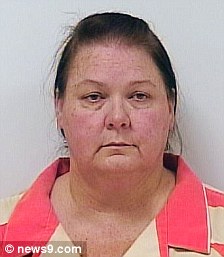
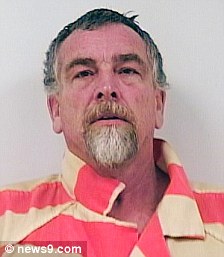 Accused: Laura Thomas, 47, left, and Aubrey Thomas, 58, right has been accused of violently beating sexually abusing their four adopted children
Accused: Laura Thomas, 47, left, and Aubrey Thomas, 58, right has been accused of violently beating sexually abusing their four adopted childrenThe children said they were sexually abused, claiming they were forced to eat gum off Aubrey Thomas' penis and made to perform oral sex on their adoptive siblings in exchange for food.
The Thomas' also allegedly forced them to put urine soaked underwear in their mouths if they wet the bed and forced them to eat horse manure for not cleaning a horse pen, reports News9.com.
The couple is facing a series of child abuse charges.
The couple, who lived in Rogers County, became foster parents in 2001 and took in six children.
In 2003, the Oklahoma Department of Human Services removed two of the children from their home after finding evidence of abuse, Osage County Undersheriff Lou Ann Brown told Tulsa World.
But the couple were able to keep the other four children and moved to Osage County west of Sperry in 2006.
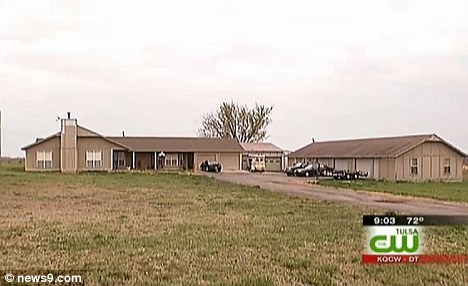 Investigators described the family's Oklahoma home, pictured, where the two girls and two boys now aged between 13 and 15 lived, as a 'house of horrors'
Investigators described the family's Oklahoma home, pictured, where the two girls and two boys now aged between 13 and 15 lived, as a 'house of horrors'In October, the Osage County Sheriff's Office was called in to investigate after one of the girls, who had been put into a psychiatric facility, revealed the allegations to a counselor, reports the Tulsa World.
Investigators say the home schooled children, who were all found to be malnourished, were coached not to say anything about the alleged abuse.
Osage County sheriff's investigator Justin Kling's reports says the girls, particularly, were singled out for 'heinous abuse', reports the Tulsa World.
Kling was able to track down a biological daughter of the Thomas' who had moved away in 2008. She echoed the stories of abuse.
'It's probably one of the worst cases that I know of that's happened around here in a long time,' Brown told News9.com.
'To treat a child like that is beyond my imagination.'
The four children are now in protective custody.
The DHS released a statement to News9.com saying: 'We are rigorously reviewing this case to find any mistakes made by our agency or others during the years of involvement with this family.
'This is absolutely intolerable. It is our mission to protect children and we will take whatever corrective action is needed to ensure this does not happen in the future.'
Source: Daily Mail
A brief note from Pennsylvania shows that there are other similar cases.
expand
collapse
Foster Mother Accused of Abuse, Neglect
 Luella Jo Mengine
Luella Jo MengineA foster mother in Columbia County is accused of doing some horrible things to her young children.
Luella Jo Mengine is charged with abusing and neglecting four foster children in her care at her rural home near Benton.
The report claims Mengine tortured the children by dunking their heads in the toilet, beating them with a tennis racket and putting their own vomit on food and forcing them to eat it.
Social service workers placed the foster children in other homes in February.
Source: WNEP Scranton / Wilkes-Barre
The Face Of Great Evil
March 15, 2012 permalink
Dr Charles Corry profiles one child protection agency, the one in his home county of El Paso Colorado.
expand
collapse
“I am repeatedly told the local DHS/CPS has legalized kidnapping of our children and is running an adoption ring with federal, state, and local financing,” says Equal Justice Foundation President Charles Corry
 Thanks for nothing CPS! (Angry Child Flipping Off December 10th, 2010 by J.W. Hollis)
Thanks for nothing CPS! (Angry Child Flipping Off December 10th, 2010 by J.W. Hollis)NCFM NOTE: Our friend Dr. Charles Corry has for years been a crusader for equal justice, Child Protective Services (CPS) included. Thank you Charles for being you...
You can’t fix stupid!
Few citizens and even fewer elected officials and bureaucrats are able to distinguish between possibility and probability. As a result extremely unlikely events are often used to impose destructive laws and regulations on the general population. Jeff Koon and Andy Powell in their book You May Not Tie an Alligator to a Fire Hydrant-101 Real Dumb Laws provides some classic examples of this.
The constant refrain of why these insane laws and crushing regulations are required is to preserve public safety, particularly that of our children despite voluminous research showing children are safest with their birth parents.
But as Ayn Rand pointed out in 1957:
“There’s no way to rule innocent men. The only power government has is the power to crack down on criminals. Well, when there aren’t enough criminals, one makes them. One declares so many things to be a crime that it becomes impossible for men to live without breaking laws.”
Only rarely is there any attempt to measure whether the law or regulation solved the problem. Quite often there is convincing evidence that the unintended consequences made the human condition worse. If there is any measure of effectiveness it is commonly used as a basis for new laws and regulations, and always as a basis for more money and enforcement.
As my friend Erin Pizzey famously pointed out:
“Any country that has tried to create a political solution to human problems has ended up with concentration camps and gulags.”
The status quo has got to go!
There is little question that our freedom and liberties have been disappearing at an accelerating rate since the turn of the century. Nowhere is this trend more despotic than in the destruction of our families and children.
In the United States we turn to our elected officials to act in a manner that preserves our rights. But in far too many cases these officials and the bureaucrats they employ have proven to be the enemy rather than defenders of liberty.
I am hardly the only one, or the first to recognize this. Dr. Chuck Baldwin in a recent column summarized the issue with the statement The Status Quo Must Go. He makes some cogent observations. He points out that:
³It is far more important who is elected as your governor than who is elected President. It is far more important who is elected as your State attorney general than who is appointed US attorney general. It is far more important who is elected to your State legislature than who is elected to the US House and Senate. It is far more important who is elected as your sheriff than who is appointed as the Director of the FBI…
The problem in Montana, however, is similar to that of most states: the ³good-old-boy,² ³politics-as-usual,² ³scratch-my-back-and-I¹ll-scratch-yours² politicians are ensconced in the State political infrastructure. And it¹s going to take some political dynamite to blast them out! And that dynamite is a courageous constitutionalist (or better yet, a host of courageous constitutionalists) who is not afraid to take on these arrogant elitists and restore the principles of liberty to their states. In short, the status quo has to go!”
I think there is little question that the most corrupt agency in most counties in the United States goes under a title of, or similar to the Department of Human Services (DHS), which includes child “protective” services (CPS). From all around the country, as well as locally, I am repeatedly told the local DHS/CPS has legalized kidnapping of our children and is running an adoption ring with federal, state, and local financing.
In the EJF newsletter In The Face Of Great Evil I documented many of the problems with DHS/CPS in El Paso County, Colorado. With that we come down to the issue of the performance of a local despot who is fighting to maintain the status quo.
El Paso County Commissioner District 3 – Sallie Clark
Sallie Clark is the elected official directly responsible for oversight of the Department of Human Services or DHS in El Paso County, Colorado. She has now held that position for eight years and despite a two-term limit in place when she took office she is now attempting to get reelected for a third term. Thus, a review of her performance in office is well justified.
My best estimate is that during Sallie Clark’s eight years in office DHS has spent over $500 million dollars of federal, state, and county funds.
Yet by any measure DHS is in much worse shape than when she took over.
Parents are scared to death of DHS and child ³protective² services. Any resistance to DHS’ imperious demands are met by threats to take their children. Families have fled the county after a single contact by a DHS caseworker. Parents home school their children so they can’t be taken without notice from the schoolroom. In this reign of terror kids are taught to hide in the back room if there is a knock at the door.
Apparently there are now at least four full-time county attorneys working to take children from the control of their parents, or to put the children in foster care.
Under Commissioner Clark’s direction DHS has set up a special group tasked with taking children from military families. You might ask how they do that? First, they establish a Memorandum of Agreement with the Army in which “child abuse” is defined (p. 3) as virtually anything that might happen to a kid. Then the soldier is charged with a “crime.” In two cases I’ve observed a rash was sufficient to claim the child was abused, the soldier confined to barracks, and restrained from seeing his little one. If the mother so much as suggests she won’t testify against the soldier DHS/CPS threatens to take the kids and put them in foster care, and it is not an idle threat. If the mother then takes the stand and testifies in favor of the father DHS/CPS tells the court she is not providing adequate protection for the children and he is kept under restraint and away from his children. Since DHS caseworkers are known to write out the restraining orders themselves without troubling the court, and the Army follows the civilian lead in these cases, the soldier has few options unless he can afford a competent attorney (scarce as hen’s teeth) willing to fight DHS. All this ruins the soldier’s military career and he is often chaptered out of the military and loses all benefits. Job prospects for a discharged veteran, especially if the discharge was less than honorable, are not great. Even if the mother qualifies for continued support under 10 USC § 1059 that ends in a year or two and DHS has kept the children under their control and typically ordered the mother not to take them out of El Paso County. So now the family is destitute, even in the unlikely event it is still together, and living conditions aren’t great. When the home fails “inspection” (and your house would probably fail as well) the solution is to put the kids in foster care. All this keeps the courts and DHS funding coming.
The Denver Post has been running a series of articles describing problems with DHS and reforms proposed by the Colorado Department of Human Services for many months. Predictably, Commissioner Clark has fought bitterly against any reforms or intrusions into her domain.
Because DHS bases its approach to child abuse on fear and making parents afraid of losing their children, only about 10% of parents who may actually need help are in contact with DHS. The EJF has previously noted that from 1995 to 2002 twelve children died in El Paso County. But after eight years of Sallie Clark, and the expenditure of at least $500 million by the county DHS, eleven children died in just the year 2011 in this county, often while at the tender mercy of DHS. In response to this disgrace, Commissioner Clark formed a CYA commission to investigate the problems that she is responsible for.
Since this commission is largely composed of the bureaucrats responsible for the problems, their proposed solution is entirely predictable: more money and more bureaucrats with more children taken from their parents.
It is also quite predictable that if Sallie Clark is reelected that more children will die needlessly as essential reforms will not be undertaken.
Conclusion
As stated at the beginning, the status quo must go. And soon before more of our children die or are taken needlessly from their parents. You have a voice and a vote, use them to protect our families and children.
Sallie Clark and El Paso County, Colorado, are not the only places with a local despot destroying families and children. As Chuck Baldwin does in his article, identify and speak out against the status quo and the destruction it is wreaking on our once great country. This is an election year and it is your local and state races that will have the greatest impact on your future.
Charles E. Corry, Ph.D., F.G.S.A.
About the author
Dr. Corry is a Fellow of the Geological Society of America and an internationally-known earth scientist whose biography has appeared in Who’s Who in the World, Who’s Who in America, Who’s Who in Science and Engineering, among others, for thirteen consecutive years.
After service with 1 st Marines he became involved with the early space program in 1960, doing preflight testing and failure analysis on Atlas and Centaur missiles, including all the Project Mercury birds. In 1965 he switched to oceanography and did research at both Scripps Institution in San Diego and Woods Hole Oceanographic on Cape Cod. He has also taught geophysics at university and worked as a research manager for a Fortune 500 company.
He has climbed high mountains, been shipwrecked and marooned on an unexplored desert island, ridden horseback through Utah, Arizona, and Colorado, among other adventures during his career.
Presently Dr. Corry is president and founding director of the Equal Justice Foundation.
Source: National Coalition For Men (NCFM)
Mother Arrested
March 15, 2012 permalink
Mother Leila Rajnarie has been arrested after taking her own baby from her foster home. The photograph in the enclosed article shows New York's respect for motherhood.
expand
collapse
Baby abducted from hospital by mom found safe: cops
8-month-old was in foster care
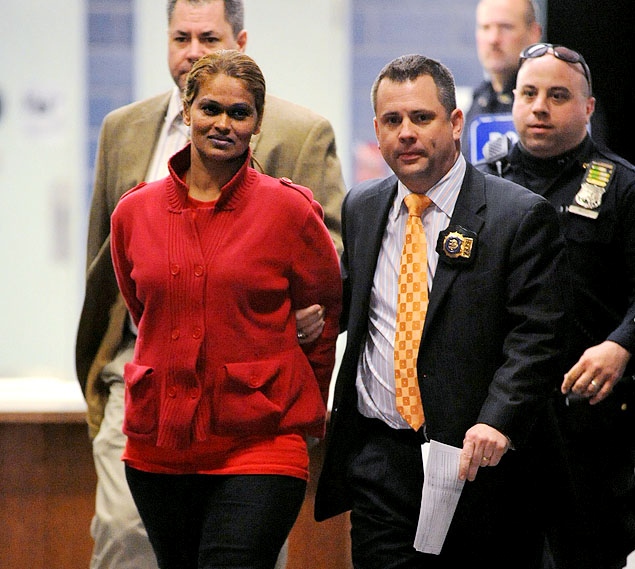 Leila Rajnarie, accused of taking her biological daughter, Navita Jagdeo, from the girl's foster mother at Queens Hospital Center, is led out of the 107th Precinct stationhouse in Flushing early Thursday morning, just after midnight.Aaron Showalter for New York Daily News
Leila Rajnarie, accused of taking her biological daughter, Navita Jagdeo, from the girl's foster mother at Queens Hospital Center, is led out of the 107th Precinct stationhouse in Flushing early Thursday morning, just after midnight.Aaron Showalter for New York Daily NewsNavita Jagdeo, 8 months, was found with Rajnarie in the back seat of a livery cab.
An 8-month-old baby was found safe with her biological mother Wednesday more than eight hours after the mom snatched her from a Queens hospital without permission, police said.
Little Navita Jagdeo was spotted in the back seat of a livery cab with mom Leila Rajnarie, 40, on 133rd St. near 101st Ave. in South Richmond Hill around 8:40 p.m., cops said.
Officers from the Patrol Bureau Queens South Task Force saw the woman who matched a description put out hours earlier, police said. The cops pulled the car over and took Rajnarie into custody, officials said. She was being questioned at the 107th Precinct stationhouse in Flushing Wednesday night.
Navita was taken to Jamaica Hospital and “appears to be in good condition”, a police source said.
 Navita Jagdeo, 8 months, was found safe and sound.DCPI
Navita Jagdeo, 8 months, was found safe and sound.DCPIRajnarie swiped Navita from Queens General Hospital Pediatric Center on 164th St. in Jamaica around 12:15 p.m., police said.
Navita - wearing a cream-colored onesie with bears on it - was at the hospital with her foster mother for a regular checkup, police said. Rajnarie swooped in and took the tot while the foster mom and the child’s doctor were speaking in another room, police said.
Rajnarie does not have custody of the infant, a spokeswoman for the Administration for Children’s Services said, who declined to discuss specifics of the case.
A neighbor on Rajnarie’s Ozone Park block said she noticed an unusual amount of baby items in the trash in front of their home earlier this week.
“About two days ago, there was a lot of baby stuff on the curb,” said the woman who declined to give her name.
Source: NY Daily News
Mother Punches Social Worker
March 14, 2012 permalink
Mother Nadine April Hawea went to the Child, Youth and Family office in Palmerston North New Zealand expecting to get her two children. When a social worker did not return the children, Nadine repeatedly punched the worker.
expand
collapse
Mother punched social worker at CYF office
A custody meeting at the Child, Youth and Family office in Palmerston North descended into chaos when a woman "lost control" and repeatedly punched a social worker after finding out that her children would not be returned to her.
Nadine April Hawea, 36, pleaded guilty to one charge of assault in Palmerston North District Court yesterday.
Hawea was at the CYF office in Church St on February 15 to regain custody of her 5-year-old son and 7-year-old daughter, the court was told.
The police summary of facts said Hawea became angry during a meeting with a social worker and her family lawyer, grabbing the social worker by the collar and repeatedly punching her in the head and body.
When the social worker fell to the floor, Hawea continued to punch her. The lawyer had to intervene to stop the attack. Hawea then walked out, leaving her victim lying injured on the ground.
The social worker needed two days off work to recover from extensive bruising to her arms, legs and right armpit.
Hawea's lawyer, Richard Bedford, said his client arrived at the meeting only to find she had not completed the paperwork necessary to regain custody of her children.
"It was a terribly stressful time for her ... and she simply lost control."
Hawea was also on "really serious" medication for her health problems, Mr Bedford said.
Judge Gregory Ross remanded Hawea on bail to reappear for sentence in May and ordered her to attend an alcohol abuse rehabilitation programme.
Child, Youth and Family general manager of operations Marama Edwards said social workers were trained to manage difficult situations, but attacks on staff did occasionally happen.
The social worker in question was shaken and distressed by the ordeal, she said.
"It's appalling that anyone can be attacked while carrying out their duties."
The department had security measures in place to protect its staff, but she did not elaborate on what they were.
The department is already embroiled in a national security review, spurred by the rampage of Iraqi refugee Thamir Abdulridha El Mehdi, 49, who caused $2250 of damage at a temporary CYF office in Christchurch on November 7.
Source: stuff.co.nz
CAS Graduate
March 14, 2012 permalink
On April 8 2009 Terri-Lynne McClintic and boyfriend Michael Rafferty abducted eight-year-old Victoria (Tori) Stafford on her way home from school in Woodstock Ontario. According to Terri-Lynne's own testimony, Michael waited in the car while Terri-Lynne enticed the girl with talk of dogs or candy. Later that day Tori was killed by a hammer blow to the head administered by Terri-Lynne.
What does it take to educate a woman like Terri-Lynne McClintic? She was adopted at an early age and spent her childhood between her adoptive parents and foster care in Parry Sound. The news article below gives a journalist's profile.
expand
collapse
Terri-Lynne McClintic: A lost soul who 'didn't stand a chance' in life
 Terri-Lynn McClintic Facebook photo, camera-dated Aug. 4, 2008.Photograph by: Handout , Facebook
Terri-Lynn McClintic Facebook photo, camera-dated Aug. 4, 2008.Photograph by: Handout , FacebookWOODSTOCK, Ont. — Terri-Lynne McClintic was an angry young woman with no job, no real aspirations and not much to lose.
Yet residents who knew her in this small, southwestern Ontario city still can't fathom why — on April 8, 2009 — she lured eight-year-old Tori Stafford away from her school and to her death, in what has become one of Canada's most notorious child-abduction cases.
Some suggest McClintic, 20, lost her way years ago due to a turbulent upbringing from an ex-stripper mom. Others suggest she fell under the spell of a manipulative boyfriend.
According to court documents outlining her guilty plea and life sentence — developments that had been the subject of a publication ban until now — even McClintic can't seem to explain what was going through her mind.
"Every day I ask myself why. Why did I tell myself that everything would be okay? Just why?" she told the court on April 30 at her sentencing. "I can't explain my thought process on that day."
Because a trial is still pending for her ex-boyfriend, Michael Rafferty, who is also charged in the slaying, not all details of McClintic's case can be reported, which only deepens the mystery.
McClintic was, however, contrite and offered no excuses for her involvement in the killing.
"Yes, I was under the influence of drugs and yes, there are things I've experienced in the past that may have affected my reactions to the situation I was in, but regardless of those reasons, it doesn't make what happened acceptable," she said. "Every time I close my eyes, I'm flooded with the memories of that day. I will never forget what happened, the mistakes I made, the failure I was."
McClintic carved out a hardscrabble life in a dingy blue- and white-trimmed row house located near a set of railroad tracks and kitty-corner to a tattoo parlour.
She shared the home with her adoptive mother, Carol McClintic.
The pair got by on her mother's disability cheques and food vouchers from the red-brick church down the street. Carol McClintic also made quick cash by pawning jewelry and other items at downtown stores.
Their home was crammed with stuff; you couldn't walk through it without stepping on something, said ex-neighbour Craig Racine, 32. Mother and daughter shared a mattress on the floor, he said.
Terri-Lynne McClintic's personality required a bit of getting used to.
At times, she was chipper. Other times, she turned into a "gangster," Racine said.
McClintic struggled to find stability in her life.
She once got hired for a job at Toyota but quit after three days, said Kayla Hurst, 22, who shopped and went on walks with McClintic.
Hurst said McClintic had also sought drug-addiction treatment at the local methadone clinic but dropped out two weeks later.
One of McClintic's few passions was hip-hop, but it was the "sadistic" variety, Hurst said.
McClintic wrote lyrics in her journal and, at times, she would read them out loud, but Hurst said she would tune her out because the lyrics were just too raw.
"Terri may have looked happy on the outside, but when we talked I know it was a coverup," she said. "She was not and has not been happy for a long time."
Some say McClintic's anger was fuelled, in part, by the hot-and-cold relationship she had with her mother.
At times, they seemed like best friends. But there were times when her mom would belittle her, Racine said.
McClintic never talked back, and just kept the hurt bottled up inside.
McClintic's adoptive parents, Rob and Carol McClintic, met while working at a strip club in downtown Woodstock. She was a stripper and he was a doorman. The courtship didn't last long before they married, Rob McClintic recalled.
"I was young and stupid," he said.
Not long after they married, they adopted Terri-Lynne, who was born to another stripper at the club.
Though Nancy McClintic, Rob's mother, wasn't terribly fond of Carol — particularly the way she talked like a biker around the guys — she thought Carol did a decent job of keeping Terri-Lynne "neat, clean and fed."
Nancy still holds on to a baby photo of a chubby-cheeked Terri-Lynne in a pink, frilly dress. She says Terri-Lynne was a happy baby, though in this photo she is not smiling and her eyes are cast downward.
In those early years, Rob said, Carol aspired to build a family modelled after the 1950s American TV show, The Adventures of Ozzie and Harriet.
It didn't turn out that way.
Carol started travelling to strip clubs in other parts of the province, leaving Terri-Lynne behind for Rob to take care of alone, he said.
Rob said he and Carol fought constantly and separated when Terri-Lynne was just a toddler. Carol gained full custody.
Terri-Lynne spent a good chunk of her youth being raised in the Parry Sound area, in northern Ontario.
She spent at least some of that time in foster care, said Gail MacDonald, whose daughter was friends with Terri-Lynne in elementary school and early high school.
"She was a little sweetie, always smiling, cute as a button," she recalled.
At the same time, "you could see this little lost kid in there."
Terri-Lynne missed her mother and frequently ran away from her foster home.
Terri-Lynne did find an escape one winter by playing recreational hockey with the Parry Sound Phantoms. She also landed a job at Tim Horton's, which she enjoyed.
But midway through Grade 9, she got in trouble. MacDonald never saw or heard from her again.
"Honest to God," MacDonald says looking back, "she didn't stand a chance."
Terri-Lynne McClintic reunited with her mother in Woodstock about three years ago, but the instability continued.
Her mother was engaged to be married, but the relationship fell apart.
A few months before the abduction and killing of Tori Stafford, McClintic started dating Mike Rafferty, who was 10 years older than she was. According to a profile he posted online, he was a "hopeless romantic."
How McClintic and Rafferty wound up connected to the murder of an eight-year-old girl remains a mystery.
Wendy Oldham, a friend of McClintic's mother, is convinced that McClintic was manipulated by her boyfriend.
But Hurst said McClintic would not let a man "push her around, nor tell her what to do."
"I am not really able to say what made her do something this sick and sad."
According to court documents, the day of the abduction started ordinarily enough for McClintic. She went and picked up food vouchers at the church and then went to get groceries. Later, she swung by an employment centre to drop off a resume and to use the computers.
There had also been a "pick up" of OxyContin pills that day.
Then, later that afternoon, it happened.
McClintic approached a blond, eight-year-old girl walking home from school and introduced herself as "T." The young girl, wearing a Hannah Montana T-shirt, said her name was Victoria but that everyone called her Tori. As they walked, they chatted about their Shih Tzu dogs.
That same day, Tori was taken to a remote location north of Guelph where she was murdered and buried underneath a rock pile.
The next day, police released grainy surveillance video showing a dark-haired woman in a puffy white coat walking down the street with Tori.
Craig Racine and another of McClintic's neighbours, Jessica McDonald, became suspicious when — out of the blue — McClintic volunteered that the woman in the video sort of looked like her.
McClintic had also cut her hair, telling them that it was because bubble gum had got caught in it.
The neighbours turned into amateur sleuths, trying to find excuses to go over to the McClintics' house to snoop around.
One day, Racine went over to use their laundry machine. Police canvassing the neighbourhood knocked on the door, sending Terri-Lynne fleeing to the bathroom. She refused to come out.
Turns out police had received tips suggesting Terri-Lynne was the woman in the video, according to court documents. Four days after the abduction, police returned to the house and arrested her on an unrelated warrant for a minor offence.
While in custody, she initially scoffed at the suggestion she was the woman in the video, but later confessed.
"Enough people have been hurt as a result of this and I refuse to drag anyone through the proceedings of a trial," she said at her sentencing. "Spending the next few decades of life in prison is nothing compared to what Tori was robbed of."
Carol McClintic has since moved out of the row house she shared with her daughter. She's spent the past year staying in spare rooms at friends' homes and at local motels — either until her money has run out or she's overstayed her welcome.
Several locals said she's been harassed because of her association with her daughter.
At the Mariner Motel on the edge of town, where she stayed as recently as the end of May, she continued to proclaim her daughter's innocence, resident Todd Maltby said.
Carol McClintic, in a series of brief emails — all sent between 3 a.m. and 6 a.m. and riddled with awkward punctuation — said she had moved away from the Woodstock area and had been "treated like shit" over the past year.
"my day will come . . . .. And I want to write a full article and have it published word for word; And I will Sell it to the highest bidder," she wrote.
"When this is over I TOO will speak LOUD and CLEAR . . . .. AND ALL THE TRUTH WILL BE TOLD."
Source: Vancouver Sun
Professional Experts
March 14, 2012 permalink
To write on experts in family court the Daily Mail engaged scholar and researcher professor Jane Ireland. Expert testimony frequently comes from practitioners who lack up-to-date knowledge of their fields, and who rarely treat patients. Her research found that fully 90 per cent of the witness reports were written by ‘experts’ who were not actually engaged in psychological practice at the time. Their real expertise is in providing testimony.
The full report is at University of Central Lancashire (pdf) with a local copy.
expand
collapse
Family courts and how incompetent (but highly paid) so-called experts are failing children
The welfare of children is at the heart of the family courts system. These courts deal with incredibly sensitive, highly emotional cases, involving questions of custody, abuse, neglect, adoption and access.
The futures of the most vulnerable in our society can be affected for ever by the decisions of judges, particularly where there is pressure to remove a child from the parental home.
The awareness of such vulnerability has increased dramatically in recent years due to a string of well-reported cases such as those of Baby P, the 17-month-old boy from Haringey who was killed by his mother and her boyfriend, with a number of failings noted in those professionals tasked with protecting the child.
Such cases have led to mounting anxiety about child protection.
Consequently, it is vital the family courts have all the necessary advice and evidence so they can reach the best-informed decisions.
Crucial
The possibility that this is being compromised by psychological ‘experts’ who do not have the qualifications, skills or knowledge for this crucial role is extremely concerning.
A number of these family cases require forensic or clinical expertise from expert witnesses, and yet this is not always evident in the experience of those asked to give their professional opinions.
Where children’s lives and futures are concerned, the courts should rely on the very best expertise from psychologists and related experts, such as psychiatrists, who really understand issues like personality disorder, sexual offending and domestic violence.
Yet, based on research I conducted as a forensic psychologist at the University of Central Lancashire and Mersey Care NHS Trust, this does not always seem to be the case.
The study, carried out by a team at the university, was commissioned by the Family Justice Council, and explored in detail expert witness reports submitted by psychologists to family courts.
The Family Justice Council was set up by the government in 2004 to ensure that children’s needs are met within the judiciary, and was keen to explore the quality of the evidence being submitted to the family courts.
Having examined the files on no fewer than 127 cases from the family courts in which psychological ‘experts’ were involved, the results were concerning — indicating an absence of qualifications and competence across a number of areas.
‘Experts’ were found to be conducting assessments covering crucial family issues without having the experience to do so, and certainly without use of the most up-to-date and accepted methods of assessing risk.
Equally concerning is evidence from the report that the majority of experts are not in practice, so they are not routinely treating clients or working as part of a wider service.
Instead, there appear to be a growing number who are ‘professional’ expert witnesses, whose only practice is in providing assessments to a court.
It certainly suggests a living can be made out of this work alone, even though the more traditional approach was for an expert in practice to be called upon by a court occasionally to provide their experience.
It leaves a range of difficulties. Courts run the risk of utilising unqualified psychologists, or psychologists who are not qualified in the area they claim to be able to testify in.
Courts rely on a single expert in most cases, so the selection of this expert is crucial.
Our research indicated that at least one fifth of all these psychological experts were not properly qualified at all, in the sense that they did not belong to either of the two main UK bodies, the British Psychological Society or the Health Profession Council.
Moreover, in conducting assessments of families, at least 20 per cent of them strayed far beyond their own field of experience, something that has the potential to be highly risky in child cases.
For example, we found evidence of witnesses commenting on sex offenders even though they had not practised in this area, or commenting on mental illness without ever working in that field.
Indeed, the study found that fully 90 per cent of the witness reports were written by ‘experts’ who were not actually engaged in psychological practice at the time.
The quality of a large number of the reports was also low. Our analysis found that 65 per cent were rated as either ‘poor’ or ‘very poor’ — a remarkable statistic.
The research team found a bewildering array of difficulties in how the reports had been conducted. Some ‘experts’ did not seem to value the importance of conducting interviews with those family members they had been asked to assess.
There was also an overuse of psychological tests, many of which had no clinical value or were ‘made up’ by the psychologist involved.
There was also evidence of antiquated intelligence tests — more than 20 years out of date — being employed.
We also found evidence of witness reports comprised of a range of emotive judgments that were more opinions than professional assessments.
For example, statements like ‘a self-centred young woman’ or, in rather quaint language, ‘an uncouth child’.
Confused
One man was described as adopting ‘an over-familiar, conspiratorial manner’, while, in another case, a family dog was said to be ‘extremely well-behaved and extremely patient despite constant teasing from the children’. ‘She can be fun to be with’, read one rather unhelpful report.
Sometimes the judgments were wholly inappropriate. ‘Miss X is an attractive mum and has a lovely personality.’
Others were chaotically structured, failed to answer vital questions, or just regurgitated previous assessments.
‘No numbered paragraphs, no glossary, nothing,’ was the verdict by my team on one such report. ‘Simply hopelessly confused,’ was another verdict.
One could ask what encourages a psychologist to become involved in such work. Some will undoubtedly do it out of a desire to protect children. However, it is clear that a career and a living can be made from such work.
On average. experts charge £120 an hour for assessing families and compiling reports. So this is a well-paid profession with tariffs set far higher than for many psychologists working in a full psycho- logical practice.
A complex two-parent assessment for a court case could easily bring in more than £4,000, as a minimum. In our study, one expert laid claim to writing more than 200 reports in the past year, while another put on their CV that they had completed ‘over 1,000 reports’.
What family courts need from psychological experts are authoritative judgments, informed by the latest knowledge in the psychological profession within which experts practise.
Fearful
This is all the more important given the growing numbers of children who are now being taken into care in the wake of cases such as Baby P.
Understandably, social services departments are now fearful of leaving children in the care of parents who pose any risk — which, in itself, could lead to the removal of children more quickly, and subsequently the involvement of experts in helping to assess such parents.
In the past month alone, local councils made no fewer than 903 applications to the courts to take youngsters into care, an astonishing rate of 225 per week.
In total in 2011/12, 9,299 applications for care were made by local authorities, an increase of 12 per cent on the previous year.
Those figures show the vital need for the courts to be assisted to do their jobs effectively. But that will not be done while non-experts potentially mislead judges with evidence which is not up to standard.
Family courts clearly operate within the confines of confidentiality in an attempt to protect the interests of children.
This inadvertently may have allowed for experts to avoid the close scrutiny — from both their peers and the public — which they might be exposed to in other courts.
In short, family courts — perhaps more than any others — deserve the best service experts can give.
Source: Daily Mail
Addendum: Britain's Channel 4 did a segment How competent are expert witnesses? It cannot be downloaded in Canada, but here is our local copy (mp4). There is a second program from the same channel, video copy (mp4).

CCW High Gear
March 13, 2012 permalink
Attila Vinczer As Canada Court Watch progresses and moves forward in our fight for transparency and accountability we are switching to a higher gear. We are taking steps to issue regular official CCW press releases along with being mentioned on paid commercials on am 640 the John Oakley Show. I am working on advertisement contracts with Corus Radio. We feel the public has a right to know what is going on. Stay tuned as this is being developed.
Source: Facebook, Canada Court Watch
Dry Up
March 13, 2012 permalink
Two more articles in the National Post from reporter Kathryn Blaze Carlson on Canada's past practice of seizing babies from unwed mothers. Ottawa mother Betty Meredith was drugged to dry up her breast milk, In the second article, the Salvation Army is coming clean about its involvement.
Articles on separate page:
- Taken without mother’s consent: Woman calls for inquiry into P.E.I.’s ‘systematic removal’ of children
- Coerced adoption: Salvation Army launches review of maternity homes that housed unwed mothers
The series continues with the story of fathers. They were unpersons, having no rights and usually eradicated from the birth documents.
More in the series. When families reunite, each person finds out of the depth of the other's pain at the separation.
Forever Abandoned
March 13, 2012 permalink
History repeats itself as Russian twins adopted by an American mother are abandoned in St Petersburg. The last time it was Torry Hansen, who put her adopted son on a plane to Russia. This time the mother was an American woman residing in Russia who concealed her citizenship while applying for adoption.
expand
collapse
Hunt for American woman who dumped adopted Russian twins on freezing street with just a note saying: 'I've given them up'
Arrest warrant issued for unidentified woman, 28, who was 'on the run'
Twins adopted by an American woman, 28, were found abandoned on a freezing Russian street with a note saying she no longer wanted them.
Sasha and Masha are just 15 months old and the 'cruelty' of the mother's rejection has led to a demand from the Kremlin's children's tsar Pavel Astakhov for a total ban on adoptions to American parents.
He branded the woman - who has not been identified and is now on the run - as an 'absolutely immoral person', and the case has been dubbed an 'outrage' by the Russian media.
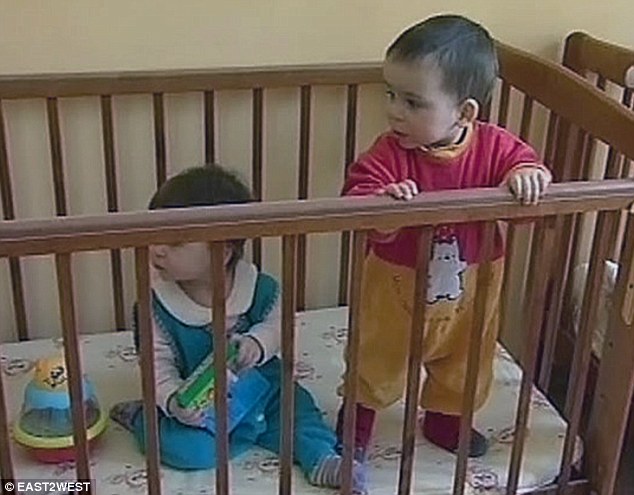 Abandoned: Twins, 15-month-old boy Sasha (right) and girl Masha (left) were left on a doorstep in St Petersburg with a note from their adoptive American mother saying she had 'given them up'
Abandoned: Twins, 15-month-old boy Sasha (right) and girl Masha (left) were left on a doorstep in St Petersburg with a note from their adoptive American mother saying she had 'given them up'It has alarming echoes of a 2010 episode in which Tennessee woman Torry Hansen sent her adopted seven-year-old Russian son Artem Saveliev on a plane back to Moscow alone with a message saying: 'I no longer wish to parent this child.'
Custodial staff in Russia's second city of St Petersburg discovered the twins - a boy and a girl - in sub-zero temperatures close to the front door of their institution.
'An unidentified man brought them in a pram and left quickly,' said the city's children's ombudsman Svetlana Agapitova.
A note found with the twins said she had 'given them up', it was reported.
'She decided to abandon the twins. Moreover, she opted not to do this in person,' Ms Agapitova said.
The twins were now being cared for at a children's hospital while a decision is made on their fate.
Officials said they were adopted six months ago in the Russian city of Tula by the woman who posed as a single mother and made a 'positive impression'.
A search warrant has been issued and she is wanted by Russian police. She was believed to be abroad, with one report saying she did not ask anyone to give the children back and claiming she has suffered a mental breakdown as a result of the scandal.
The woman reportedly lied when she adopted the children by failing to admit her US citizenship - and the fact that she was married to an American, who should have been vetted for his suitability as an adopted father, said officials.
When the authorities discovered this they demanded the adoptive mother give details of the man, and provide his consent to caring for the children.
'Soon after this, the children were found abandoned in an act of the most awful cruelty,' said a source.
Mr Astakhov condemned the woman's 'immoral and illegal act' and called for her to be stripped of her U.S. passport.
His press office claimed the woman 'is destroying the work done by the U.S. to bring order to adoption issues. Unfortunately, the US is currently unable to protect children adopted in Russia.'
There was extreme concern in Russia over a number of cases involving adoptions to the US.
Astakhov personally dedicated himself to finding a new Russian home for little Artem, who is now cherished and loved by a foster mother who plans to adopt him and other children from broken homes.
The Russian media has highlighted a string of other cases in which it claims adopted children have been tortured or maltreated by U.S. adoptive parents.
After the latest case, Mr Astakhov called for the suspension of all adoptions to America until a bilateral agreement between the two countries is ratified.
'It is contempt for Russian legislation, and the rights of our children. Two children were adopted by an absolutely immoral person,' he said.
The U.S. address of the woman and her husband were not disclosed.
 Bitter winter: The temperature at this time of year in St Petersburg can drop as low as 14F
Bitter winter: The temperature at this time of year in St Petersburg can drop as low as 14FSource: Daily Mail
Manitoba Foster Boy Dead
March 12, 2012 permalink
A foster teenaged boy is dead in Alonsa Manitoba. He is not named. In case he is in the news again, we will call him by the pseudonym Boy Alonsa.
expand
collapse
RCMP investigate teen boy's sudden death
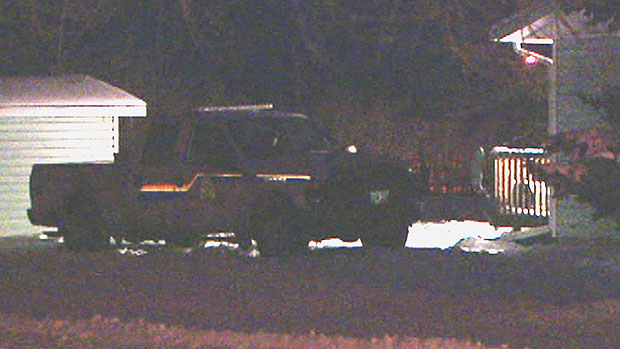 An RCMP vehicle sits parked outside a duplex in Alonsa, Man., where a teenage boy's death is being investigated.CBC
An RCMP vehicle sits parked outside a duplex in Alonsa, Man., where a teenage boy's death is being investigated.CBCA small, western Manitoba community is in shock after the sudden death of a 16-year-old boy.
He was found Tuesday outside a duplex in Alonsa and taken to hospital where he later died, according to RCMP, who said Wednesday that foul play is not suspected.
However, police did not release any further information, other than to say the investigation is continuing with witness interviews and toxicology reports.
Residents from the nearby Ebb and Flow First Nation told CBC News the boy is from that reserve but was living in foster care in Alonsa.
A woman living near the home where the boy was found said she saw an ambulance pull up at about 8 a.m., along with four or five other emergency vehicles.
She watched RCMP members go back and forth from the home throughout the day.
The woman, who did not want her name published, said she didn't know the boy or the people living there.
Alonsa is located about 220 kilometres northwest of Winnipeg.
Source: CBC
Who's Your Client?
March 11, 2012 permalink
A reporter took advantage of California's new open family courts to spend a day in the courtroom. He confirms what fixcas has been saying for years. Lawyers in family court often do not speak to their clients at all. In the California story, lawyer Kyle Puro was sitting next to his client, but did not recognize him.
expand
collapse
Rare look at children's court finds tension runs high
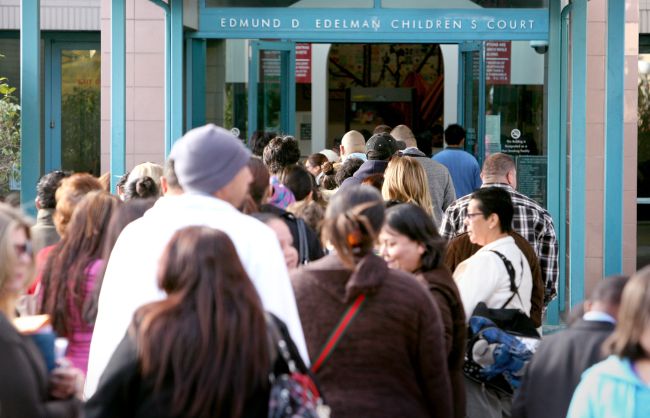 Families queue up to enter Edmund D. Edelman Children's Court in Monterey Park March 1, 2012.(SGVN/Staff photo by Leo Jarzomb)
Families queue up to enter Edmund D. Edelman Children's Court in Monterey Park March 1, 2012.(SGVN/Staff photo by Leo Jarzomb)MONTEREY PARK - The first case of the day was an easy one.
A 15-year-old girl had run away to Mexico.
Since she was out of country, she was officially released from the Los Angeles County Department of Children and Family Services caseload.
Jurisdiction terminated, as they say in court.
That was one of 24 cases to be considered recently by Referee Robert Stevenson in the Edmund D. Edelman Children's Court in Monterey Park, which is the court that oversees foster care.
For the first time since the 1960s, children's courts in Los Angeles County have been opened to the media, which means reporters are now allowed to watch proceedings unless the judge, commissioner or referee decide it is in the best interest of the child to exclude the media.
The change came about last month after an order by Supervising Judge Michael Nash.
It provides a rare look into California's dependency court, a system that for decades has had almost no public scrutiny and where the fate of children - whether they will stay in the foster system or return to their parents - is decided.
Stevenson ran a tight ship during a recent visit, sometimes struggling to keep his cool as he tried to bring order to a room that included biological parents, relatives, witnesses, clerks, a bailiff and about eight attorneys who rotated between the different cases.
Stevenson became most upset when Los Angeles Dependency Lawyers Inc. attorney Kyle Puro did not realize he was sitting next to his client, who was the father of a 15-year-old boy.
Stevenson also reprimanded Puro, who is a publicly funded attorney assigned to the case, for not having his client's file on hand. By the time the file arrived, the boy's father had already left. The hearing never happened.
"You've got to pull it together," Stevenson said to Puro before he ordered the attorney to speak to him privately and disappeared with the attorney through a door in the back of the courtroom.
Stevenson also ordered a social worker to attend a sanction meeting after the worker failed to file paperwork on time for a hearing.
The worker called in and reported having a "family emergency," but Stevenson didn't buy it.
If the social worker couldn't come up with a better reason at the sanction hearing, Stevenson has the right to fine DCFS up to $1,500.
One attorney representing a 2-year-old child recommended the county launch an investigation into the child's former foster parents because the foster parents had taught the child a few words in sign language. The attorney alleged it inhibited the child's verbal speech, but an investigation was never launched.
The child's birth parents defended the former foster parents.
"They did a great job," said the father of the former foster parents.
It was a happy day for him and the child's mother. They had officially regained custody of their daughter and were no longer under court supervision.
Huge workload, small budget
About 25,000 cases annually go before the combined 21 judges, commissioners and referees who oversee cases at the court, according to information from the Los Angeles County Superior Court.
The attorneys appointed to represent the children struggle under a miniscule state budget of about $680 per case.
The publicly funded firm that represents foster children, the Children's Law Center of Los Angeles (CLCLA), has officially come out against Nash's order to open courts.
So has Los Angeles Dependency Lawyers (LADL), the public firm that represents the parents and guardians.
Supervising CLCLA Executive Director Leslie Starr Heimov said lawyers managing hundreds of cases don't have time to determine whether it's in a child's best interest to exclude the press.
Attorneys working at the court have about 150 cases at a time.
"What we're asking for is an orderly procedure where we get more than three seconds to make our case," Heimov said.
The children in foster care have often suffered physical abuse, starvation, sexual abuse and neglect.
"Sometimes we can't predict how they are going to react to a reporter," she said. "They don't always have this capacity to deal with change."
Heimov also questioned whether Nash had the authority to go against state law that requires courts to be private.
LADL supervising attorney Marlene Furth said her staff attorneys have one complaint, and it's not low pay.
"The one thing they say, the one thing, is that they don't have time to talk with their clients," she said.
There isn't really time to have a case-by-case review of whether the press should be in the courtroom, attorneys said.
Press rattles nerves
Furth said Puro is a good attorney who won an important legal victory later in the week.
"There was just this level of tension," she said of a reporter being in the courtroom. "Everyone is like, `The press is watching. The press is watching."'
The scene in court was indeed a tense one for the first hour. Afraid of identifying the children by their names, everyone in court referred to one 12-year-old boy by his initials.
After speaking with this reporter during a break, Stevenson decided it would be better to call the children by their first names, saying it was too awkward to address a child by a few letters of the alphabet.
"I was very uncomfortable," he said.
During the hearings, Stevenson took time to ask each child how he or she was doing in school and how each child was feeling.
Furth said she wasn't sure it was good to have the press in the court room.
The press adds an air of tension, she said.
"Criminal court is a court of punishment," she said. "But, ideally, our court is one of rehabilitation. We need our clients to feel comfortable talking about drug use and the other issues of their cases."
Several print reporters have attended hearings, she said.
And a television station also recently attended a hearing.
The staff at the court is scrambling to make up rules as they go along, attorneys said.
"Everyone is spooked," Furth said.
Older foster children also have opposed Nash's order.
California Youth Connection, a group representing foster children, said they don't want foster children's names and stories splashed across headlines or appearing on television. They also had questions how attorneys are supposed to argue whether it is in a child's best interest to have reporters in the courtroom.
Stressing accountability
Open-court advocates say scrutiny will increase performance.
Law professor Mathew Fraidin has written extensively on the topic.
Fraidin, an associate professor at the University of the District of Columbia David A. Clarke School of Law, got involved in a few foster care cases and wondered why he didn't know more about foster care.
"The kids were getting the short end of the stick in every way," he said. "One of the things I said was I can't believe I didn't know all this stuff is going on. If people knew this was happening, they would stop it."
Opening courts will help children in two ways, he said.
First, it will improve the performance of workers.
"The system actors don't have the benefit of oversight," he said. "They can get sloppy, and they do. They can get nasty, and they do."
Workers will do a better job if they know a reporter may write an embarrassing story about their failure, he said.
More importantly, however, was the fact that only the most sensational stories ever get published in the media.
Because those stories have a concurrent criminal case in open court, the media seizes on them, he said.
The day-to-day small failures that hurt children are "literally illegal to talk about," he said.
"The only stories people know about are the heinous, incredibly rare stories where kids were killed by their parents," he said.
The public never gets to hear about the lazy social worker who takes a month to give a foster parent a child's medical insurance card, he said.
"These secrecy laws prevent the people who know the stories from going out and talking about what they've seen," he said.
The idea of opening the dependency courts is an old one.
Back when he was in the state Senate in 2000, Rep. Adam Schiff, D-Pasadena, co-authored a law to open the dependency courts. It failed. So did another effort in 2004 by now Senate President Pro Tem Darrell Steinberg, D-Sacramento. Most recently, an effort in 2010 by Assemblyman Mike Feuer, D-Los Angeles, failed in an Assembly committee.
While statewide legislation has failed, Judge's Nash's decision for open courts only effects children's courts in Los Angeles County.
Seventeen states have opened juvenile dependency courts to the press.
A three-year evaluation of an open-court program in Minnesota found that the open hearings caused no harm to children or families, according to white-paper report prepared for the California Assembly's Judiciary Committee.
Nationwide, the trend is toward openness, according to the white paper.
A different kind of court
Dependency court cases are especially complex and have a much lower burden of proof, Fraidin said.
In California, a child and his or her siblings have a publicly appointed attorney.
So does each parent. The county has at least one attorney in the court, sometimes more.
Foster parents usually aren't allowed to be represented by attorneys, but they can be represented if they are awarded a "de facto parent" status and have money to hire one.
So, if you're counting, that's at least four attorneys participating in every hearing. Children older than 10 are usually ordered to attend hearings. Younger children are also sometimes allowed, or they are present because they could be called to testify, often against their own parents.
It's not uncommon for babies to cry or for toddlers to crawl under chairs during the middle of hearings.
Then there are the reports.
They can be inches high. A judge has to wade through the details of each child's life to see how each child is faring. Does the child need therapy? Is she behind in school? And, most importantly, are the child's parents ready to take their daughter back?
Most children in foster care have at least four hearings: three at the beginning of the case and a review at six months. If everything is going well with the biological family, the child is sent home at the six-month hearing. Sometimes the parents are doing so badly, a judge tells the county to stop trying to reunify the child with his or her family, which is referred to as the termination of reunification services.
If the parents are making progress, the judge can order more hearings at 12 months and 18 months. By the last review hearing, a judge usually has to make the tough call of sending the child home or placing the child somewhere else for adoption or guardianship.
For children less than 1 year old, the decision about permanency is to be made within the first six months, but the cases often last longer.
If things work like they're supposed to, the county has been working all along to make sure there is a good place for the child already available, such as a current foster home or a relative with close ties to the family.
Secrecy on top of weirdness
Foster care cases have their own set of rules, Fraidin said.
It's difficult to challenge findings from social workers. And some claims against parents or foster parents don't have a high burden of proof.
Because the law is so nuanced, oversite would help bring more justice to the cases, he said.
"The rules of evidence don't apply," he said. "Most orders are not appealable. Of all of the systems, this one should have more scrutiny."
In general, foster children are cared for by harried foster parents or relatives, overburdened social workers, and rushed attorneys who must abide by a unique set of rules that apply to almost no other segment of society.
"Now, on top of all that weirdness, you add secrecy?" Fraidin said. "That's a mistake."
Source: Pasadena Star-News
Pat Niagara
March 11, 2012 permalink
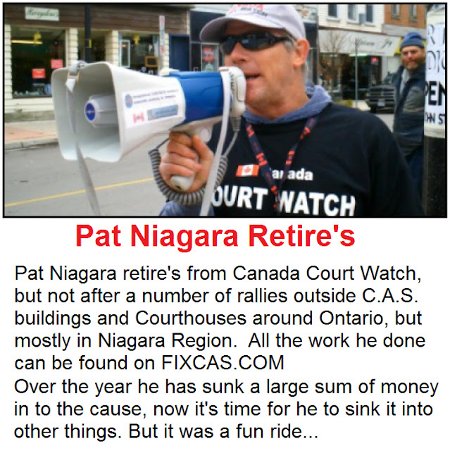
Source: CAS Ontario
Addendum: Pat Niagara resumed advocacy a month later with a petition drive.
CAS Burns
March 11, 2012 permalink
There was a fire yesterday on the roof of the building housing CAS offices in Brantford.
expand
collapse
Stubborn Roof Fire on George Street
Firefighters responded to a roof fire at an office building at 108-112 George St. on Saturday afternoon.
The stubborn blaze at the corner of George and Chatham streets was located between sheets of aluminum roof tiles and the underlying plywood atop the building that houses Children's Aid Society offices, said platoon chief Scott Foster.
Roofers had been working at the site prior to the 1:15 p.m. call. The official cause of the fire is under investigation. No one was injured.
Foster said the unit at 108 George St. sustained smoke and water damage. The neighbouring unit at 112 George St. sustained smoke damage.
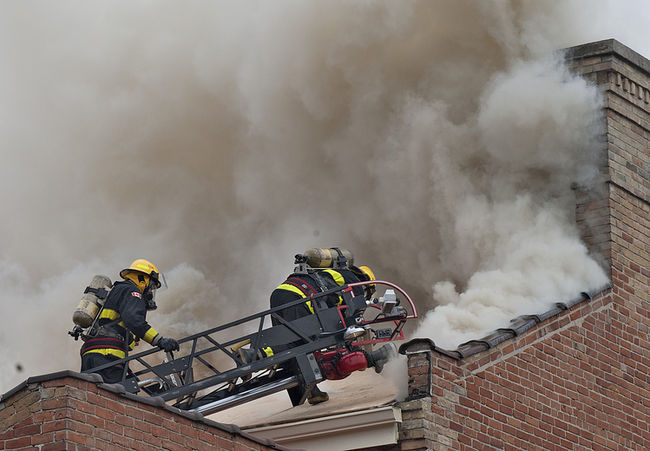
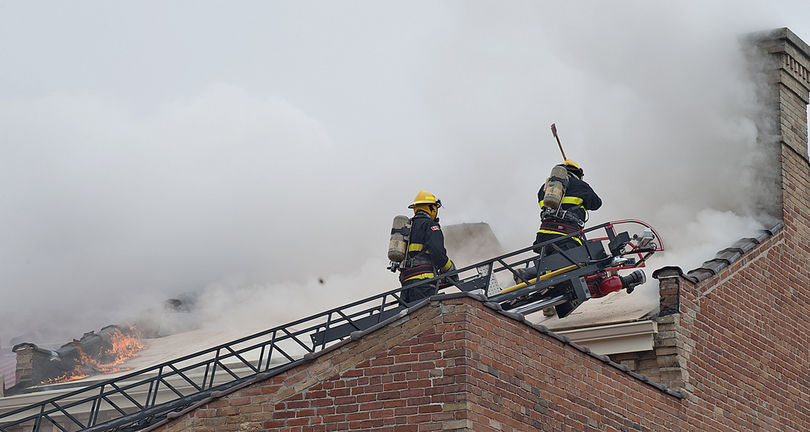
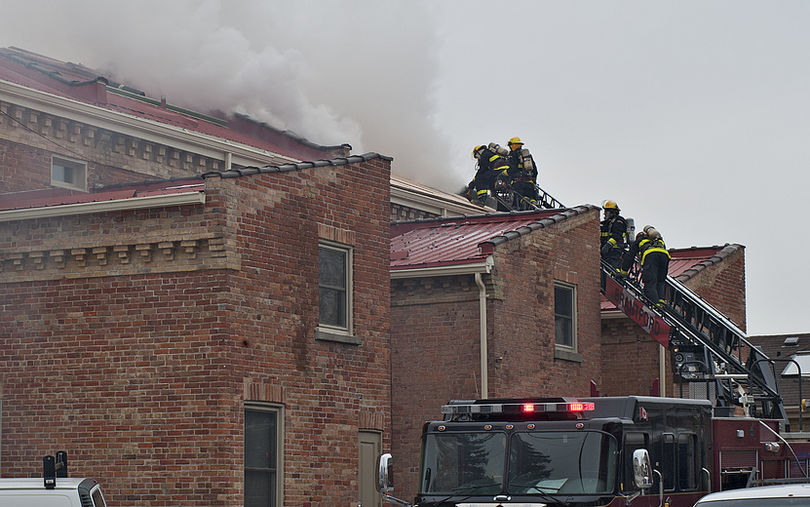
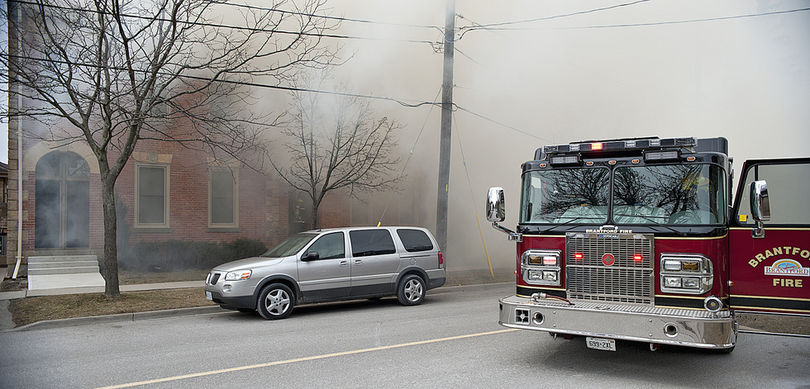
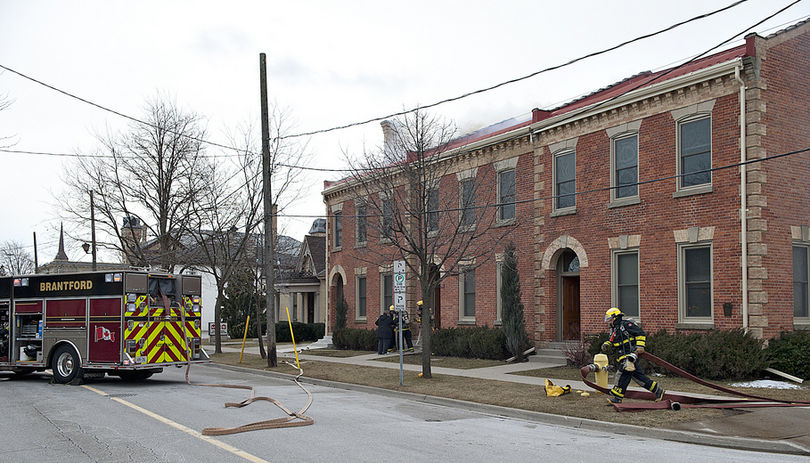 Brantford fire fighters battle a blaze early Saturday afternoon, March 10, 2012 at Children's Aid Society offices on George Street in downtown Brantford, Ontario. Roofers had been working at the site prior to the blaze, which was concentrated between aluminum roof tiles and the plywood beneath. No one was injured in the fire, and its cause is under investigation.BRIAN THOMPSON/BRANTFORD EXPOSITOR
Brantford fire fighters battle a blaze early Saturday afternoon, March 10, 2012 at Children's Aid Society offices on George Street in downtown Brantford, Ontario. Roofers had been working at the site prior to the blaze, which was concentrated between aluminum roof tiles and the plywood beneath. No one was injured in the fire, and its cause is under investigation.BRIAN THOMPSON/BRANTFORD EXPOSITORSource: Brantford Expositor
Self-Pity, Self-Destruction and Martyrdom
March 11, 2012 permalink
The headline is Ann Lander's 1961 characterization of single mothers. Canada, and many other countries, preyed on unmarried mothers as a source of babies for adoption. Australia is exposing the abuse, and may soon issue a formal apology to the affected mothers. The National Post reports on similar baby-snatching in Canada. If the process matures in Canada as in Australia, we will soon be seeing an authority figure delivering an apology to some tearful women over 60 while the baby-snatching continues at an increased rate. Only the pretext has changed. It is no longer illegitimate child but the more modern best interest of the child.
Article on separate page:
Here is a comment on the article from an open Facebook forum:
expand
collapse
Vernon Beck Many young girls get abused in care. I have spoken to 2 women this past week who both were sexually assaulted and made pregnant while in foster care and under the age of 16. Both have the children now. Cops did DNA testing on one recently and confirmed it was the CAS foster father. The one girl was sexually assaulted by the foster parent's son and the other woman was sexually assaulted by the foster father. Both said that they were the subject of years of sexual assaults because they had nowhere to turn and the CAS workers would not believe them at the time the sexual assaults were occurring right here in Ontario. Both have agreed to be interviewed. CAS are not going to like these Court Watch interviews when they come out.
Source: Facebook, Stop the CAS ...
Stealing from Foster Children
March 11, 2012 permalink
Oklahoma DHS child welfare worker Michelle L. Fausett found a way to add to her income. She took $3,700 from the accounts of three disabled foster children and used it to buy electronics for herself.
expand
collapse
Fired Oklahoma DHS worker is accused of stealing from disabled foster children
A fired Oklahoma Department of Human Services child welfare specialist, Michelle L. Fausett, has been charged with three felony counts of financial exploitation of a disabled child.
A fired DHS child welfare worker has been accused of stealing almost $3,700 from three disabled foster children.
Michelle L. Fausett, 38, of Oklahoma City, is charged with three felony counts of financial exploitation of a disabled child.
Oklahoma County prosecutors allege Fausett bought video gaming systems, laptop computers, televisions and other things for the foster children, but never delivered them to the foster homes.
She may have taken some of the items to her own home, according to an investigative report.
She made the purchases from funds the three boys received from the federal government because they are disabled.
One boy lost $972, another boy lost $1,446, and the third boy lost $1,247, prosecutors allege.
The state Department of Human Services fired Fausett Jan. 20 for dereliction of duty because she stopped coming to work, records show.
She had worked at the agency more than three years.
She turned in her DHS identification badge, cellphone and computer Dec. 7. She also brought in a used Xbox 360 video game console, used scooter and used bicycle helmet, records show.
Fausett acted after a co-worker confronted her Dec. 5 about why a foster child never got items purchased for him in August, records show.
Fausett was charged after DHS completed an internal investigation and sent the findings to prosecutors.
DHS “holds its employees to a very high standard because of the vulnerable people we serve,” DHS spokeswoman Sheree Powell said. “The financial exploitation of a foster child is particularly disgraceful, and we will not tolerate any employee committing such an act.”
If convicted, Fausett faces up to 10 years in prison on each count and a $10,000 fine.
She had not been arrested by Friday afternoon. She could not be reached for comment.
Source: NewsOK
Reporting is a Crime
March 8, 2012 permalink
When Nigel Robinson tried to download music to his computer he found pornography instead. He thought he was doing the right thing by reporting it to the police. British police seized the computer for analysis and social services banned Robinson from being alone with his daughter. Since the police are treating it as a non-urgent investigation, it could be a year until he gets his computer, and his daughter, back.
expand
collapse
Council bans daughter contact over child images
 Nigel Robinson's daughter has to stay with his mother-in-law when his wife is not at home
Nigel Robinson's daughter has to stay with his mother-in-law when his wife is not at homeA man who informed police when he found child abuse images on his computer has not been allowed to be alone with his daughter for four months.
Nigel Robinson from Hull said he called police after trying to download music but instead finding pornographic images on his laptop last November.
As a result social services said he "should not have unsupervised access with his own or other children".
He said he was "totally innocent". No arrests or charges have been made.
Mr Robinson, 43, recalled how on discovering the images he discussed the situation with his wife and immediately called police to report the incident.
Shortly after his call the police and East Riding social services came to Mr Robinson's house to take statements from him.
During the meeting social services requested Mr Robinson did not have unsupervised access with his child.
'No control'
A council statement said: "The council's social care team considers that, on the information it presently has about this case, it is a proportionate response to request that Mr Robinson should not have unsupervised access with his own or other children.
"The council will keep the case under review but cannot comment further as this is an on-going investigation."
The police took the laptop away for investigation and said it could be a year before it is returned, Mr Robinson said.
Humberside Police said: "We are conducting an investigation that has resulted in the confiscation of a laptop in order for the relevant enquiries to take place - standard procedure for this type of investigation.
"The laptop is sent away to be examined and, as this forms the basis for a number of different investigations, Humberside Police have no control over the amount of time it takes for the laptop to be returned."
'Very stressful'
Mr Robinson said: "It makes you feel as though you shouldn't have reported it in the first place."
He added it would have been "a lot easier" to just throw the machine in the bin.
Mr Robinson said the restrictions on seeing his daughter had come to a head after his wife had returned to work.
When his wife works late, as regularly happens, Mr Robinson's daughter goes to his mother-in-law's home.
He goes round to see his daughter and them comes home on his own.
He said the experience was "very stressful for the family".
Source: BBC
Chocoholic
March 8, 2012 permalink
Latest reason for taking children: Eating too much chocolate. That's one of the reasons given for taking Marlin and Meloni Mario from their Sri Lankan parents living in Norway.
expand
collapse
Social workers in Norway 'took children into care for eating too much chocolate'
Social workers in Norway took two young Sri Lankan children into foster care because they shared a bedroom and were given too much chocolate, their parents have claimed.
Their allegations follow similar claims made by an Indian couple whose children were also taken into care because they slept in the same beds as their parents and the mother appeared tired and depressed. The mother was also criticised for hand-feeding her children.
The decision provoked an outcry in India where the foreign minister demanded their return to India and opposition leaders accused Norway of ignorance of Asian culture. Many children in India sleep with their parents and it is common for mothers to hector their children to eat.
Norway now appears set to return the children of the Bhattacharya family to India to live with their grandparents.
Joseph and Jacqueline Mario, a Sri Lankan couple living in Norway, said there is no immediate prospect of their children being returned.
They told The Hindu newspaper their children, Marlin, 12, and Meloni, 8, were taken into separate foster homes last November after social workers told them they did not know how to raise them.
"Our son and daughter shared the same room and slept on the same bed, which the Child Welfare Services objected to," he said. A 100 page report said they had "giving the children too much chocolate" and rejected their explanation that children were raised differently in their culture.
"Our son and daughter really miss us. Each time a visit is scheduled, they bring little gifts of flowers or some artwork they have done in school for us. They tell us over and over again that they love us and ask when they will be coming home," he said.
Norway has been criticised by campaign groups for the high number of children taken into care.
Source: Telegraph (UK)

Chatham and Kingston Rallies
March 7, 2012 permalink
On March 6 there was a rally outside CAS in Chatham Ontario. Simultaneously another rally organized by "Kingston Residents" took place in Kingston. Spokeswoman Amber Lagroix got on the evening news.
Here are photos from Chatham. Photographer Darlene Duplessis suffered camera battery failure before the full group assembled. [1] [2] [3] [4].
Source: Facebook
There is video of the Kingston rally at CKWS-TV. Click on Tuesday 6 PM. A copy will be posted here shortly.
Rainbow Schools Asked to Avoid Cooperation with CAS
March 6, 2012 permalink
Canada Court Watch has addressed a letter to the Rainbow District School Board (Sudbury) to suggest that they avoid adopting a policy of cooperation with the children's aid society.
Canada Court Watch letter to Rainbow District School Board re Children's Aid Society
(March 6, 2012) On Monday March 5, 2012, Canada Court Watch learned that the Rainbow District School Board was looking into strengthening policies which would have school officials "co-operate" with Children's Aid Workers.
In response, Canada Court Watch has sent a letter to the Board outlining some of the reasons why the Board of Directors must exercise due diligence to inform themselves about the risks associated with working cooperatively with CAS agencies.
Source: Canada Court Watch
Here is the letter:
expand
collapse
Canada Court Watch
Box 61027 Maple Grove Post Office, Oakville, Ontario L6J 7P5
Telephone (416) 410-4115
Website: http://www.canadacourtwatch.com
Email: info@canadacourtwatch.comMarch 6, 2012
Rainbow District School Board
69 Young Street
Sudbury, Ontario
P3E 3G5
Tel: 705.674.3171
Toll Free: 1.888.421.2661
Fax: 705-674-3167
Email: eganm@rainbowdistrictschools.caAttn: Board of Directors
Dear Members of the Board
RE: School Policy OP.2.12 SAFE SCHOOLS
Yesterday, it came to the attention of Canada Court Watch that members of the Board of Directors are scheduled to discuss changes to or the development of a school policy which will require that the Board and its employees “cooperate” with the Children’s Aid Society.
The term, “cooperate” is a very vague and misleading term which if adopted in school policy will likely result in major problems for the Board. Potentially this could cause the Board to be the subject of multiple lawsuits by parents and their children.
The term “cooperate” has in the past been adopted in other school jurisdictions with tragic results. Children have been tragically harmed and criminal laws violated by school officials who believed at the time that they were doing the right thing by “cooperating” with the Children’s Aid Society as outlined in their school policies. In fact, there is currently a multi-million dollar lawsuit against one school board and a principal for working in “cooperation” with unregistered CAS workers who themselves were unlawfully engaged in the regulated practice of social work. Other lawsuits are in the making.
Another fact that many school boards are unaware of is that most Children’s Aid Society workers in the province of Ontario are working unlawfully by engaging in the regulated practice of social work without being registered with the Ontario College of Social workers as required under the Social Work and Social Services Work Act (1998). Most CAS workers in your school are breaking the law. The Board of Education would not hire teachers unless the teachers are properly registered with the Ontario Teacher’s College, so why would the Board of Education consider adopting a policy which would require its employees to “cooperate” with CAS workers who themselves are breaking the law?
Canada Court Watch has been working for years with children and families who have been adversely affected by Children’s Aid Societies in Ontario going into schools and unlawfully interrogating children and unlawfully obtaining information from school officials who were under the belief that they must “cooperate” with the local Children’s Aid Society. One of the many tragic testimonials from children that our organization has videotaped can be viewed on our video website at:
Members of the public do not support Children’s Aid Societies being involved in schools. In fact, our organization along with other organizations in Ontario have collected thousands of signatures which specifically petition the Ontario government to get CAS agencies out of the schools in Ontario. A small sampling of some of these signatures can be viewed on page 145-148 of the document about schools and the CAS which is can be downloaded on line at:
http://www.canadacourtwatch.com/files/all/Schools_and_CAS_For_School_Officials.pdf
Because Canada Court Watch only found out about this issue yesterday, it was not possible for us to provide members of the Board with all the information which we feel can properly inform the Board members of the significant dangers of “cooperating” with the Children’s Aid Society which is not part of the government and a private not-for-profit corporation which obtains funding from the Ontario government.
At this time we would simply urge the Board to defer any issue involving “cooperating” with the Children’s Aid Society and to not adopt any policy which would involve “cooperation” with Children’s Aid Society workers until full consultation with parents and community groups such as ours has been completed. The Board must exercise due diligence to ensure that it has properly informed itself of the issues.
Our organization has years of experience on this issue and to better inform the Board, our organization would be willing to make a formal presentation to the Board at one of its regularly scheduled meetings or at special meeting. We can arrange to have other community groups and parents with children in your school district to attend as well.
In the meantime, we would ask that member of the Board better inform themselves about this issue by reviewing the attached document, “Questions and answers for school officials” which provides information which school officials should know about CAS. This document has been published on line for over a year now and to date has not been disputed by any CAS agency, school board, law enforcement officials or government agency. This document can be downloaded at the following link:
http://www.canadacourtwatch.com/files/all/Q-A_for_school_officials-CAS.pdf
If any member of the Board has any questions they would like answered immediately, I can be reached personally at 905-829-0407. Canada Court Watch would welcome the opportunity to address the Board of the Whole at some time in the near future.
Yours truly
CANADA COURT WATCH
Vernon Beck
Child and Family AdvocateSource: Canada Court Watch
local copy
Ayn Update
March 5, 2012 permalink
Father Derek Hoare writes on the condition of his daughter Ayn Van Dyk, seized by British Columbia MCFD last June. For nearly nine months that girl has been warehoused.
expand
collapse
Derek Hoare So where to even begin.... as I am sure most would understand the last 8 ½ months have been beyond nightmarish. Tortuous does not begin to describe this either, the reality is that I have dedicated my life to my kids. I have dropped everything to ensure their happiness and development and to have this culminate in an attack by my own government, who has taken no time to understand my children or my family yet claim some authoritarian power over it is monstrous. To make matters worse this is being done under the guise of “help”. They throw around phrases like “child’s best interest” as if they empower them with some dictatorial aura, yet have no idea what those words even mean. We are now 8 ½ months in..... 263 days..... and my daughter has yet to see an autism expert. The closest she came was a tertiary glance by their resident expert on day 45, who told them to not treat my child as a psych patient. I have requested the assessment, input and opinion of an autism expert since the very beginning, yet we continue to wait. How quickly they rushed to have her drugged and put into a psych ward, yet still have yet to enlist the expertise of an expert in her known, diagnosed condition... autism. I have spent dozens and dozens of hours trying to explain the situation to them, trying to explain how to appropriately treat a child with autism, to try to get them to understand the concerning behaviours of autism and how it was this terrible mistake was made. Within the first six months Ayn had already had 4 different social workers, this fact has been used as a consistent excuse by MCFD who justifies their inaction and ignorance with a claim of “staffing issues”. And while I try to be empathetic to the daunting task faced by each new worker to get caught up to speed, the reality is that my child and family continues to languish whilst this persists. And rather than pick up where we left off with the previous social worker they simply want to begin anew, ofcourse each time however we are further along in the unabating process. MCFD continues to arrive to the variety of meetings uninformed, operating under a blanket liability protection which does not hold them to any standard of quality. What I am about to type will require qualification and I will be drawing up an elaborate timeline of this whole ordeal to do so; however the reality is that MCFD has not done anything in terms of an investigation or a plan of care since Sept 20th, nothing. On Sept 26th they were granted a 22 day interim order to give them time to complete an investigation (which never happened), we are still operating under that interim order to this day... that is 159 days.... on a 22 day order. Now is the painfully slow judicial process to blame? No not really, it would be nice if the wait times were not as long as they are, but that is no excuse for MCFD to literally have done nothing in terms of my daughters care or keeping me informed of her well being. I have faced: broken promises, lies, threats, stonewalling, willful ignorance, silence... ohhh the silence. Now as per the restrictions on my speech in regards to the Mar 2nd Mediation, I will try to elaborate on my understanding therein. Sect 24 of the CFCSA is quite clear that anything “obtained” in mediation must not be disclosed, so in essence anything NEW which was disclosed at mediation cannot be disclosed, except under a few circumstances which I likely do not meet, except arguably “d) if the disclosure is necessary for a child’s safety”. However until I get some further clarification on that point I will refrain from such disclosure. Now that does not mean I have to shut up or that anyone else does either, as a matter of fact screaming from the rooftops is one of the few recourses left available to us and I intend to use it. With that said I am facing an escalating battle not an improving one, one which is taking place on many different fronts; my time on FB will be limited, my time in front of cameras or in print will be on the rise, and the time I need to spend studying will also continue to be pressed only to the limits of my fatigue. I ask for everyone’s help spreading the word about this and keeping up a dialog on how it is we got to this point and what we can do to inform others of what is happening, not simply in regards to Ayn, but to the “child protection system” which has strayed so far from its goal to now become an imposing threat to the safety of children and not the heroic saviour they would like to cast themselves to be. If the populace knew how this worked it would not be tolerated, and in fact will serve as a clear exemplification of why the granting of such powers under blanket liability protections is a terrible and dangerous thing. So please please please, walk with me in this battle, in whatever capacity your individual talents endow. We have been setting up groups to facilitate this movement, and will need all the help we can get; what it will take is simply communication and coordination between everyone. We love our kids, and we as their parents need to advocate for them.... to treat an issue as serious as the removal of a child(ren) with such casual disregard is not tolerable, my child is not a number.... Her name is Ayn... she has hopes, dreams, fears and loves.... I am one of them and I will not let her down.
Source: Facebook, Help Bring little Autistic girl back to her daddy
Newmarket Meeting
March 4, 2012 permalink
A meeting in Newmarket Matters Concerning Court, CAS, Police & Schools was held on March 3. While keynote speaker Harry Kopyto had to cancel because of an illness in his family, many others spoke of their encounters with Ontario's system of family intervention, including Attila Vinczer (host), Peter Vinczer, Vern Beck, Jane Scharf, Bobbie Gellner for Neil Haskett, Chris Carter, Lauren Taylor and Chantal King for Legal Shield, and Dan Major.
The Canadian Maltese Charitable Service Trust presented cheques to the Brad Jones Karate Do and Canada Court Watch. Guests and speakers from Northern Ontario (Sudbury, North Bay) were snowed out.
Photos: [1] [2] [3] [4 Vern Beck] [5 Chris Carter, Chad Wells] [6] [7] [8] [9] [10] [11] [12 emcee Attila Vinczer].
Source: Facebook, Canada Court Watch
Audio (all mp3):
- Attila Vinczer, Vern Beck, Jane Scharf, Bobbie Gellner, Chris Carter
- Chris Carter and Jane Scharf
- Lauren Taylor and Chantal King for Legal Shield
- Dan Major
Audio source (with video): Justin TV
Secret Courts
March 4, 2012 permalink
While a recent proposal to extend the scope of secrecy in British courts was denounced by lawyers, secret courts are already in operation for families. And as for the mother about to be jailed because her children used Facebook, Christopher Booker says her hearing has been adjourned for two months.
expand
collapse
We already have unjust secret courts
Behind a wall of secrecy, the family courts routinely turn all the familiar principles of justice upside down.
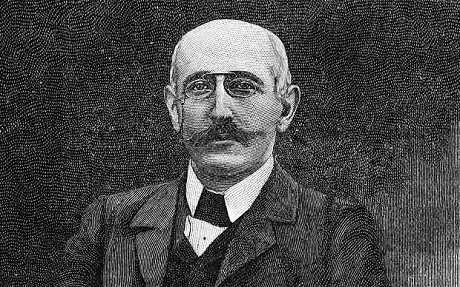 Dreyfus was convicted on the basis of evicence shown to the judge in secretPhoto: ALAMY
Dreyfus was convicted on the basis of evicence shown to the judge in secretPhoto: ALAMYThere was outrage last week over government plans to extend the degree to which our courts can operate in secret. David Davis, former shadow home secretary, claimed that such “a regime of secret courts and hidden judgments”, where defendants could not even be “told the evidence against them”, were worthy only of “despotic one-party states such as Syria, Iran and North Korea”. A letter from 57 of the 69 lawyers already familiar with such practices, from their work on terrorist cases, protested that extending this system would “represent a departure from the foundational principles of natural justice that all parties are allowed to see and challenge all the evidence relied on before the court”.
However shocking this may sound, though, it is already the system which operates in our family courts. Behind a wall of secrecy, they routinely turn all the familiar principles of justice upside down in just this way. Among the dozens of cases I have reported where children are removed from their parents, often for what appear the most absurd reasons, I have been astonished to hear how judges accept extraordinary claims by social workers and lawyers without allowing the parents to challenge them. Hearsay evidence is accepted in a way that would never be allowed in a normal court, and parents are condemned on evidence they are not allowed to see.
One such case I compared recently to the Dreyfus affair – which turned on evidence supplied to his judges but withheld from him. Yet in our family courts such travesties of justice are commonplace. I shall return to this particular case in a future column. I must add an update, however, on the case I reported last week, where a mother faced imprisonment because her teenage children, two of them in care, had been communicating on Facebook. On Monday, the judge decided to adjourn the hearing for two months. I can say no more –thanks to that secrecy which conceals abuses of justice just as shocking as anything David Davis and others protested about so eloquently last week.
Source: Telegraph (UK)
Father Chases Social Workers
March 3, 2012 permalink
Rather Joseph Rodriguez was arrested and released. But when social workers started loading his children into their car he lost it and attacked the social workers with his minivan. Notice that it is not criminal charges that drive men crazy, but child stealers.
expand
collapse
Rancho Cordova man arrested after high speed chase
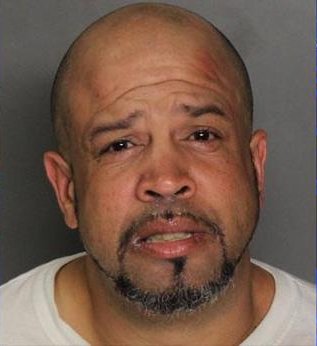
SACRAMENTO, CA - A man was arrested Friday after leading Sacramento County sheriff's deputies on a high speed chase when he fled from his home in Rancho Cordova.
Child protective services went to 42-year-old Joseph Rodriguez's home on the 10,500 block of Mills Acre Circle, with the assistance of deputies, to do a welfare check on the juveniles there, Deputy Jason Ramos said.
Rodriguez was arrested Thursday for allegedly hitting his 19-year-old son with a baseball bat, but was released Friday.
When the suspect saw deputies arrive, he got into his minivan and sped off, running through multiple red lights, Ramos said.
Rodriguez lead deputies onto westbound Highway 50 at 80 mph, while driving in and out of traffic and on the shoulder.
Ramos said deputies used a pit maneuver at Broadway and Stockton to stop the vehicle then took Rodriguez out of the minivan at gunpoint.
Source: KXTV News10 Sacramento
Man Arrested After Chase Down Highway 50
RANCHO CORDOVA (CBS13) – A man who was arrested two days earlier for taking a bat to his 19-year-old son was back behind bars Friday after leading police and sheriff’s deputies on a high-speed chase down Highway 50.
Joseph Angel Rodriguez, 42, arrived at his home in Rancho Cordova on Friday just as Child Protective Services agents were putting his children in a car after conducting a welfare check, according to Sacramento County Sheriff’s Department spokesman Deputy Jason Ramos.
“He started getting belligerent and acting up,” Ramos said.
Deputies who had accompanied CPS to the residence advised CPS to leave with the kids, at which Rodriguez jumped back into his car, which he had left running in the middle of the street, Ramos said, and sped after the CPS vehicle.
Deputies followed after Rodriguez and were joined by Rancho Cordova police. Eventually, Rodriguez exited Highway 50 at Stockton Boulevard and was boxed in at Broadway and Stockton, but not before he reportedly rammed into a few patrol cars. He was arrested at gunpoint and booked into the Sacramento County Mail Jail on $325,000 bail.
Charges include assault with a deadly weapon on a peace officer (for driving his vehicle at patrol cars during the chase), felony evasion and committing a crime while out on bail.
Source: KOVR CBS13 Sacramento
DHS Admits Mistake
March 2, 2012 permalink
Oregon DHS is admitting a mistake. It is the kind of mistake they love to admit. They failed to take Jeanette Maples away from her family, and her mother killed her. Oregon is handing out $1.5 million of taxpayer funds to atone for its error. Just so everybody will know. Of course, if they had more money and power, they could take more kids, and fewer children would die at the hands of their parents.
But what about the other kind of mistake, when they take a child and the child dies in foster care? That kind remains secret. Even when a legislature enacts a law requiring full disclosure in cases of dead foster children, the bureaucrats defy the law to maintain secrecy. So all the mistakes you hear about in the press will support the same policy: more money and power for child protectors. In case you think calling CPS actions "defiance" is an exaggeration, here are stories about defiance of disclosure laws in five American states: New York, Kentucky: [1] [2], California: [1] [2] [3] [4], Arizona and Nevada.
expand
collapse
Abuse death costs state
Oregon agrees to pay $1.5 million to the estate of Jeanette Maples, who died at the hands of her mother
Oregon will pay $1.5 million to the estate of murdered Eugene teenager Jeanette Maples, settling a lawsuit alleging that negligence by state child protection workers led to her starvation, torture and beating death at the hands of her mother.
The state essentially agreed to pay the full $1,507,000 sought in the August 2011 wrongful death suit filed by Portland attorney David Paul, according to a settlement document filed this week in Lane County Circuit Court.
Under Oregon law, $1.5 million is the legal limit on claims against public agencies. But the state also agreed to absorb $7,000 it already paid for Jeanette’s burial and related expenses, Paul said Wednesday. The suit included a claim for that amount in anticipation that the burial expenses would be charged to the estate, he said.
Probate records show that Paul will receive $500,000 in attorney’s fees and the rest of the settlement will be paid to Jeanette’s biological father, California resident Anthony Maples. Maples is the dead teen’s only qualified heir under Oregon law. He did not immediately respond to a Wednesday interview request.
Jeanette’s step-grandmother, who contacted child protection workers in 2009 to express concern about the girl’s safety, declined comment on the settlement Wednesday.
Lynn McAnulty previously expressed dismay at the prospect of Anthony Maples benefiting financially from his daughter’s death, given his lack of involvement in her life. The Leaburg woman said any settlement should go to Jeanette’s step-siblings, a boy and girl now in state foster care placements. Absent a will, however, siblings are not heirs under Oregon law.
The deal was officially struck with a Portland lawyer serving as personal representative of Jeanette’s estate. Attorney Erin Olson was appointed to that role after Lane County Circuit Judge Lauren Holland denied Anthony Maples’ bid to be the estate’s personal representative.
According to his unsuccessful 2010 petition, Anthony Maples had nine drug possession convictions — at least five involving methamphetamine — between 1990 and 2008. He also declared in the sworn statement that he had been clean and sober since more than a year before Jeanette’s death in December 2009.
Anthony Maples told The Register-Guard soon after Jeanette’s murder that he had been out of touch with his daughter for nearly a decade.
Paul arranged grief counseling and “a host of other medical, psychological and social services” for Anthony Maples, the probate records show.
The lawsuit targeted Oregon’s Department of Human Services, which is responsible for investigating reports of child abuse and neglect. It accused the agency of failing to reasonably respond to multiple reports over four years that Jeanette was being abused. It called the state’s inaction “a substantial factor” in her violent death at age 15.
Jeanette’s mother, Angela McAnulty, was sentenced to death by lethal injection after pleading guilty in February 2011 to the aggravated murder of her daughter. She remains on Oregon’s death row even though Gov. John Kitzhaber has announced that there will be no executions during his tenure.
The dead teen’s stepfather, Richard McAnulty, is serving a life sentence after pleading guilty to murder by abuse. He denied inflicting harm, but admitted failing to protect Jeanette from her mother or to report her injuries and starvation to authorities.
The wrongful death suit alleged that state workers failed to “investigate and heed” allegations of abuse from reliable sources. It also accused the agency of failing to consider Angela McAnulty’s documented history of child abuse in California before moving to Oregon. And it faulted the agency for underestimating Jeanette’s vulnerability to abuse, saying workers wrongfully concluded that she “could fend for herself as a young teenager.”
Department of Human Services spokesman Gene Evans declined comment on the settlement Wednesday. He pointed instead to an agency report on policy changes in response to its internal investigation of its response to reports of suspected abuse in the Maples case.
The changes included more careful evaluations of the vulnerability of older children; more supervisor involvement in decisions about responding to reports of suspected abuse; and paying greater attention to reports involving children, such as Jeanette, who are isolated from outside scrutiny because they do not attend school.
The payment is not the department’s largest to settle a lawsuit alleging negligent failure to protect an Oregon child from abuse. In 2009, the agency agreed to pay $2 million into a fund for future care of twins who were allegedly abused by their foster parents.
The Jeanette Maples wrongful death claim sought $1 million in noneconomic damages for Anthony Maples’ loss of his daughter’s “society, love and companionship.” It also sought $500,000 in noneconomic damages for her suffering of “severe hunger, starvation, anemia, dehydration, alienation of affection, distress and a lack of the enjoyment of her short life” due to the state’s failure to protect her from her mother.
In a declaration urging court approval of the settlement, Paul said he has handled 40 to 50 claims against Oregon and Washington child protective service agencies on behalf of injured children.
In a statement Wednesday, Paul said “there is no way to bring back Jeanette Maples. Her memory will be cherished. However, a hard look at the practices and failings at DHS can open new pathways to a better social network and community. This is the kind of case that can make Oregon a safer place for all of our children in the future.”
Source: Register-Guard, Eugene Oregon

School Shooting
March 1, 2012 permalink
On February 27 T J Lane fired ten gunshots in his Chardon Ohio high school, killing three students and injuring two more. Lane was fostered by his grandparents. Records of his childhood released by a judge show bickering among family members (paternity suit, child support claim, several assaults). No word yet on whether Lane, in common with most school shooters, had been prescribed psychotropic drugs.
expand
collapse
Chardon, Ohio high school shooting: Suspected teen gunman T.J. Lane had troubled childhood
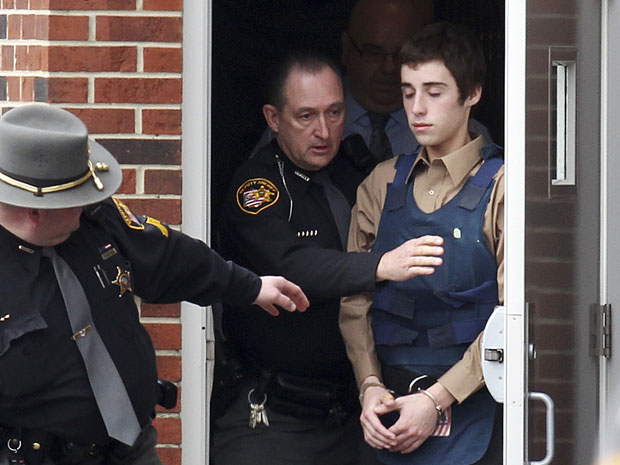 T.J. Lane, the suspected gunman behind the Chardon High School shooting earlier this week, was sentenced to 24 hours of community service in 2009 after he was charged with disorderly conductREUTERS/Aaron Josefczyk
T.J. Lane, the suspected gunman behind the Chardon High School shooting earlier this week, was sentenced to 24 hours of community service in 2009 after he was charged with disorderly conductREUTERS/Aaron JosefczykCLEVELAND — The teenage gunman suspected in a Monday shooting spree in the cafeteria of an Ohio high school that killed three students had a troubled childhood and at least one offense on his legal record, according to court documents viewed by two sources.
Court records also show that the family of T.J. Lane, 17, was involved in several disputes and incidents off and on over the boy’s life.
Lane, who is being held pending charges in the deaths at Chardon High School, was sentenced to 24 hours of community service in 2009 after he was charged with disorderly conduct. He had come to the aid of his brother when he thought his uncle was assaulting the sibling. In the process, Lane hit his uncle and the uncle wanted to press assault charges, the documents viewed by the sources show.
A juvenile court judge in Chardon, Ohio ruled on Wednesday that the records of the charge against Lane could be released.
Records at the Clerk of Courts for Geauga County, where Chardon is located and where Lane and his family lived, also show that T.J. Lane’s father Thomas was involved in several altercations over the years.
Thomas Lane was charged with assault and resisting arrest in 1990 and received two years of probation. In 1998, he was tried on charges of assaulting Sarah Nolan, T.J.’s mother, and given two years probation. In a 2002 incident, Thomas was charged with felony assault and kidnapping and received another five years of probation.
The records also show that T.J.’s mother filed a paternity claim against Thomas Lane in 1995, the year T.J. was born, which ended when Thomas admitted he was the father. Sarah Nolan also filed a child support claim against T.J.’s father then.
Prosecutors have said T.J. Lane admitted to the school killings and said he chose his victims at random.
The shooting also wounded two students, a girl released from hospital earlier in the week and a boy who was still in serious condition, a Hillcrest Hospital spokesperson said on Wednesday.
FUNERAL PLANNED
Funeral arrangements for one of the victims, Daniel Parmertor, were announced on Wednesday. Parmertor’s parents, Bob and Dina, told NBC’s “Today” that their son was an innocent victim and they did not believe he knew T.J. Lane.
Daniel Parmertor had recently started his first job at a bowling alley and was to get his first paycheck on Thursday.
“He was so excited to get that first paycheck. That’s all he was talking about. ‘Mom, when I get home from school on Thursday, can you take me to pick it up? I don’t work until Saturday, but I need to go,’” Dina Parmertor said.
“This is heartbreaking,” she said, adding that the family planned to bury the check with Daniel.
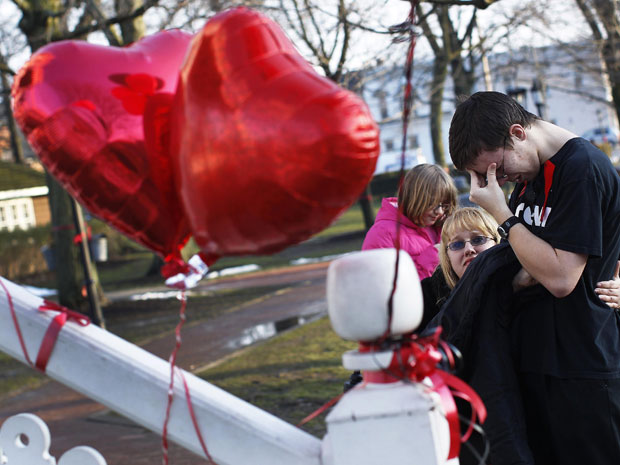 Andy Hasz, a junior at Chardon High School, grieves outside a memorial remembering the victims of the school shooting in Chardon, Ohio, February 29, 2012REUTERS/Shannon Stapleton
Andy Hasz, a junior at Chardon High School, grieves outside a memorial remembering the victims of the school shooting in Chardon, Ohio, February 29, 2012REUTERS/Shannon Stapleton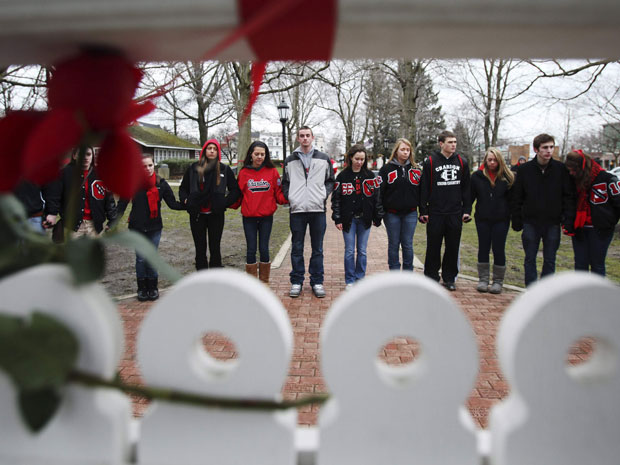 Students gather outside a memorial remembering the victims of the Chardon High school shootings before returning to school for the first time since the shootings in Chardon, Ohio March 1, 2012REUTERS/Shannon Stapleton
Students gather outside a memorial remembering the victims of the Chardon High school shootings before returning to school for the first time since the shootings in Chardon, Ohio March 1, 2012REUTERS/Shannon Stapleton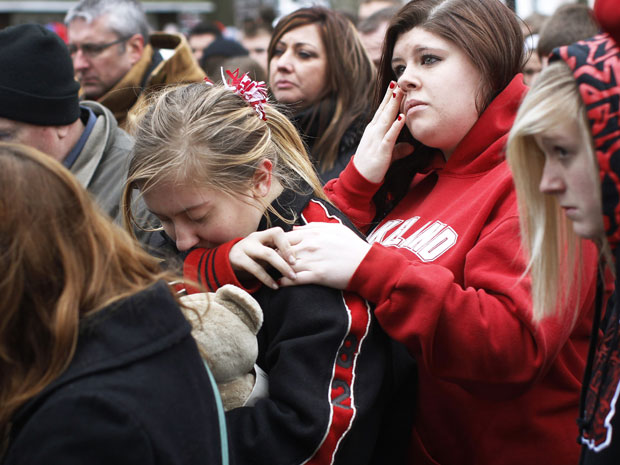 Students and parents gather outside a memorialREUTERS/Shannon Stapleton
Students and parents gather outside a memorialREUTERS/Shannon StapletonChardon students and their parents will return to the high school on Thursday to meet with counselors, and classes will resume on Friday.
Nervousness since the Ohio school shooting has sparked a rash of security incidents in the state since Monday, authorities said.
Glenville high school, located in Cleveland, experienced a “code blue” on Wednesday morning after one student accused another of having a weapon on campus following the report of a fight between several students.
The “code blue” locked down the school for less than an hour while security searched for a weapon, although none was found, Cleveland Metropolitan School District spokeswoman Charisse Ausbrook said.
On Tuesday in Summit County south of Cleveland, the sheriff’s office arrested a 14-year-old student for aggravated menacing. The sheriff’s office said the student threatened on Facebook to kill another student with a gun and assault him with a baseball bat. The student, who is in custody, had previously been arrested for bringing a firearm to another school.
A 20-year-old man was arrested for “inducing panic” the day after the Chardon shootings in Painesville, 20 minutes east of Chardon. The Lake County Sheriff’s department received reports that Anthony Harris posted a number of Facebook threats claiming he had a gun and promising that, “there will be more dead kids from Chardon.”
According to a statement from the sheriff’s department, Harris told deputies that the threats were a “publicity stunt.”
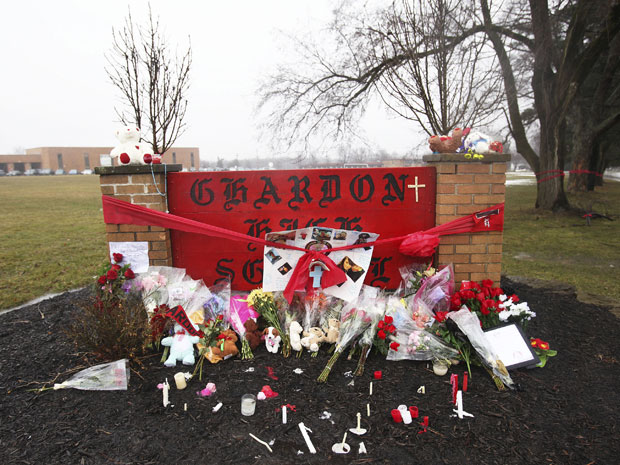 Flowers are seen outside Chardon High SchoolREUTERS/Shannon Stapleton
Flowers are seen outside Chardon High SchoolREUTERS/Shannon StapletonSource: National Post
Children's Aid News
March 1, 2012 permalink
The February edition of Children's Aid News (pdf) is now online.
Helping CAS
March 1, 2012 permalink
After putting up their new $3.4 million facility, Niagara FACS has gone hat-in-hand to Niagara Falls council and obtained a refund of their $48,000 development fee. They will be following up with a request for a refund of $83,000 from Niagara Region.
expand
collapse
Niagara Falls council refunds nearly $48,000 in development charges for FACS building
Niagara Falls council rejected a staff report and voted to refund almost $48,000 in development fees for the newly renovated and expanded Family and Chidren’s Services building on Canadian Drive.
Bureaucrats had said the city’s bylaw does not allow for refunds or exemptions for capital projects such as the $3.4-million FACS facility, which opened last fall. FACS had applied to either recover the $47,940 in charges, or receive a municipal grant in the same amount. City treasurer Todd Harrison also noted it is not the municipality’s responsibility to fund social agencies like FACS.
“It’s not our mandate,” he said.
However, councillors were cognizant of the fact that they have funded other organizations that also do not fall under the authority of local government.
“It’s very difficult to say no to this when we give money to other groups who don’t do nearly the same amount,” said Coun. Joyce Morocco, echoing the mood of those around the table. Coun. Wayne Thomson made the motion to support the FACS request with Coun. Victor Pietrangelo seconding. It passed unanimously.
Politicians made the decision Tuesday night in Committee of the Whole outside the view of television cameras.
The staff report noted that council has waived development charges in the past, such as to the Boys and Girls Glub of Niagara and the Stamford Volunteer Firemen’s Association, but those requests were made prior to construction of their projects.
FACS executive director Chris Steven said an application was made to the City and the Region, but discussions were taking so long that the building had to move ahead without an answer from either level of government. He was grateful for council’s support, but not necessarily pleased his group had to come back and refute a staff report.
“We’re all stewards of public funds and I certainly respect that council has a tremendous responsibility. Our board of directors … is also stewards of public funds and where there’s a reason to believe we have a shared obligation (for) support, we will turn over that last rock, we will come back to council.
“We had visited council couple years ago announcing our campaign without a particular ask for a grant or anything like that, but we had worked with city staff about a possible exemption on these development charges, and I think they anticipated to hear from us again.
“We’re not trying to be difficult. It’s a matter of asking council to join with us on this project.”
Requests such as these always on the surface seem difficult for councillors, who are facing a massive deficit and struggling to come to terms with how it can be wrestled to the ground. Yet while bemoaning the social and community services they are asked to fund on one hand, council has yet to cut a single grant or fee-for-service budget in this year’s attack on the balance sheet.
FACS will now take its request to the Region, where it hopes to have $83,150 in development charges reversed.
The FACS building in Niagara Falls was constructed with $1.67 million in infrastructure funding from the federal and provincial governments, $750,000 from the McCall MacBain Foundation and $50,000 from the Town of Fort Erie in addition to many private donations.
Source: Bullet News Niagara
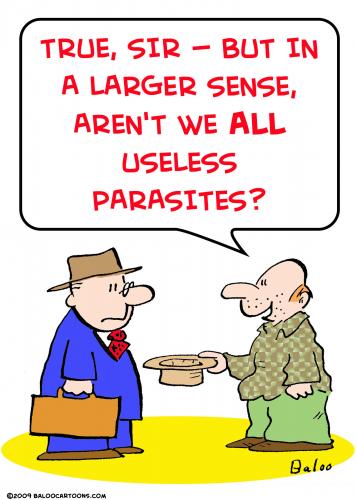
Disclosure Thwarted
March 1, 2012 permalink
When six-year-old Elisa Izquierdo was murdered, outraged New York legislators enacted Elisa's law requiring disclosure of child protection records in child death cases. The state's Office of Children and Family Services was unhappy with the law and tried to get it changed. When those efforts failed they created their own rules crippling the disclosure requirements.
expand
collapse
State Keeps Death Files of Abused Children Secret
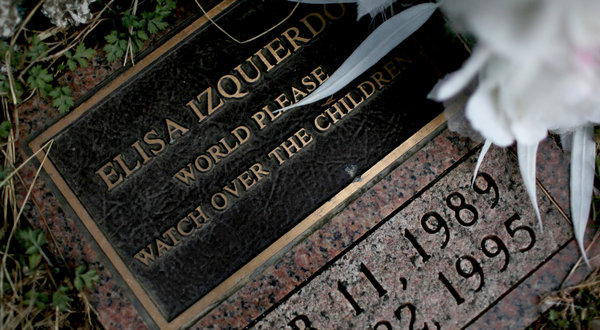 The grave of Elisa Izquierdo, who was killed by her mother in 1995, at Cypress Hills Cemetery, which straddles the border between Brooklyn and Queens.Kirsten Luce for The New York Times,
The grave of Elisa Izquierdo, who was killed by her mother in 1995, at Cypress Hills Cemetery, which straddles the border between Brooklyn and Queens.Kirsten Luce for The New York Times,When Elisa Izquierdo, a 6-year-old, was killed by her mother in 1995, she became a symbol of a dysfunctional bureaucracy, one that allowed a drug addict to retain custody of her daughter despite numerous reports of abuse.
The resulting outcry led to an overhaul of New York City’s child welfare system and the passage in Albany of Elisa’s Law, a measure loosening the secrecy regulations in child-abuse investigations. Among other reforms, the law required a public accounting of the events leading up to the death of any child in New York State who had been reported as abused or neglected.
But for the last five years, the state’s Office of Children and Family Services has been working quietly and persistently to limit access to those case reports, which in most instances are the only record of the circumstances leading up to the deaths.
In 2007, the office tried to have the law changed. When that failed, it made its own rule. According to a policy enacted by the office in September 2008, it will not release the fatality reports mandated by Elisa’s Law if there are siblings or other children in the home and officials decide that revealing the family’s abuse and investigative history is not in their “best interests.”
“This is like back to the future,” said Jeffrey Binder, who was press secretary for former State Senator Roy M. Goodman, Republican of Manhattan, when he sponsored Elisa’s Law. “We were trying very hard to remove the veil of secrecy.”
After The New York Times began asking about the policy on withholding reports, a spokesman for Gov. Andrew M. Cuomo said the governor’s office would review the change.
The fatality reports were intended to permit public scrutiny of the performance of child welfare authorities while protecting the privacy of those involved. The reports do not identify deceased children, their caseworkers or anyone else by name. But they do list every complaint of abuse or neglect involving the child, the child welfare agency’s response to the complaints, and an assessment of whether the response was adequate.
The state issues about 250 fatality reports each year. And in 2010, for example, two-thirds of the reports issued in New York City involved homes with multiple children, meaning that under its new policy, officials could withhold information about their deaths.
“The whole point of this was to insist we were going to have accountability,” said Martin Guggenheim, a professor of law at New York University and an expert in child welfare law. “What we’re now stuck with is delegating to the commissioner the discretion to refuse to disclose a report because of her conclusion that it wouldn’t be in a child’s best interest.”
The state agency says it changed the rule out of concern for the privacy of surviving children. Elisa’s Law included a provision allowing the office to withhold reports if someone requested to see a particular child’s case. But state officials said anyone could get around that provision by simply asking to see all the reports in a given year.
“Our primary focus is protecting the interests of surviving siblings and family members,” said Gladys Carrión, the commissioner of the Office of Children and Family Services.
Ms. Carrión said she could not provide an example of a child’s being harmed as a result of the release of a fatality report, but she said: “It is not far-fetched that releasing the information of a particular child would have an adverse impact on surviving siblings.”
Before her death, Elisa’s life seemed full of promise. She lived with her devoted father. Teachers described her as radiant. And a benefactor had agreed to pay for her education.
All of that changed when her father died of cancer and her mother, Awilda Lopez, was awarded custody. Ms. Lopez, whom acquaintances described as crazed by crack cocaine, said she saw the devil when she looked into her daughter’s face.
Ms. Lopez beat the girl, abused her sexually and subjected her to a barrage of hurt and humiliation. Finally, she smashed the girl’s head against concrete and left her lying slack-jawed and unconscious for two days until she died. Elisa was buried in Cypress Hills Cemetery in Queens, where the epitaph carved into her tombstone pleads, “World Please Watch Over the Children.”
Relatives, teachers and others who had seen evidence of Elisa’s abuse had complained to child welfare authorities at least seven times.
One major change after Elisa’s death was the creation by New York City of the Administration for Children’s Services, a separate agency devoted to child welfare and protection. Another was Elisa’s Law, which arose out of lawmakers’ frustration when city authorities, citing confidentiality, refused to answer questions about their role in the death.
So far, multiple bills drafted at the request of the Office of Children and Family Services to limit the public disclosure portion of Elisa’s Law have failed. The most recent was introduced in the Assembly in the current legislative session and in January was referred to committee.
The bill would require the state to release its recommendations for administrative or policy changes resulting from a child’s death. But in cases where there are surviving siblings or other children in the home, the bill would permit the state to withhold the details of the family’s case history and how the local child welfare agency responded if releasing those details was deemed to be against the other children’s “best interest.” The local agency, which in New York City is the Administration for Children’s Services, would have a say in the decision, even though that agency might have been responsible for any missteps.
The Assembly speaker, Sheldon Silver, a Manhattan Democrat who sponsored the Assembly version of Elisa’s Law, would not comment on the changes to public disclosure proposed by the Office of Children and Family Services. But a spokeswoman said on his behalf that any bill to amend Elisa’s Law would be vetted to determine whether the process protects “to the greatest extent possible” New York’s children and their families.
Marcia Robinson Lowry, a lawyer and the director of Children’s Rights Inc., a national watchdog group dedicated to reforming government child welfare services, said limiting access to reports would hurt efforts to make the system more responsive to children in dangerous homes.
“They are something a public advocacy group or a think tank or a responsible party can have available to understand the systemic failures that have led to these children’s deaths,” she said. “They are critically important.”
Source: New York Times
